Visteon BLUE15M Bluetooth Handsfree Device User Manual 14 ACURA MDX 31TZ56000
Visteon Corporation Bluetooth Handsfree Device 14 ACURA MDX 31TZ56000
Visteon >
User Manual
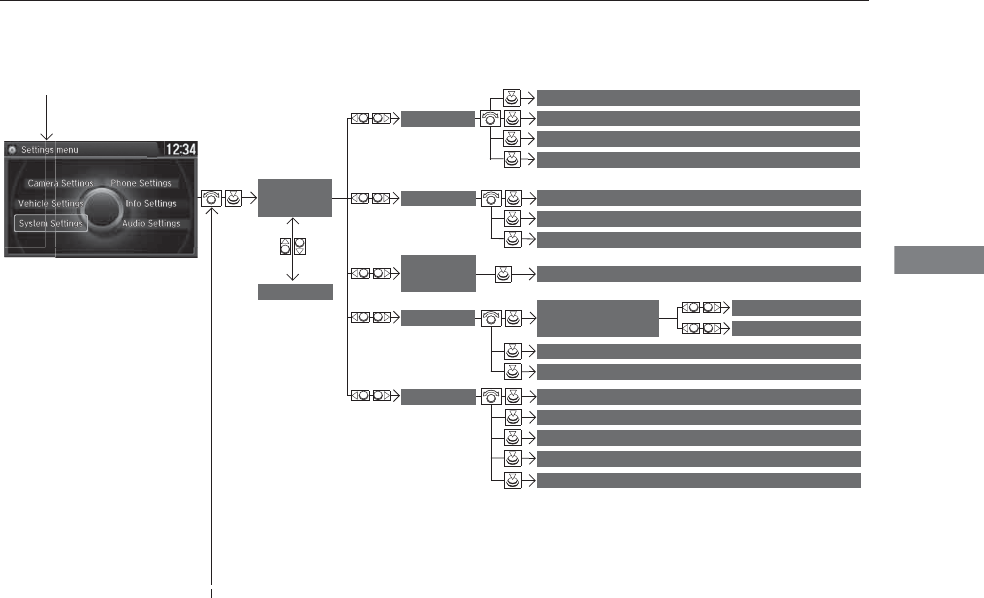
249
uuCustomized Featuresu
Continued
Features
■Customization flow
Press the SETTINGS button.
Brightness
Contrast
Black Level
Bluetooth Status
Bluetooth Device List
Edit Pairing Code
Default
Display
System
Settings Bluetooth
Sync Display Brightness
Factory Data Reset
Background Color
Header Clock Display
Clock
Clock Adjustment
Clock Format
Clock
LanguageOthers
Wallpaper
Clock/Wallpaper
Type
Display Operation Restriction Tips
Voice
Recog Voice Prompt
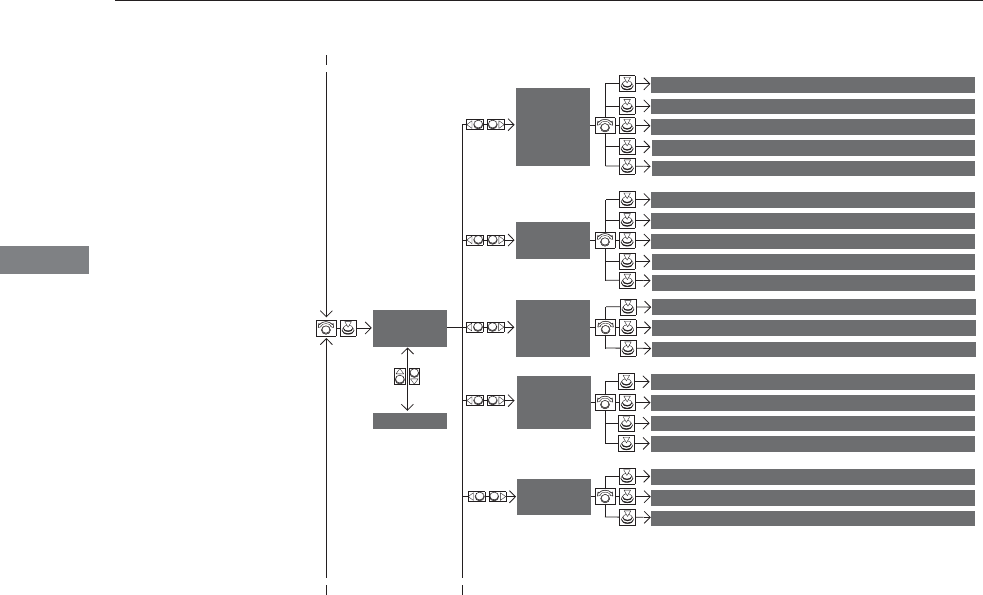
250
uuCustomized Featuresu
Features
“Trip B” Reset Timing
Turn by Turn Display*
Adjust Outside Temp. Display
“Trip A” Reset Timing
Default
Memory Position Link
Keyless Access Light Flash
Keyless Access Beep
Interior Light Dimming Time
Headlight Auto Off Timer
Auto Light Sensitivity
Vehicle
Settings
Meter
Setup
Keyless
Access
Setup
Lighting
Setup
Remote Start System On/Off*
Steering Wheel Movement At Entry/Exit
Driving
Position
Setup
Door Unlock Mode
Lane Keeping Assist Suspend Beep*
Blind Spot Info*
ACC Pre-Running Car Detect Beep*
ACC Display Speed Unit*
Driver
Assist
System
Setup*
Forward Collision Warning Distance*
Language Selection
Auto Seatbelt Tension*
* Not available on all models
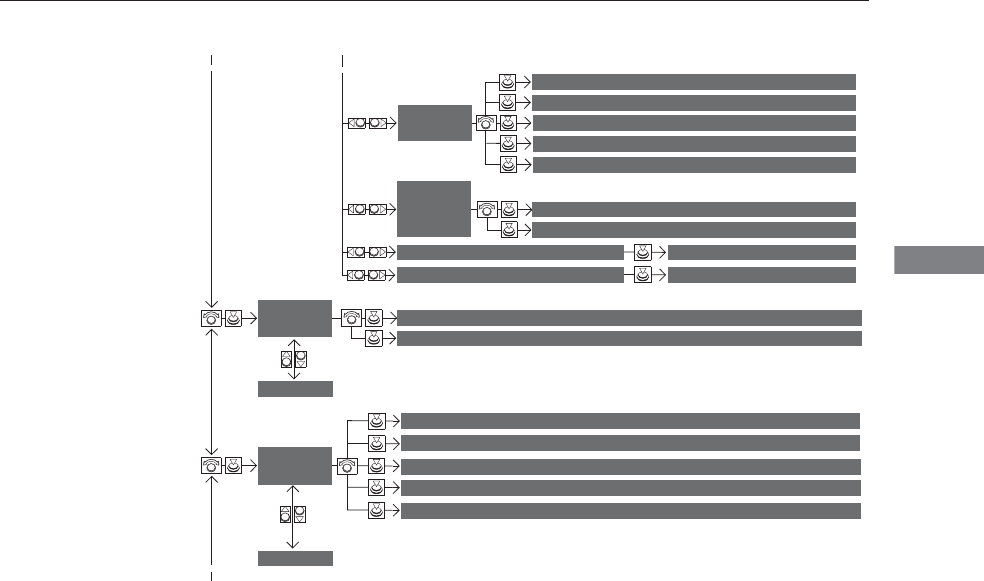
251
uuCustomized Featuresu
Continued
Features
Default
Fixed Guideline
Dynamic Guideline
Default
Sound
Source Select Popup
Cover Art*1
Connect Bluetooth Audio Device*1
Bluetooth Device List*1
Audio
Settings
Maintenance ResetMaintenance Info.
Power Tailgate Keyless Open Mode
Power Tailgate Open by Outer Handle
Power
Tailgate
Setup
Camera
Settings
Preferred IDS ModeIDS Setup
Key And Remote Unlock Mode
Keyless Lock Answer Back
Security Relock Timer
Auto Door Lock
Auto Door Unlock
Door
Setup
*1: May change depending on your currently selected source.
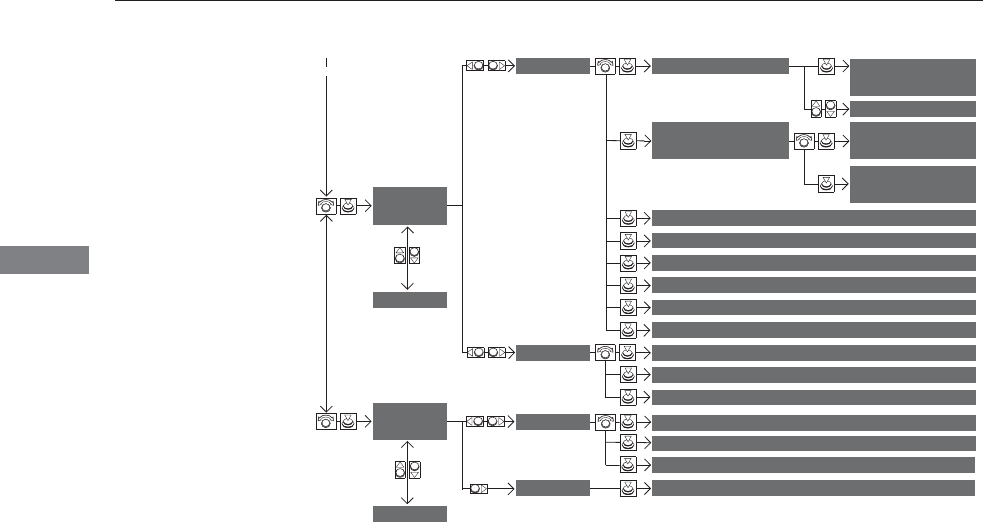
252
uuCustomized Featuresu
Features
Add Bluetooth
Device
Disconnect
Default
Phone Connect phone
Edit Bluetooth
Device
Add Bluetooth
Device
Bluetooth Device
List
Edit Speed Dial
Auto Transfer
Auto Answer
Ring Tone
Automatic Phone Sync
Use Contact Photo
Enable Text/Email
Select Account
New Text/Email Alert
Text/Email
Phone
Settings
Info Screen Preference
Clock Format
Clock/Wallpaper Type
Clock Adjustment
Clock
Default
Info
Settings
Others
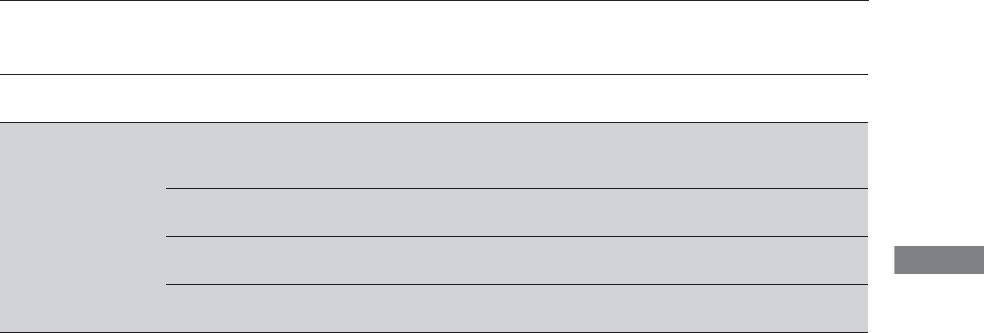
253
uuCustomized Featuresu
Continued
Features
■List of customizable options
*1:Default Setting
Setup
Group Customizable Features Description Selectable Settings
System
Settings Display
Sync Display Brightness
Selects whether the display brightness
synchronizes with the instrument panel
brightness.
On*1/Off
Brightness Changes the brightness of the audio/information
screen. —
Contrast Changes the contrast of the audio/information
screen. —
Black Level Changes the black level of the audio/information
screen. —
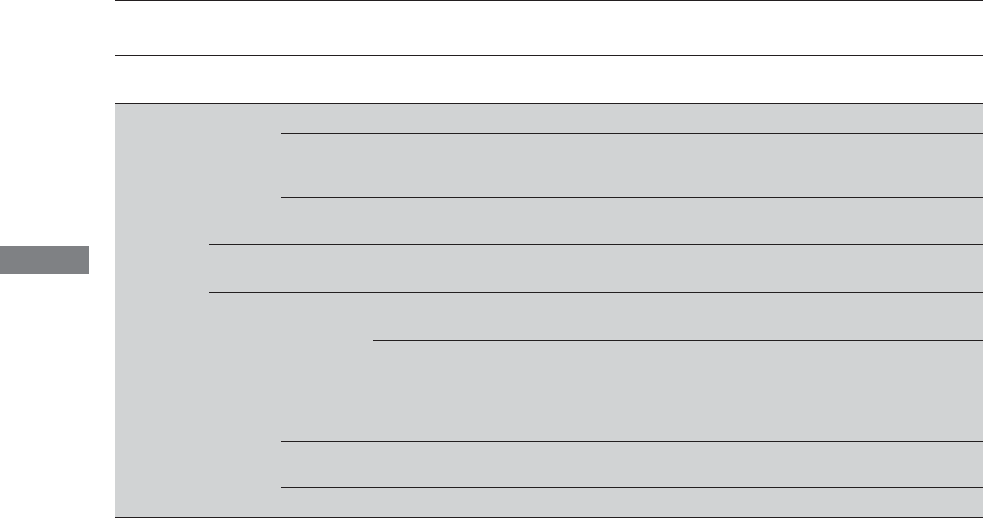
254
uuCustomized Featuresu
Features
*1:Default Setting
Setup
Group Customizable Features Description Selectable Settings
System
Settings
Blue-
tooth
Bluetooth Status Turns the Bluetooth® on and off. On*1/Off
Bluetooth Device List
Pairs a new phone to HFL, edits and deletes a
paired phone, and creates a security PIN.
2Phone Setup P. 274
—
Edit Pairing Code Changes a pairing code.
2To change the pairing code setting P. 276 Random/Fixed*1
Voice
Recog Voice Prompt Turns the voice prompt on and off. Beginner*1/Expert
Clock
Clock/
Wallpaper
Type
Clock Changes the clock display type. Analog/Digital*1/
Small Digital/Off
Wallpaper
●Changes the wallpaper type.
●Imports an image file for a new wallpaper.
●Deletes an imported wallpaper (default
wallpapers can be deleted).
2Wallpaper Setup P. 213
Blank/Galaxy*1/
Metallic
Clock Adjustment Adjust Clock.
2Clock P. 114 —
Clock Format Selects the digital clock display from 12H to 24H. 12H*1/24H
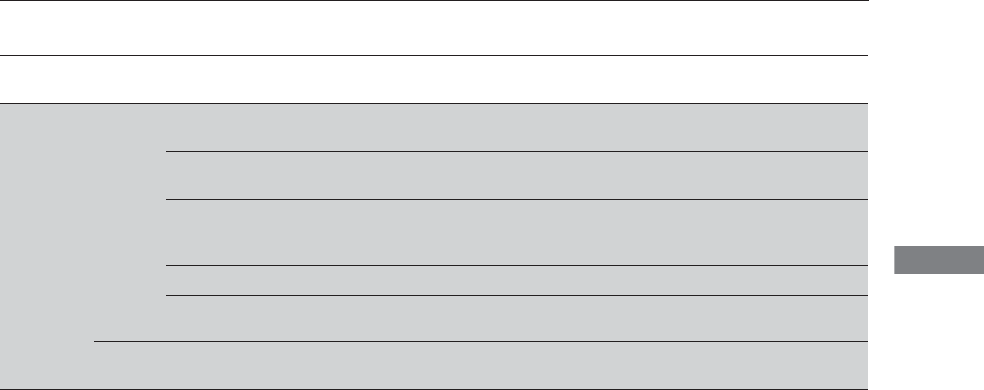
255
uuCustomized Featuresu
Continued
Features
*1:Default Setting
Setup
Group Customizable Features Description Selectable Settings
System
Settings
Others
Language Changes the display language. English*1/Français/
Español
Display Operation
Restriction Tips
Alerts you when manual control of the system is
disabled to prevent distraction while driving. On*1/Off
Background Color
Changes the background color of the audio/
information screen and the On Demand Multi-
Use DisplayTM.
Blue*1/Amber/Red/
Green
Header Clock Display Selects whether the clock display comes on. On*1/Off
Factory Data Reset Resets all the settings to their factory default.
2Defaulting All the Settings P. 265 —
Default Cancels /Resets all customized items in the
System Settings group as default. Default/OK
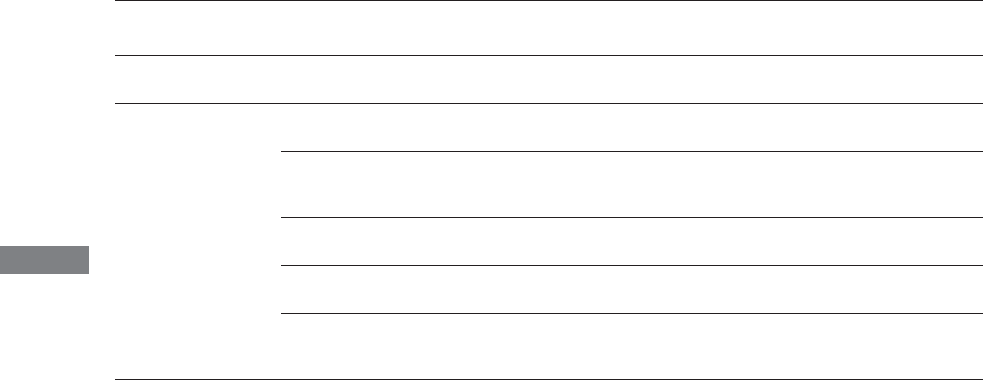
256
uuCustomized Featuresu
Features
*1:Default Setting
Setup
Group Customizable Features Description Selectable Settings
Vehicle
Settings
Driver
Assist
System
Setup*
Forward Collision Warning
Distance*
Changes at which distance FCW* or CMBSTM*
alerts, or turns FCW* on and off.
Long/Normal*1/
Short/Off
ACC Forward Vehicle
Detect Beep*
Causes the system to beep when the system
detects a vehicle, or when the vehicle goes out of
the ACC with LSF range.
On/Off*1
ACC Display Speed Unit*Changes the speed unit for ACC with LSF on the
multi-information display (MID).
mph*1/km/h (U.S.)
mph/km/h*1 (Canada)
Lane Keeping Assist
Suspend Beep*
Cause the system to beep when the LKAS is
suspended. On/Off*1
Blind Spot Info*Changes the setting for the blind spot
information.
Audible And Visual
Alert*1/Visual Alert/
Off
* Not available on all models
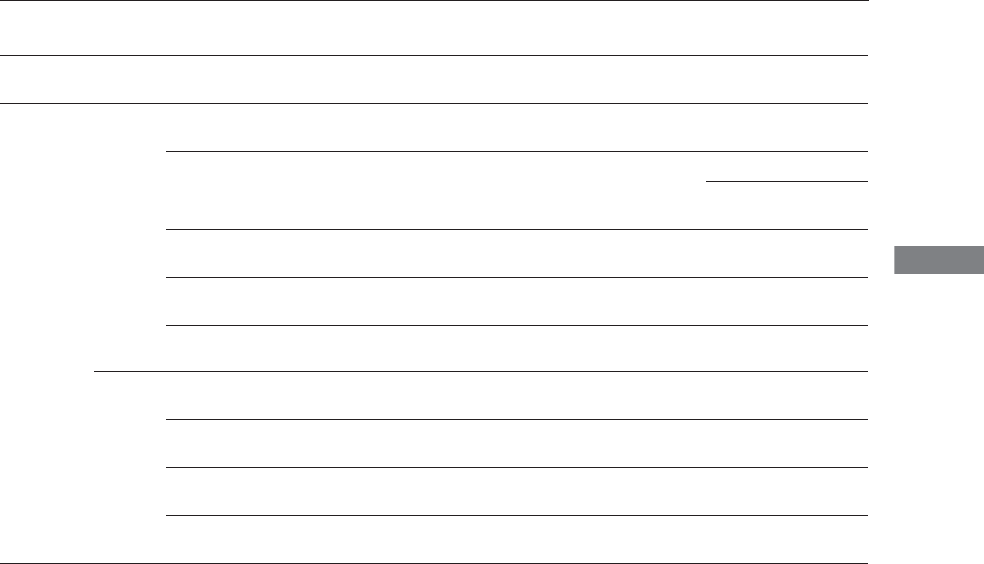
257
uuCustomized Featuresu
Continued
Features
*1:Default Setting
Setup
Group Customizable Features Description Selectable Settings
Vehicle
Settings
Meter
Setup
Language Selection Changes the displayed language on the multi-
information display.
English*1/Français/
Español
Adjust Outside Temp.
Display
Adjust the temperature reading by a few
degrees.
-5°F
~
±0°F
*1
~
+5°F
(U.S.)
-3°C ~ ±0°C*1 ~ +3°C
(Canada)
“Trip A” Reset Timing
Changes the setting of how to reset trip meter A, average
fuel economy A, average speed A, and elapsed time A.
With Refuel/IGN Off/
Manually Reset*1
“Trip B” Reset Timing
Changes the setting of how to reset trip meter B, average
fuel economy B, average speed B, and elapsed time B.
With Refuel/IGN Off/
Manually Reset*1
Turn by Turn Display*Selects whether the turn-by-turn display comes
on during the route guidance. On*1/Off
Keyless
Access
Setup
Door Unlock Mode Changes which doors unlock when you grab the
driver’s door handle.
Driver Door Only*1/
All Doors
Keyless Access Light Flash Causes some exterior lights to flash when you
unlock/lock the doors. On*1/Off
Keyless Access Beep Causes the beeper to sound when you unlock/
lock the doors. On*1/Off
Remote Start System On/
Off*Turns the remote engine start feature on and off. Enabled*1/Disabled
* Not available on all models
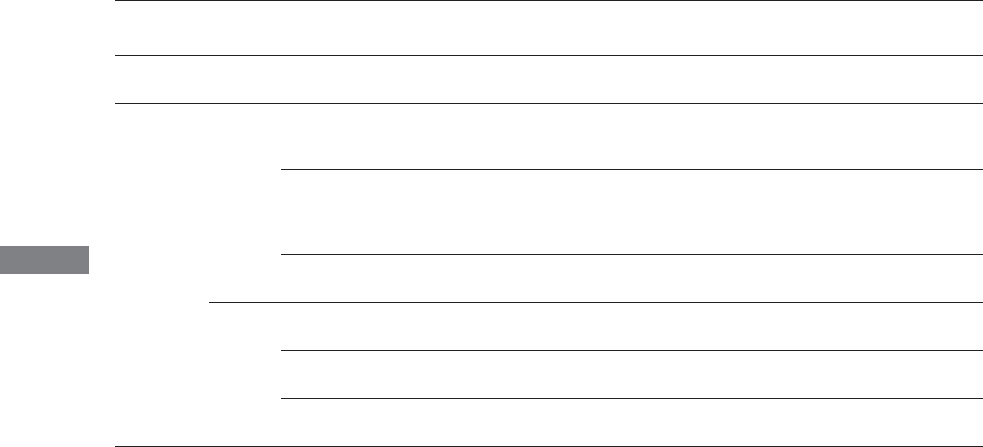
258
uuCustomized Featuresu
Features
*1:Default Setting
Setup
Group Customizable Features Description Selectable Settings
Vehicle
Settings
Lighting
Setup
Interior Light Dimming
Time
Changes the length of time the interior lights stay
on after you close the doors.
60seconds/
30seconds*1/
15seconds
Headlight Auto Off Timer Changes the length of time the exterior lights
stay on after you close the driver’s door.
60seconds/
30seconds/
15seconds*1/
0seconds
Auto Light Sensitivity Changes the timing for the headlights to come
on.
Max/High/Mid*1/
Low/Min
Driving
Position
Setup
Memory Position Link Turns the driving position memory system using a
remote transmitter on and off. On*1/Off
Steering Wheel Movement
At Entry/Exit
Moves the steering wheel fully up when you get
in/get out of the vehicle. On*1/Off
Auto Seatbelt Tension*Turns the setting for the automatic seat belt e-
pretensioner activation on and off. On*1/Off
* Not available on all models
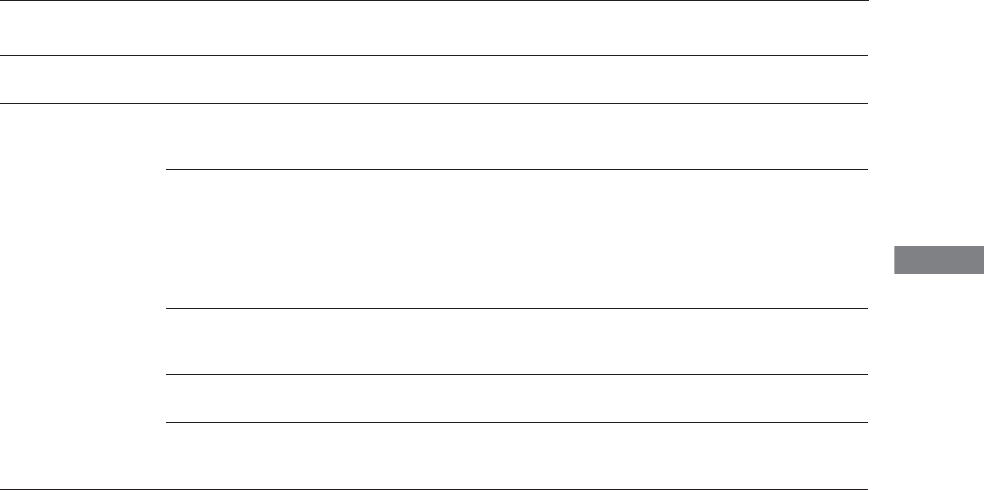
259
uuCustomized Featuresu
Continued
Features
*1:Default Setting
Setup
Group Customizable Features Description Selectable Settings
Vehicle
Settings
Door
Setup
Auto Door Lock Changes the setting for the automatic locking
feature.
With Vehicle
Speed*1/Shift from P/
Off
Auto Door Unlock Changes the setting for when the doors unlock
automatically.
All Doors When
Driver’s Door
Opens*1/All Doors
When Shifted to
Park/All Doors When
Ignition Switched
Off/Off
Key And Remote Unlock
Mode
Sets up either the driver’s door or all doors to
unlock on the first push of the remote or built-in
key.
Driver Door*1/All
Doors
Keyless Lock Answer Back LOCK/UNLOCK- The exterior lights flash.
LOCK (2nd push)- The beeper sounds. On*1/Off
Security Relock Timer
Changes the time it takes for the doors to relock
and the security system to set after you unlock
the vehicle without opening any door.
90seconds/
60seconds/
30seconds*1
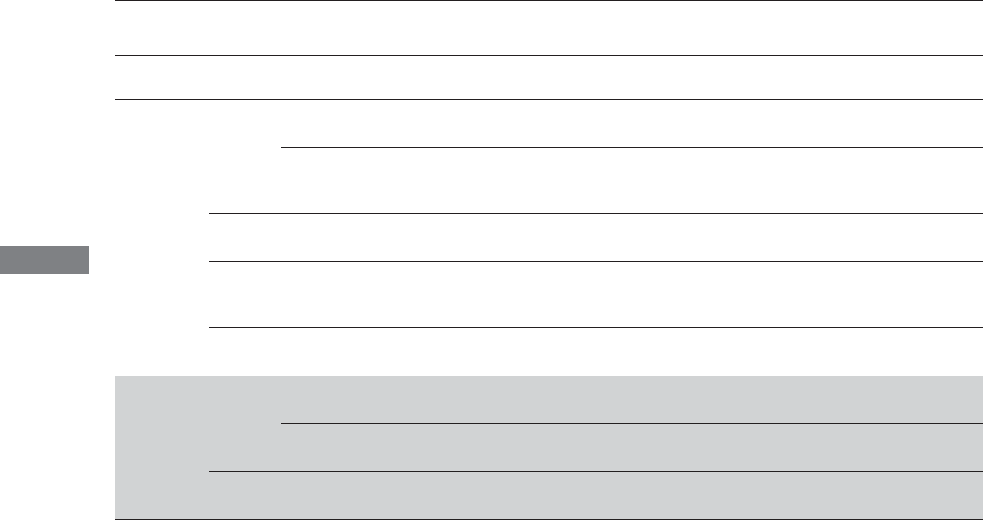
260
uuCustomized Featuresu
Features
*1:Default Setting
Setup
Group Customizable Features Description Selectable Settings
Vehicle
Settings
Power
Tailgate
Setup
Power Tailgate Keyless
Open Mode
Changes the keyless setting for when the power
tailgate opens.
Anytime*1/When
Unlocked
Power Tailgate Open by
Outer Handle
Selects whether to enable the power tailgate
open operation using the tailgate outer handle.
Off (Manual Only)/
On (Power/
Manual)*1
IDS
Setup Preferred IDS Mode Changes the IDS mode setting for when you set
the power mode to ON.
Last Used*1/Comfort/
Normal/Sport
Mainte-
nance
Info.
Maintenance Reset Resets the engine oil life display when you have
performed the maintenance service. —
Default Cancels/Resets all customized items in the
Vehicle Settings group as default. Default/OK
Camera
Settings
Guide-
lines
Fixed Guideline Selects whether the fixed guidelines come on the
rear camera monitor. On*1/Off
Dynamic Guideline Selects whether the dynamic guidelines come on
the rear camera monitor. On*1/Off
Default Cancels/Resets all customized items in the
Camera Settings group as default. Default/OK
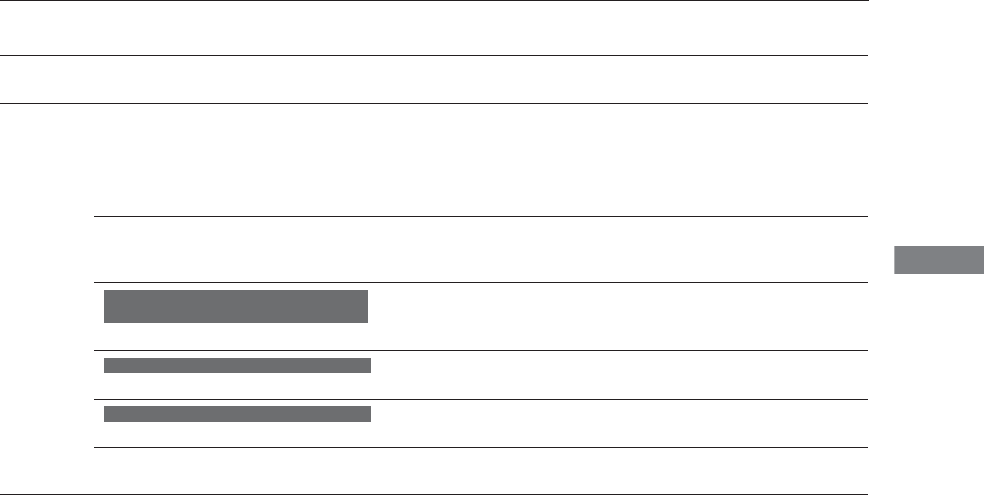
261
uuCustomized Featuresu
Continued
Features
*1:Default Setting
Setup
Group Customizable Features Description Selectable Settings
Audio
Settings
Sound Adjusts the settings of the audio speaker’s sound.
2Adjusting the Sound P. 215
-6 ~ C*1 ~ +6 (Bass,
Treble and
Subwoofer), -9 ~ C*1 ~
+9 (Fader, Balance),
Off/Low/Mid*1/High
(SVC)
Source Select Popup
Selects whether the list of selectable audio
sources comes on when the AUDIO button is
pressed.
On/Off*1
Cover Art
Turns on and off the cover art display. On*1/Off
Connect Bluetooth Audio Device
Connects, disconnects or pairs a Bluetooth®
Audio device to HFL. —
Bluetooth Device List
Edits or deletes a Bluetooth® Audio device paired
to HFL. —
Default Cancels/Resets all customized items in the Audio
Settings group as default. Default/OK
CD (MP3/WMA/AAC), iPod®, USB, Pandora®*
or AhaTM mode
Bluetooth® Audio, Pandora®* or AhaTM mode
Bluetooth® Audio, Pandora®* or AhaTM mode
* Not available on all models

262
uuCustomized Featuresu
Features
*1:Default Setting
Setup
Group Customizable Features Description Selectable Settings
Phone
Settings Phone
Connect phone
Pairs a new phone to HFL, or connects or
disconnects a paired phone.
2Phone Setup P. 274
—
Bluetooth Device List
Pairs a new phone to HFL, edits or deletes a
paired phone, or creates a security PIN.
2Phone Setup P. 274
—
Edit Speed Dial Edits, adds or deletes a speed dial entry.
2Phone Setup P. 274 —
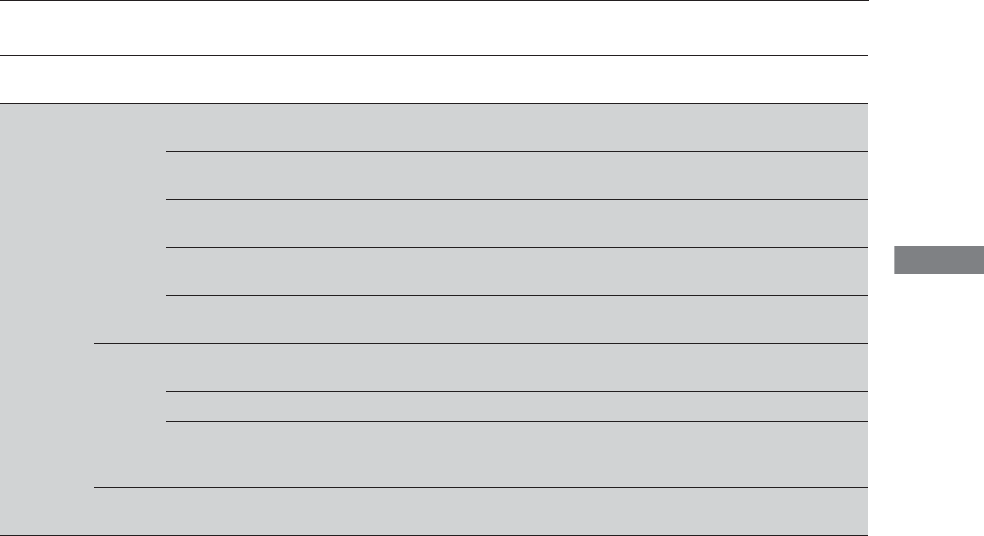
263
uuCustomized Featuresu
Continued
Features
*1:Default Setting
Setup
Group Customizable Features Description Selectable Settings
Phone
Settings
Phone
Auto Transfer Sets calls to automatically transfer from your
phone to HFL when you enter the vehicle. On*1/Off
Auto Answer Sets whether to automatically answer an
incoming call after about four seconds. On/Off*1
Ring Tone Selects the ring tone. Fixed/Mobile
Phone*1/Off
Automatic Phone Sync Sets a phonebook data to be automatically
imported when a phone is paired to HFL. On/Off
Use Contact Photo Displays a caller’s picture on an incoming call
screen. On*1/Off
Text/
Email
Enable Text/Email Turns the text message/E-mail function on and
off. On*1/Off
Select Account Selects a mail or text message account. —
New Text/Email Alert
Selects whether a pop-up alert comes on the
screen when HFL receives a new text message/E-
mail.
On/Off
Default Cancels/Resets all customized items in the Phone
Settings group as default. Default/OK
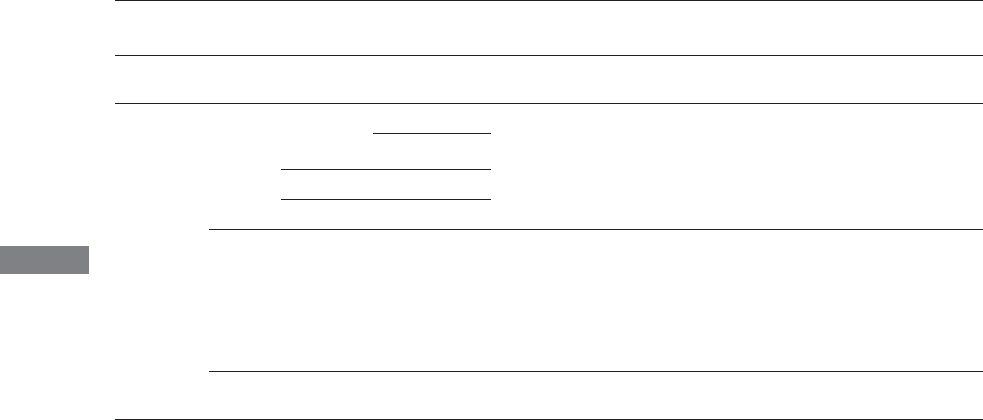
264
uuCustomized Featuresu
Features
*1:Default Setting
Setup
Group Customizable Features Description Selectable Settings
Info
Settings
Clock
Clock/
Wallpaper
Type
Clock
See System Settings on P. 253 to P. 255.
Wallpaper
Clock Adjustment
Clock Format
Other Info Screen Preference
Selects either of the following to be displayed
when you press the INFO button.
•Info Top: Some of the available menu items
pop up.
•Info Menu: All available menu items pop up.
•Off: The menu item you selected last time is
displayed.
Info Top/Info
Menu*1/Off
Default Cancels/Resets all customized items in the Info
Settings group as default. Default/OK
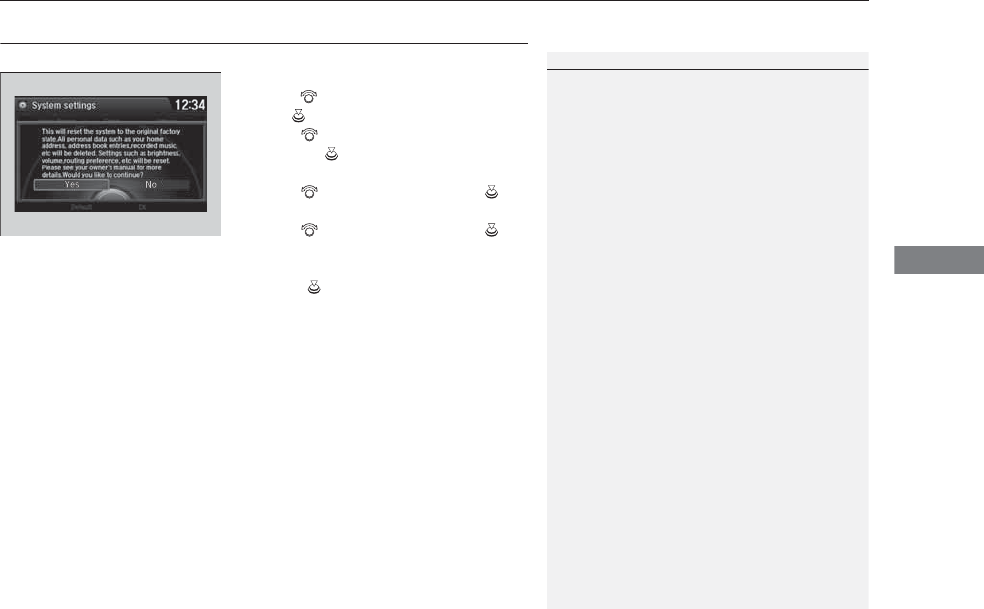
265
uuCustomized FeaturesuDefaulting All the Settings
Features
Defaulting All the Settings
You can reset all the menu and customized settings as the factory defaults.
1. Press the SETTINGS button.
2. Rotate to select System Settings, then
press .
3. Rotate to select Factory Data Reset,
then press .
uThe pop-up menu appears on the screen.
4. Rotate to select Yes, then press .
uThe confirmation message will appear.
5. Rotate to select Yes, then press
again to reset the settings.
uThe confirmation message will appear.
Press to select OK.
1Defaulting All the Settings
When you transfer the vehicle to a third party, reset
all settings to default and delete all personal data.
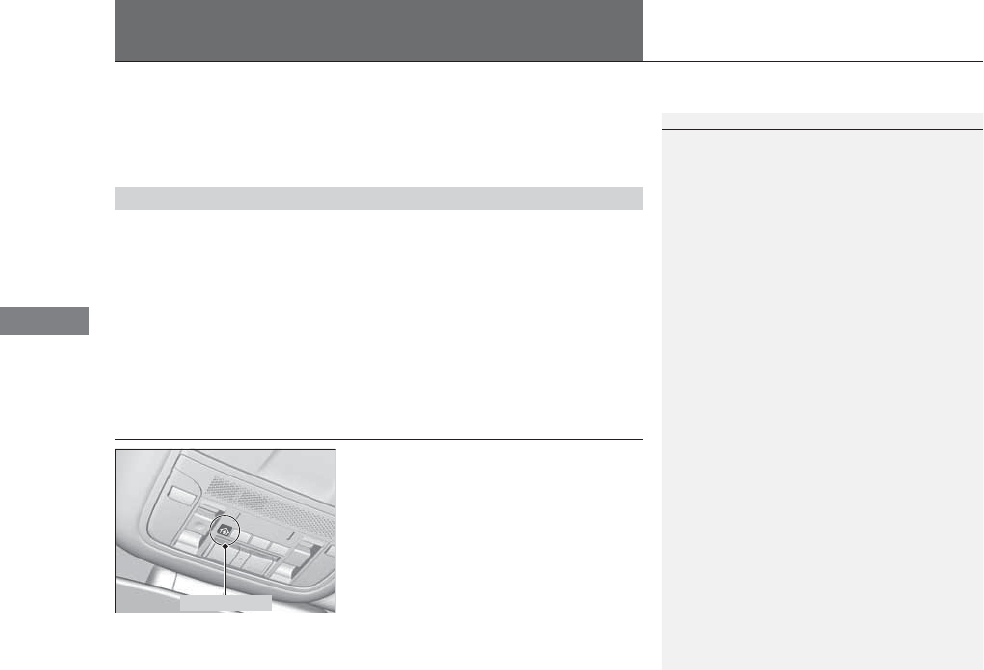
266
Features
HomeLink® Universal Transceiver
The HomeLink® Universal Transceiver can be programmed to operate up to three
remote controlled devices around your home, such as garage doors, lighting, or
home security systems.
Refer to the safety information that comes with your garage door opener to test that
the safety features are functioning properly. If you do not have the safety
information, contact the manufacturer.
Before programming HomeLink, make sure that people and objects are out of the
way of the garage or gate to prevent potential injury or damage.
When programming a garage door opener, park just outside the garage door’s
path.
Training HomeLink
If you have not trained any of the buttons in
HomeLink before, you should erase any
previously learned codes. To do this:
•Press and hold the two outside buttons for
about 20 seconds, until the red indicator
blinks. Release the buttons, and proceed to
step 1.
•If you are training the second or third
button, go directly to step 1.
■Important Safety Precautions
1HomeLink® Universal Transceiver
HomeLink® is a registered trademark of Johnson
Controls., Inc.
Before programming HomeLink to operate a garage
door opener, confirm that the opener has an external
entrapment protection system, such as an “electronic
eye,” or other safety and reverse stop features. If it
does not, HomeLink may not be able to operate it.
Red Indicator
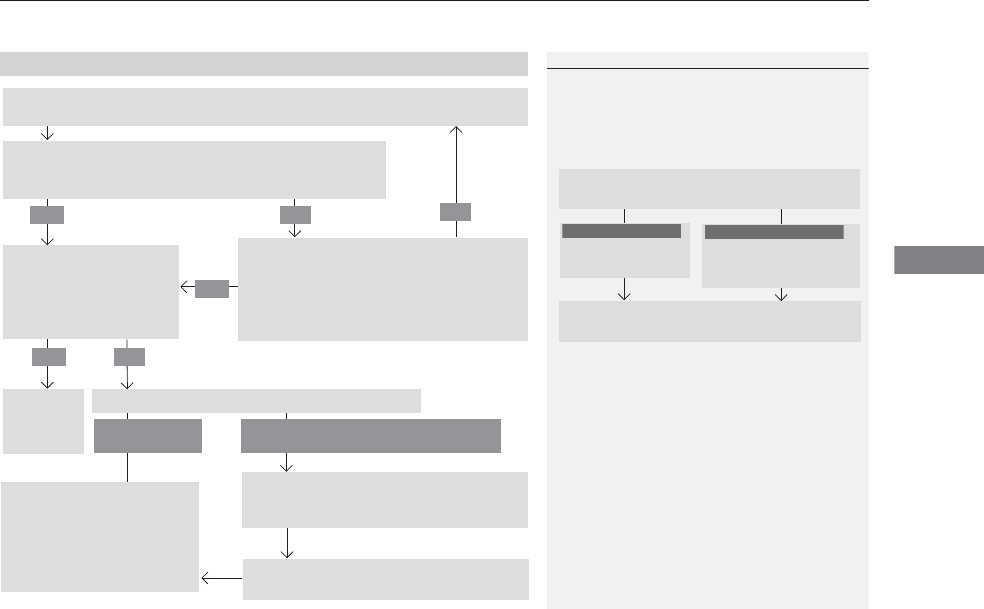
267
uuHomeLink® Universal TransceiveruTraining HomeLink
Features
■Training a Button
1Training HomeLink
Retraining a Button
If you want to retrain a programmed button for a
new device, you do not have to erase all button
memory. You can replace the existing memory code
using this procedure:
1. Press and hold the desired HomeLink button
until the HomeLink indicator begins to blink.
2. Continue to hold the HomeLink button and
follow steps 1 - 3 under “Training a Button.”
Indicator remains on
for about 25 secs.
Standard transmitter
Indicator blinks rapidly for
2 secs, then remains on for
about 23 secs.
Rolling code transmitter
Erasing Codes
To erase all the codes, press and hold the two outside
buttons until the HomeLink indicator begins to blink
(about 10 to 20 secs). You should erase all codes
before selling the vehicle.
If you have any problems, see the device’s
instructions, visit www.homelink.com, or call
HomeLink at (800) 355-3515.
4.
a.
3.
2.
5. a.
b.
1. Position the remote transmitter you wish to link 1 to 3 inches (3 - 8 cm) from the
HomeLink button you want to program.
Press and hold the desired HomeLink button and the button on
the remote transmitter. Does the HomeLink indicator (LED)
blink after 10 secs?
Press and hold the
programmed HomeLink
button for about a sec.
Does the device (garage
door opener) work?
Press and hold the remote and the HomeLink
button at the same time. Then, while
continuing to hold the HomeLink button,
press and release the button on the remote
every 2 secs.
Does the LED blink within 20 secs?
Training
Complete
Press and hold the HomeLink button again.
Press and hold the HomeLink
button again.
The remote-controlled device
should operate.
Training Complete
The remote has a rolling code. Press the
“learn” button on the remote-controlled
device (e.g. garage door opener).
Within 30 secs, press and hold the
programmed HomeLink button for 2 secs.
HomeLink indicator blinks for 2 secs,
then remains on.
HomeLink LED
is on.
YES NO
YES
YES NO NO
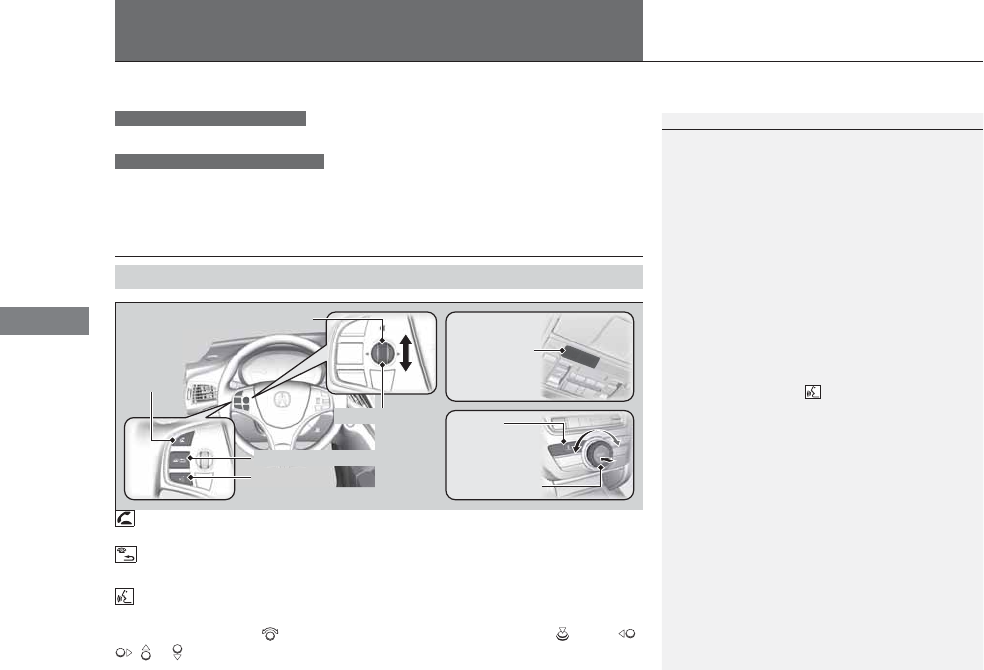
268
Features
Bluetooth® HandsFreeLink®
See Navigation System Manual for how to operate Bluetooth® HandsFreeLink®.
Bluetooth® HandsFreeLink® (HFL) allows you to place and receive phone calls using
your vehicle’s audio system, without handling your cell phone.
Using HFL
(Pick-up) button: Press to go to the Speed Dial/Call History on the multi-
information display or to answer an incoming call.
(Hang-up/back) button: Press to end a call, to cancel a command or to clear
the phone information on the MID.
(Talk) button: Press to give HFL voice commands.
PHONE button: Press to go directly to the Phone screen.
Interface dial: Rotate to select an item on the screen, then press . Move ,
, or to select secondary menu.
■HFL Buttons
1Bluetooth® HandsFreeLink®
To use HFL, you need a Bluetooth-compatible cell
phone. For a list of compatible phones, pairing
procedures, and special feature capabilities:
•U.S.: Visit www.acura.com/handsfreelink, or call 1-
888-528-7876.
•Canada: Visit www.handsfreelink.ca, or call 1-888-
528-7876.
To use HFL, the Bluetooth setting must be On.
2Customized Features P. 248
Voice control tips:
•Aim the vents away from the ceiling and close the
windows, as noise coming from them may interfere
with the microphone.
•Press and release the button when you want to
call a number using a stored voice tag, a
phonebook name, or a number. Speak clearly and
naturally after a beep.
•If the microphone picks up voices other than yours,
the command may be misinterpreted.
•To change the volume level, use the audio system’s
volume knob or the remote audio controls on the
steering wheel.
State or local laws may prohibit the operation of
handheld electronic devices while operating a
vehicle.
If you receive a call while using the audio system, the
system resumes its operation an after ending the call.
Models with navigation system
Models without navigation system
Talk Button
Volume up
Microphone
Hang-up/Back Button
Pick-up
Button
Volume down
Interface Dial
PHONE
Button
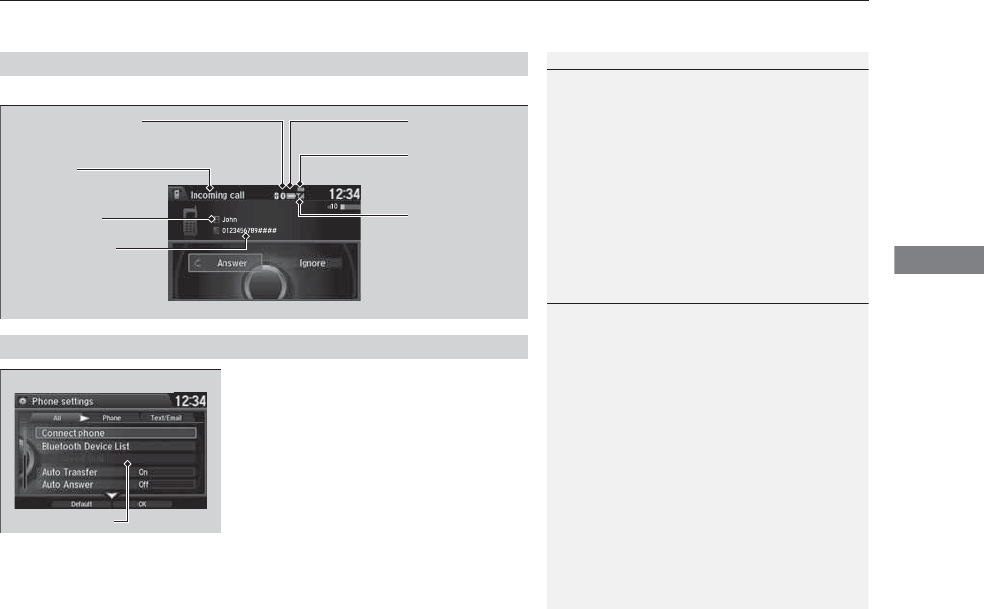
269
uuBluetooth® HandsFreeLink®uUsing HFL
Features
The audio/information screen notifies you when there is an incoming call.
Certain manual functions are disabled or
inoperable while the vehicle is in motion.
You cannot select a grayed-out option until
the vehicle is stopped.
Only previously stored speed dial entries with
voice tags, phonebook names, or numbers
can be called using voice commands while the
vehicle is in motion.
2Speed Dial P. 285
■HFL Status Display
1Bluetooth® HandsFreeLink®
Bluetooth® Wireless Technology
The Bluetooth® word mark and logos are registered
trademarks owned by Bluetooth SIG, Inc., and any
use of such marks by Honda Motors Co., Ltd., is
under license. Other trademarks and trade names are
those of their respective owners.
HFL Limitations
An incoming call on HFL will interrupt the audio
system when it is playing. It will resume when the call
is ended.
1HFL Status Display
The information that appears on the audio/
information screen varies between phone models.
You can change the system language to English,
French, or Spanish.
2Customized Features P. 248
■Limitations for Manual Operation
Bluetooth® Indicator
Comes on when your
phone is connected to HFL.
Signal Strength
HFL Mode
Battery Level
Status
Roam Status
Caller’s Name
Caller’s Number
Disabled Option
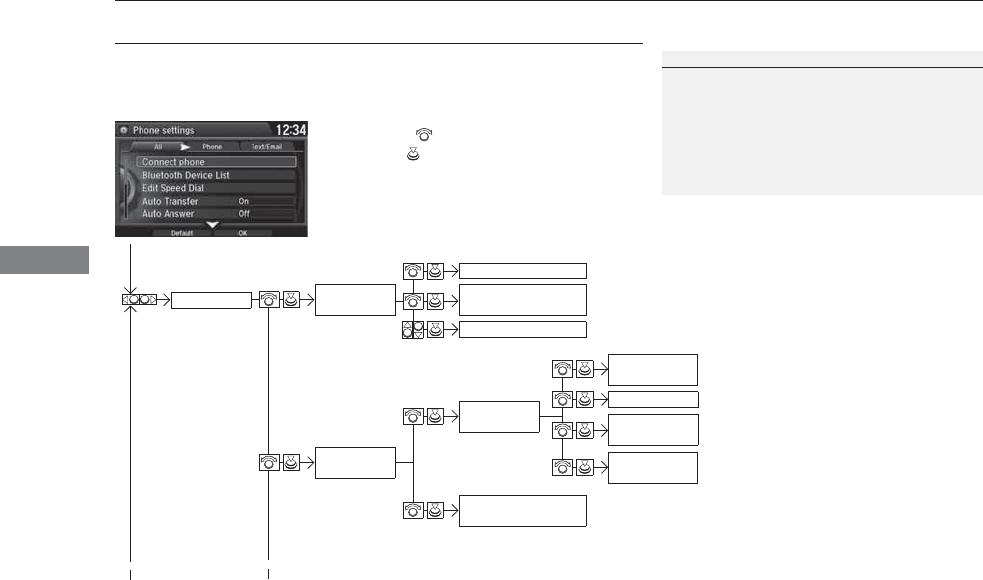
270
uuBluetooth® HandsFreeLink®uHFL Menus
Features
HFL Menus
The power mode must be in ACCESSORY or ON to use HFL.
■Phone Settings screen
1. Press the SETTINGS button.
2. Rotate to select Phone Settings, then
press .
1HFL Menus
To use HFL, you must first pair your Bluetooth-
compatible cell phone to the system while the vehicle
is parked.
Some functions are limited while driving. A message
appears on the screen when the vehicle is moving
and the operation is canceled.
Edit the user name of a paired phone.
Phone
Edit Device
Name
Connect
phone
Bluetooth
Device List
(Existing
entry list)
Replace This
Device
Add Bluetooth
Device
Disconnect a paired phone from the system.
Connect a phone to the system.
*1: Appears only when a phone is connected to HFL.
Disconnect
(Existing entry list)
Pair a phone to the system.
Edit PIN
Create a security PIN for a paired phone.
Replace a previously paired phone with a
new phone.
Delete This
Device Delete a previously paired phone.
Add Bluetooth
Device Pair a phone to the system.
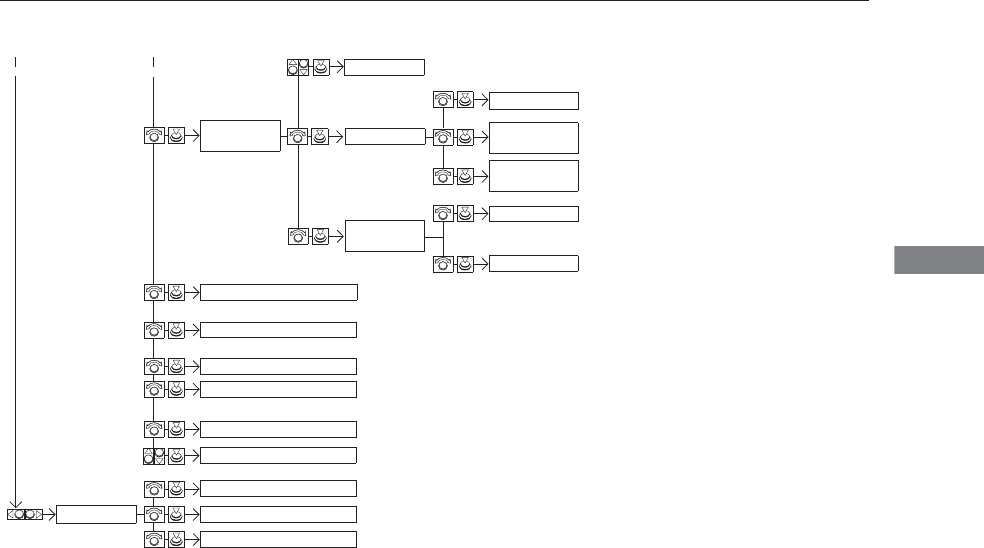
271
uuBluetooth® HandsFreeLink®uHFL Menus
Continued
Features
Text/Email*1
Manual Input
Edit Speed
Dial New Entry
Import from
Call History
*1: Appears only when a phone is connected to HFL.
Import from
Phonebook
Delete All Delete all the previously stored speed dial numbers.
Select a phone number from the call
history to store as a speed dial number.
Select a phone number from the
phonebook to store as a speed dial number.
Enter a phone number to store as a speed
dial number.
Edit
Delete
(Existing
entry list)
Edit a previously stored speed dial number.
●Change a number.
●Create or delete a voice tag.
Delete a previously stored speed dial number.
Set calls to automatically transfer from your phone to HFL when you enter the
vehicle.
Auto Transfer
Auto Answer
Ring Tone
Set whether to automatically answer an incoming call after about four
seconds.
Select the ring tone.
Use Contact Photo
Set phonebook data to be automatically imported when a phone is paired to
HFL.
Display a caller’s picture on an incoming call screen.
Automatic Phone Sync
Select Account Select a mail or text message account.
Enable Text/Email Turn the text message/E-mail function on and off.
New Text/Email Alert Select whether a pop-up alert comes on the screen when HFL receives a new
text message/E-mail.
Cancel/Reset all customized items in the Phone Settings group as default.
Default
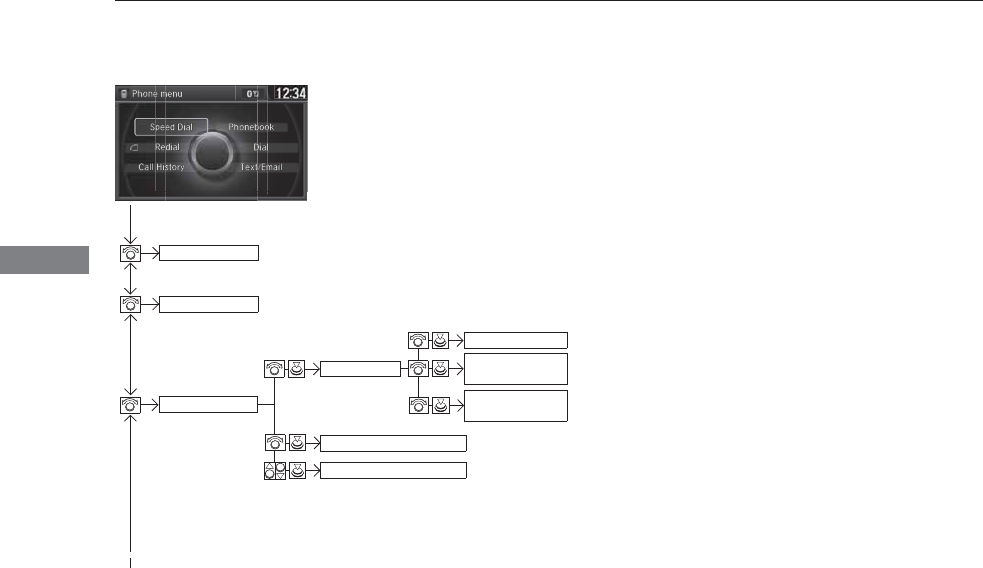
272
uuBluetooth® HandsFreeLink®uHFL Menus
Features
■Phone screen
1. Press the PHONE button.
2. Press the MENU button to display the
menu items.
Select a phone number from the call history to store as a
speed dial number.
Speed Dial*1
Manual Input
New Entry Import from
Call History
Import from
Phonebook
Select a phone number from the phonebook to store as a
speed dial number.
Enter a phone number to store as a speed dial number.
More Speed Dials Display another paired phone’s speed dial list.
*1: Appears only when a phone is connected to HFL.
(Existing entry list) Dial the selected number in the speed dial list.
Phonebook*1
Dial*1
Display the paired phone’s phonebook.
Enter a phone number to dial.
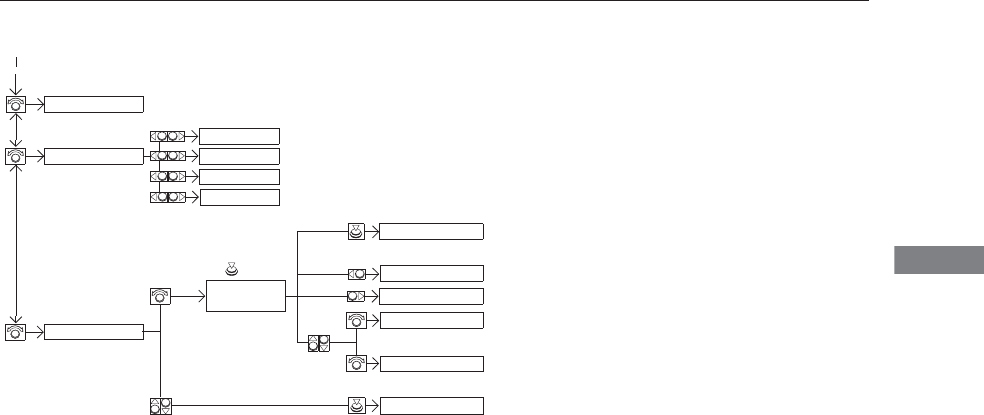
273
uuBluetooth® HandsFreeLink®uHFL Menus
Continued
Features
Text/Email*1
Message is
read aloud.
See the previous message.
(Read/Stop)
Previous
Next See the next message.
System reads received message aloud, or stop message
from being read.
Reply
Call
Reply to a received message using one of six fixed phrases.
Make a call to the sender.
Select Account
Select a message
and press .
Select a mail or text message account.
Redial*1 Redial the last number dialed in the phone’s history.
Display the last 20 outgoing, incoming and missed calls.
Call History*1
All
Dialed
Received
Display the last 20 outgoing calls.
Display the last 20 incoming calls.
Missed Display the last 20 missed calls.
*1: Appears only when a phone is connected to HFL.
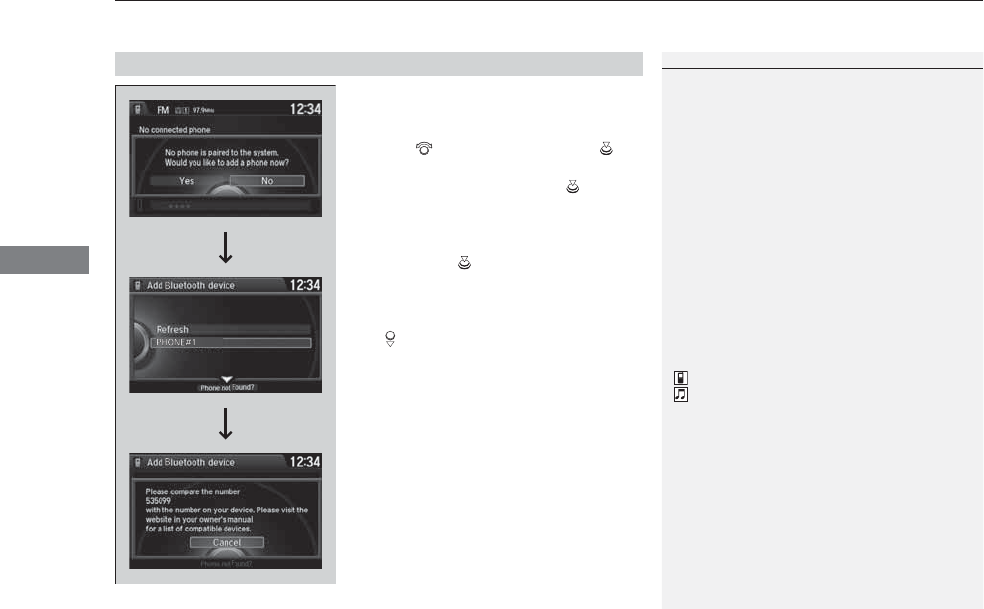
uuBluetooth® HandsFreeLink®uHFL Menus
274
Features
■To pair a cell phone (when there is no
phone paired to the system)
1. Press the PHONE button.
2. Rotate to select Yes, then press .
3. Make sure your phone is search or
discoverable mode, then press .
uHFL automatically searches for a
Bluetooth device.
4. When your phone appears on the list, select
it by pressing .
uIf your phone does not appear, you can
select Refresh to search again.
uIf your phone still does not appear, move
to select Phone not Found? and
search for Bluetooth devices using your
phone. From your phone, select
HandsFreeLink.
5. HFL gives you a pairing code on the audio/
information screen.
uConfirm if the pairing code on the screen
and your phone match.
This may vary by phone.
6. You will receive a notification on the screen
if pairing is successful.
■Phone Setup
1Phone Setup
Your Bluetooth-compatible phone must be paired to
HFL before you can make and receive hands-free
calls.
Phone Pairing Tips:
•You cannot pair your phone while the vehicle is
moving.
•Up to six phones can be paired.
•Your phone’s battery may drain faster when it is
connected to HFL.
•If your phone is not ready for pairing or not found
by the system within three minutes, the system will
time out and returns to idle.
Once you have paired a phone, you can see it
displayed on the screen with one or two icons on the
right side.
These icons indicate the following:
: The phone can be used with HFL.
: The phone is compatible with Bluetooth® Audio.
When pairing is completed, an Automatic Phone
Sync prompt appears. Select On if you want your call
history and phonebook automatically imported to
HFL.
2Changing the Automatic Phone Sync
setting P. 284
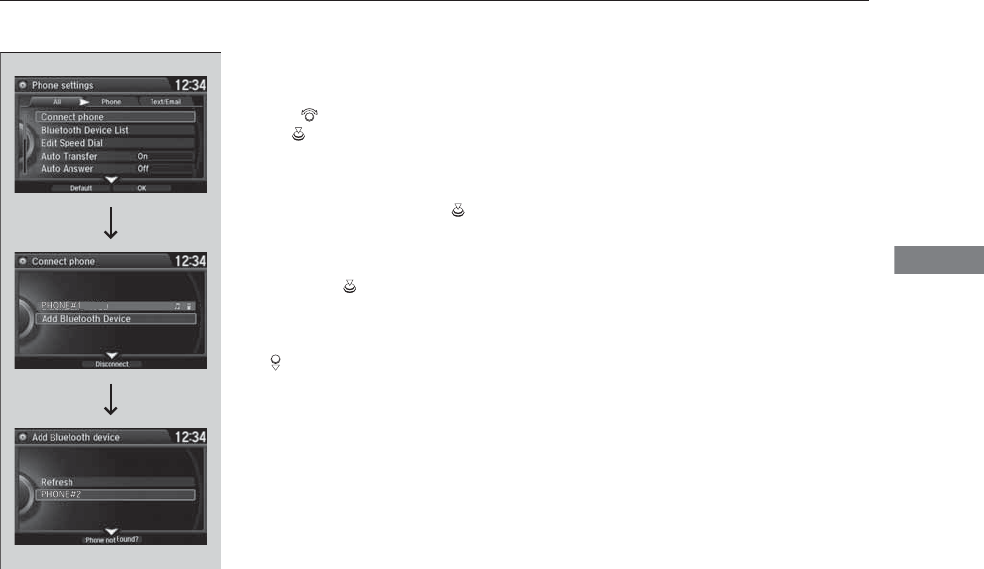
275
uuBluetooth® HandsFreeLink®uHFL Menus
Continued
Features
■To pair a cell phone (when a phone has
already been paired to the system)
1. Press the SETTINGS button.
2. Rotate to select Phone Settings, then
press .
uRepeat the procedure to select Connect
phone, then Add Bluetooth Device.
3. Make sure your phone is in search or
discoverable mode, then press .
uHFL automatically searches for a
Bluetooth device.
4. When your phone appears on the list, select
it by pressing .
uIf your phone does not appear, you can
select Refresh to search again.
uIf your phone still does not appear, move
to select Phone not Found? and
search for Bluetooth devices using your
phone. From your phone, select
HandsFreeLink.
5. HFL gives you a pairing code on the audio/
information screen.
uConfirm if the pairing code on the screen
and your phone match.
This may vary by phone.
6. You will receive a notification on the screen
if pairing is successful.
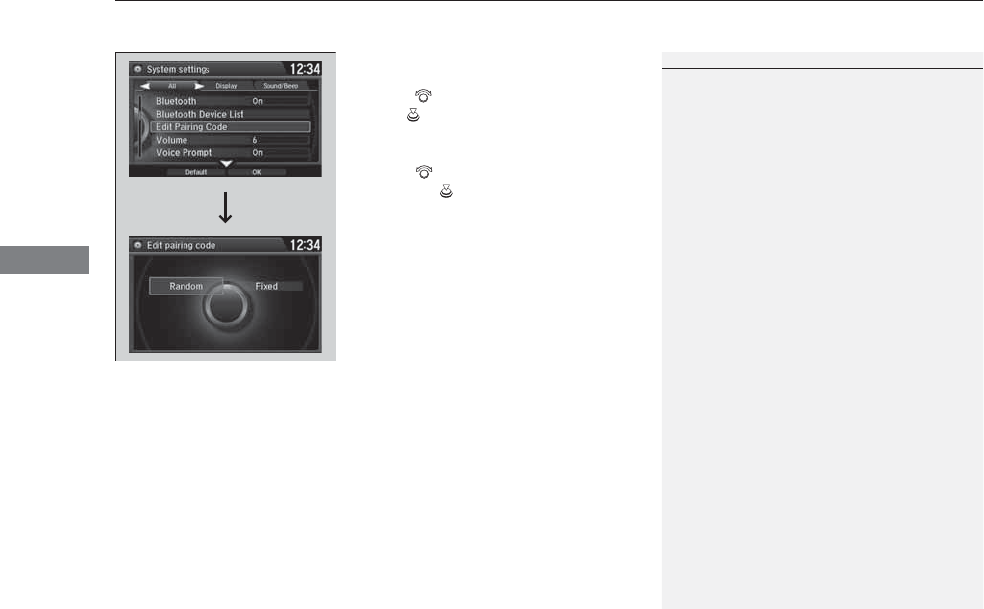
uuBluetooth® HandsFreeLink®uHFL Menus
276
Features
■To change the pairing code setting
1. Press the SETTINGS button.
2. Rotate to select System Settings, then
press .
uRepeat the procedure to select Edit
Pairing Code.
3. Rotate to select Fixed or Random,
then press .
1To change the pairing code setting
The pairing code may be six or four digits depending
on your phone.
The default pairing code is 0000 until you change the
setting.
To create your own, select Fixed, and delete the
current code, then enter a new one.
For a randomly generated pairing code each time you
pair a phone, select Random.
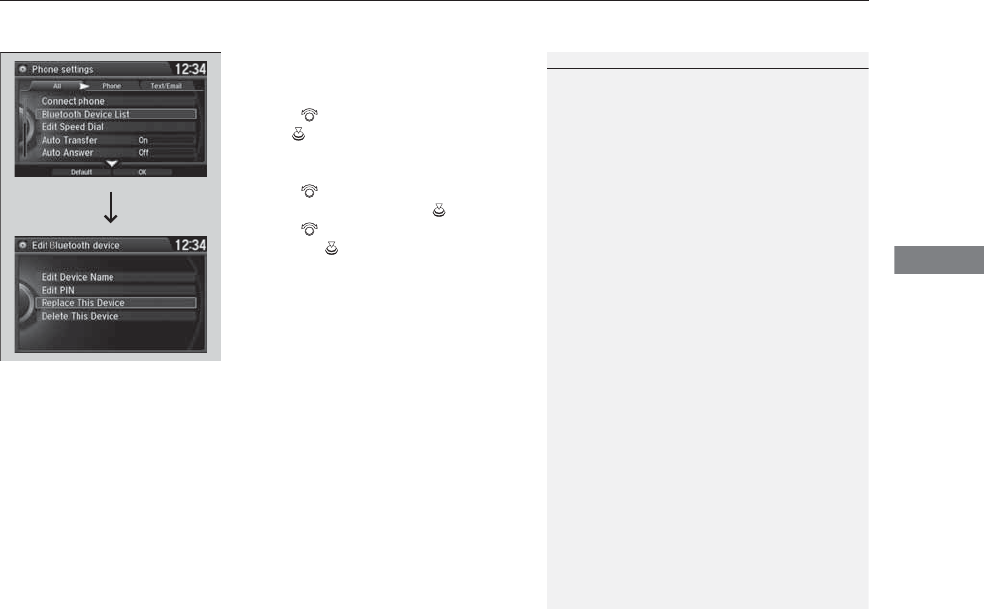
Continued 277
uuBluetooth® HandsFreeLink®uHFL Menus
Features
■To replace an already-paired phone
with a new phone
1. Press the SETTINGS button.
2. Rotate to select Phone Settings, then
press .
uRepeat the procedure to select
Bluetooth Device List.
3. Rotate to select a paired phone you
want to replace, then press .
4. Rotate to select Replace This Device,
then press .
5. HFL enters the pairing process and searches
a new phone.
uFollow the prompts to pair a new phone.
6. You will receive a notification on the screen
if pairing is successful.
1To replace an already-paired phone with a new phone
The replaced phone will keep the same speed dial
entries, and security PIN information from the
previously paired phone.
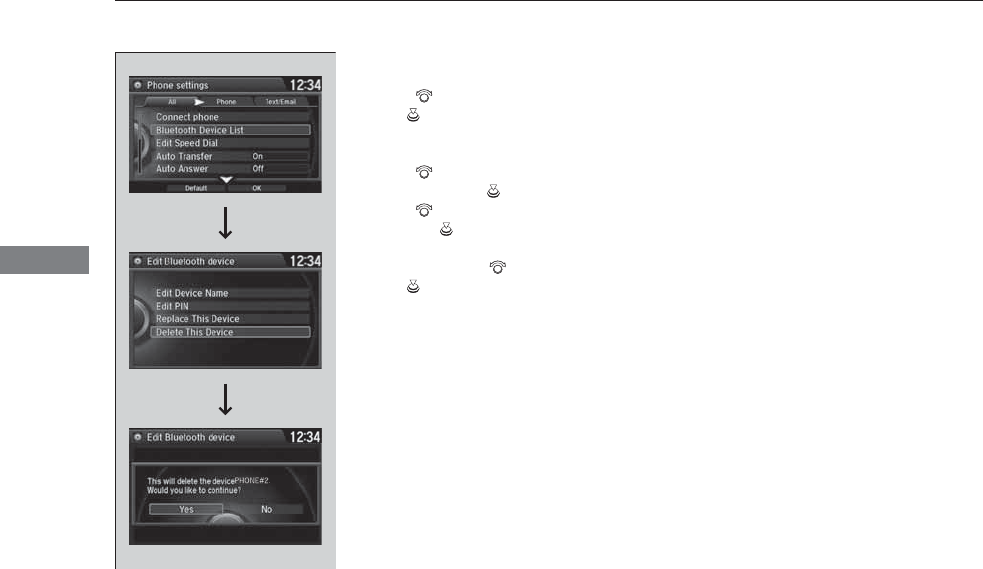
278
uuBluetooth® HandsFreeLink®uHFL Menus
Features
■To delete a paired phone
1. Press the SETTINGS button.
2. Rotate to select Phone Settings, then
press .
uRepeat the procedure to select
Bluetooth Device List.
3. Rotate to select a phone you want to
delete, then press .
4. Rotate to select Delete This Device,
then press .
5. You will receive a confirmation message on
the screen. Rotate to select Yes, then
press .
6. You will receive a notification on the screen
if it is successful.
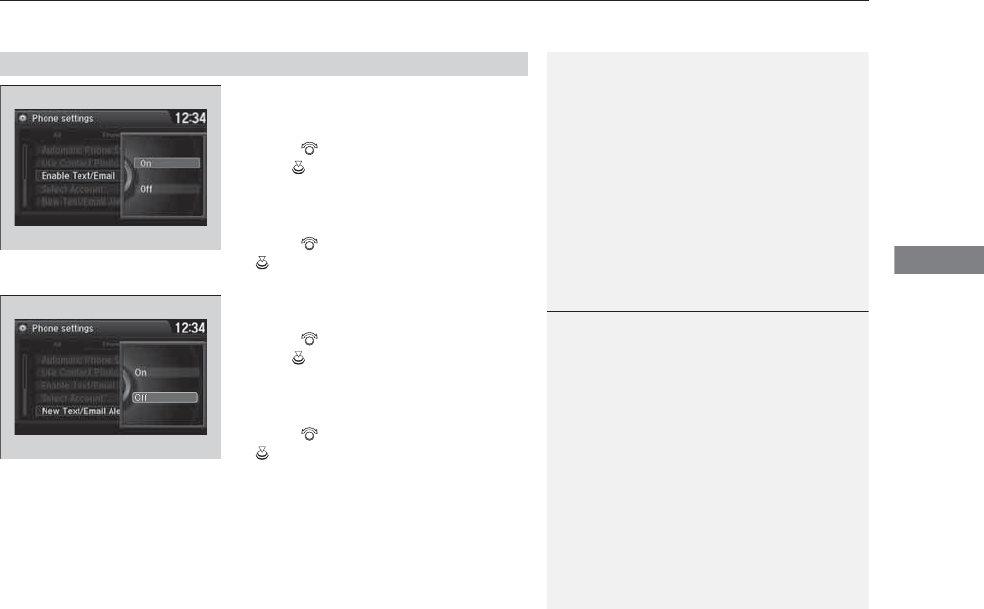
Continued 279
uuBluetooth® HandsFreeLink®uHFL Menus
Features
■To turn on or off the text/E-mail
function
1. Press the SETTINGS button.
2. Rotate to select Phone Settings, then
press .
uRepeat the procedure to select Enable
Text/Email.
uA pop-up menu appears on the screen.
3. Rotate to select On or Off, then press
.
■To turn on or off the text/E-mail notice
1. Press the SETTINGS button.
2. Rotate to select Phone Settings, then
press .
uRepeat the procedure to select New
Text/Email Alert.
uA pop-up menu appears on the screen.
3. Rotate to select On or Off, then press
.
■To Set Up a Text Message/E-mail Options
1To turn on or off the text/E-mail notice
On: A pop-up notification comes on every time you
receive a new text message.
Off: The message you receive is stored in the system
without notification.
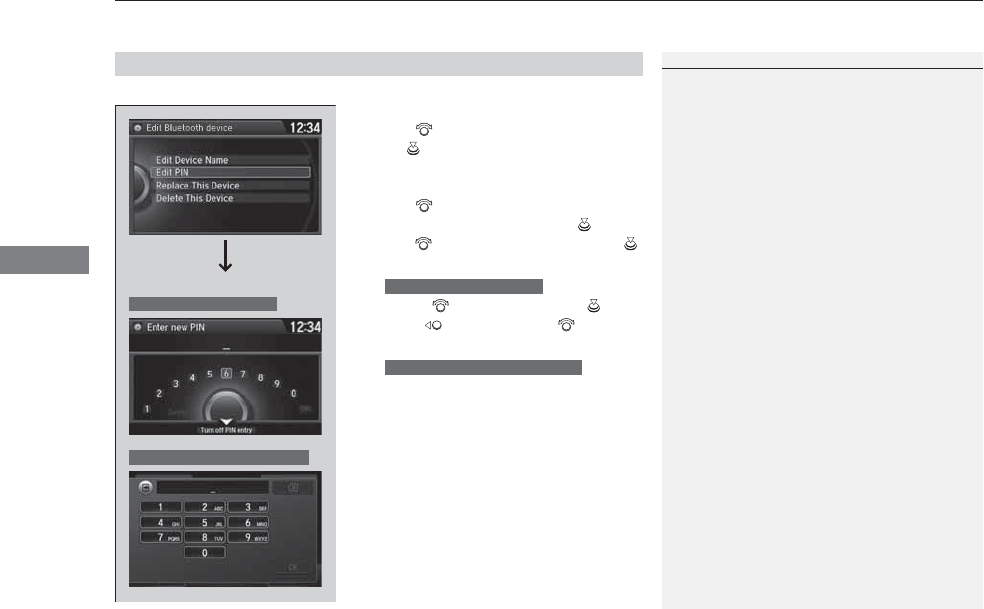
uuBluetooth® HandsFreeLink®uHFL Menus
280
Features
You can protect each of the six cell phones with a security PIN.
1. Press the SETTINGS button.
2. Rotate to select Phone Settings, then
press .
uRepeat the procedure to select
Bluetooth Device List.
3. Rotate to select a phone you want to
add a security PIN to, then press .
4. Rotate to select Edit PIN, then press .
5. Enter a new four-digit number.
u
Rotate to select, then press .
Move to delete. Rotate to select
OK to enter the security PIN.
u
You can also enter a number using the
icons.
6. Re-enter the four-digit number.
uThe screen returns to the screen in step
4.
■To Create a Security PIN
1To Create a Security PIN
If the phone is already security PIN protected, you
need to enter the current security PIN before clearing
the PIN or creating a new one.
Audio/information screen
On Demand Multi-Use DisplayTM
Audio/information screen
On Demand Multi-Use DisplayTM
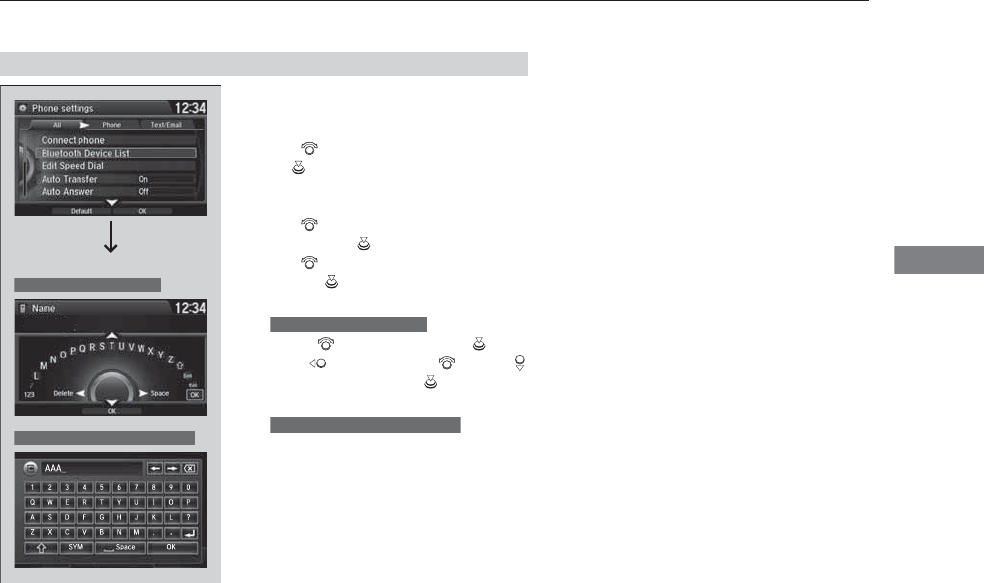
281
uuBluetooth® HandsFreeLink®uHFL Menus
Continued
Features
Edit the user name of a paired phone as
follows:
1. Press the SETTINGS button.
2. Rotate to select Phone Settings, then
press .
uRepeat the procedure to select
Bluetooth Device List.
3. Rotate to select a phone you want to
edit, then press .
4. Rotate to select Edit Device Name,
then press .
5. Enter a new name of the phone.
u
Rotate to select, then press .
Move to delete. Rotate or move
to select OK then press to enter the
name.
u
You can also enter a name using the
icons.
■Editing User Name
Audio/information screen
On Demand Multi-Use DisplayTM
Audio/information screen
On Demand Multi-Use DisplayTM
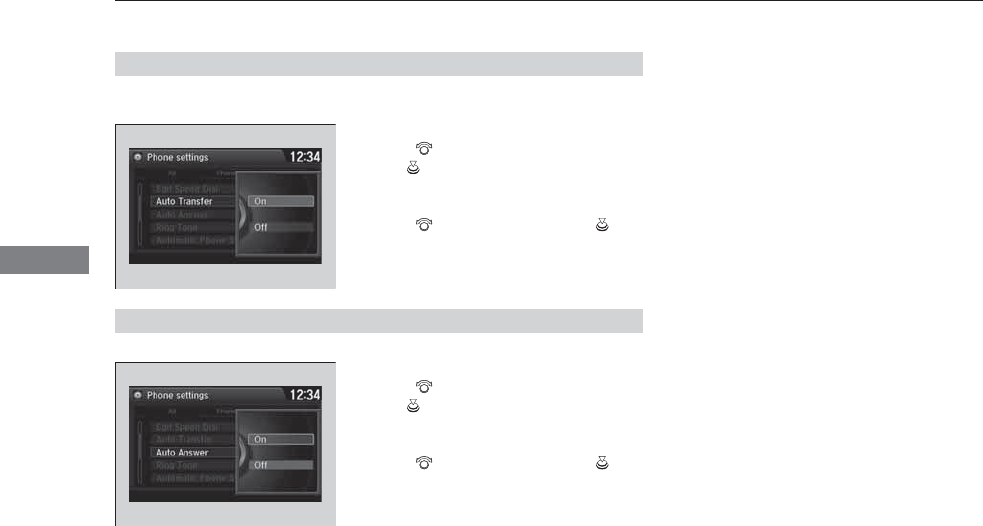
282
uuBluetooth® HandsFreeLink®uHFL Menus
Features
If you get into the vehicle while you are on the phone, the call can be automatically
transferred to HFL.
1. Press the SETTINGS button.
2. Rotate to select Phone Settings, then
press .
uRepeat the procedure to select Auto
Transfer.
3. Rotate to select On, then press .
You can set HFL to automatically answer an incoming call in four seconds.
1. Press the SETTINGS button.
2. Rotate to select Phone Settings, then
press .
uRepeat the procedure to select Auto
Answer.
3. Rotate to select On, then press .
■Automatic Transferring
■Auto Answer
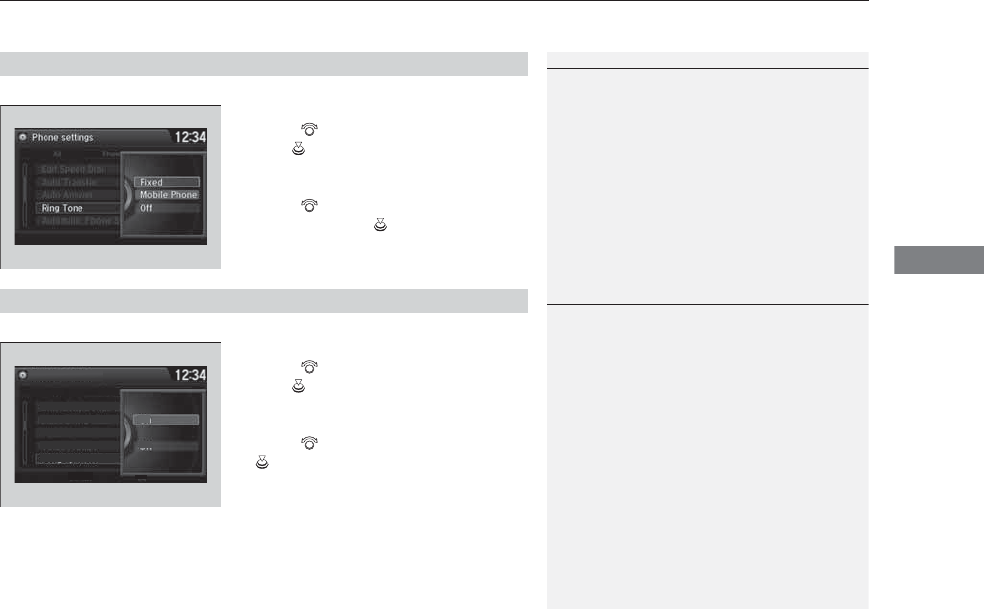
Continued 283
uuBluetooth® HandsFreeLink®uHFL Menus
Features
You can change the ring tone setting.
1. Press the SETTINGS button.
2. Rotate to select Phone Settings, then
press .
uRepeat the procedure to select Ring
Tone.
3. Rotate to select Fixed, Mobile Phone
or Off, then press .
You can display a caller’s picture on an incoming call screen.
1. Press the SETTINGS button.
2. Rotate to select Phone Settings, then
press .
uRepeat the procedure to select Use
Contact Photo.
3. Rotate to select On or Off, then press
.
■Ring Tone
1Ring Tone
Fixed: The fixed ring tone sounds from the speaker.
Mobile Phone: The ring tone stored in the
connected cell phone sounds from the speaker.
Off: No ring tones sound from the speaker.
■Use Contact Photo
1Use Contact Photo
This function may not be available on some phones.
Phone settings
All Phone
Auto Transfer
Auto Answer
Ring Tone
Automatic Phone Sy
Use Contact Photo
On
O
Default
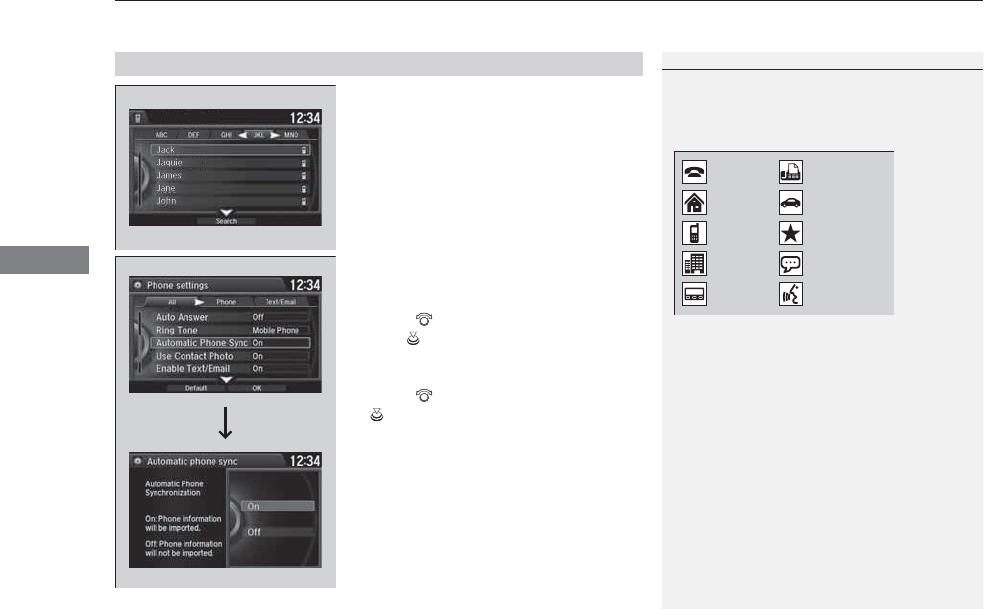
uuBluetooth® HandsFreeLink®uHFL Menus
284
Features
■When Automatic Phone Sync is set to
On:
When your phone is paired, the contents of its
phonebook and call history are automatically
imported to HFL.
■Changing the Automatic Phone Sync
setting
1. Press the SETTINGS button.
2. Rotate to select Phone Settings, then
press .
uRepeat the procedure to select
Automatic Phone Sync.
3. Rotate to select On or Off, then press
.
■Automatic Import of Cellular Phonebook and Call History
1Automatic Import of Cellular Phonebook and Call History
When you select a person from the list in the cellular
phonebook, you can see up to three category icons.
The icons indicate what types of numbers are stored
for that name.
On some phones, it may not be possible to import the
category icons to HFL.
The phonebook is updated after every connection.
Call history is updated after every connection or call.
Pref
Home
Mobile
Work
Pager
Fax
Car
Other
Message
Voice
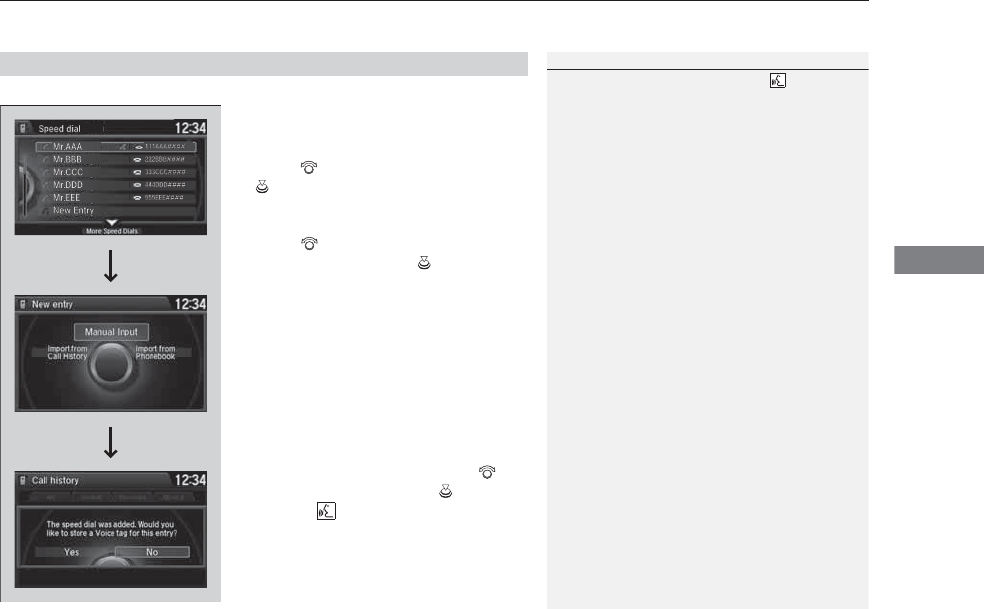
Continued 285
uuBluetooth® HandsFreeLink®uHFL Menus
Features
Up to 20 speed dial numbers can be stored per phone.
To store a speed dial number:
1. Press the PHONE button.
2. Press the MENU button.
3. Rotate to select Speed Dial, then press
.
uRepeat the procedure to select New
Entry.
4. Rotate to select a place to choose a
number from, then press .
From Import from Call History:
uSelect a number from the call history.
From Manual Input:
uInput the number manually.
From Import from Phonebook:
uSelect a number from the linked cell
phone’s imported phonebook.
5. When the speed dial is successfully stored
from Import from Call History or Import
from Phonebook, you are asked to create
a voice tag for the number. Rotate to
select Yes or No, then press .
6. Using the button, follow the prompts to
store a voice tag for the speed dial entry.
■Speed Dial
1Speed Dial
When a voice tag is stored, press the button to
call the number using the voice tag. Say “Call” and
the voice tag name.
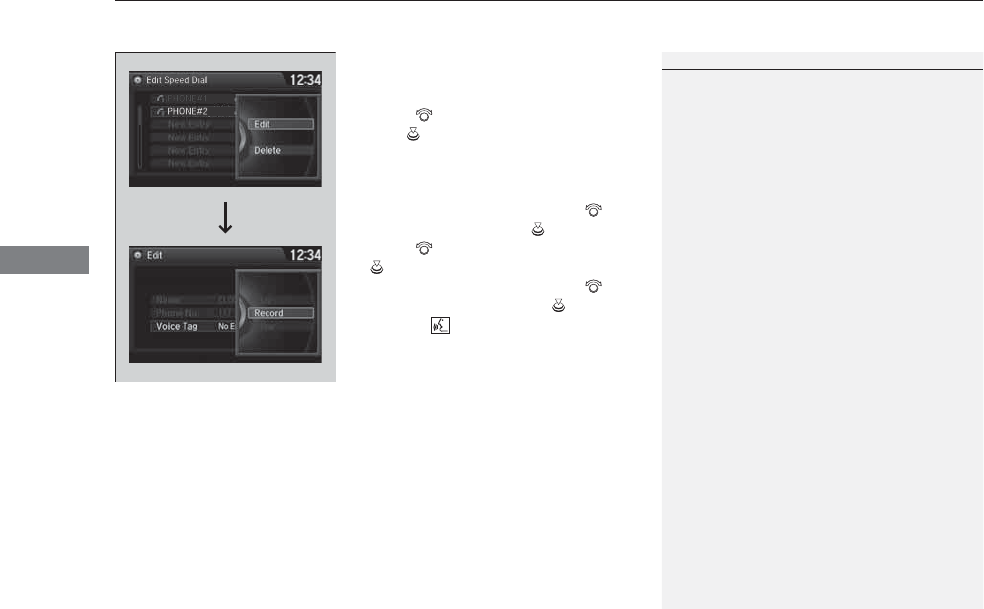
uuBluetooth® HandsFreeLink®uHFL Menus
286
Features
■To add a voice tag to a stored speed
dial number
1. Press the SETTINGS button.
2. Rotate to select Phone Settings, then
press .
uRepeat the procedure to select Edit
Speed Dial.
3. Select an existing speed dial entry.
uFrom the pop-up menu, rotate to
select Edit, then press .
4. Rotate to select Voice Tag, then press
.
uFrom the pop-up menu, rotate to
select Record, then press .
5. Using the button, follow the prompts to
complete the voice tag.
1Speed Dial
Avoid using duplicate voice tags.
Avoid using “home” as a voice tag.
It is easier for HFL to recognize a longer name. For
example, use “John Smith” instead of “John.”
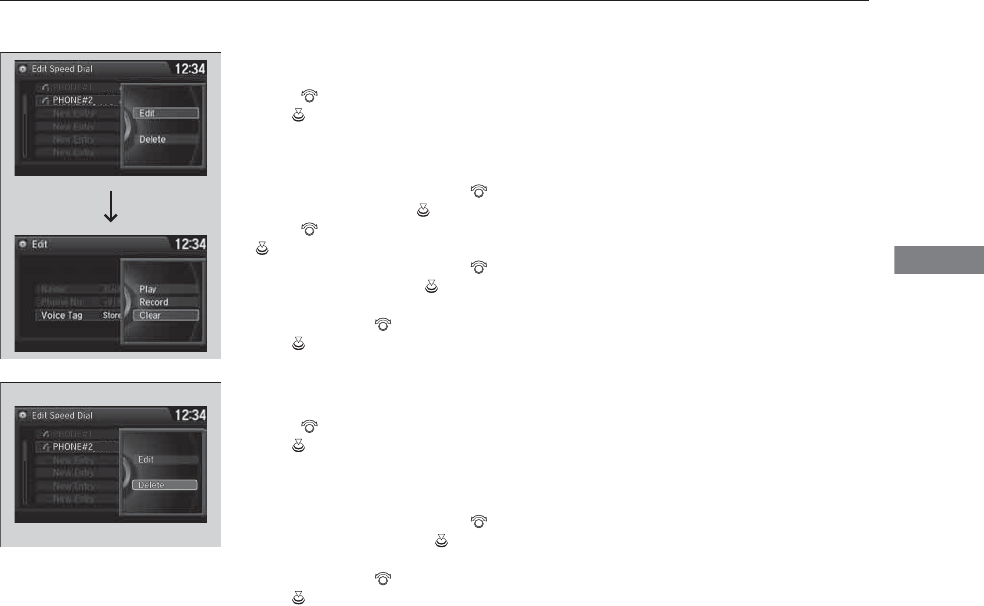
287
uuBluetooth® HandsFreeLink®uHFL Menus
Continued
Features
■To delete a voice tag
1. Press the SETTINGS button.
2. Rotate to select Phone Settings, then
press .
uRepeat the procedure to select Edit
Speed Dial.
3. Select an existing speed dial entry.
uFrom the pop-up menu, rotate to
select Edit, then press .
4. Rotate to select Voice Tag, then press
.
uFrom the pop-up menu, rotate to
select Clear, then press .
5. You will receive a confirmation message on
the screen. Rotate to select Yes, then
press .
■To delete a speed dial
1. Press the SETTINGS button.
2. Rotate to select Phone Settings, then
press .
uRepeat the procedure to select Edit
Speed Dial.
3. Select an existing speed dial entry.
uFrom the pop-up menu, rotate to
select Delete, then press .
4. You will receive a confirmation message on
the screen. Rotate to select Yes, then
press .
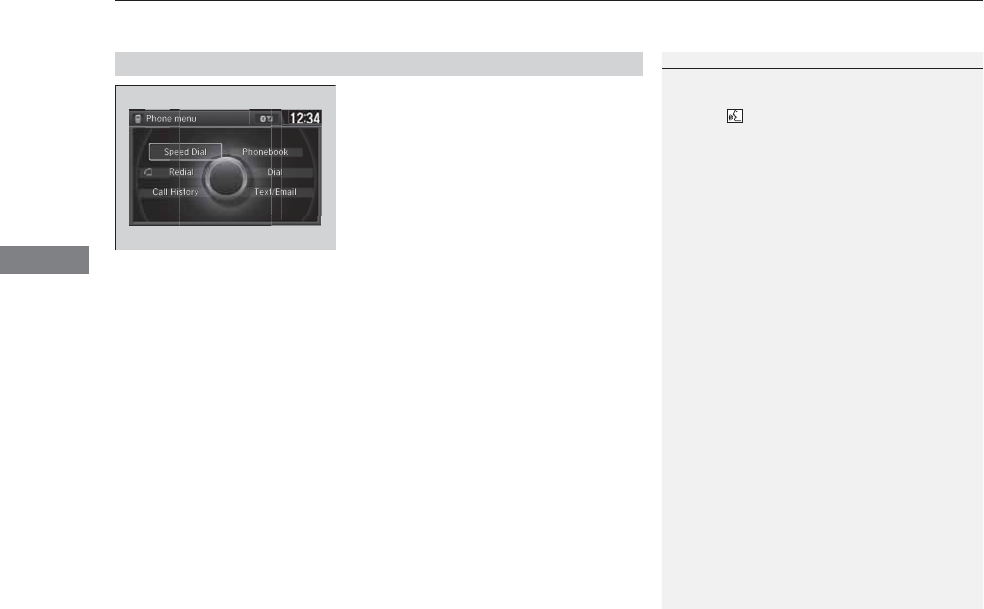
uuBluetooth® HandsFreeLink®uHFL Menus
288
Features
You can make calls by inputting any phone
number, or by using the imported
phonebook, call history, speed dial entries, or
redial.
■Making a Call
1Making a Call
Any voice-tagged speed dial entry, phonebook name,
or number can be dialed by voice from most screens.
Press the button and say “Call” and the voice tag
name, “Call by name” and the phonebook name, or
“Call” and the phone number.
The maximum range between your phone and
vehicles is 30 feet (10 meters).
Once a call is connected, you can hear the voice of
the person you are calling through the audio
speakers.
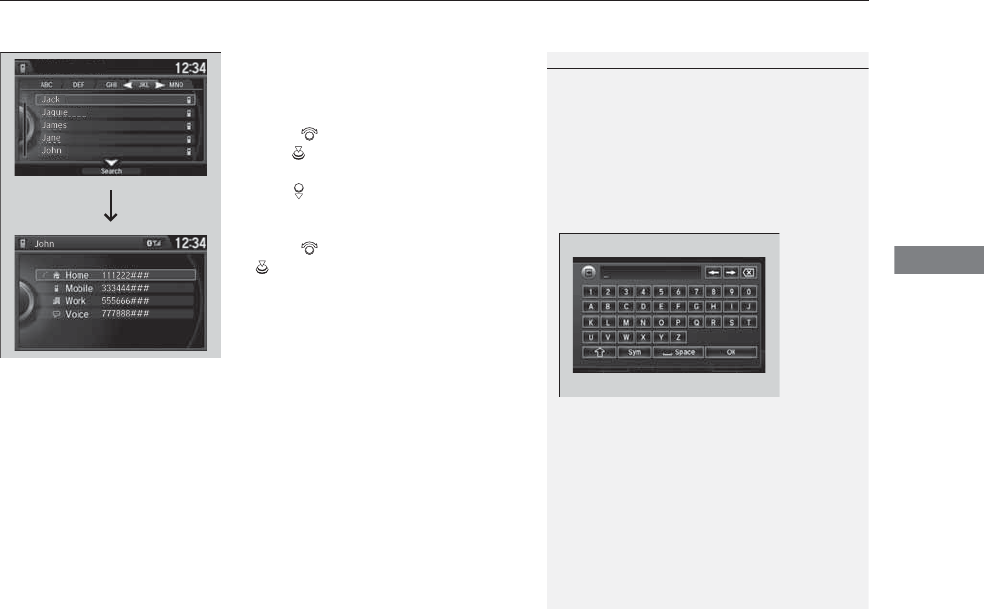
Continued 289
uuBluetooth® HandsFreeLink®uHFL Menus
Features
■To make a call using the imported
phonebook
1. Press the PHONE button.
2. Press the MENU button.
3. Rotate to select Phonebook, then
press .
4. The phonebook is stored alphabetically.
Move to Search.
uYou can use the keyboard on the touch
screen for an alphabetical search.
5. Rotate to select a number, then press
.
uDialing starts automatically.
1To make a call using the imported phonebook
This function is disabled while the vehicle is moving.
However, you can call a stored voice-tagged speed
dial number, phonebook name, or number using
voice commands.
2Limitations for Manual Operation P. 269
2Speed Dial P. 285
You can use the keyboard on the On Demand Multi-
Use DisplayTM for an alphabetical search.
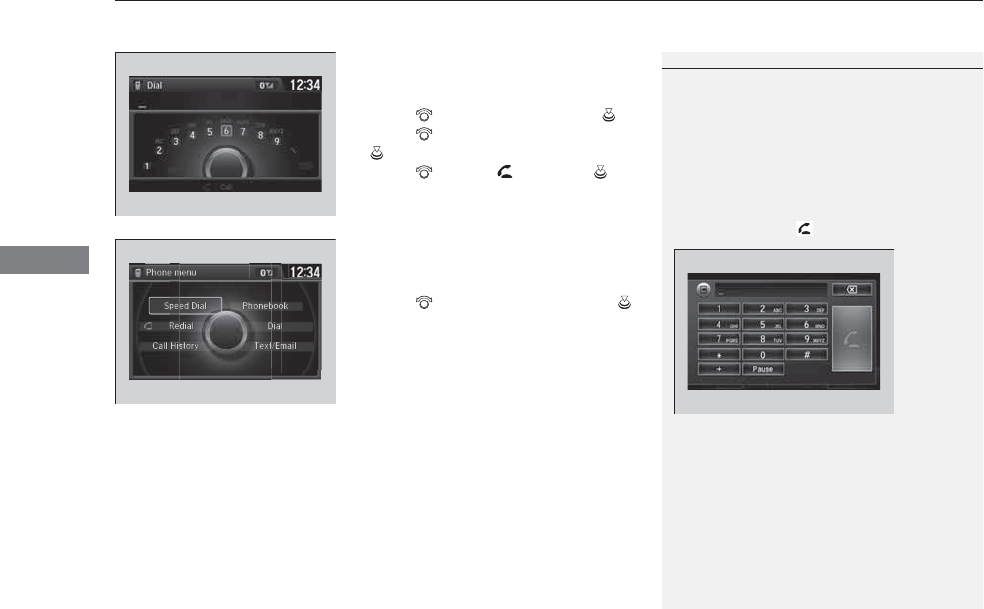
uuBluetooth® HandsFreeLink®uHFL Menus
290
Features
■To make a call using a phone number
1. Press the PHONE button.
2. Press the MENU button.
3. Rotate to select Dial, then press .
4. Rotate to select a number, then press
.
5. Rotate to select , then press .
uDialing starts automatically.
■To make a call using redial
1. Press the PHONE button.
2. Press the MENU button.
3. Rotate to select Redial, then press .
uDialing starts automatically.
1To make a call using a phone number
This function is disabled while the vehicle is moving.
However, you can call a stored voice-tagged speed
dial number, phonebook name, or number using
voice commands.
2Limitations for Manual Operation P. 269
2Speed Dial P. 285
You can use the keyboard on the On Demand Multi-
Use DisplayTM to input numbers.
Select numbers, then to start dialing.
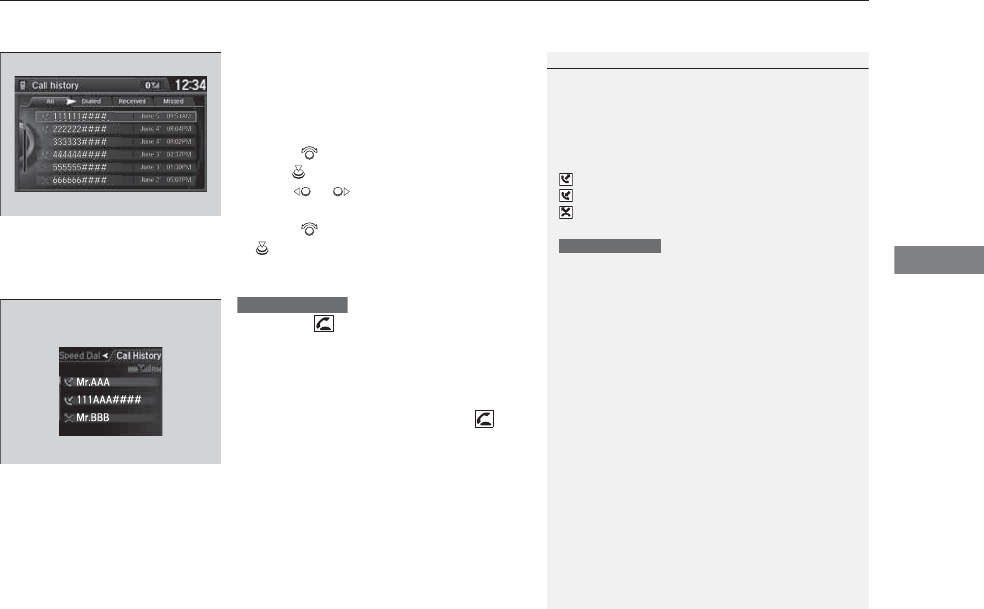
Continued 291
uuBluetooth® HandsFreeLink®uHFL Menus
Features
■To make a call using the call history
Call history is stored by All, Dialed,
Received, and Missed.
1. Press the PHONE button.
2. Press the MENU button.
3. Rotate to select Call History, then
press .
4. Move or to select All, Dialed,
Received, and Missed.
5. Rotate to select a number, then press
.
uDialing starts automatically.
1. Press the button.
2. Shift the left selector wheel right to select
Call History.
3. Roll the left selector wheel to select a
number.
4. Push the left selector wheel or the
button.
uDialing starts automatically.
1To make a call using the call history
The call history displays the last 20 dialed, received, or
missed calls.
(Appears only when a phone is connected to HFL.)
These icons next to the number indicate the
following:
: Dialed calls.
: Received calls.
: Missed calls.
The call history displays the last 12 dialed, received, or
missed calls.
Steering switches
111AAA####
Mr.AAA
Mr.BBB
On MID
Steering switches
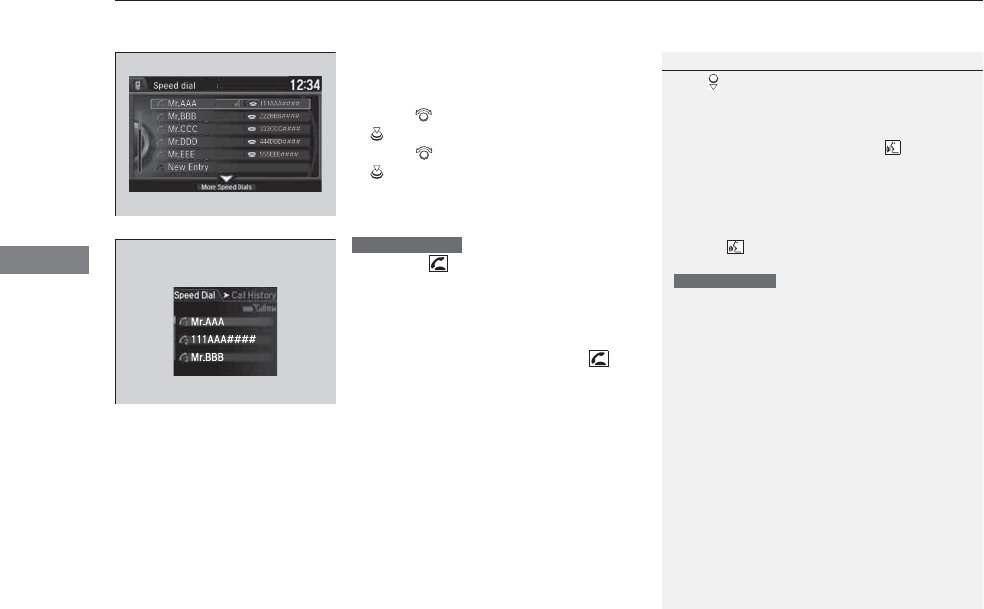
uuBluetooth® HandsFreeLink®uHFL Menus
292
Features
■To make a call using a speed dial entry
1. Press the PHONE button.
2. Press the MENU button.
3. Rotate to select Speed Dial, then press
.
4. Rotate to select a number, then press
.
uDialing starts automatically.
1. Press the button.
2. Shift the left selector wheel left to select
Speed Dial.
3. Roll the left selector wheel to select a
number.
4. Push the left selector wheel or the
button.
uDialing starts automatically.
1To make a call using a speed dial entry
Move to select More Speed Dials to view another
paired phone’s speed dial list. You can make a call
from that list using the currently connected phone.
When a voice tag is stored, press the button to
call the number using the voice tag.
2Speed Dial P. 285
Any voice-tagged speed dial entry, phonebook name
or number can be dialed by voice from any screen.
Press the button and follow the prompts.
The speed dial displays the 20 speed dial entries.
Steering switches
111AAA####
Mr.AAA
Mr.BBB
On MID
Steering switches
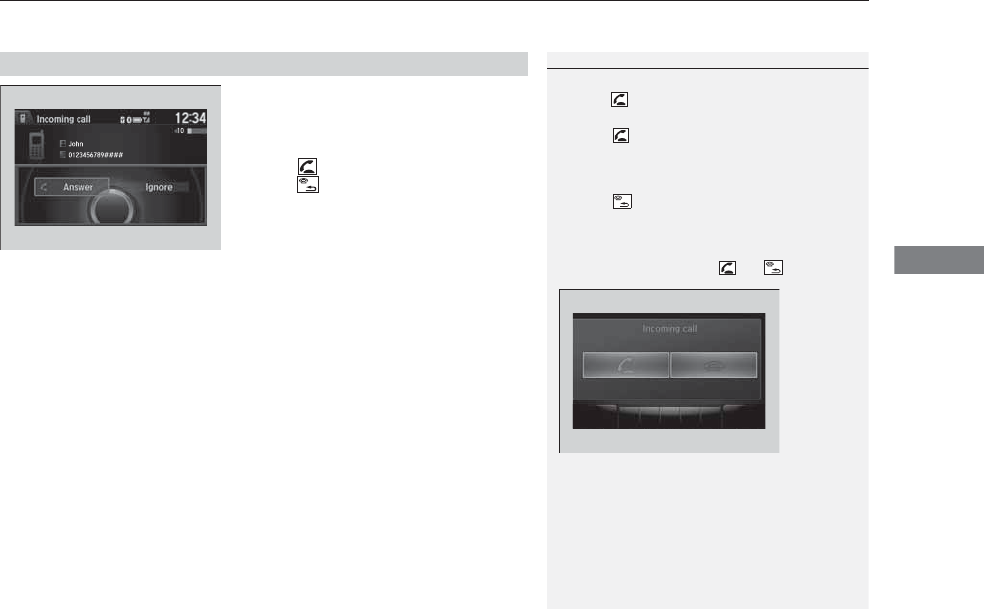
Continued 293
uuBluetooth® HandsFreeLink®uHFL Menus
Features
When there is an incoming call, an audible
notification sounds (if activated) and the
Incoming call screen appears.
Press the button to answer the call.
Press the button to decline or end the call.
■Receiving a Call
1Receiving a Call
Call Waiting
Press the button to put the current call on hold to
answer the incoming call.
Press the button again to return to the current
call.
Ignore the incoming call if you do not want to answer
it.
Press the button if you want to hang up the
current call.
You can select the icons on the On Demand Multi-
Use DisplayTM instead of the and buttons.
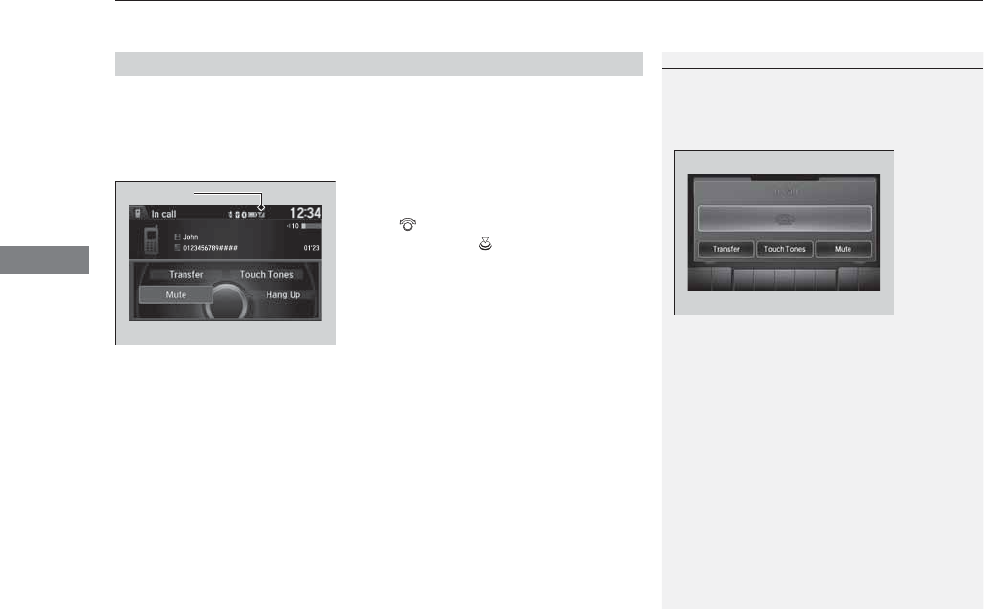
uuBluetooth® HandsFreeLink®uHFL Menus
294
Features
The following options are available during a call.
Mute: Mute your voice.
Transfer: Transfer a call from HFL to your phone.
Touch Tones: Send numbers during a call. This is useful when you call a menu-
driven phone system.
The available options are shown on the Phone
screen.
Rotate to select one of the available
options, then press .
uThe mute icon appears when Mute is
selected. Select Mute again to turn it off.
■Options During a Call
1Options During a Call
Touch Tones: Available on some phones.
You can select the icons on the On Demand Multi-
Use DisplayTM.
Mute Icon
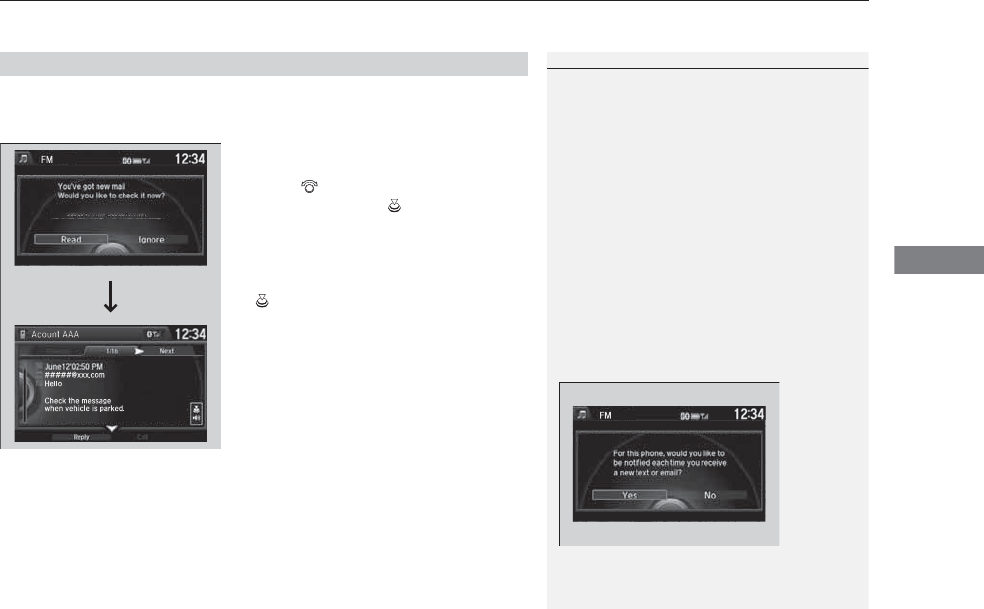
Continued 295
uuBluetooth® HandsFreeLink®uHFL Menus
Features
HFL can display newly received text messages and E-mails as well as 20 of the most
recently received messages on a linked cell phone. Each received message can be
read aloud and replied to using a fixed common phrase.
1. A pop-up appears and notifies you of a new
text message or E-mail.
2. Rotate to select Read to listen to the
message, then press .
uThe text message or E-mail is displayed.
The system automatically starts reading
out the message.
3. To discontinue the message read-out, press
.
■Receiving a Text Message/E-mail
1Receiving a Text Message/E-mail
The system does not display any received messages
while you are driving. You can only hear them read
aloud.
With some phones, you may be able to display up to
20 most recent text messages and E-mails.
State or local laws may limit your use of the HFL text
message/E-mail feature. Only use the text message/
E-mail feature when conditions allow you to do so
safely.
When you receive a text message or E-mail for the
first time since the phone is paired to HFL, you are
asked to turn the New Text/Email Alert setting to
On.
2To turn on or off the text/E-mail notice
P. 279
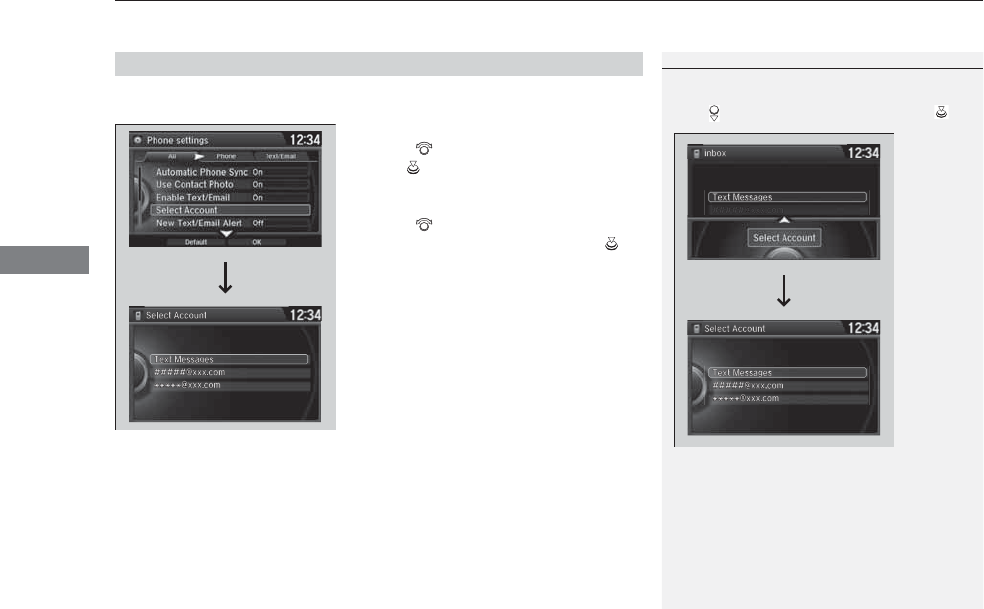
uuBluetooth® HandsFreeLink®uHFL Menus
296
Features
If a paired phone has text message or mail accounts, you can select one of them to
be active and receive notifications.
1. Press the SETTINGS button.
2. Rotate to select Phone Settings, then
press .
uRepeat the procedure to select Select
Account.
3. Rotate to select Text Messages or an
E-mail account you want, then press .
■Selecting a Mail Account
1Selecting a Mail Account
You can also select a mail account from the folder list
screen or the message list screen.
Move to select Select Account, then press .
You can only receive notifications from one text
message or mail account at a time.
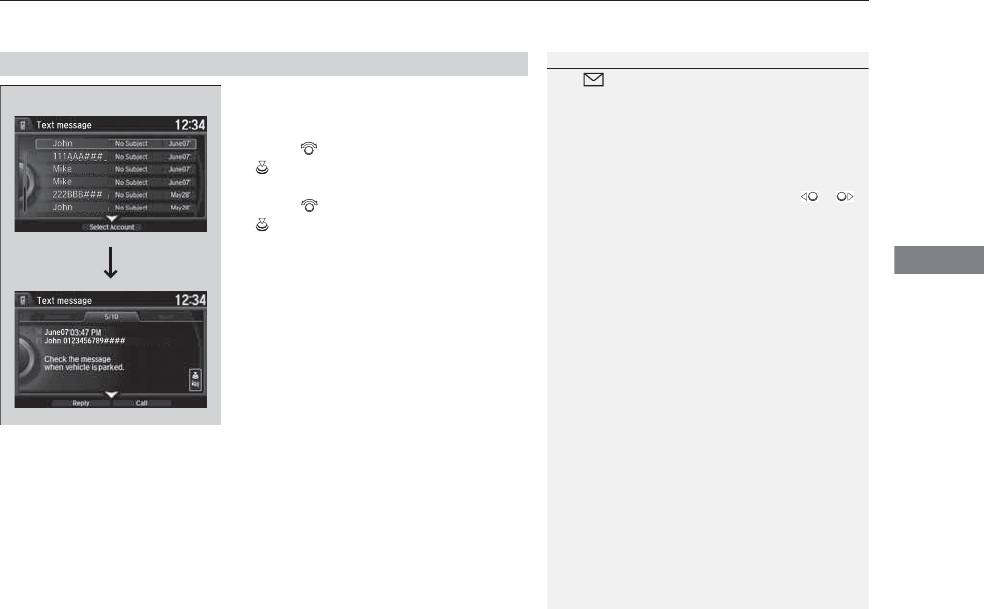
Continued 297
uuBluetooth® HandsFreeLink®uHFL Menus
Features
■Displaying text messages
1. Press the PHONE button.
2. Press the MENU button.
3. Rotate to select Text/Email, then press
.
uSelect account if necessary.
4. Rotate to select a message, then press
.
uThe text message is displayed. The
system automatically starts reading the
message aloud.
■Displaying Messages
1Displaying Messages
The icon appears next to an unread message.
If you delete a message on the phone, the message is
also deleted in the system. If you send a message
from the system, the message goes to your phone’s
outbox.
To see the previous or next message, move or
on the text message screen.
Message List
Text Message
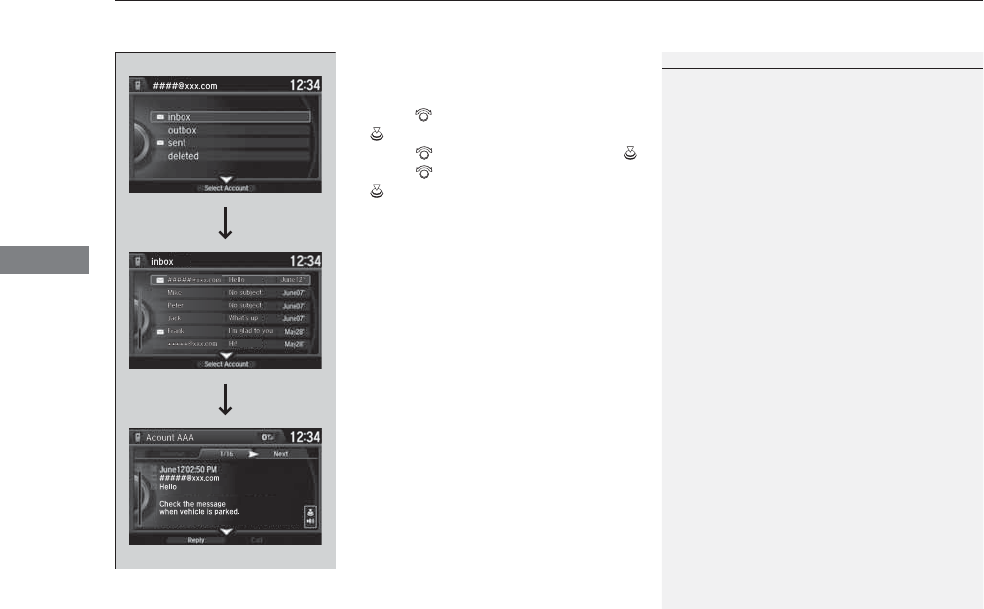
uuBluetooth® HandsFreeLink®uHFL Menus
298
Features
■Displaying E-mails
1. Press the PHONE button.
2. Press the MENU button.
3. Rotate to select Text/Email, then press
.
4. Rotate to select a folder, then press .
5. Rotate to select a message, then press
.
uThe E-mail is displayed. The system
automatically starts reading the message
aloud.
1Displaying E-mails
Received text messages and E-mails may appear in
the message list screen at the same time. In this case,
text messages are titled No subject.
Folder List
Message List
E-mail
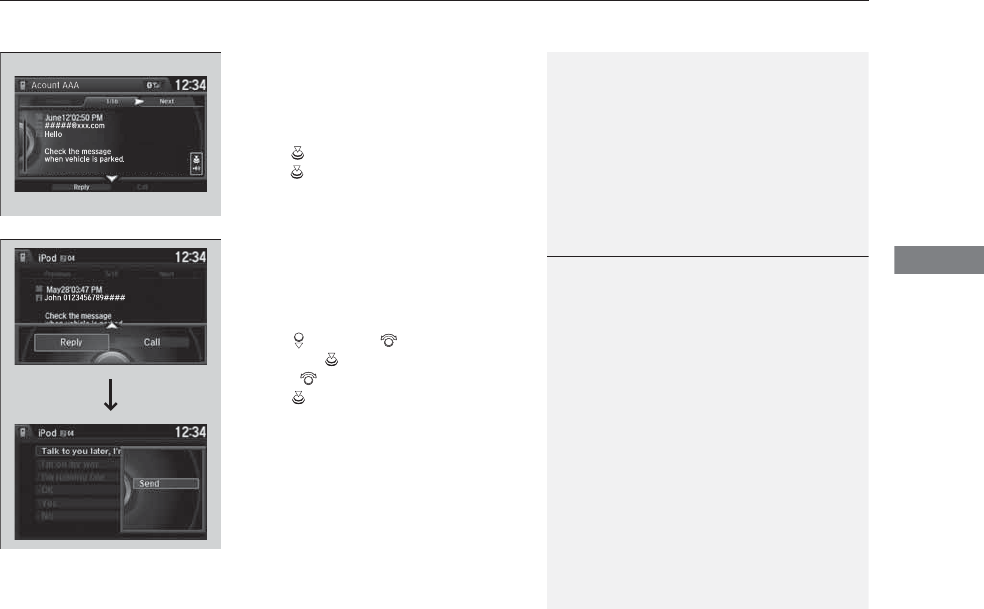
Continued 299
uuBluetooth® HandsFreeLink®uHFL Menus
Features
■Read or stop reading a message
1. Go to the text message or E-mail screen.
uThe system automatically starts reading
the message aloud.
2Displaying Messages P. 297
2. Press to stop reading.
Press again to start reading the message
from the beginning.
■Reply to a message
1. Go to the text message or E-mail screen.
uThe system automatically starts reading
the message aloud.
2Displaying Messages P. 297
2. Move and rotate to select Reply,
then press .
3. Rotate to select the reply message, then
press .
uThe pop-up menu appears on the screen.
4. Select Send to send the message.
uMessage Sent appears on the screen
when the reply message was successfully
sent.
1Reply to a message
The available fixed reply messages are as follows:
•Talk to you later, I’m driving.
•I’m on my way.
•I’m running late.
•OK
•Yes
•No
You cannot add, edit, or delete reply messages.

300
uuBluetooth® HandsFreeLink®uHFL Menus
Features
■Making a call to a sender
1. Go to the text message screen.
uThe system automatically starts reading
the message aloud.
2Displaying text messages P. 297
2. Move and rotate to select Call, then
press .
John 0123456789####
Reply Call
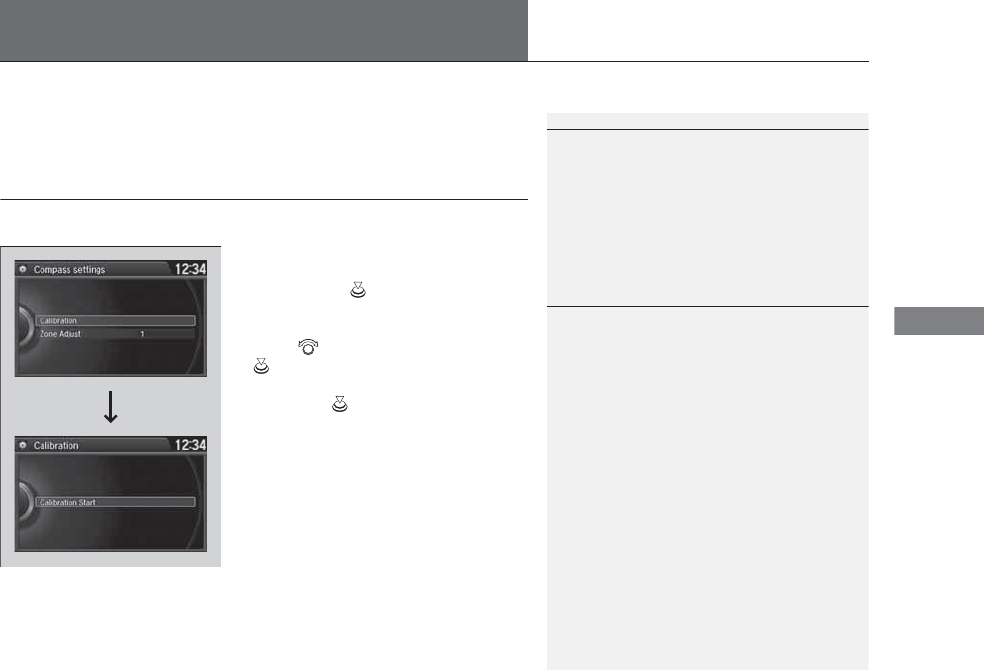
301
Features
Compass*
When you set the power mode to ON, the compass self-calibrates, and the compass
display appears.
Compass Calibration
If the compass indicates the wrong direction, or the CAL indicator blinks, you need
to manually calibrate the system.
1. Set the power mode to ON.
2. On the top screen of any audio source,
press and hold for five seconds.
uThe display switches to the Compass
settings screen.
3. Rotate to select Calibration, then press
.
4. When the display changes to Calibration
Start, press .
5. Drive the vehicle slowly in two circles.
uThe compass starts to show a direction
after the calibration. The CAL indicator
goes off.
1Compass*
Compass operation can be affected under the
following conditions:
•Driving near power lines or stations
•Crossing a bridge
•Passing a large vehicle, or driving near a large
object that can cause a magnetic disturbance
•When accessories such as antennas and roof racks
are mounted by magnets
1Compass Calibration
Calibrate the compass in an open area.
While setting the compass, press the BACK button to
cancel the setting mode and return to the previous
screen.
* Not available on all models
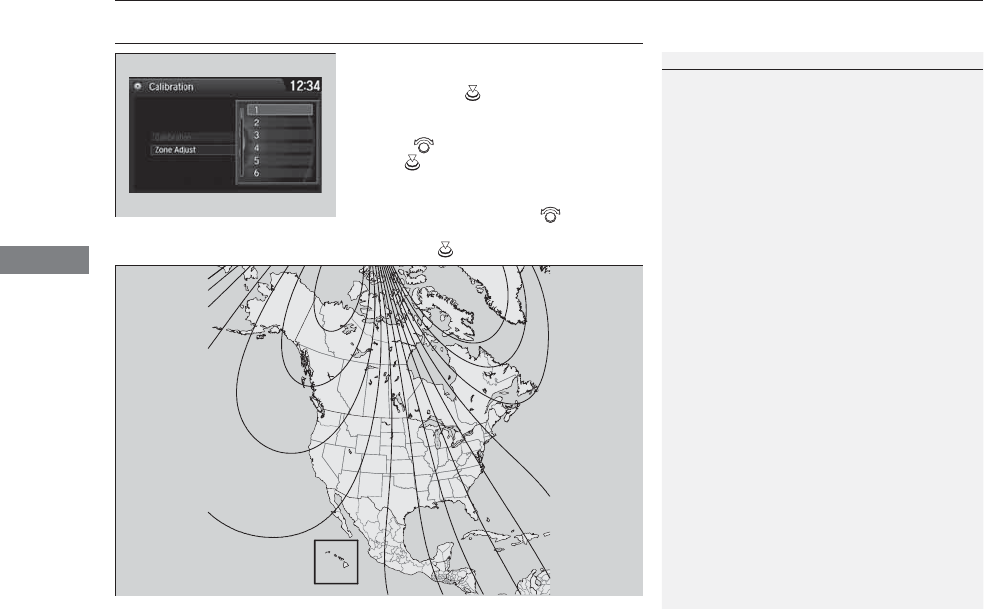
302
uuCompass*uCompass Zone Selection
Features
Compass Zone Selection
1. Set the power mode to ON.
2. On the top screen of any audio source,
press and hold for five seconds.
uThe display switches to the Compass
settings screen.
3. Rotate to select Zone Adjust, then
press .
uThe display shows the current zone
number the system is set to.
4. To change the zone, rotate to select the
zone number of your area (See Zone Map),
then press .
2
3
4
5
6789
10 11
12
13
14
15
Zone Map
Guam Island: Zone 8
Puerto Rico: Zone 11
1Compass Zone Selection
The zone selection is done to compensate the
variation between magnetic north and true north.
If the calibration starts while the audio system is in
use, the display returns to normal after the calibration
is completed.
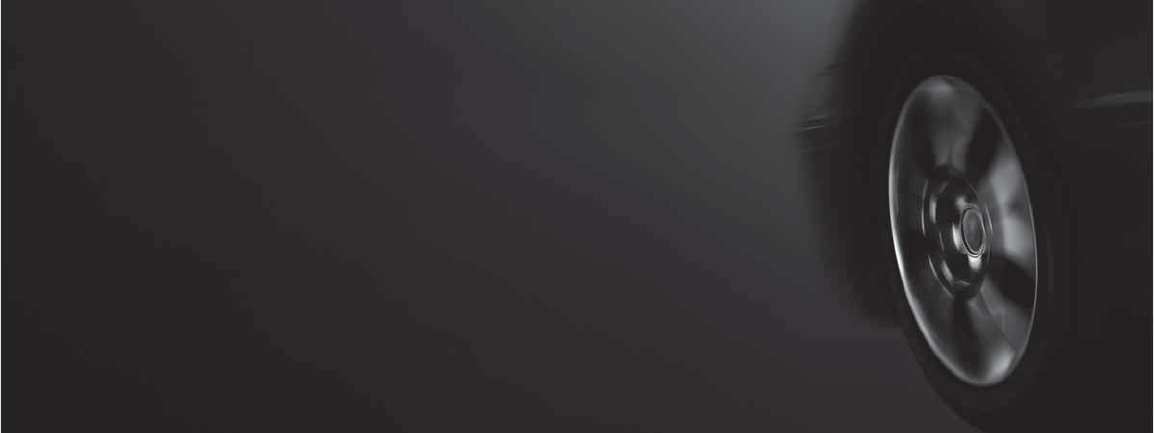
303
Driving
This chapter discusses driving, refueling, and information on items such as accessories.
Before Driving
Driving Preparation .......................... 304
Maximum Load Limit........................307
Towing a Trailer................................ 309
Off-Highway Driving Guidelines ..... 320
When Driving
Starting the Engine .......................... 322
Precautions While Driving.................327
Automatic Transmission ...................328
Shifting............................................ 329
Integrated Dynamics System (IDS)..... 333
Cruise Control ................................. 334
Adaptive Cruise Control (ACC) with Low
Speed Follow (LSF)*......................... 337
Forward Collision Warning (FCW)*.. 346
Lane Departure Warning (LDW)*..... 350
Lane Keeping Assist System (LKAS)*.. 353
VSA® (Vehicle Stability Assist), aka ESC
(Electronic Stability Control), System .. 358
Agile Handling Assist System............ 360
Blind Spot Information (BSI) System*... 361
Super Handling-All Wheel DriveTM (SH-
AWD®)*......................................... 363
Tire Pressure Monitoring System (TPMS)... 363
Tire Pressure Monitoring System (TPMS) -
Required Federal Explanation ......... 365
Braking
Brake System ................................... 367
Anti-lock Brake System (ABS) ........... 369
Brake Assist System ......................... 370
Collision Mitigation Braking SystemTM
(CMBSTM)*..................................... 371
Parking Your Vehicle
When Stopped ................................ 377
Parking Sensor System*................... 378
Multi-View Rear Camera*................ 382
Refueling
Fuel Information .............................. 383
How to Refuel ................................. 384
Fuel Economy.................................... 385
Accessories and Modifications ........ 386
* Not available on all models
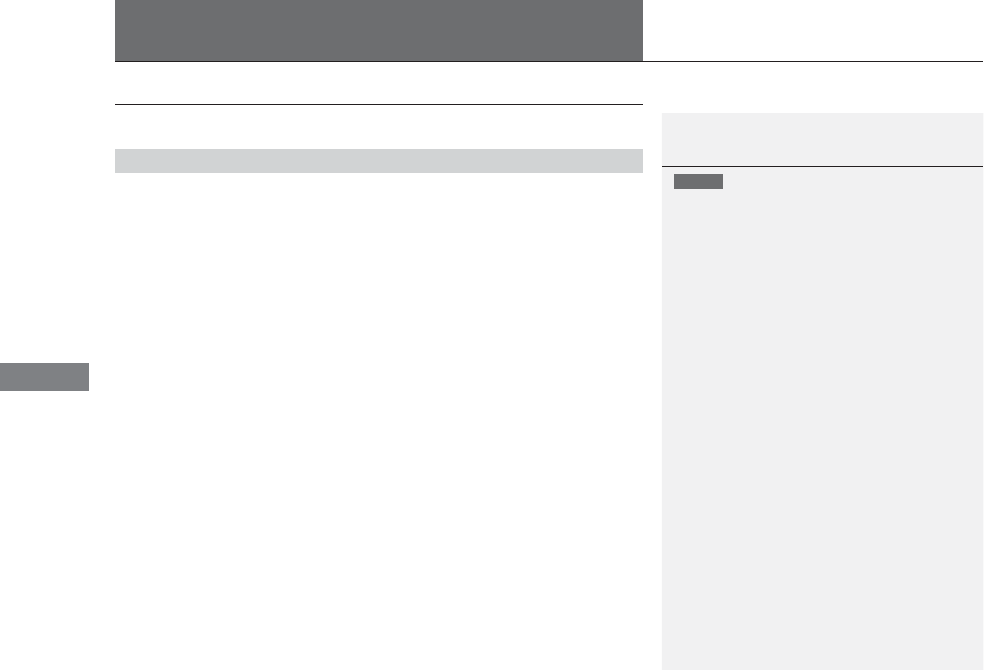
304
Driving
Before Driving
Driving Preparation
Check the following items before you start driving.
•Make sure there are no obstructions on the windows, door mirrors, exterior
lights, or other parts of the vehicle.
uRemove any frost, snow, or ice.
uRemove any snow on the roof, as this can slip down and obstruct your field of
vision while driving. If frozen solid, remove ice once it has softened.
uWhen removing ice from around the wheels, be sure not to damage the wheel
or wheel components.
•Make sure the hood is securely closed.
uIf the hood opens while driving, your front view will be blocked.
•Make sure the tires are in good condition.
uCheck air pressure, check for damage and excessive wear.
2Checking and Maintaining Tires P. 417
•Make sure there are no people or objects behind or around the vehicle.
uThere are blind spots from the inside.
■Exterior Checks
1Exterior Checks
NOTICE
When doors are frozen shut, use warm water around
the door edges to melt any ice. Do not try to force
them open, as this can damage the rubber trim
around the doors. When done, wipe dry to avoid
further freezing.
Do not pour warm water into the key cylinder.
You will be unable to insert key if the water freezes in
the hole.
Heat from the engine and exhaust can ignite
flammable materials left under the hood, causing a
fire. If you’ve parked your vehicle for an extended
period, inspect and remove any debris that may have
collected, such as dried grass and leaves that have
fallen or have been carried in for use as a nest by a
small animal.
Also check under the hood for leftover flammable
materials after you or someone else has performed
maintenance on your vehicle.
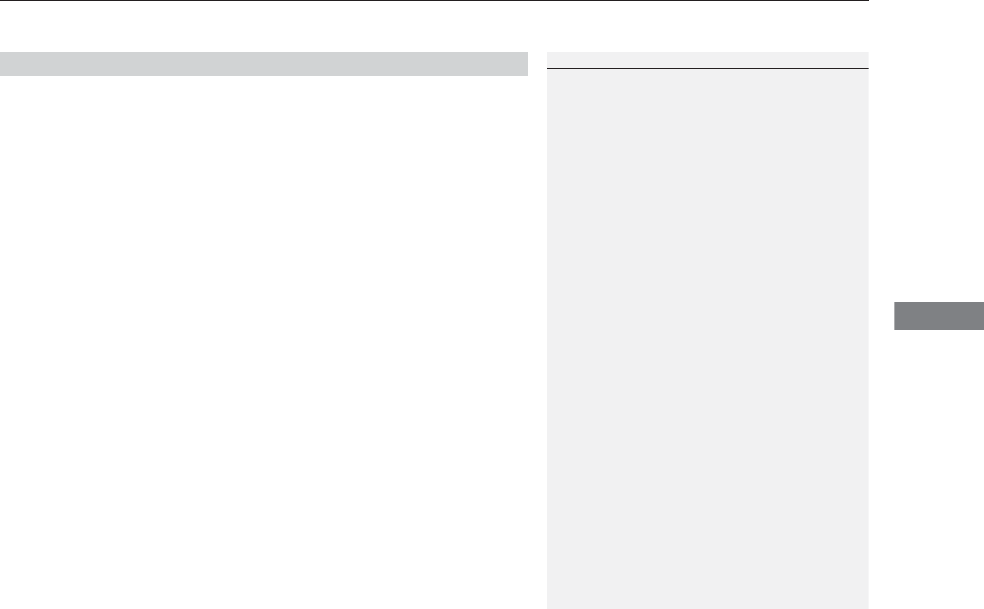
Continued 305
uuBefore DrivinguDriving Preparation
Driving
•Store or secure all items on board properly.
uCarrying too much cargo, or improperly storing it, can affect your vehicle’s
handling, stability, stopping distance, and tires, and make it unsafe.
2Maximum Load Limit P. 307
•Do not pile items higher than the seat height.
uThey can block your view and may be thrown forward in the event of sudden
braking.
•Do not place anything in the front seat footwells. Make sure to secure the floor
mat.
uAn object or unsecured floor mat can interfere with your brake and accelerator
pedal operation while driving.
•If you have any animals on board, do not let them move around in the vehicle.
uThey may interfere with driving and a crash could occur.
•Securely close and lock all doors and the tailgate.
2Locking/Unlocking the Doors from the Inside P. 124
•Adjust your seating position properly.
uAdjust the head restraint, too.
2Adjusting the Seats P. 161
2Adjusting the Head Restraints P. 164
•Adjust the mirrors and steering wheel properly for your driving.
uAdjust them while sitting in the proper driving position.
2Adjusting the Steering Wheel P. 157
2Adjusting the Mirrors P. 158
■Interior Checks
1Interior Checks
The headlight aim is set by the factory, and does not
need to be adjusted. However, if you regularly carry
heavy items in the cargo area or tow a trailer, have
the aiming readjusted at a dealer or by a qualified
technician.

306
uuBefore DrivinguDriving Preparation
Driving
•Be sure items placed on the floor behind the front seats cannot roll under the
seats.
uThey can interfere with the driver’s ability to operate the pedals, the operation
of the seats, or the operation of the sensors under the seats.
•Everyone in the vehicle must fasten their seat belt.
2Fastening a Seat Belt P. 34
•Make sure that the indicators in the instrument panel come on when you start the
vehicle, and go off soon after.
uAlways have a dealer check the vehicle if a problem is indicated.
2Indicators P. 70
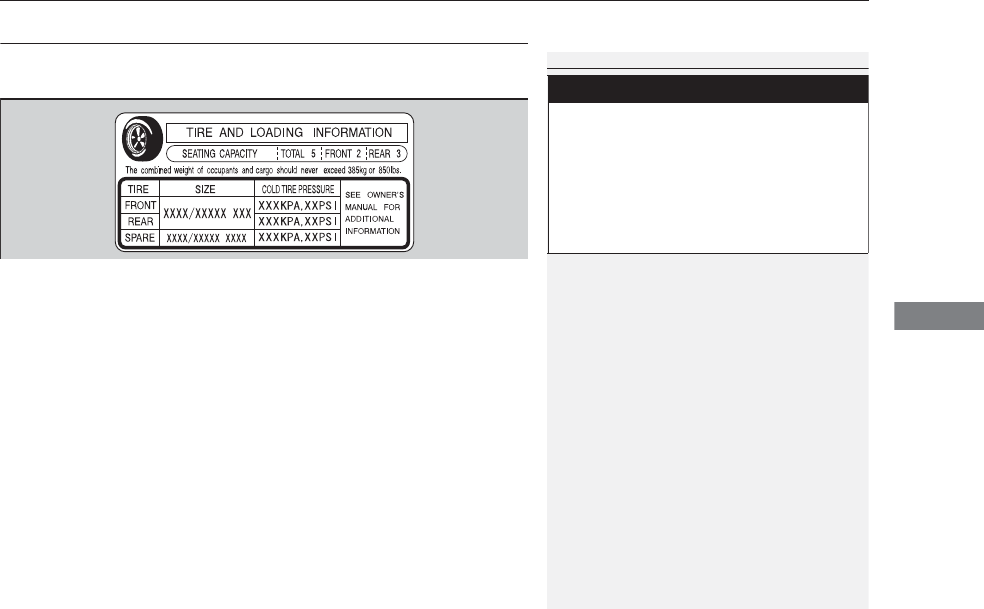
307
uuBefore DrivinguMaximum Load Limit
Continued
Driving
Maximum Load Limit
The maximum load for your vehicle is 1,173 lbs (532 kg).
See Tire and Loading Information label attached to the driver’s doorjamb.
This figure includes the total weight of all occupants, cargo, and
accessories, and the tongue load if you are towing a trailer.
Steps for Determining Correct Load Limit -
(1) Locate the statement “The combined weight of occupants and
cargo should never exceed XXX kg or XXX lbs.” on your
vehicle’s placard.
(2) Determine the combined weight of the driver and passengers
that will be riding in your vehicle.
(3) Subtract the combined weight of the driver and passengers
from XXX kg or XXX lbs.
(4) The resulting figure equals the available amount of cargo and
luggage load capacity. For example, if the “XXX” amount
equals 1,400 lbs. and there will be five 150 lb. passengers in
your vehicle, the amount of available cargo and luggage load
capacity is 650 lbs.
(1,400 - 750 (5 x 150) = 650 lbs.)
1Maximum Load Limit
Gross Vehicle Weight Rating (GVWR):
The maximum allowable weight of the vehicle, all
occupants, all accessories, all cargo, and the tongue
load.
2Specifications P. 480
Gross Axle Weight Rating (GAWR):
The maximum allowable weight of the vehicle axle.
2Specifications P. 480
3
WARNING
Overloading or improper loading
can affect handling and stability
and cause a crash in which you
can be hurt or killed.
Follow all load limits and other
loading guidelines in this manual.
Label Example
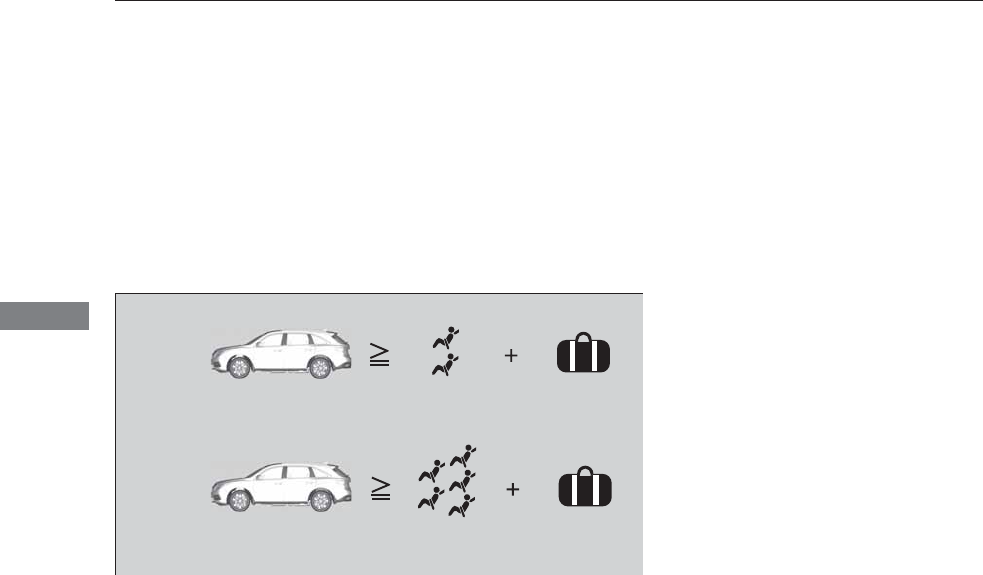
308
uuBefore DrivinguMaximum Load Limit
Driving
(5) Determine the combined weight of luggage and cargo being
loaded on the vehicle. That weight may not safely exceed the
available cargo and luggage load capacity calculated in step 4.
(6) If your vehicle will be towing a trailer, load from your trailer will
be transferred to your vehicle. Consult this manual to
determine how this reduces the available cargo and luggage
load capacity of your vehicle.
In addition, the total weight of the vehicle, all occupants,
accessories, cargo, and trailer tongue load must not exceed the
Gross Vehicle Weight Rating (GVWR) or the Gross Axle Weight
Rating (GAWR). Both are on a label on the driver’s doorjamb.
Load Limits Example
Example1
Max Load
1,173 lbs
(532 kg)
Passenger Weight
150 lbs x 2 = 300 lbs
(68 kg x 2 = 136 kg)
Cargo Weight
873 lbs
(396 kg)
Example2
Max Load
1,173 lbs
(532 kg)
Passenger Weight
150 lbs x 5 = 750 lbs
(68 kg x 5 = 340 kg)
Cargo Weight
423 lbs
(192 kg)
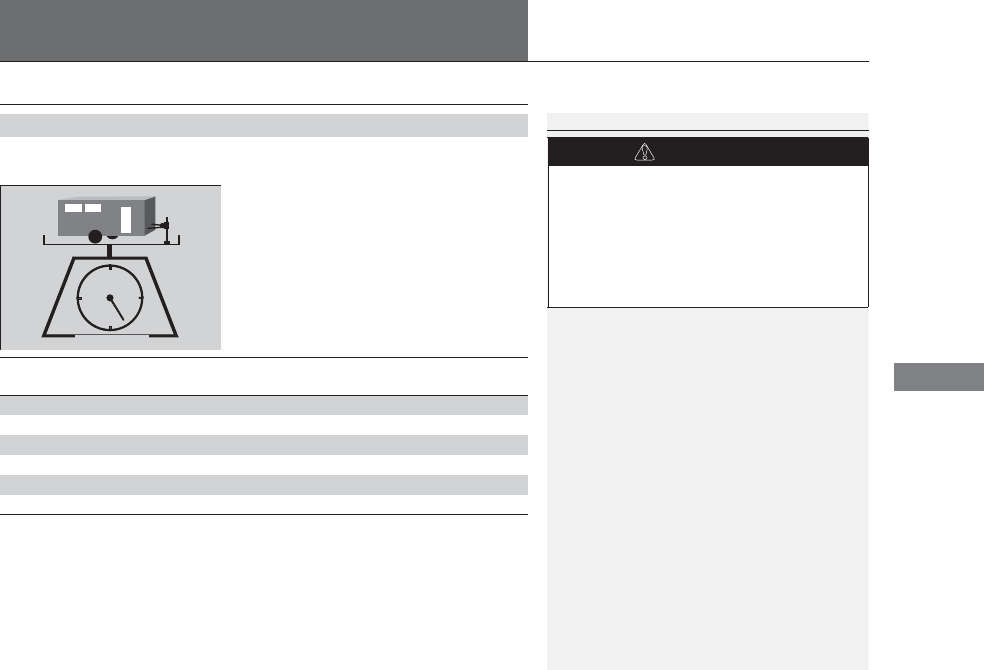
309
Continued
Driving
Towing a Trailer
Towing Preparation
Your vehicle can tow a trailer if you carefully observe the load limits, use the proper
equipment, and follow the towing guidelines. Check the load limits before driving.
■Total trailer weight
Do not exceed the maximum allowable
weight of the trailer, cargo, and everything in
or on it shown in the table.
Towing loads in excess of this can seriously
affect vehicle handling and performance and
can damage the engine and drivetrain.
Each weight limit is calculated based on the following conditions:
•Occupants fill seats from the front of the vehicle to the back
•Each occupant weights 150 lbs (68 kg)
•Each occupant has 15 lbs (7 kg) of cargo in the cargo area
Any additional weight, cargo or accessories reduce the maximum trailer weight and
maximum tongue load.
■Towing Load Limits 1Towing Load Limits
Check if all loads are within limits at a public scale.
If a public scale is not available, add the estimated
weight of your cargo load to the weight of your
trailer (as quoted by the manufacturer), and then
measure the tongue load with an appropriate scale or
tongue gauge or estimate it based on cargo
distribution.
Refer to the trailer owner’s manual for additional
information.
Break-in Period
Avoid towing a trailer during your vehicle’s first 600
miles (1,000 km).
Never exceed the gross weight ratings.
Gross weight information
2Vehicle Specifications P. 480
3
WARNING
Exceeding any load limit or improperly
loading your vehicle and trailer can cause a
crash in which you can be seriously hurt or
killed.
Check the loading of your vehicle and
trailer carefully before starting to drive.
Total Load
Number of
occupants
4WD models with
ATF cooler
4WD models
without ATF cooler 2WD models
25,000 lbs (2,268 kg) 3,500 lbs (1,588 kg) 3,500 lbs (1,588 kg)
34,750 lbs (2,155 kg) 3,250 lbs (1,474 kg) 3,250 lbs (1,474 kg)
44,500 lbs (2,041 kg) 3,000 lbs (1,361 kg) 3,000 lbs (1,361 kg)
54,250 lbs (1,928 kg) 2,750 lbs (1,247 kg) 2,750 lbs (1,247 kg)
64,000 lbs (1,814 kg) 2,500 lbs (1,134 kg) 2,500 lbs (1,134 kg)
7Towing not recommended
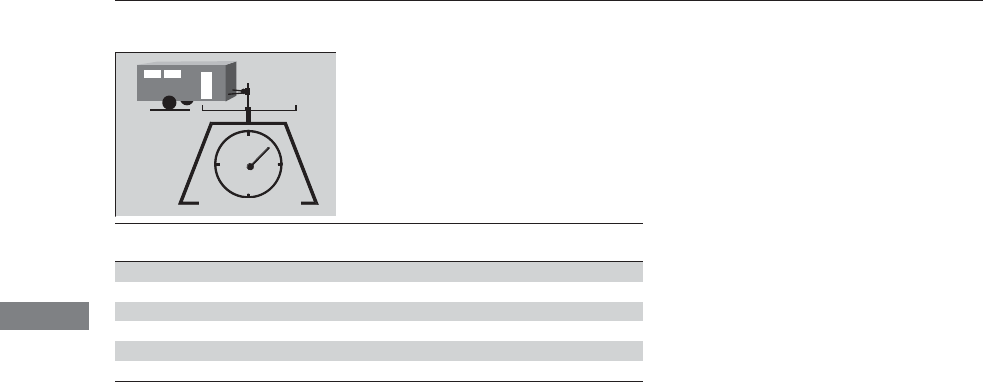
310
uuTowing a TraileruTowing Preparation
Driving
■Tongue load
The weight of the tongue with a fully loaded
trailer on the hitch should be approximately:
Boat trailers: 5 – 15% of the total trailer
weight
Other trailers: 10 – 15% of total trailer weight
Tongue Load
Tongue Load
Number of
occupants 4WD models 2WD models
2500 lbs (227 kg) 350 lbs (159 kg)
3475 lbs (215 kg) 325 lbs (147 kg)
4380 lbs (172 kg) 300 lbs (136 kg)
5290 lbs (132 kg) 275 lbs (125 kg)
6165 lbs (75 kg) 150 lbs (68 kg)
7Towing not recommended
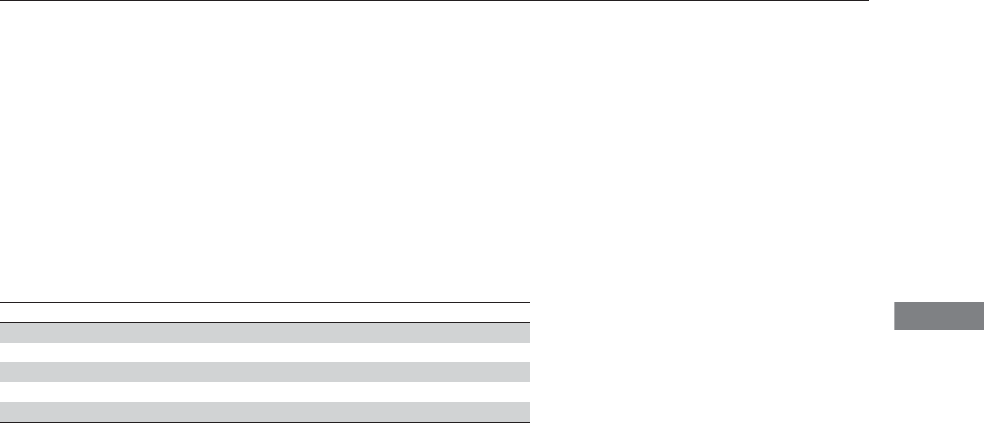
311
uuTowing a TraileruTowing Preparation
Continued
Driving
■To estimate the tongue load
Excessive tongue load reduces front tire traction and steering control. Too little
tongue load can make the trailer unstable and cause it to sway.
You can estimate the tongue load by measuring the trailer hitch height from the
ground in the following steps:
1. Park the vehicle on level ground.
2. Measure the distance between the ground and the bottom of the trailer hitch.
3. Connect the fully loaded trailer to the hitch.
4. Measure the distance between the ground and the bottom of the trailer hitch
again.
5. Subtract the second measurement from the first measurement, then refer to the
following table.
If the difference becomes more than indicated in the table, distribute the load or
remove cargo as needed.
If the difference is 4WD models 2WD models
1 inches (2.5 cm) 150 lbs (68 kg)
1 1/2 inches (3.8 cm) 250 lbs (114 kg)
2 inches (5.1 cm) 350 lbs (159 kg)
2 3/8 inches (6.0 cm) 450 lbs (205 kg) —
2 5/8 inches (6.7 cm) 500 lbs (227 kg) —
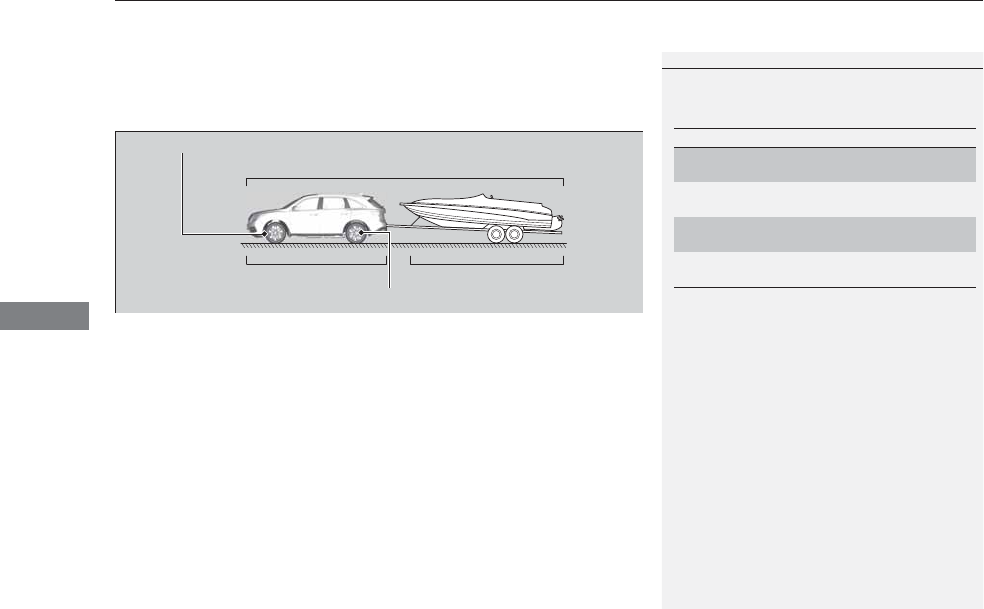
uuTowing a TraileruTowing Preparation
312
Driving
■How to weigh the trailer loads using the public scale
Check each weight in the order indicated as shown.
Refer to the table on the right for each weight’s limit except for the tongue load.
2Tongue load P. 310
•If you cannot weigh the rear axle, subtract 1 from 2.
•The maximum gross combined weight (4) decreases by 2% for every 1,000 feet
(305 meters) of elevation.
•To calculate the tongue load, subtract 5 from 6.
•Refer to the trailer owner’s manual for additional information.
1How to weigh the trailer loads using the public scale
Fully load the vehicle and trailer. An attendant who
watches the scale is needed as all occupants should
stay in the vehicle.
If a public scale is not available, add the estimated
weight of your cargo load to the weight of your
trailer (as quoted by the manufacturer), and then
measure the tongue load with an appropriate scale or
tongue gauge or estimate it based on cargo
distribution.
Weight limit for 2WD models 4WD models
Front gross axle 2,811 lbs
(1,275 kg)
2,910 lbs
(1,320 kg)
Gross vehicle 5,368 lbs
(2,435 kg)
5,677 lbs
(2,575 kg)
Rear gross axle 2,734 lbs
(1,240 kg)
2,965 lbs
(1,345 kg)
Gross combined 8,036 lbs
(3,645 kg)
9,833 lbs
(4,460 kg)
1. Front gross axle weight.
2. Gross vehicle weight.
4. Gross combined weight.
3. Rear gross axle weight.
5. Hitched trailer weight.
6. Unhitched trailer weight.
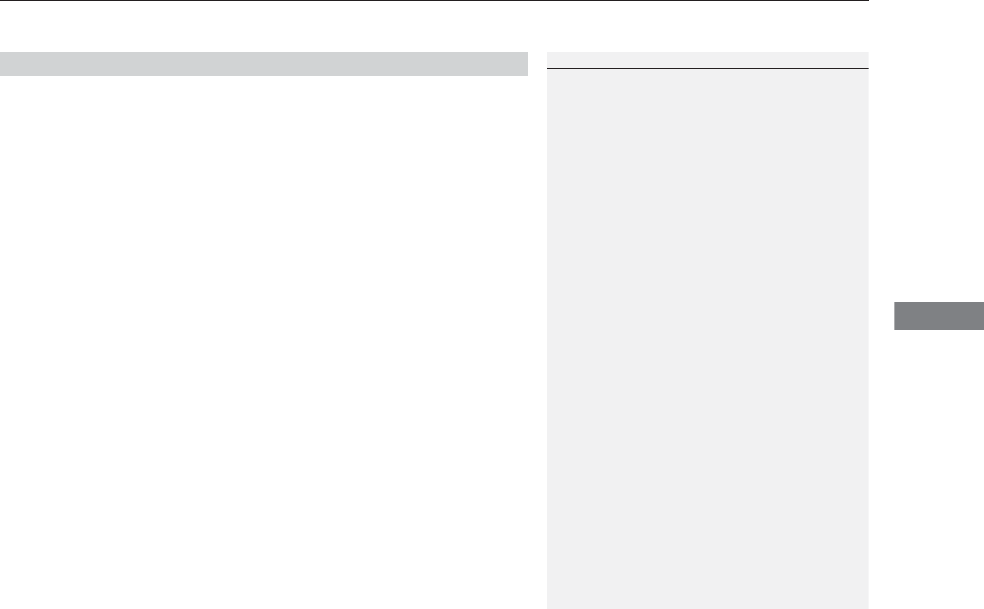
Continued 313
uuTowing a TraileruTowing Preparation
Driving
Towing generally requires a variety of supplemental equipment.
To ensure the best quality, we recommend that you purchase Acura equipment
whenever possible.
■Towing Equipment and Accessories
1Towing Equipment and Accessories
Make sure that all equipment is properly installed and
maintained, and that it meets federal, state, province/
territory, and local regulations.
Consult your trailer maker for proper installation and
setup of the equipment.
Improper installation and setup can affect the
handling, stability, and braking performance of your
vehicle.
Consult your trailer sales or rental agency if any other
items are recommended or required for your towing
situation.
The lighting and wiring of trailers can vary by type
and brand. If a connector is required, it should only
be installed by a qualified technician.
Trailer packages and products:
•Ball mount, hitch plug, hitch pin etc.
•Wiring harness kit
•Trailer hitch kit (jumper harness included)
2Trailer brakes P. 314
•Automatic transmission cooler kit
2Automatic transmission cooler P. 316
Are available at a dealer.
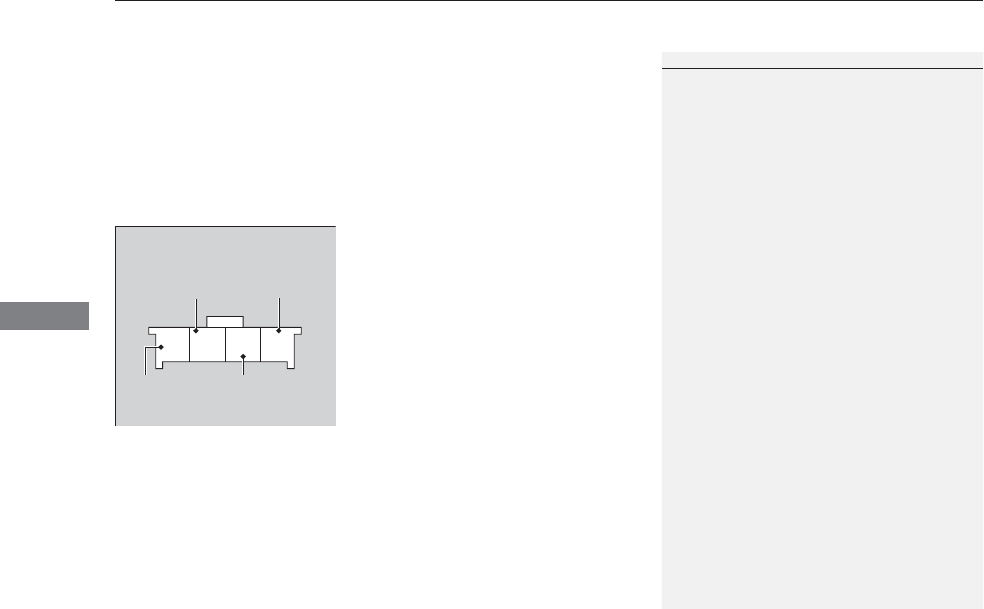
uuTowing a TraileruTowing Preparation
314
Driving
■Trailer brakes
Recommended for any trailer with a total weight of 1,000 lbs (450 kg) or more:
There are two common types of trailer brakes: surge and electric. Surge brakes are
common for boat trailers, since the brakes will get wet.
If you choose electric brakes, be sure they are electronically actuated. Do not
attempt to attach trailer brakes to your vehicle’s hydraulic system, as it will lower
braking effectiveness and create a potential hazard.
The 4-pin gray connector installed in your vehicle has all of the circuits required to
install most electric trailer brake controllers.
Have a qualified mechanic install your trailer
brake controller following the trailer brake
controller manufacturer’s instructions. Failure
to properly install the trailer brake controller
may increase the distance it takes for you to
stop your vehicle when towing a trailer.
1Trailer brakes
The 4-pin gray connector is located under the
instrument panel near the top of the parking brake
pedal.
Electric Brake
(Light Green) (20A)
Ground
(Brown)
Brake
(Green)
Stop
(Violet)
Trailer brake controller
connector’s terminals:
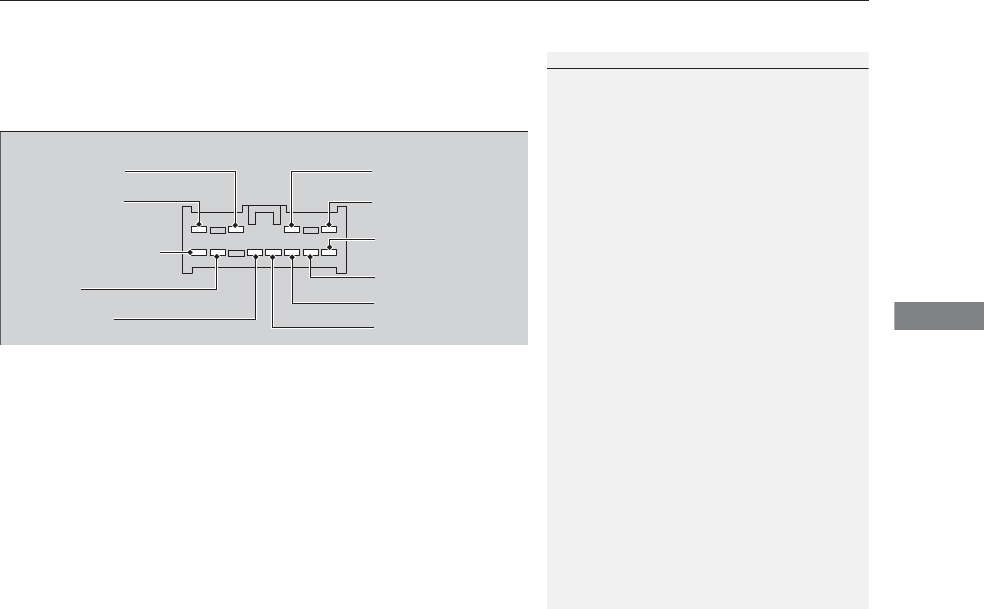
Continued 315
uuTowing a TraileruTowing Preparation
Driving
■Trailer light
Trailer lights and equipment must comply with federal, state, province/territory, and
local regulations. Check with your local trailer sales or rental agency for the
requirements in the area where you plan to tow.
We recommend that you have a dealer install a Acura wiring harness and converter.
They are designed for your vehicle.
1Trailer light
The trailer lighting connector is located behind the
left side panel in the cargo area.
Even if you are planning to use the non-Acura trailer
lighting harness and converter, ask a dealer for the
correct connector and pins.
+B Trailer Charge
+B Trailer Hazard Light
+B Trailer Hazard Light
+B Trailer Back Light
Back Light
+B ELEC Brake
Right Turn Signal
Stop Light
Pins’ wiring color codes and their purposes:
+B Trailer Small
IG2 HAC
Left Turn Signal

316
uuTowing a TraileruTowing Preparation
Driving
■Hitches
Read the trailer manufacturer’s instructions, and select the appropriate draw bar for
the height of the trailer you will be towing.
■Weight distribution hitches
Your vehicle is designed to tow without the need for a load distributing hitch. If you
wish to use one, please consult your trailer maker for proper installation and set-up.
Improper set-up could degrade the handling, stability, and braking performance of
your vehicle.
■Safety chains
Always use safety chains when you tow a trailer. Leave enough slack to allow the
trailer to turn corners easily, but do not allow the chains to drag on the ground.
■Sway control
This device can be used if your trailer tends to sway. Your trailer maker can tell you
what kind of sway control you need and how to install it. Improper installation could
degrade the handling and stability of your vehicle.
■Automatic transmission cooler
Install an additional ATF (automatic transmission fluid) cooler to help prevent the
transmission from overheating, and damaging. You can get the additional ATF
cooler at a dealer.
An additional ATF cooler is required to keep the transmission from overheating when
towing more than 3,500 lbs (1,588 kg). You can get the additional ATF cooler at a dealer.
■Trailer mirrors
Many states, provinces and territories require special exterior mirrors when towing a
trailer. Install special mirrors whenever you cannot clearly see behind you, or if the
trailer creates a blind spot.
4WD models
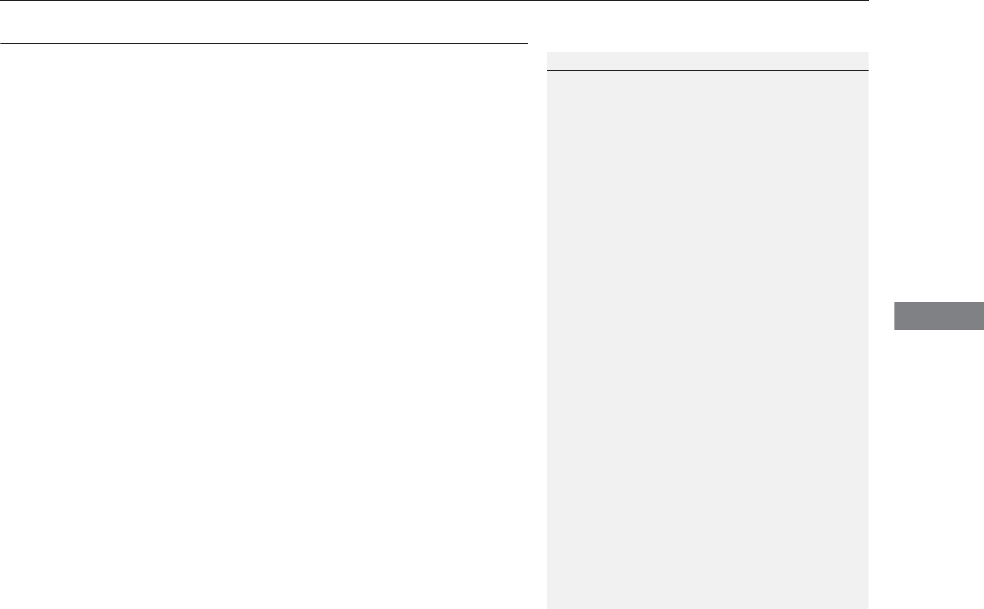
317
uuTowing a TraileruTrailer Stability Assist*
Driving
Trailer Stability Assist*
Helps to stabilize the vehicle and trailer when the trailer severely sways.
■How trailer stability assist works
When the vehicle and trailer become unstable while driving, trailer stability assist
determines the cause. If the trailer oscillation is detected as the cause, and the
swaying increases, the system applies the brakes or controls engine output to reduce
vehicle speed.
Both the vehicle and trailer brake lights come on automatically if you brake to
reduce vehicle speed.
1Trailer Stability Assist*
Trailer stability assist is not a function that prevents
the vehicle and trailer from swaying. Avoid high
speeds, abrupt steering, improper trailer load, and
sudden braking to keep the trailer from swaying.
When swayed too severely, the system becomes
ineffective, and you may loose control of your
vehicle, causing the trailer to roll over or get
damaged.
2Driving Safely with a Trailer P. 318
Trailer towing sway is caused by:
•Crosswinds
•Improper towbar down load
•Excessive Speed
The VSA® system indicator blinks during the trailer
stability assist operation.
2VSA® Operation P. 358
* Not available on all models
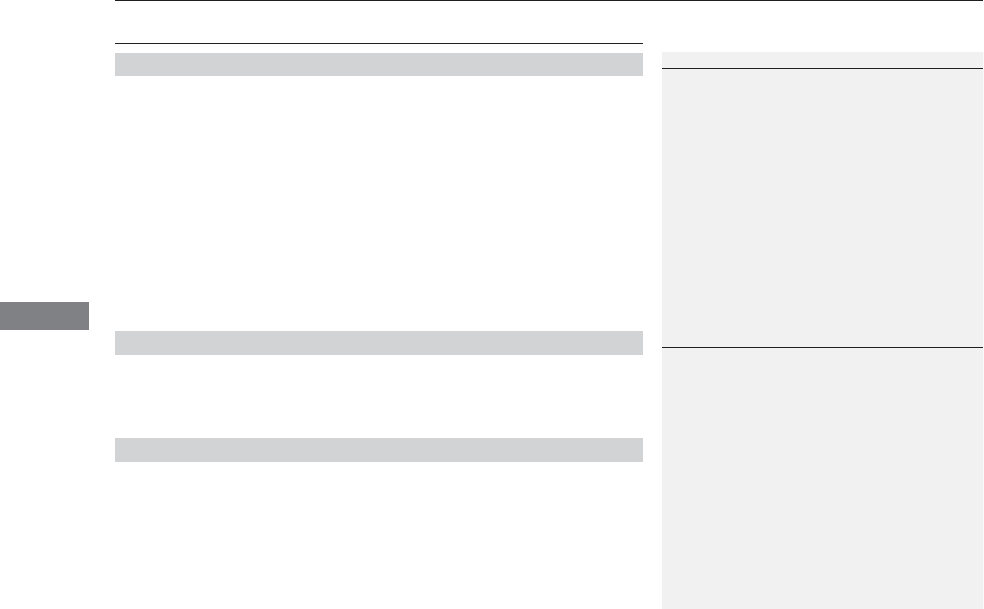
318
uuTowing a TraileruDriving Safely with a Trailer
Driving
Driving Safely with a Trailer
•Have the trailer properly serviced and keep it in good condition.
•Make sure that all the weights and load in the vehicle and trailer are within limits.
2Towing Load Limits P. 309
•When towing more than 3,500 lbs (1,590 kg), use of gasoline with a pump
octane number of 91 or higher is recommended.
uTowing performance can be affected by high altitude, high temperature, or
steep uphill.
•Securely attach the hitch, safety chains, and other necessary parts to the trailer.
•Securely store all the items in and on the trailer so that they do not shift while
driving.
•Check if the lights and brakes on the trailer are working properly.
•Check the pressures of the trailer tires, including the spare.
•Drive slower than normal.
•Obey posted speed limits for vehicles with trailers.
•Use the (D position when towing a trailer on level roads.
•Turn more slowly and with a wider turning arc than normal.
•Allow more time and distance for braking.
•Do not brake or turn suddenly.
■Things You Need To Know Before Towing a Trailer
■Towing Speeds and Gears
■Turning and Braking
1Driving Safely with a Trailer
Parking
In addition to the normal precautions, place wheel
chocks at each of the trailer’s tires.
1Towing Speeds and Gears
When towing a fixed-sided trailer (e.g., camper), do
not exceed 55 mph (88 km/h).
At higher speeds, the trailer may sway or affect
vehicle handling.
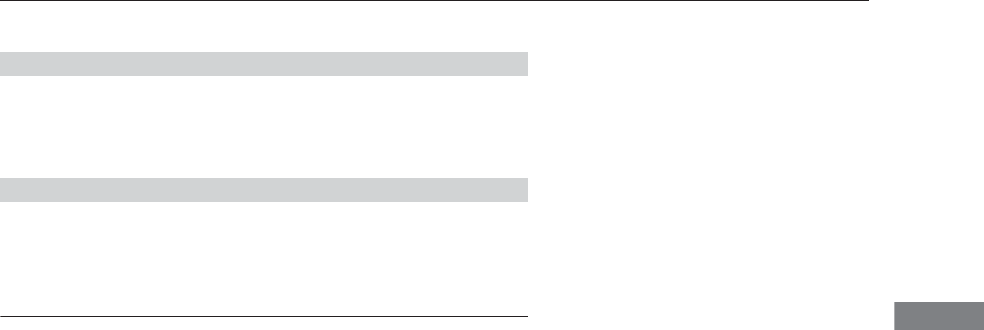
319
uuTowing a TraileruTowing Your Vehicle
Driving
•Monitor your temperature gauge. If it nears the red (Hot) mark, turn off the
climate control system and reduce speed. Pull to the side of the road safely to cool
down the engine if necessary.
•Shift to the (S position if the transmission shifts frequently.
If the vehicle tires slip when retrieving a boat from the water, keep the transmission
in (D and do not use the sequential shift mode in (S. This prevents damage to the
transmission.
Towing Your Vehicle
Your vehicle is not designed to be towed behind a motor home. If your vehicle needs
to be towed in an emergency, refer to the emergency towing information.
2Emergency Towing P. 475
■Driving in Hilly Terrain
■Retrieving a Boat
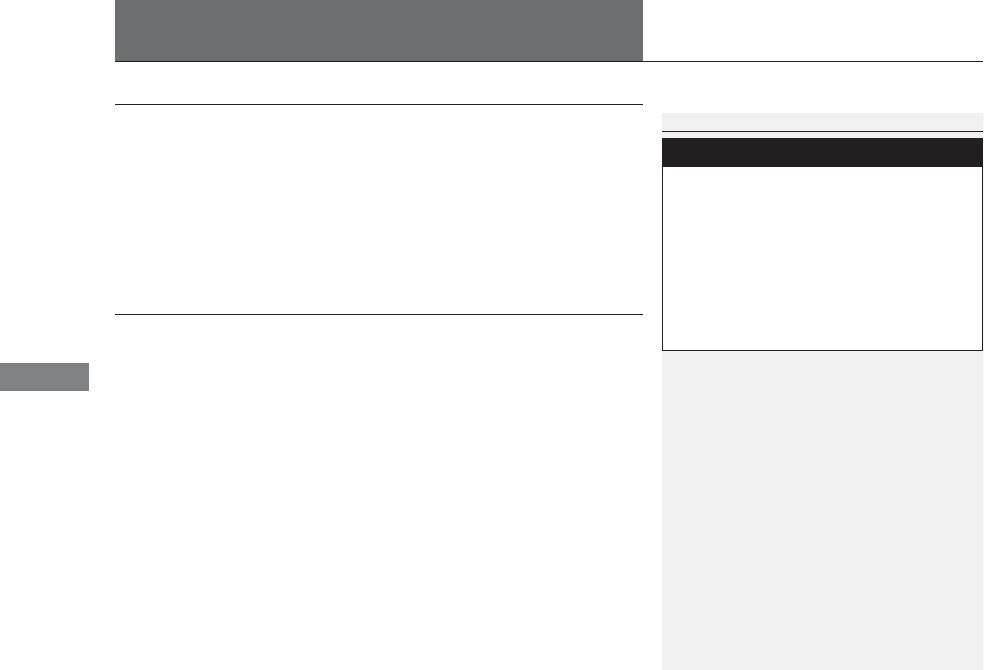
320
Driving
Off-Highway Driving Guidelines
General Information
Your vehicle has been designed primarily for use on pavement, however, its higher
ground clearance allows you to occasionally travel on unpaved roads. It is not
designed for trail-blazing, or other challenging off-road activities.
If you decide to drive on unpaved roads, you will find that it requires somewhat
different driving skills and that your vehicle will handle somewhat differently than it
does on pavement. Pay attention to the precautions and tips in this section, and get
acquainted with your vehicle before leaving the pavement.
Important Safety Precautions
To avoid loss of control or rollover, be sure to follow all precautions and
recommendations:
•Be sure to store cargo properly and do not exceed your cargo load limits.
2Maximum Load Limit P. 307
•Whenever you drive, make sure you and your passengers always wear seat belts.
•Keep your speed low, and never go faster than the conditions allow.
•It’s up to you to continually assess the situation and drive within the limits.
1Off-Highway Driving Guidelines
Failure to operate your vehicle correctly might result
in a crash or a rollover.
2Important Handling Information P. 28
2Precautions While Driving P. 327
Spinning the tires can also damage the SH-AWD
system.
3
WARNING
Improperly operating this vehicle on or off
pavement can cause a crash or rollover in
which you and your passengers can be
seriously injured or killed.
•Follow all instructions and guidelines in
this owner’s manual.
•Keep your speed low, and don’t drive
faster than conditions permit.

321
uuOff-Highway Driving GuidelinesuAvoiding Trouble
Driving
Avoiding Trouble
•Check Out Your Vehicle before you leave the pavement and make sure that all
scheduled maintenance has been completed. Pay special attention to the
condition of the tires, and check the tire pressures.
•Remember the route you choose presents limits (too steep or bumpy), you have
limits (driving skill and comfort), and your vehicle has limits (traction, stability, and
power). Failing to recognize these limits will likely put you and your passengers in
a hazardous situation.
•Accelerating and Braking should be done slowly and gradually. Trying to start
or stop too fast can cause a loss of traction and you could lose control.
•Avoiding Obstacles and Debris in the road reduces the likelihood of a rollover
or damage to your suspension or other components.
•Driving on Slopes increases your risk of a rollover, particularly if you attempt to
drive across a slope that is too steep. Going straight up or down a slope is usually
the safest. If you can’t clearly see all conditions or obstacles on a slope, walk it
before you drive it. If there is any doubt whether you can safely pass, don’t try it.
Find another route. If you get stuck when climbing, do not try to turn around.
Back down slowly following the same route you took up the hill.
•Crossing a Stream - Avoid driving through deep water. If you encounter water
in your route (a small stream or large puddle, for example), evaluate it carefully
before going ahead. Make sure it is shallow, flowing slowly, and has firm ground
underneath. If you are not sure of the depth or the ground, turn around and find
another route. Driving through deep water can also damage your vehicle. The
water can get into the transmission and differential, diluting the lubricant and
causing an eventual failure. It can also wash the grease out of the wheel bearings.
•If You Get Stuck, carefully go in the direction that you think will get you
unstuck. Do not spin the tires as this will only make things worse and could
damage the transmission. If you are unable to free yourself, your vehicle will need
to be towed. Front and rear tow hooks are provided for this purpose.
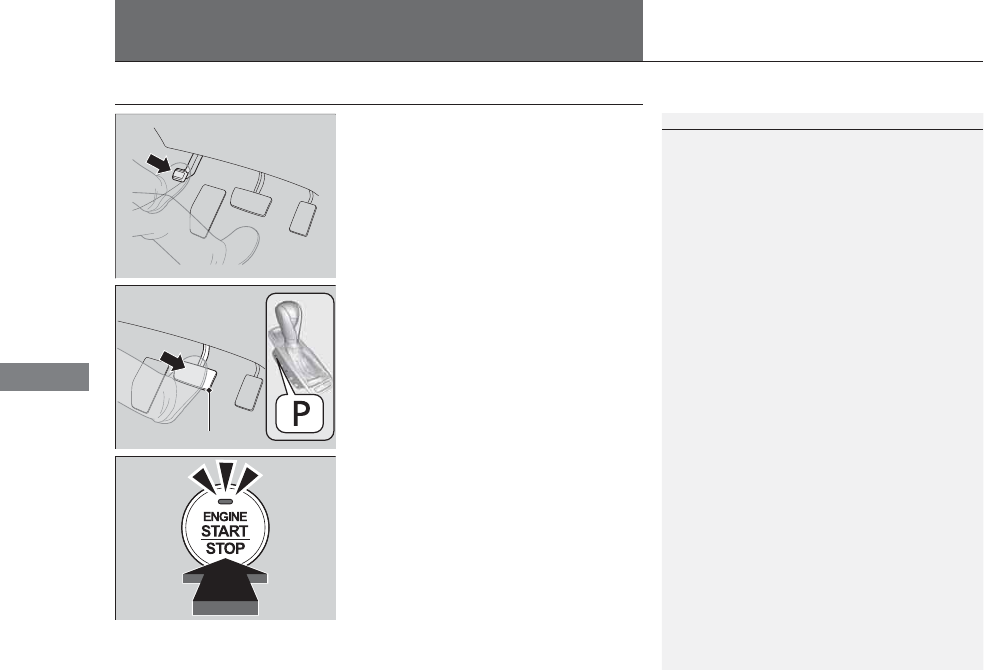
322
Driving
When Driving
Starting the Engine
1. Make sure the parking brake is applied.
2. Check that the shift lever is in (P, then
depress the brake pedal.
uAlthough it is possible to start the vehicle
in (N, it is safer to start it in (P.
3. Press the ENGINE START/STOP button
without depressing the accelerator pedal.
The engine will crank until it starts.
1Starting the Engine
Keep your foot firmly on the brake pedal when
starting the engine.
The engine is harder to start in cold weather and in
thinner air found at altitudes above 8,000 feet (2,400
meters).
When starting the engine in cold weather, turn off all
electrical accessories such as the lights, climate control
system, and rear defogger in order to reduce battery drain.
If you live in a region where winter is extremely cold,
an engine block heater will improve starting and
warming of the engine. If temperatures consistently
below -22°F (-30°C) are expected, the coolant
mixture should be changed to a higher concentration
to prevent freezing. Consult a dealer for details.
If the exhaust system sounds abnormal or you can
smell exhaust gas inside the vehicle, have your vehicle
checked by a dealer. There may be a problem with
the engine or exhaust system.
Bring the keyless access remote close to the ENGINE
START/STOP button if the battery in the keyless
access remote is weak.
2If the Keyless Access Remote Battery is
Weak P. 458
The engine may not start if the keyless access remote
is subjected to strong radio waves.
Do not hold the ENGINE START/STOP button to
start the engine.
If the engine does not start, wait at least 10 seconds
before trying again.
Brake Pedal
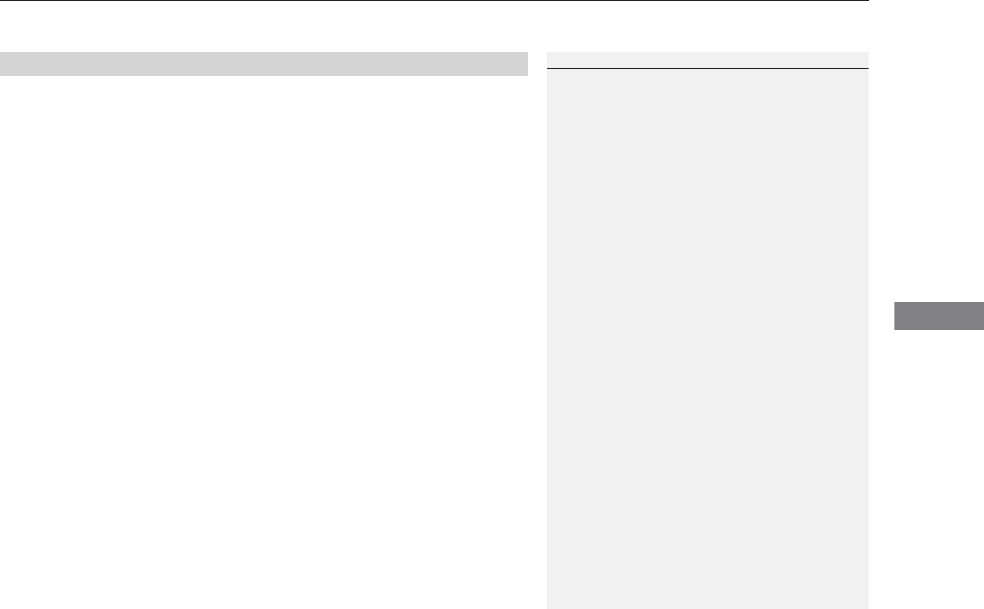
Continued 323
uuWhen DrivinguStarting the Engine
Driving
You can turn the engine off when the vehicle is completely stopped.
1. Shift to (P.
2. Press the ENGINE START/STOP button with your foot on the brake pedal.
■Stopping the Engine
1Starting the Engine
The immobilizer system protects your vehicle from
theft.
If an improperly coded device is used, the engine’s
fuel system is disabled.
2Immobilizer System P. 135
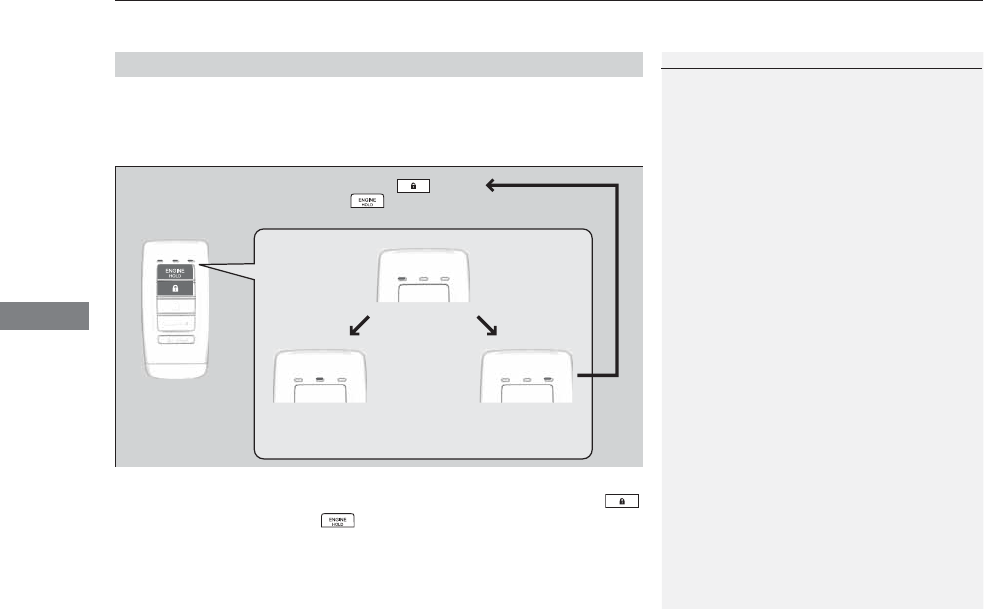
uuWhen DrivinguStarting the Engine
324
Driving
You can remotely start the engine using the two-way keyless access remote from
distances up to 328 feet (100 meters) from the vehicle.
■To start the engine
The engine runs for up to 10 minutes without you starting the vehicle.
To extend the run time for another 10 minutes during the first run, press the
button, then press and hold the button.
uThe amber LED blinks, then the green LED comes back on if a 10-minute
extension request was transmitted successfully.
After pressing the (lock) button, wait for the green LED to blink. This indicates that
the all the doors and the tailgate are locked.
■Remote Engine Start with Vehicle Feedback*
1Remote Engine Start with Vehicle Feedback*
WARNING: Carbon monoxide gas is toxic and can
rapidly accumulate in closed or even partly enclosed
areas.
Breathing it can cause unconsciousness and even kill
you.
Never use the remote engine starter with the vehicle
parked in a garage or other areas with limited
ventilation.
Operate the remote in an open space from distances
up to 328 feet (100 meters) from the vehicle. If there
are buildings and obstacles between your vehicle and
the remote, the range will be reduced.
This distance may vary by external electrical
interference.
The engine may not start by the remote engine start
if:
•You have disabled a remote engine start setting
using the multi-information display (MID).
•The power mode is not in VEHICLE OFF (LOCK).
•The shift lever is in a position other than (P.
•The hood is open, or any door or the tailgate is
unlocked.
•You have already used the remote twice to start
the engine.
•Another registered keyless access remote is in the
vehicle.
•There is any antenna failure.
•Door is unlocked with the built-in key.
With the doors locked, Press the button,
then press and hold the button.
Amber LED: Blinks when any button is pressed.
Continues to blink
during a vehicle
self check until the
engine starts.
Go within the range,
and try again.
Green LED: Comes on while
the engine is running.
Red LED: Blinks when the
remote is out of the keyless
access system range.
* Not available on all models
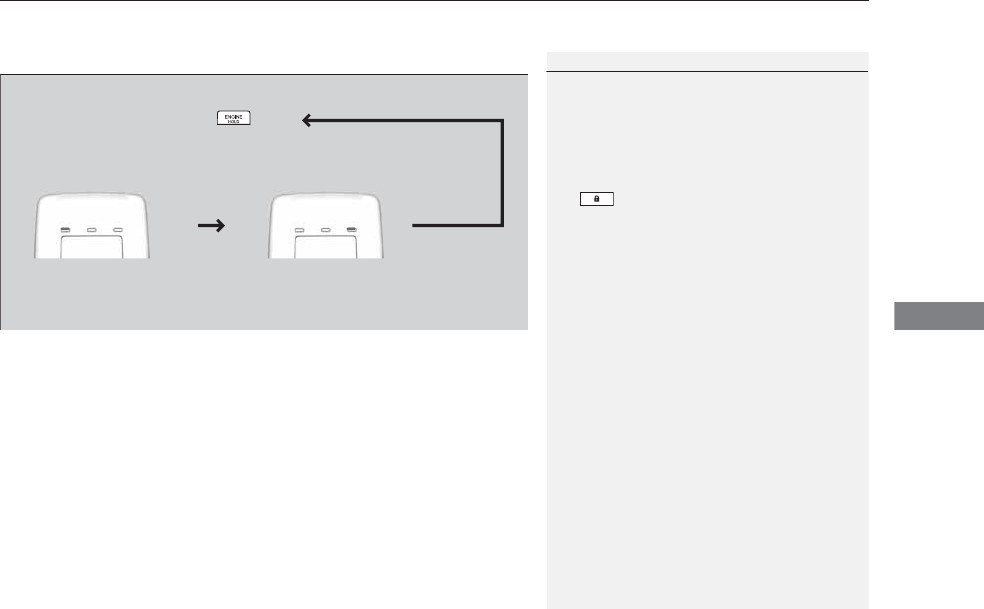
Continued 325
uuWhen DrivinguStarting the Engine
Driving
■To stop the engine
Press and hold the button
for one second.
Go within the range,
and try again.
Amber LED: Blinks when any
button is pressed.
Red LED:
●Comes on for one second to let you
know that the engine has stopped.
●Blinks when the remote is out of
the keyless access system range.
The engine will not stop.
1Remote Engine Start with Vehicle Feedback*
•The engine oil pressure is low.
•The engine coolant temperature is extremely high.
•The telematics unit malfunctions.
•The security system alarm is not set.
Before starting the engine, make sure to check the
door lock status using the remote. When you press
the button, wait for the green LED to blink. If
the red LED turns on, the doors and tailgate did not
lock, and the engine does not start.
While the engine is running, the vehicle will
automatically precondition inside the vehicle.
When it is warm outside:
•The air conditioning is activated in recirculation
mode.
•The seat ventilation is activated*.
When it is cold outside:
•The defroster is activated at a moderately warm
temperature.
•The rear defogger and door mirror heaters are
activated.
•The seat and heated steering wheel are activated*.
2Heated Steering Wheel* P. 181
2Front Seat Heaters and Seat
Ventilation* P. 182, 183
* Not available on all models
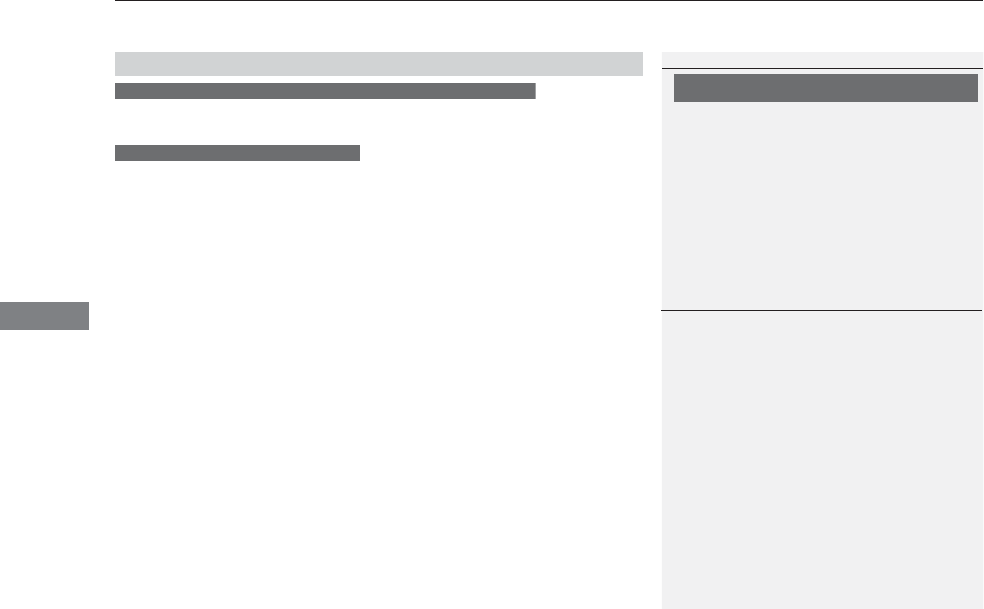
uuWhen DrivinguStarting the Engine
326
Driving
1. Depress the brake pedal and press the ENGINE START/STOP button
simultaneously.
2. Keeping your right foot on the brake pedal, release the parking brake. Check that
the parking brake indicator has gone off.
2Parking Brake P. 367
3. Put the shift lever in (D. Select (R when reversing.
4. Gradually release the brake pedal and gently depress the accelerator pedal to pull
away.
■Hill start assist system
Hill start assist keeps the brake engaged briefly to help prevent the vehicle from
rolling on inclines as you move your foot from the brake pedal to the accelerator.
Move the shift lever to (D or (S when facing uphill, or (R when facing downhill,
then release the brake pedal.
The brakes remain engaged briefly as you release the brake pedal.
■Starting to Drive
1Starting to Drive
The engine stops when the shift lever is moved out of
(P before the ENGINE START/STOP button is
pressed. Follow the step 1 when starting to drive.
When the engine was started using the two-way keyless
access remote*
When the engine was started using the two-way keyless access remote*
When the engine was started in any case
1Hill start assist system
Hill start assist may not prevent the vehicle from
rolling downhill on a very steep or slippery slope, and
will not operate on small inclines.
Hill start assist is not a replacement for the parking
brake.
* Not available on all models
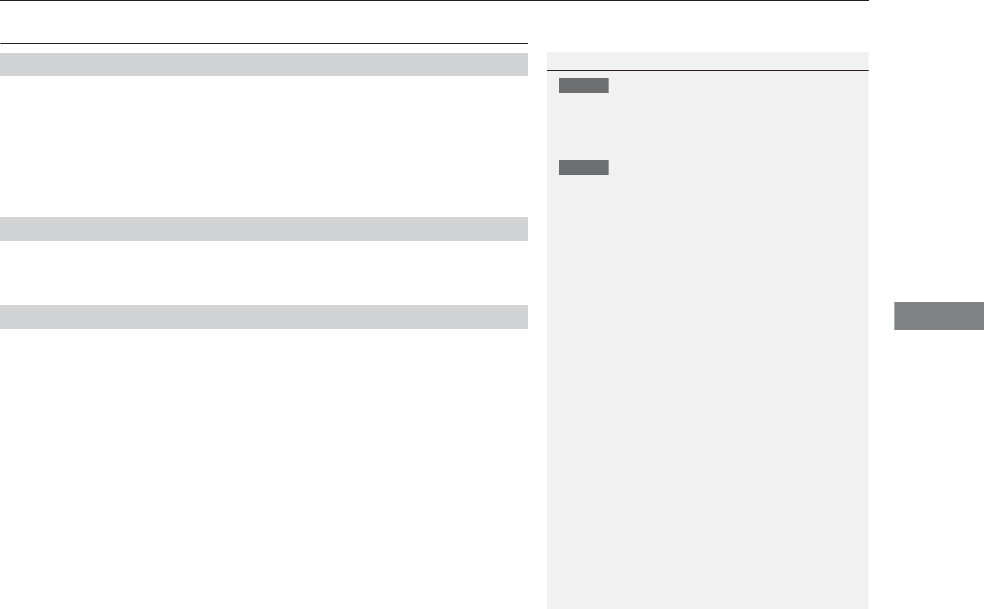
327
uuWhen DrivinguPrecautions While Driving
Driving
Precautions While Driving
Utility vehicles have a significantly higher rollover rate than other types of vehicles.
To prevent rollovers or loss of control:
•Take corners at slower speeds than you would with a passenger vehicle.
•Avoid sharp turns and abrupt maneuvers whenever possible.
•Do not modify your vehicle in any way that you would raise the center of gravity.
•Do not carry heavy cargo on the roof.
Avoid driving in deep water and on flooded roads. This can damage the engine,
driveline, or cause electrical component failure.
If there is a strong impact with something under the vehicle, stop in a safe location.
Check the underside of the vehicle for damage or any fluid leaks.
■Driving Guidelines for Your Utility Vehicle
■In Rain
■Other Precautions
1Precautions While Driving
NOTICE
Do not operate the shift lever while pressing the
accelerator pedal. You could damage the
transmission.
NOTICE
If you repeatedly turn the steering wheel at an
extremely low speed, or hold the steering wheel on
the full left or right position for a while, the system
heats up. The system goes into a protective mode,
and limits its performance. The steering wheel
becomes harder and harder to operate. Once the
system cools down, the EPS system is restored.
Repeated operation under these conditions can
eventually damage the system.
If the power mode is set to ACCESSORY or VEHICLE
OFF (LOCK) while driving, the engine will shut down
and all steering and brake power assist functions will
stop, making it difficult to control the vehicle.
Do not put the shift lever in (N, as you will lose
engine braking (and acceleration) performance.
During the first 600 miles (1,000 km) of operation,
avoid sudden acceleration or full throttle operation so
as not to damage the engine or powertrain.
Avoid hard braking for the first 200 miles (300 km).
You should also follow this when the brake pads are
replaced.
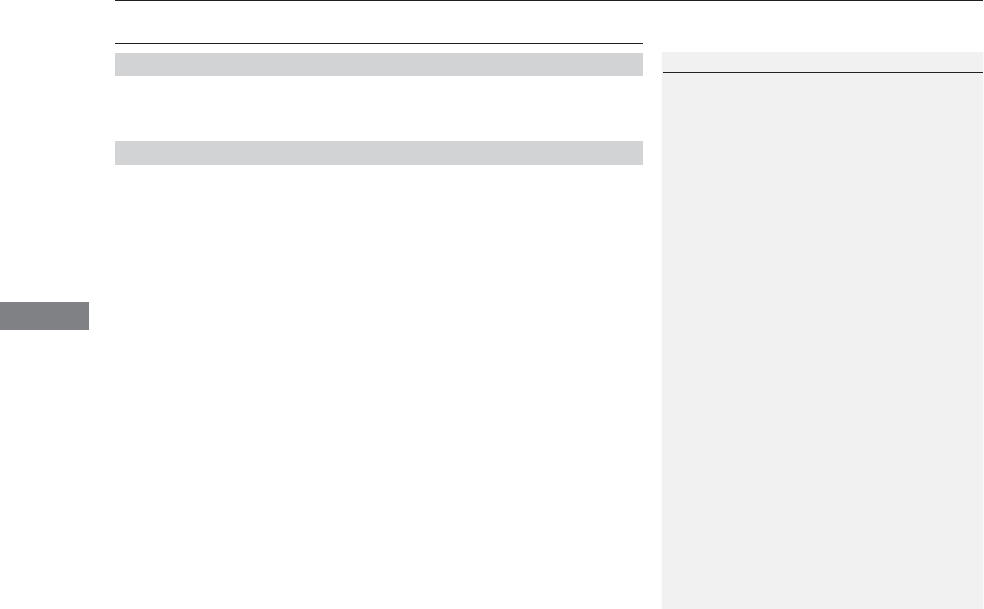
328
uuWhen DrivinguAutomatic Transmission
Driving
Automatic Transmission
The engine runs at a higher idle speed and creeping increases.
Keep the brake pedal firmly depressed when stopped.
Quickly depressing the accelerator pedal while driving uphill may cause the
transmission to drop to a lower gear, unexpectedly increasing vehicle speed. Depress
the accelerator pedal carefully, especially on slippery roads and curves.
■Creeping
■Kickdown
1Driving Guidelines for Your Utility Vehicle
Failure to operate your vehicle correctly might result
in a crash or a rollover.
2Important Handling Information P. 28
2Precautions While Driving P. 327
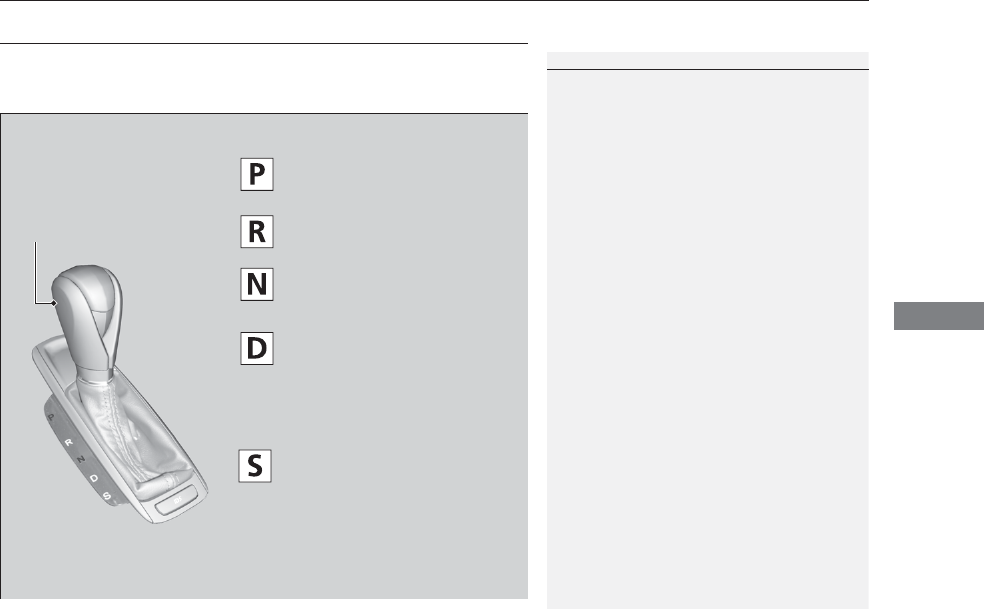
329
uuWhen DrivinguShifting
Continued
Driving
Shifting
Change the shift position in accordance with your driving needs.
■Shift lever positions
1Shifting
You cannot change the power mode from ON to
VEHICLE OFF (LOCK) unless the shift lever is in (P.
The vehicle may move forward very slightly even in
(N while the engine is cold.
Depress the brake pedal firmly and, when necessary,
apply the parking brake.
When shifting gears in extremely low temperatures
(-22°F/-30°C), there may be a short delay before the
shift indicated in the display. Always confirm you are
in the correct gear before driving.
Park
Used when parking or starting the
engine
Reverse
Used when reversing
Neutral
Used when idling
Drive
Used:
●For normal driving (gears change
between 1st and 6th automatically)
●When temporarily driving in the
sequential mode
Drive (S)
Used for:
●Automatically changing gears
between 1st and 5th (5th gear is
used only at high speed)
●Driving in the sequential mode
Release Button
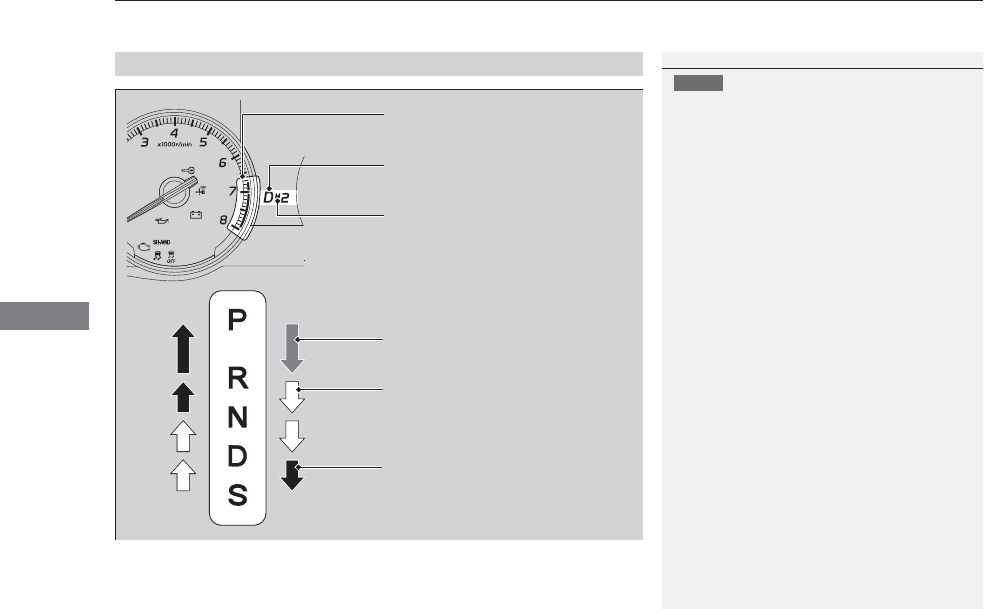
uuWhen DrivinguShifting
330
Driving
■Shift Lever Operation
1Shift Lever Operation
NOTICE
When you change the shift lever from (D to (R and
vice versa, come to a complete stop and keep the
brake pedal depressed.
Operating the shift lever before the vehicle has come
to a complete standstill can damage the transmission.
Use the shift lever position indicator to check the
lever position before pulling away.
Whichever position the shift lever is in when driving,
a blinking transmission indicator indicates a
transmission problem.
Avoid sudden acceleration and have the transmission
checked by a dealer as soon as possible.
The fuel supply may be cut off if you drive at engine
speeds in or over the tachometer’s red zone (engine
speed limit). If this happens, you may experience a
slight jolt.
It may not be possible to operate the shift lever if the
brake pedal is applied while the shift lever release
button is held down.
Depress the brake pedal first.
Tachometer’s red zone
Shift Lever Position Indicator
Depress the brake pedal and press
the shift lever release button to shift.
Shift without pressing the shift lever
release button.
Press the shift lever release button
and shift.
M (Sequential Shift mode) Indicator/
Gear Position Indicator

331
uuWhen DrivinguShifting
Continued
Driving
Use the paddle shifters to change between 1st and 6th gears without removing your
hands from the steering wheel. The transmission will switch to the sequential shift
mode.
■When the shift lever is in (D:
The vehicle will go into the sequential shift mode momentarily, and the gear position
indicator will come on.
Once you start traveling at a constant speed, the sequential shift mode will
automatically switch off, and the gear position indicator will go off.
Hold the (+ paddle shifter for two seconds to return to normal drive.
■When the shift lever is in (S:
The vehicle will go into the sequential shift mode, and the M (sequential shift mode)
indicator and gear position indicator will come on. At speeds of 6 mph (10 km/h) or
less, the vehicle automatically shifts down into 1st gear. If you do not operate the
paddle shifters while in 1st gear, the transmission automatically shifts up to 2nd
gear.
You can only pull away in 1st or 2nd gear.
When switching out of the sequential shift mode, move the shift lever from (S to
(D. When the sequential shift mode is canceled, the M indicator and gear position
indicator go off.
■Sequential Shift Mode
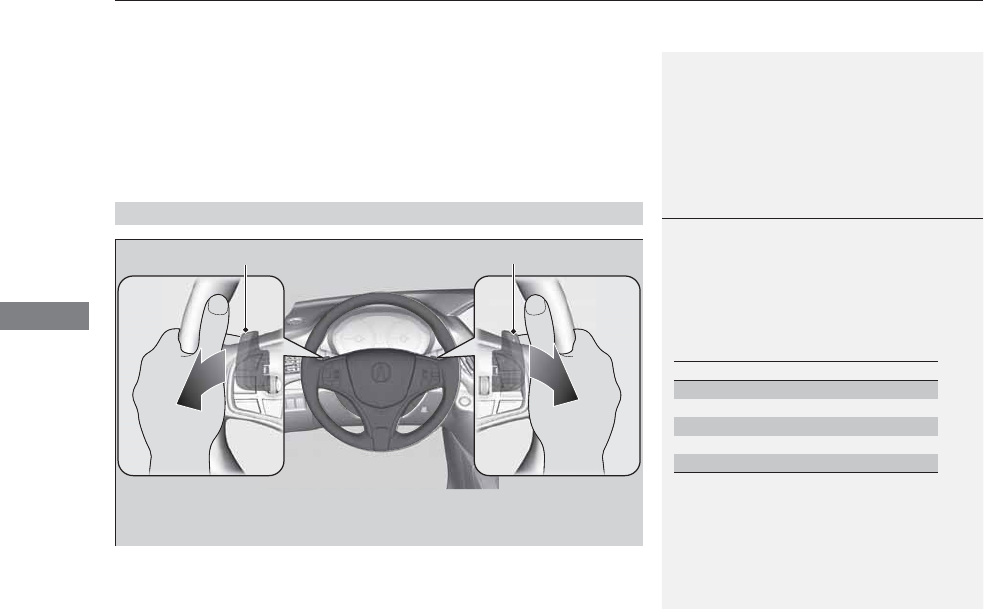
uuWhen DrivinguShifting
332
Driving
■Second gear lock mode
If you pull the (+ paddle shifter while stopped or driving at 6 mph (10 km/h) or less,
the gear position will be locked in 2nd gear. This makes it easier to pull away on
slippery surfaces such as snow covered roads.
To cancel the 2nd gear lock mode, pull the (- paddle shifter, or move the shift lever
from (S to (D.
■Sequential Shift Mode Operation
1Sequential Shift Mode Operation
Each paddle shift operation makes a single gear
change.
To change gears continuously, release the paddle
shifter before pulling it again for the next gear.
Recommended Shift Points
Use this table as a guideline for efficient fuel
economy and effective emission control.
The gear position indicator blinks when you cannot
shift up or down. It indicates that your vehicle speed
is not in its allowable gear shifting range.
Slightly accelerate to shift up and decelerate to shift
down while the indicator is blinking.
Shift Up Normal Acceleration
1st to 2nd 15 mph (24 km/h)
2nd to 3rd 25 mph (40 km/h)
3rd to 4th 40 mph (64 km/h)
4th to 5th 45 mph (72 km/h)
5th to 6th 50 mph (80 km/h)
Paddle Shifter (Shift down)
Downshifting when pulling
the (- paddle shifter.
(Changes to a lower gear.)
Upshifting when pulling
the (+ paddle shifter.
(Changes to a higher gear.)
(-(+Paddle Shifter (Shift up)
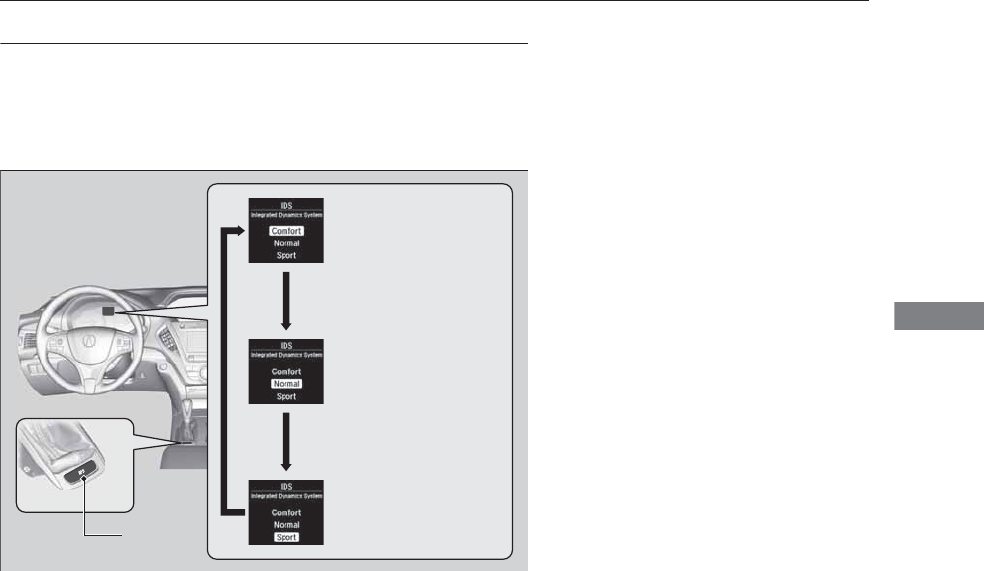
333
uuWhen Driving uIntegrated Dynamics System (IDS)
Driving
Integrated Dynamics System (IDS)
Modifies the dynamic character of the vehicle. There are three IDS modes to select
from: Comfort, Normal, and Sport.
Press the IDS button to select a mode. The mode you have selected appears on the
MID.
You can customize the IDS mode default setting using the MID.
2Customized Features P. 104
Normal
Balanced driving
performance for most
driving situations.
Sport
Enhances vehicle response
feel through decreased
steering assist, heightened
throttle response, increased
SH-AWD* torque bias, and
modified active sound
control.
Comfort
Maximizes driver comfort
through increased steering
assist.
IDS Button
* Not available on all models
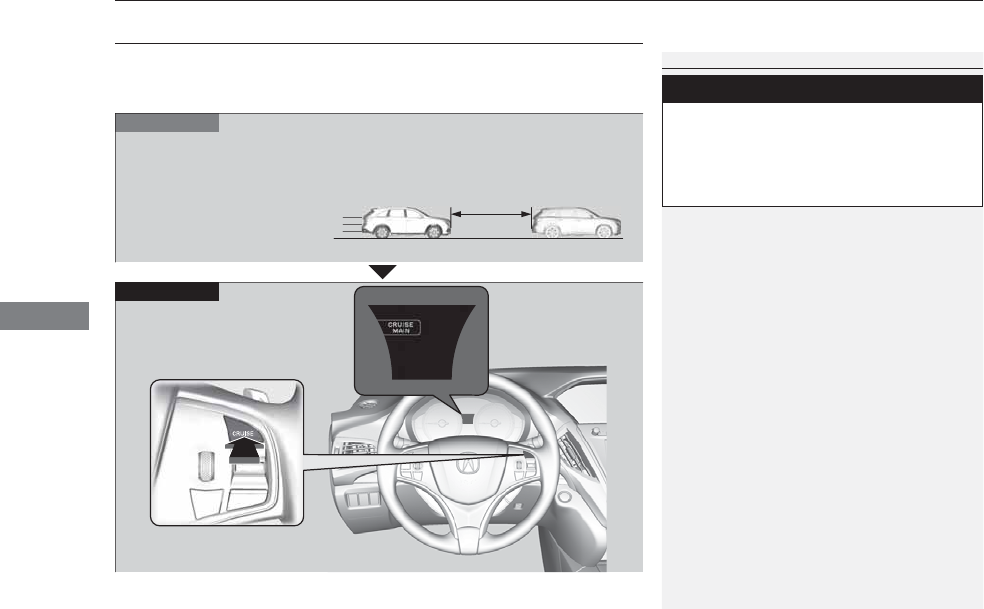
334
uuWhen DrivinguCruise Control
Driving
Cruise Control
Maintains a constant vehicle speed without having to keep your foot on the
accelerator. Use cruise control on freeways or open roads where you can travel at a
constant speed with little acceleration or deceleration.
1Cruise Control
It may not be possible to maintain a constant speed
when driving uphill or downhill.
When not using cruise control:
Turn off cruise control by pressing the CRUISE
button.
3
WARNING
Improper use of the cruise control can lead
to a crash.
Use the cruise control only when traveling
on open highways in good weather.
■Shift positions for cruise control:
In (D or (S
When to use
Always keep sufficient distance
between you and the vehicle in
front of you.
■Vehicle speed for cruise control:
Desired speed in a range above
roughly 25 mph (40 km/h) ~
How to use
CRUISE MAIN is on in
the instrument panel.
Cruise control is ready to
use.
■Press the CRUISE button on
the steering wheel.
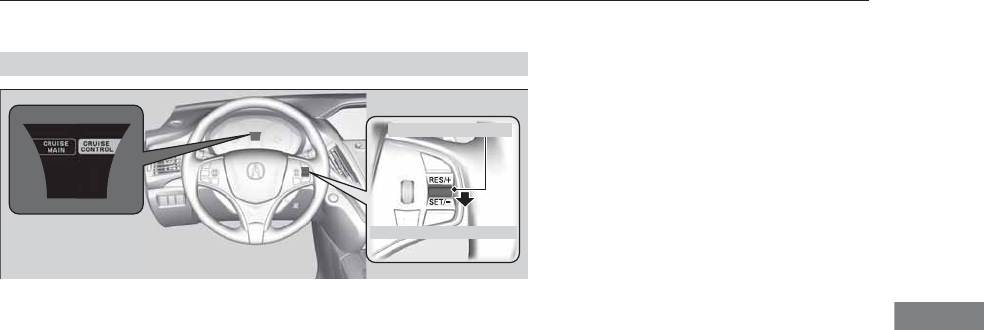
335
uuWhen DrivinguCruise Control
Continued
Driving
Take your foot off the pedal and press the RES/+/SET/– switch down when you
reach the desired speed.
The moment you release the RES/+/SET/– switch, the set speed is fixed, and cruise
control begins. The CRUISE CONTROL indicator comes on.
■To Set the Vehicle Speed
RES/+/SET/− Switch
On when cruise control begins
Press down and release
On
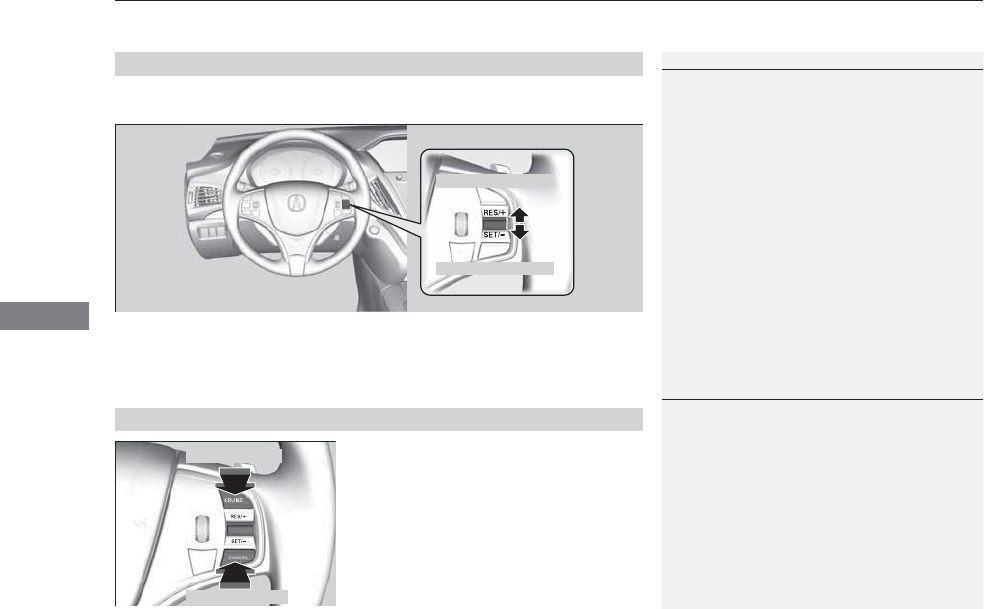
uuWhen DrivinguCruise Control
336
Driving
Increase or decrease the vehicle speed using the RES/+/SET/– switch on the steering
wheel.
•Each time you press the switch up or down, the vehicle speed is increased or
decreased by about 1 mph or 1 km/h accordingly.
•If you keep the switch pressed up or down, the vehicle speed increases or
decreases until you release it. This speed is then set.
To cancel cruise control, do any of the
following:
•Press the CANCEL button.
•Press the CRUISE button.
•Depress the brake pedal.
The CRUISE CONTROL indicator goes off.
■To Adjust the Vehicle Speed
1To Adjust the Vehicle Speed
You can set the vehicle speed pressing the RES/+/
SET/– switch down on the steering wheel when
adjusting the speed with the accelerator and brake
pedals.
■To Cancel
To decrease speed
To increase speed
1To Cancel
Resuming the prior set speed:
After cruise control has been canceled, you can still
resume the prior set speed by pressing the RES/+/
SET/– switch up while driving at a speed of at least
25 mph (40 km/h) or more.
You cannot set or resume in the following situations:
•When vehicle speed is less than 25 mph (40 km/h)
•When the CRUISE button is turned off
At vehicle speeds of 22 mph (35 km/h) or less, cruise
control is canceled automatically.
CRUISE Button
CANCEL Button
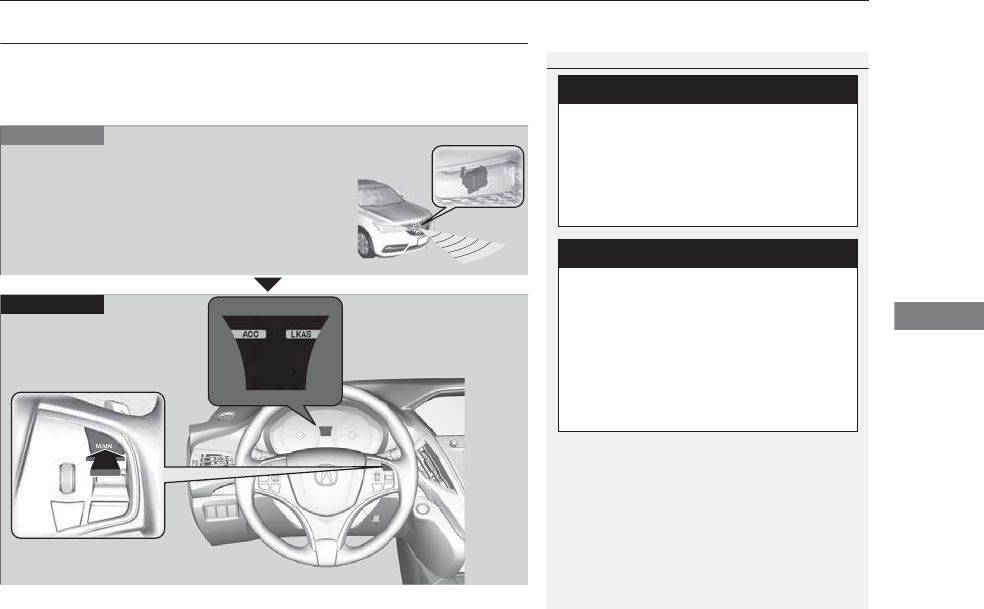
337
uuWhen DrivinguAdaptive Cruise Control (ACC) with Low Speed Follow (LSF)*
Continued
Driving
Adaptive Cruise Control (ACC) with Low Speed Follow (LSF)
*
Helps maintain a constant vehicle speed and a set following distance behind a
vehicle detected ahead of yours and, if the detected vehicle comes to a stop,
decelerates and stops your vehicle, without you having to keep your foot on the
brake or the accelerator.
1Adaptive Cruise Control (ACC) with Low Speed Follow (LSF)*
Important Safety Reminder
As with any system, there are limits to ACC with LSF.
Inappropriate use of ACC with LSF can result in a serious
accident. Use the brake pedal whenever necessary, and always
keep a safe distance between your vehicle and other vehicles.
The radar sensor for ACC with LSF is shared with the
collision mitigation braking systemTM (CMBSTM).
2Collision Mitigation Braking SystemTM
(CMBSTM)* P. 371
3
WARNING
Improper use of ACC with LSF can lead
to a crash.
Use ACC with LSF only when driving on
expressways or freeways and in good
weather conditions.
3
WARNING
Exiting a vehicle that has been stopped
while the ACC with LSF system is
operating can result in the vehicle
moving without operator control.
A vehicle that moves without operator
control can cause a crash, resulting in
serious injury or death.
■Vehicle speed for ACC with LSF: A vehicle is
detected ahead within ACC with LSF range –
ACC with LSF operates at any vehicle speed.
No vehicle is detected within ACC with LSF
range – ACC with LSF operates at the speed of
25 mph (40km/h) or above.
■Shift positions for ACC with LSF: In (D or (S.
The radar sensor is in the front grille.
■Press the MAIN button on
the steering wheel.
ACC (green) is on in the
instrument panel.
ACC with LSF is ready to
use.
When to use
How to use
* Not available on all models
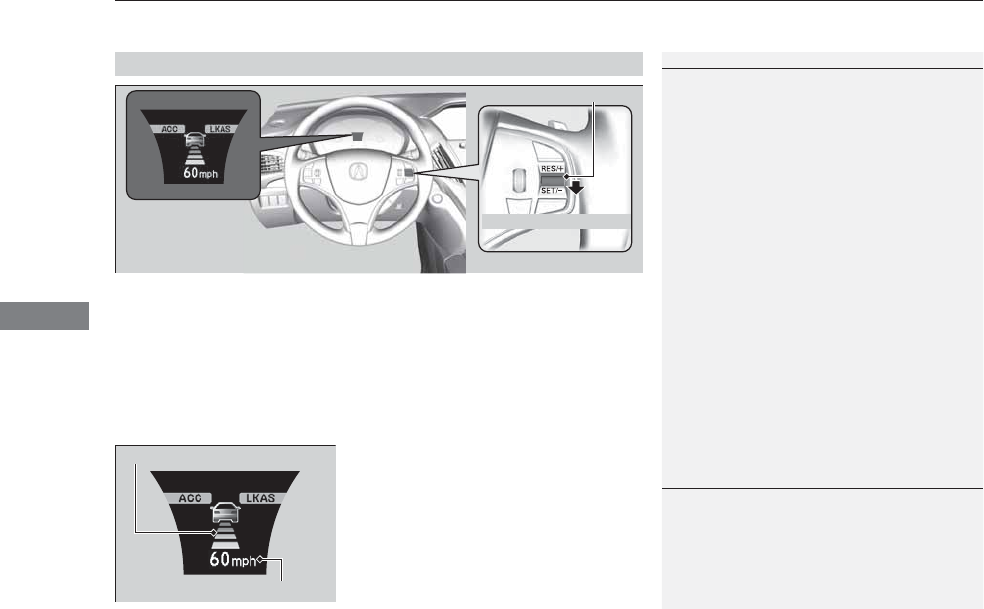
uuWhen DrivinguAdaptive Cruise Control (ACC) with Low Speed Follow (LSF)*
338
Driving
When driving at 25 mph (40 km/h) or above: Take your foot off the pedal and
press down the RES/+/SET/– switch when you reach the desired speed. The moment
you release the switch, the set speed is fixed, and ACC with LSF begins.
When driving at slower than 25 mph (40 km/h): You can set the vehicle speed
only when there is a vehicle detected ahead of you. If the vehicle is moving and the
brake pedal is not depressed, pressing the switch fixes the set speed to 25 mph (40
km/h) regardless of current vehicle speed. If the vehicle is stationary, you can set the
vehicle speed even with the brake pedal depressed.
When ACC with LSF starts operating, the
vehicle icon, distance bars and set speed
appear on the MID.
■To Set the Vehicle Speed
1Adaptive Cruise Control (ACC) with Low Speed Follow (LSF)*
When the MAIN button is pressed, ACC with LSF and
Lane Keeping Assist System (LKAS) are both turned on
or off.
Do not use ACC with LSF under these conditions:
•In poor visibility (e.g., bad weather, such as rain,
fog, and snow).
•When you must slow down and speed up
repeatedly.
•On winding roads.
•When you enter a toll gate, interchange, service
area, parking area, etc. In these areas, there is no
vehicle ahead of you, but ACC with LSF would still
try to accelerate to your set speed.
•On a slippery road (for example a road covered
with ice or snow).
•When a spare tire* is installed.
•When going down a steep hill where the engine
braking does not work sufficiently.
When not using ACC with LSF: Turn off adaptive
cruise by pressing the MAIN button. This also will
turn off the Lane Keeping Assist System (LKAS).
1To Set the Vehicle Speed
You can switch the displayed set speed
measurements on the MID between mph and km/h.
2Customizable Features P. 107
On when ACC
with LSF begins Press down and release
RES/+/SET/− Switch
Set Vehicle Speed
Set Vehicle Distance
* Not available on all models
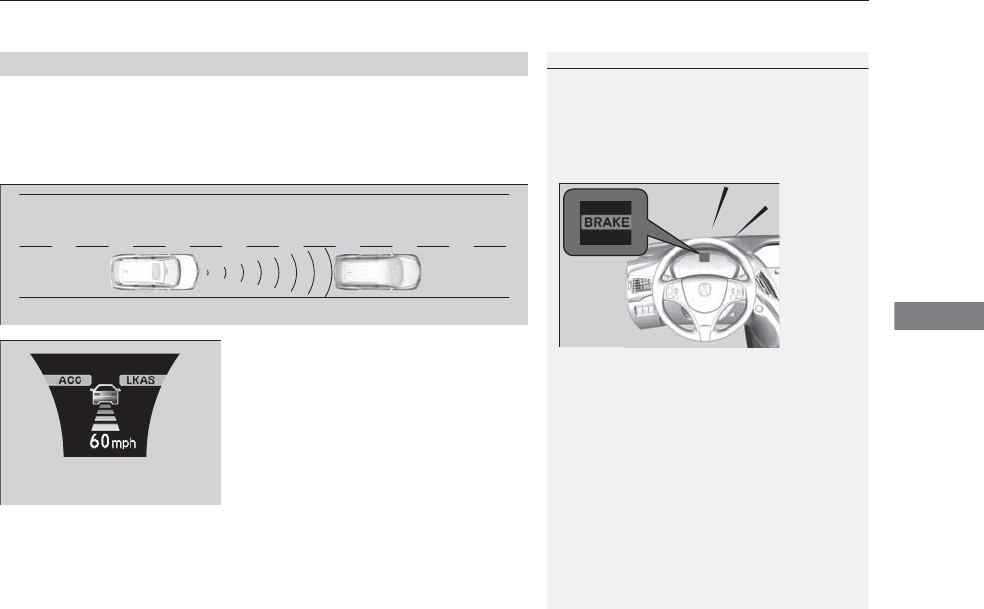
Continued 339
uuWhen DrivinguAdaptive Cruise Control (ACC) with Low Speed Follow (LSF)*
Driving
■There is a vehicle ahead
ACC with LSF monitors if a vehicle ahead of you enters the ACC with LSF range. If it
does, the ACC with LSF system maintains or decelerates your vehicle’s set speed in
order to keep the vehicle’s set following distance from the vehicle ahead.
2To Set or Change Following Distance P. 342
When a vehicle whose speed is slower than
your set speed comes in front of you, your
vehicle starts to slow down.
■When in Operation
1When in Operation
If the vehicle ahead of you slows down abruptly, or if
another vehicle cuts in front of you, the beeper
sounds and a message appears on the multi-
information display to alert you.
Depress the brake pedal, and keep an appropriate
distance from the vehicle ahead.
Even if the distance between your vehicle and the
vehicle ahead is short, ACC with LSF may start
accelerating your vehicle under the following
circumstances:
•The vehicle ahead of you is going at almost the
same speed as, or faster than, your vehicle.
•A vehicle that cuts in front of you is going faster
than your vehicle, gradually increasing the distance
between the vehicles.
If you do not want to hear a beep when the system
detects a vehicle, or when the vehicle goes out of the
ACC with LSF range, you can change the pre-running
detect car beep setting.
2Customizable Features P. 107
Beep
ACC with LSF Range: 394 ft. (120 m)
A vehicle icon appears on the MID
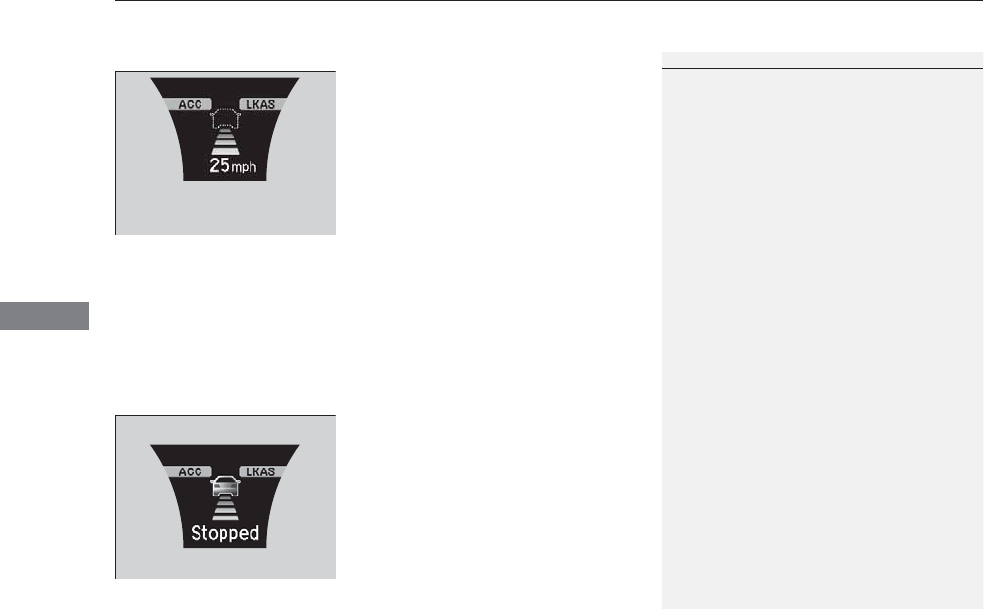
uuWhen DrivinguAdaptive Cruise Control (ACC) with Low Speed Follow (LSF)*
340
Driving
■There is no vehicle ahead
When driving at 22 mph (35 km/h) or above:
Your vehicle maintains the set speed without
having to keep your foot on the brake or
accelerator pedal.
If there previously was a vehicle detected
ahead that kept your vehicle from travelling at
the set speed, ACC with LSF accelerates your
vehicle to the set speed, and then maintains it.
When driving under 22 mph (35 km/h) and no
vehicle is detected ahead: ACC with LSF
automatically cancels. The beeper sounds once.
■When you depress the accelerator pedal
You can temporarily increase the vehicle speed. In this case, there is no audible or
visual alert even if a vehicle is in the ACC with LSF range.
ACC with LSF stays on unless you cancel it. Once you release the accelerator pedal,
the system resumes the set speed.
■A vehicle ahead is within ACC range and stops
Your vehicle also stops, automatically. The
Stopped message appears on the multi-
information display.
When the vehicle ahead of you starts again,
the vehicle icon on the MID blinks. If you press
the RES/+/SET/– switch up or down, or
depress the accelerator pedal, ACC with LSF
operates again within the prior set speed.
A vehicle icon with dotted-line
contour appears on the MID
1When in Operation
Limitations
Use the brake pedal to maintain a safe distance with
other vehicles in the following cases. ACC with LSF
may not work properly when:
•A vehicle ahead of you is parked when your vehicle
is moving.
•Motorcycles or other small vehicles are ahead of
you.
•A vehicle cuts in front of you at a short distance.
ACC with LSF may momentarily apply brakes or
sound a beep if there is a vehicle, or even a building,
next to you if:
•You make a sudden turn or drive on a narrow road.
•You abruptly move the steering wheel.
•You are in an unusual position within your lane.
When your vehicle stops automatically because a
vehicle detected ahead of you has stopped, the
distance between the two vehicles will vary based on
the ACC with LSF distance setting, as follows:
Short: 11.5 ft (3.5 m)
Middle: 14.1 ft (4.3 m)
Long, Extra Long: 16.4 ft (5.0 m)
2To Set or Change Following Distance P. 342
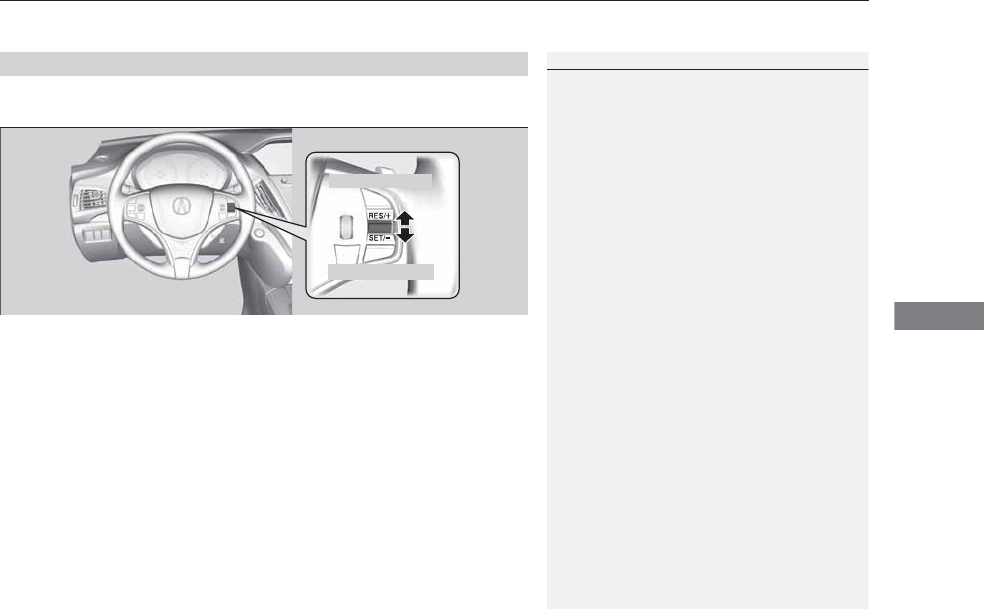
Continued 341
uuWhen DrivinguAdaptive Cruise Control (ACC) with Low Speed Follow (LSF)*
Driving
Increase or decrease the vehicle speed using the RES/+/SET/– switch on the steering
wheel.
•Each time you press the switch up or down, the vehicle speed is increased or
decreased by about 1 mph or 1 km/h accordingly.
•If you keep the switch pressed up or down, the vehicle speed increases or
decreases by about 5 mph or 5 km/h accordingly.
■To Adjust the Vehicle Speed
1To Adjust the Vehicle Speed
If a vehicle detected ahead is going at a speed slower
than your increased set speed, ACC with LSF may not
accelerate your vehicle. This is to maintain the set
distance between your vehicle and the vehicle ahead.
To increase speed
To decrease speed
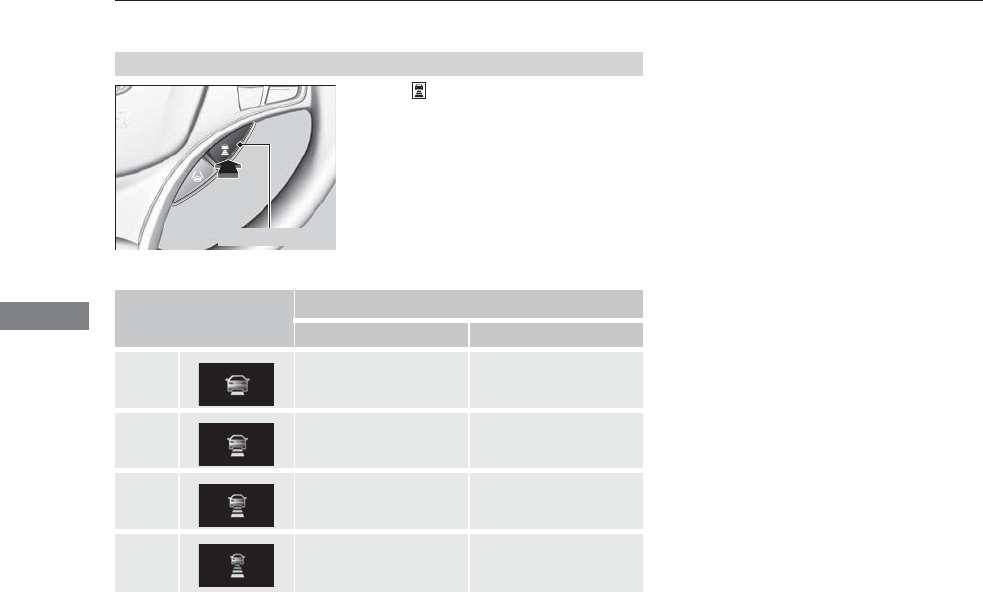
342
uuWhen DrivinguAdaptive Cruise Control (ACC) with Low Speed Follow (LSF)*
Driving
Press the (distance) button to change the
ACC with LSF following distance.
Each time you press the button, the following
distance (the distance behind a vehicle
detected ahead of you) setting cycles through
short, middle, long, and extra long following
distances.
The higher your selected set speed is, the longer the short, middle, long or extra long
following distance becomes. See the following examples for your reference.
■To Set or Change Following Distance
Distance Button
Following Distance
When the Set Speed is:
50 mph (80 km/h) 65 mph (104 km/h)
Short 83 feet
25 meters
100 feet
31 meters
Middle 110 feet
33 meters
137 feet
42 meters
Long 154 feet
47 meters
200 feet
61 meters
Extra
Long
204 feet
62 meters
265 feet
81 meters
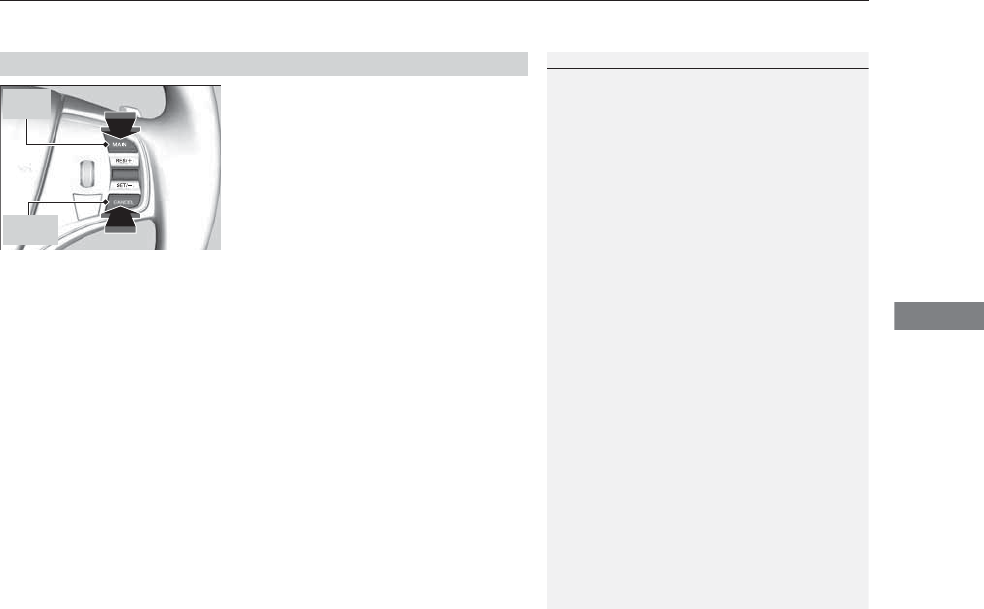
Continued 343
uuWhen DrivinguAdaptive Cruise Control (ACC) with Low Speed Follow (LSF)*
Driving
To cancel ACC with LSF, do any of the
following:
•Press the CANCEL button.
•Press the MAIN button.
uACC with LSF indicator goes off.
•Depress the brake pedal.
uWhen the LSF function has stopped the
vehicle, you cannot cancel ACC with LSF
by depressing the brake pedal.
■To Cancel
1To Cancel
Resuming the prior set speed: After you have
canceled ACC with LSF, you can resume the prior set
speed while it is still displayed. Press the RES/+/SET/
– switch up when driving at a speed of at least 25
mph (40 km/h) or more.
Even if your vehicle speed has gone down to less than
25 mph (40 km/h), you can still resume the prior set
speed when ACC with LSF detects a vehicle ahead of
you.
You cannot set or resume in the following situations:
•When the vehicle speed is less than 25 mph
(40km/h) and there is no vehicle detected in front
of your vehicle
•When the MAIN button is turned off
CANCEL
Button
MAIN
Button

uuWhen DrivinguAdaptive Cruise Control (ACC) with Low Speed Follow (LSF)*
344
Driving
■Automatic cancellation
The beeper sounds and a message appears on the MID when ACC with LSF is
automatically canceled. Any of these conditions may cause the ACC with LSF to
automatically cancel:
•Your vehicle speed slows to 22 mph (35 km/h) or below when a detected vehicle
goes out of the ACC with LSF range.
•Bad weather (rain, fog, snow, etc.)
•When the radar sensor in the front grille gets dirty.
•The vehicle ahead of you cannot be detected.
•An abnormal tire condition is detected, or the tires are skidding.
•Driving on a mountainous road, or driving off road for extended periods.
•Abrupt steering wheel movement.
•When the ABS, VSA® or CMBSTM is activated.
•When the VSA® indicator comes on.
•When the vehicle is stopped on a very steep slope.
•When you manually apply the parking brake.
•When the detected vehicle within the ACC with LSF range is too close to your
vehicle.
•The driver’s seat belt is unfastened when the vehicle is stationary.
•The vehicle stops for more than 10 minutes.
•The engine is turned off.
•When trailer stability assist is activated.
2Trailer Stability Assist* P. 317
The ACC with LSF automatic cancellation can be also triggered by the following
causes.
1Automatic cancellation
Even though ACC with LSF has been automatically
canceled, you can still resume the prior set speed.
Wait until the condition that caused ACC with LSF to
cancel improves, then press the RES/+/SET/– switch
down.
* Not available on all models
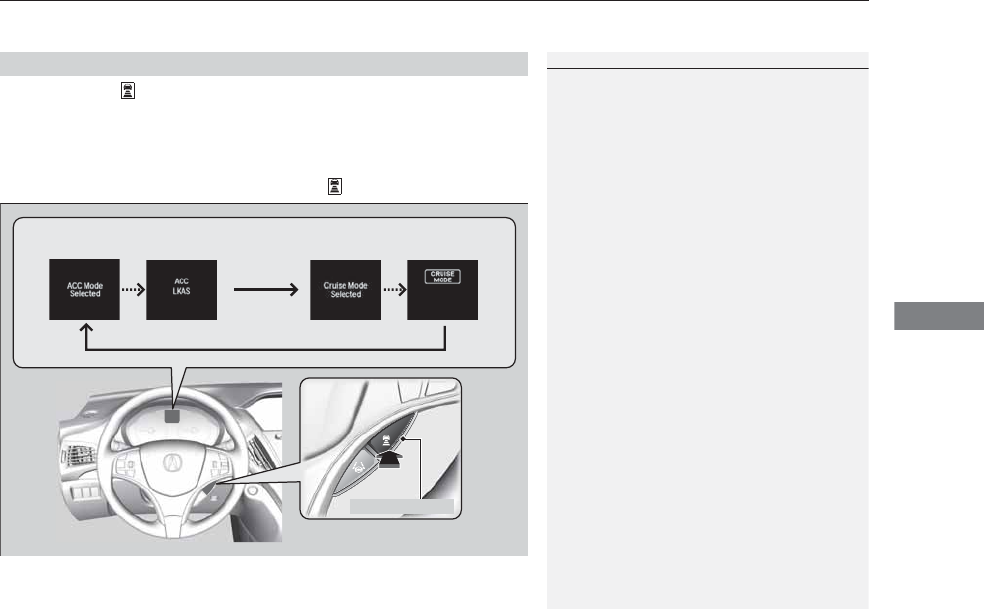
345
uuWhen DrivinguAdaptive Cruise Control (ACC) with Low Speed Follow (LSF)*
Driving
Press and hold the (distance) button for one second.
Cruise Mode Selected appears on the MID for two seconds, and then the mode
switches to Cruise.
To switch back to ACC with LSF, press and hold the button again for one second.
■To Switch ACC with LSF to Cruise Control
1To Switch ACC with LSF to Cruise Control
Always be aware which mode you are in. When you
are driving in Cruise mode, be more cautious about
keeping a safe distance from a vehicle ahead of you.
The current mode is displayed on the multi-
information display.
2Switching the Display P. 98
ACC with
LSF ON
Cruise
Control ON
Distance Button
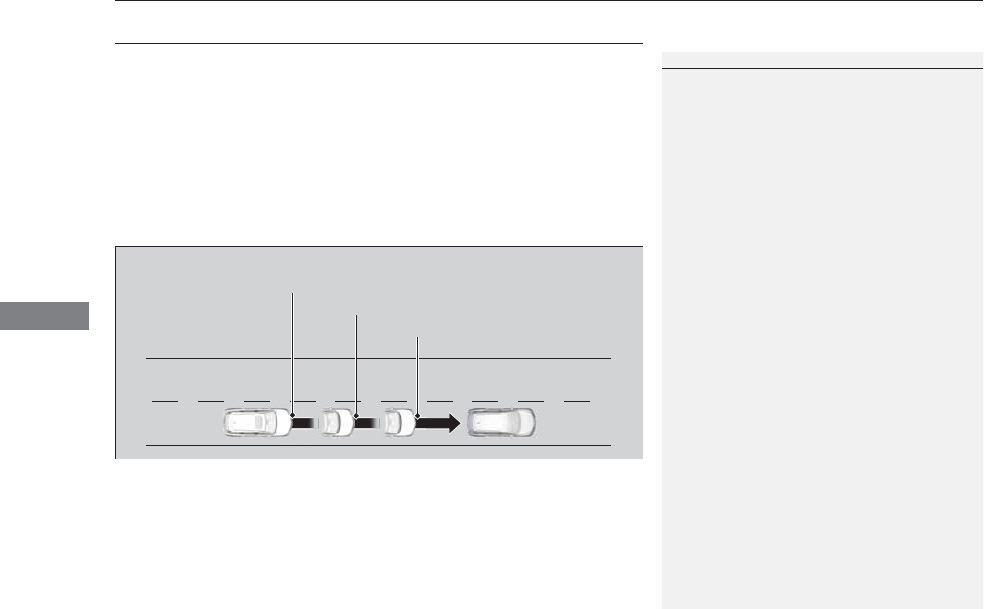
346
uuWhen DrivinguForward Collision Warning (FCW)*
Driving
Forward Collision Warning (FCW)*
Alerts you when it detects the possibility of your vehicle colliding with the vehicle in
front of yours.
If the system determines a collision is possible, it gives both visual and audible alerts.
uTake appropriate action to prevent a collision (apply the brakes, change lanes,
etc.).
■How the system works
The system may give warnings of potential collisions when your vehicle speed is
above 10 mph (15 km/h).
1Forward Collision Warning (FCW) *
Important Safety Reminder
FCW cannot detect all objects ahead and may not
detect a given object; accuracy of the system will vary
based on weather, speed and other factors. FCW
does not include a braking function. It is always your
responsibility to safely operate the vehicle and avoid
collisions.
You can change the Forward Collision Warning
Distance setting or turn the system on and off.
2Customizable Features P. 107
The camera is shared with Lane Departure Warning
(LDW).
2LDW Camera P. 351
LONG
NORMAL
SHORT
Your Vehicle Vehicle Ahead
You can set Long, Normal or Short for when warnings start:
* Not available on all models
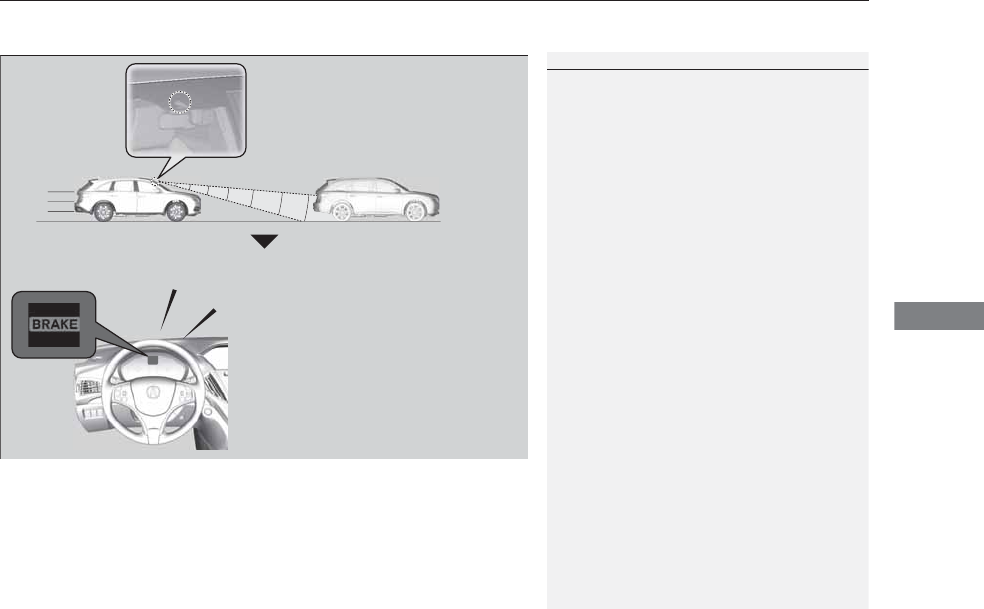
Continued 347
uuWhen DrivinguForward Collision Warning (FCW)*
Driving
1Forward Collision Warning (FCW) *
Never apply a film or attach any objects to the
windshield that could obstruct the FCW camera’s
field of vision.
Scratches, nicks, and other damage to the windshield
within the FCW camera’s field of vision can cause the
system to operate abnormally. If this occurs, we
recommend that you replace the windshield with a
genuine Acura replacement windshield. Making even
minor repairs within the camera’s field of vision or
installing an aftermarket replacement windshield
may also cause the system to operate abnormally.
After replacing the windshield, have a dealer
recalibrate the camera. Proper calibration of the FCW
camera is necessary for the system to operate
properly.
Beep
The camera is located
behind the rearview mirror.
The beeper sounds and the BRAKE message
appears in the MID until a possible collision is
avoided.
* Not available on all models
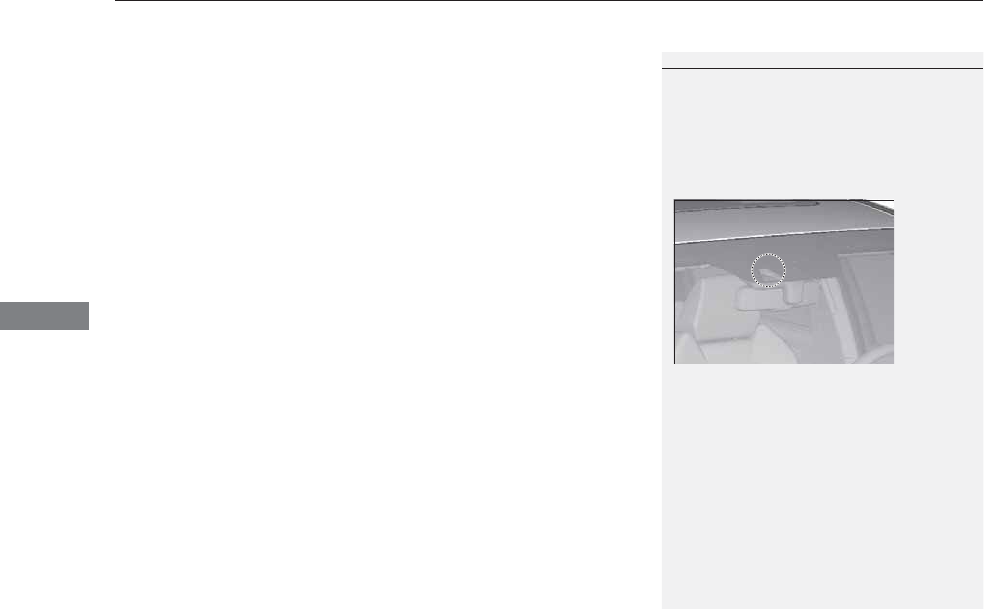
uuWhen DrivinguForward Collision Warning (FCW)*
348
Driving
■Automatic shutoff
FCW may automatically shut itself off and the FCW indicator comes and stays on
when:
•The temperature inside the system is high.
•The windshield is blocked by dirt, mud, leaves, wet snow, etc.
Once the conditions that caused FCW to shut off improve or are addressed (e.g.,
cleaning), the system comes back on.
1Automatic shutoff
To help reduce the likelihood that high interior
temperatures will cause the camera system to shut off,
when parking, find a shady area or face the front of the
vehicle away from the sun.
If you use a reflective sun shade, do not allow it to
cover the camera housing. Covering the camera can
concentrate heat on the camera.
If the Can Not Operate: Camera Too Hot message
appears:
•Use the climate control system to cool down the
interior and, if necessary, the defroster mode when
windows are fogged.
•Start driving the vehicle to lower the windshield
temperature, which cools down the area around
the FCW camera.
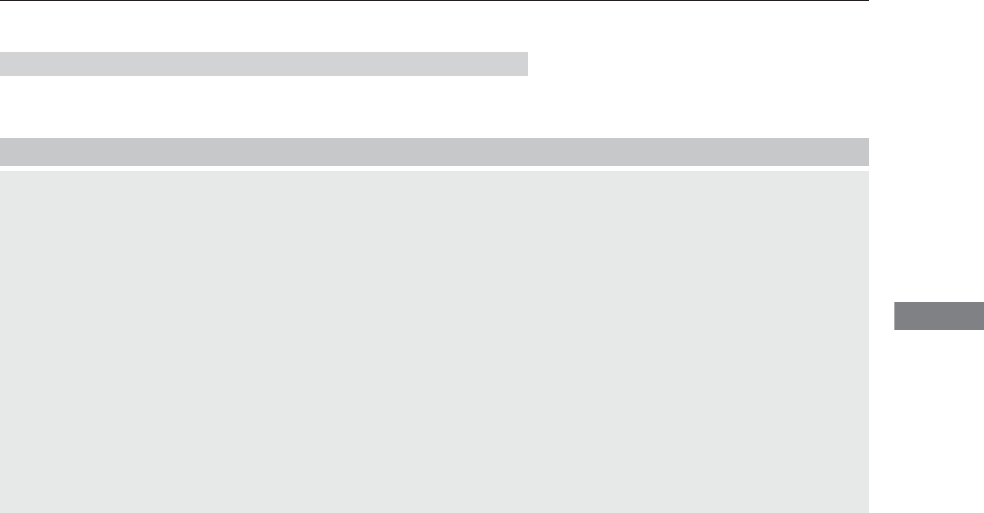
349
uuWhen DrivinguForward Collision Warning (FCW)*
Driving
FCW may not activate or may not detect a vehicle in front of your vehicle, and may
activate even when you are aware of a vehicle ahead of you, or when there is no
vehicle ahead, under the following conditions.
■FCW Limitations
Condition
●The distance between your vehicle and the vehicle ahead of you is too short.
●A vehicle cuts in front of you at a slow speed, and it brakes suddenly.
●A vehicle suddenly crosses in front of you.
●When either your vehicle or the vehicle ahead of you accelerates rapidly.
●The vehicle ahead of you is a motorcycle, a small vehicle, or a unique vehicle such as a tractor.
●When you drive off-road or on a mountain road, or curved and winding road for an extended period that makes it difficult for the sensor/camera to
properly detect a vehicle in front of you.
●When there are pedestrians or animals in front of your vehicle.
●When you drive in bad weather (rain, fog, etc.).
●A heavy load in the rear or modifications to the suspension tilts your vehicle.
●An abnormal tire condition is detected (wrong tire size, flat tire, etc.).
●When the windshield is blocked by dirt, mud, leaves, wet snow, etc.
●When the temperature inside the system is high.
●A sudden change between light and dark such as an entrance or exit of a tunnel.
●You drive into the sunlight (e.g. at dawn or dusk).
●When the windshield is dirty or cloudy.
●When streetlights are perceived as the taillight of a vehicle in front of yours.
●When driving at night, the vehicle ahead of you is running with either taillight bulb burned out.
●When you drive in the shadows of trees, buildings, etc.
●When your vehicle is towing a trailer.
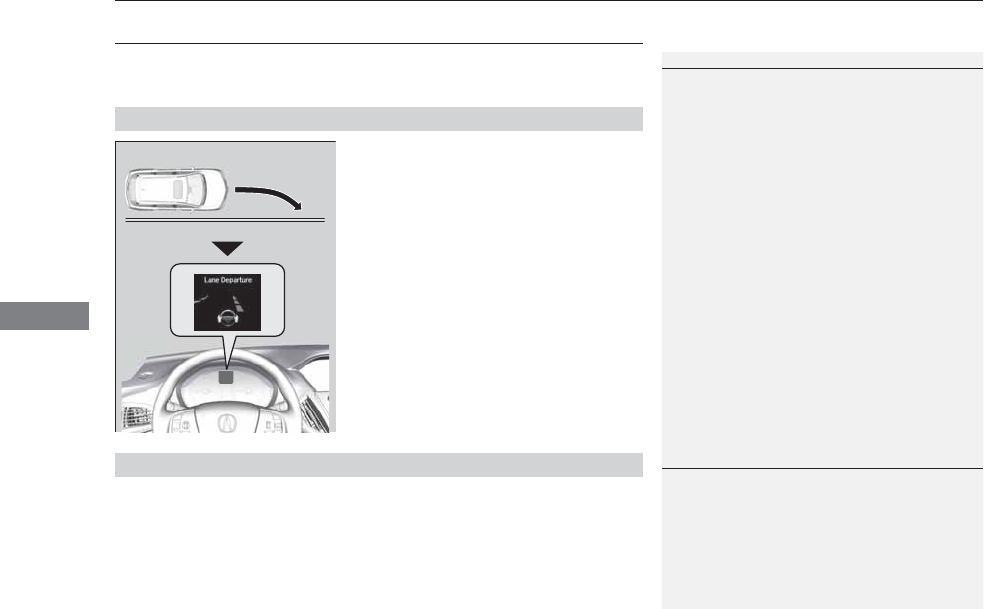
350
uuWhen DrivinguLane Departure Warning (LDW)*
Driving
Lane Departure Warning (LDW)*
Alerts you when the system detects a possibility of your vehicle unintentionally
crossing over left or right side lane markings.
If your vehicle is getting too close to detected
left or right side lane markings without a turn
signal activated, LDW will give audible and
visual alerts.
The beeper sounds and the Lane Departure
message appears on the MID, letting you
know that you need to take appropriate
action.
The system begins to search for lane markings when all the following conditions are
met:
•The vehicle is traveling between 40 and 90 mph (64 and 145 km/h).
•The vehicle is on a straight or slightly curved road.
•The turn signals are off.
•The brake pedal is not depressed.
■How the System Works
1Lane Departure Warning (LDW)*
Important Safety Reminder
Like all assistance systems, LDW has limitations.
Over-reliance on LDW may result in a collision. It is
always your responsibility to keep the vehicle within
your driving lane.
LDW only alerts you when lane drift is detected
without a turn signal in use. LDW may not detect all
lane markings or lane departures; accuracy will vary
based on weather, speed and lane marker condition.
It is always your responsibility to safely operate the
vehicle and avoid collisions.
■How the System Activates
1How the System Activates
LDW may automatically shut off and the LDW
indicator comes and stays on.
2Indicators P. 81
* Not available on all models
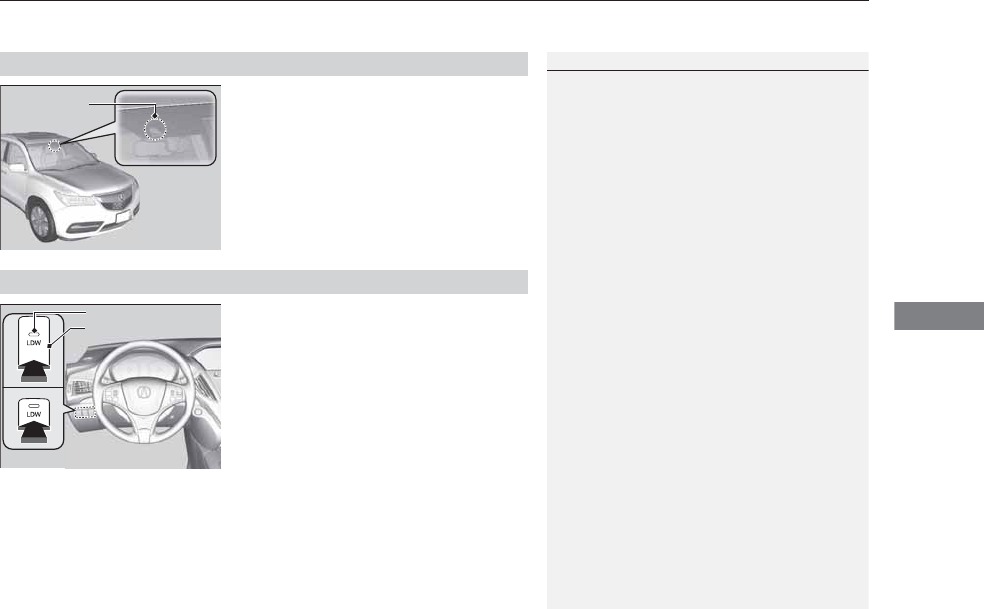
Continued 351
uuWhen Driving uLane Departure Warning (LDW)*
Driving
The camera is located behind the rearview
mirror.
Press the LDW button to turn the system on
and off.
uThe indicator in the button comes on
when the system is on.
■LDW Camera
1LDW Camera
Never apply a film or attach any objects to the
windshield that could obstruct the LDW camera’s
field of vision.
Scratches, nicks, and other damage to the windshield
within the LDW camera’s field of vision can cause the
system to operate abnormally. If this occurs, we
recommend that you replace the windshield with a
genuine Acura replacement windshield. Making even
minor repairs within the camera’s field of vision or
installing an aftermarket replacement windshield
may also cause the system to operate abnormally.
After replacing the windshield, have a dealer
recalibrate the camera. Proper calibration of the LDW
camera is necessary for the system to operate properly.
Do not place an object on the top of the instrument
panel. It may reflect onto the windshield and prevent
the system from detecting lane lines properly.
To help reduce the likelihood that high interior
temperatures will cause the camera system to shut off,
when parking, find a shady area or face the front of the
vehicle away from the sun. Also, do not use a reflective
sun shade that can concentrate heat on the camera.
If the Can Not Operate: Camera Too Hot message
appears:
•Use the climate control system to cool down the
interior and, if necessary, the defroster mode when
windows are fogged.
•Start driving the vehicle to lower the windshield
temperature, which cools down the area around
the LDW camera.
LDW Camera
■LDW On and Off
LDW Button
Indicator

352
uuWhen DrivinguLane Departure Warning (LDW)*
Driving
LDW may not activate or may not recognize lanes, and may activate even when
keeping in the middle of a lane, under the following conditions.
■LDW Limitations
Condition
●When you drive in bad weather (rain, fog, etc.).
●A heavy load in the rear or modifications to the suspension tilts your vehicle.
●An abnormal tire condition is detected (wrong tire size, flat tire, etc.).
●When the windshield is blocked by dirt, mud, leaves, wet snow, etc.
●When the temperature inside the system is high.
●A sudden change between light and dark such as an entrance or exit of a tunnel.
●You drive into the sunlight (e.g. at dawn or dusk).
●When the windshield is dirty or cloudy.
●When you drive in the shadows of trees, buildings, etc.
●When your vehicle is towing a trailer.
●When you drive on a wet road surface following another vehicle.
uThe camera may perceive the tire tracks in the water as lane lines.
●When there is snow or wheel tracks on the side of the road.
●When the road has many repaired area or an erased lane line.
●When the vehicle is running over painted signs or crosswalk markings.
●When you drive in a lane with worn-out lane markings.
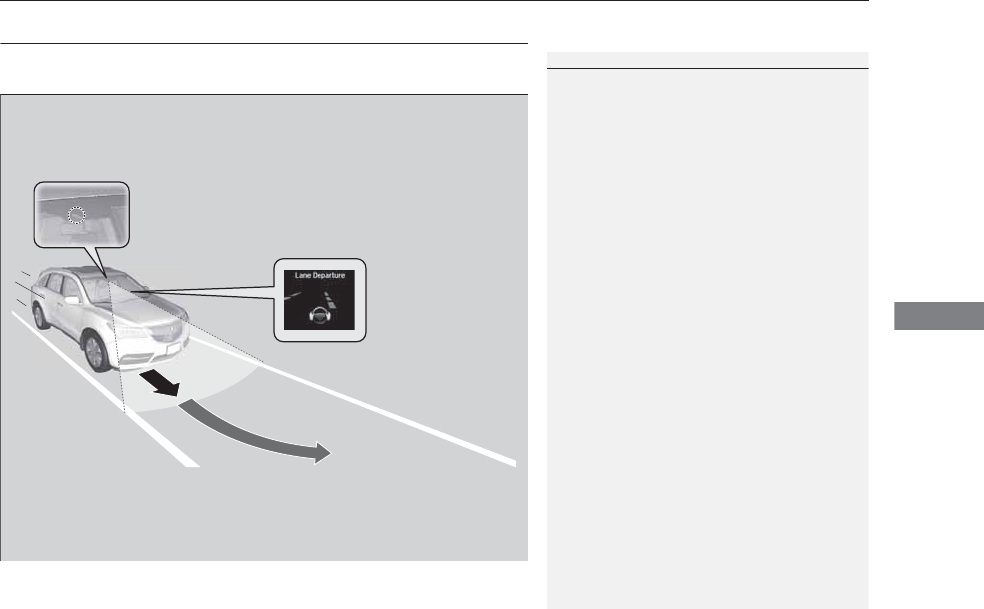
353
uuWhen DrivinguLane Keeping Assist System (LKAS)*
Continued
Driving
Lane Keeping Assist System (LKAS)*
Provides steering input to help keep the vehicle in the middle of a detected lane and
provides audible and visual alerts if the vehicle is detected drifting out of its lane.
1Lane Keeping Assist System (LKAS)*
Important Safety Reminders
The LKAS is for your convenience only. It is not a
substitute for your vehicle control. The system does
not work if you take your hands off the steering
wheel or fail to steer the vehicle.
2Multi-Information Display (MID) Warning
and Information Messages P. 96
Do not place an object on the top of the instrument
panel. It may reflect onto the windshield and prevent
the system from detecting lane lines properly.
The LKAS is convenient when it is used on freeways.
The LKAS may not work properly under the following
conditions:
•Your tires are over or under inflated.
•Your tires or wheels are of varied size or
construction.
•Your vehicle’s suspension has been altered,
changing the height of the vehicle.
•Your vehicle has heavy load in the trunk or on the
rear seats.
•A compact spare tire * is mounted.
•Driving on snowy or wet roads.
•Roadway lane markers are difficult to see due to
weather (rain, snow, fog, etc.) or road conditions.
•Driving on a road with temporary lane markings.
•Multiple or varied lane markings are visible on the
pavement due to road repairs or old lane markings.
•Roadway objects or structures are misinterpreted
as lane markers.
•On non-freeway roadways and on freeways with
many curves.
■Steering input assist
The system applies torque to the
steering to keep the vehicle between
the left and right lane lines. The
applied torque becomes stronger as the
vehicle gets closer to either of the lane
lines.
■Audible and visual alerts
Beeps and a warning display alert
you that the vehicle is drifting out of
a detected lane.
When you operate the turn signals to change lanes, the system is suspended, and
resumes after the signals are off.
If you make a lane change without operating the turn signals, the LKAS alerts
activate, and torque is applied to the steering.
■LKAS camera
Monitors the lane
lines
* Not available on all models
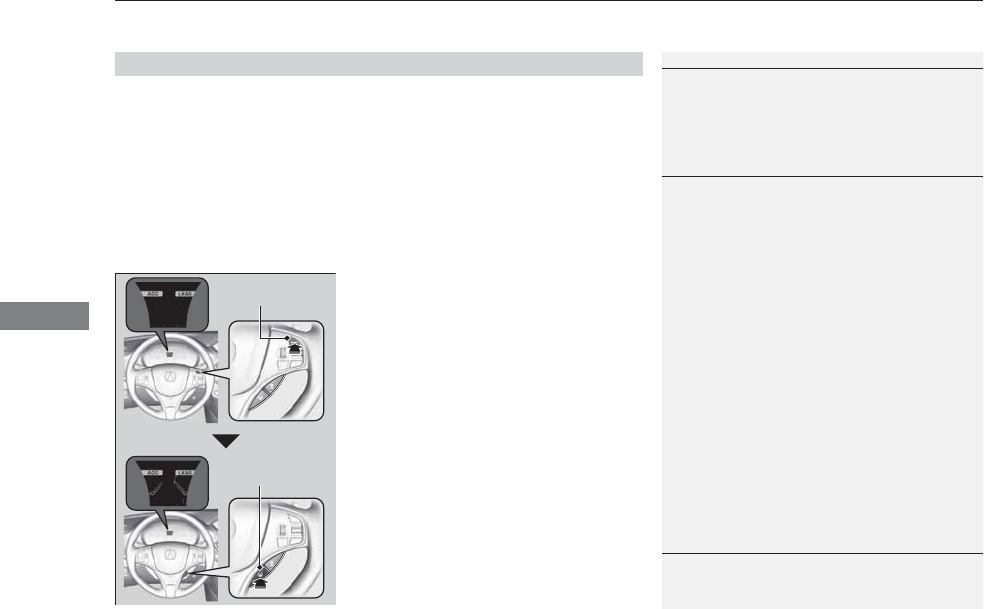
uuWhen DrivinguLane Keeping Assist System (LKAS)*
354
Driving
The system can be used when the following conditions are met.
•The lane you are driving in has detectable lane markers on both sides, and your
vehicle is in the center of the lane.
•The vehicle speed is between 45 and 90 mph (72 and 145 km/h).
•You are driving on a straight or slightly curved road.
•The turn signals are off.
•The brake pedal is not depressed.
•The wipers are not in continuous operation.
■How to activate the system
1. Press the MAIN button.
uThe LKAS is on in the MID.
The system is ready to use.
2. Press the LKAS button.
uLane outlines appear on the multi-
information display.
The system is activated.
■When the System can be Used
1Lane Keeping Assist System (LKAS)*
•Shadows of adjacent objects are parallel to lane
markings.
•The windshield is dirty.
•Where the roadway has crossing or other lines
(e.g., such as at an intersection).
1LKAS camera
Never apply a film or attach any objects to the
windshield that could obstruct the LKAS camera’s
field of vision.
Scratches, nicks, and other damage to the windshield
within the LKAS camera’s field of vision can cause the
system to operate abnormally. If this occurs, we
recommend that you replace the windshield with a
genuine Acura replacement windshield. Making even
minor repairs within the camera’s field of vision or
installing an aftermarket replacement windshield
may also cause the system to operate abnormally.
After replacing the windshield, have a dealer
recalibrate the camera. Proper calibration of the LKAS
camera is necessary for the system to operate properly.
If the Can Not Operate: Camera Too Hot message
appears:
•Use the climate control system to cool down the
interior and, if necessary, the defroster mode when
windows are fogged.
•Start driving the vehicle to lower the windshield
temperature, which cools down the area around
the LKAS camera.
1When the System can be Used
If the vehicle drifts toward either left or right lane line
due to the system applying torque, turn off the LKAS
and have your vehicle checked by a dealer.
MAIN Button
LKAS Button
* Not available on all models
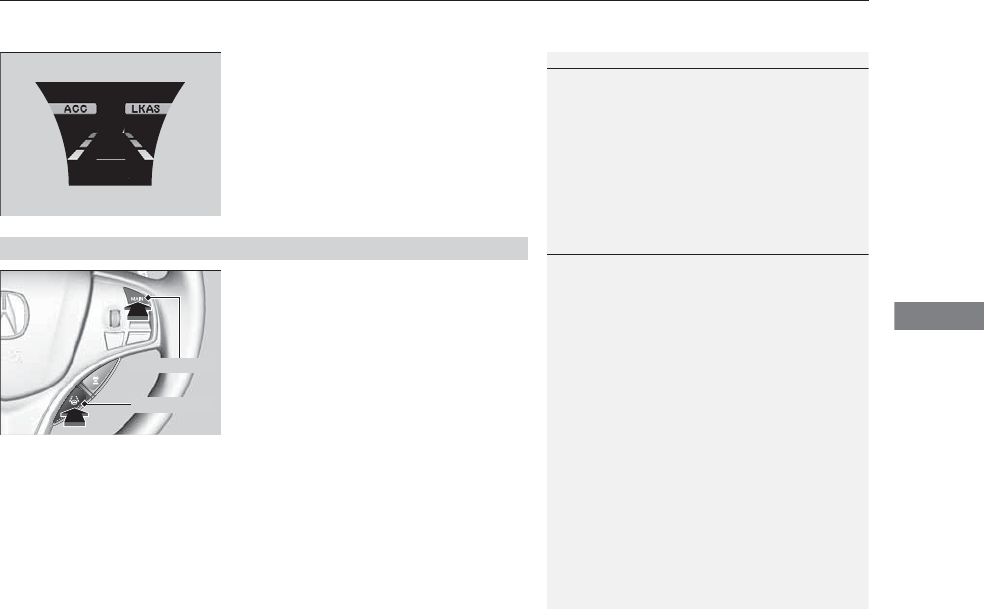
Continued 355
uuWhen DrivinguLane Keeping Assist System (LKAS)*
Driving
3. Keep your vehicle near the center of the
lane while driving.
uThe dotted outer lines change to solid
ones once the system starts operating
after detecting the left and right lane
markings.
To cancel the LKAS:
Press the MAIN or LKAS button.
The LKAS is turned off every time you stop the
engine, even if you turned it on the last time
you drove the vehicle.
■To cancel
1When the System can be Used
The LKAS temporarily deactivates when it fails to
detect lane lines. When the system detects the lines
again, it comes back on automatically.
1To cancel
Pressing the MAIN button also turns ACC with LSF
on and off.
MAIN Button
LKAS Button
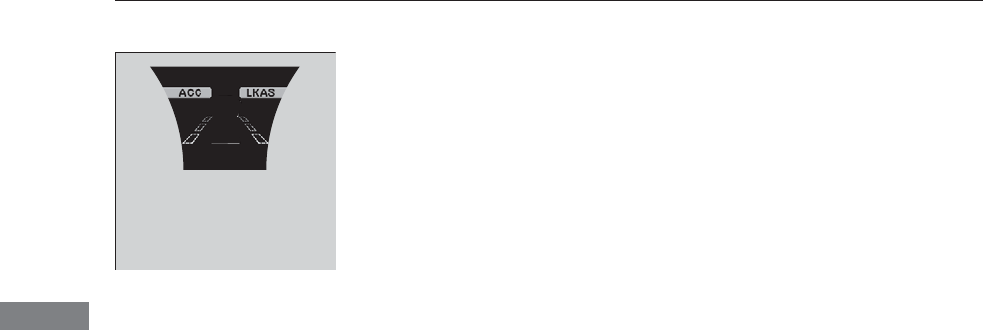
356
uuWhen DrivinguLane Keeping Assist System (LKAS)*
Driving
■The system operation is suspended if
you:
•Set the wipers to continuous operation.
uTurning the wipers off resumes the
LKAS.
•Decrease the vehicle speed to 40 mph (64
km/h) or less.
uIncreasing the vehicle speed to 45 mph
(72 km/h) or more resumes the LKAS.
•Depress the brake pedal.
uThe LKAS resumes and starts detecting
the lane lines again once you release the
brake pedal.
■The LKAS may automatically be suspended when:
•The system fails to detect lane lines.
•The steering wheel is quickly turned.
•You fail to steer the vehicle.
•The vehicle is driven on a curved road over the speed limit.
•The camera temperature gets extremely high or low.
Once these conditions no longer exist, the LKAS automatically resumes.
When the LKAS is suspended,
the lane lines on the multi-
information display change to
contour lines.
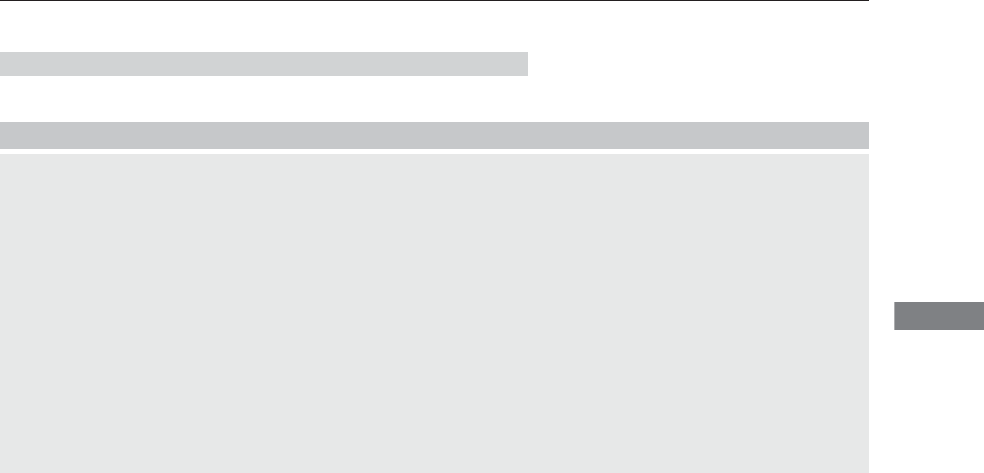
357
uuWhen DrivinguLane Keeping Assist System (LKAS)*
Driving
The system may not detect lane markings and the position of your vehicle properly
under the following conditions.
■LKAS Limitations
Condition
●The vehicle interior is reflected onto the front windshield.
●Headlight lenses are dirty or the headlights are not properly adjusted.
●The windshield is fogged.
●Driving on snowy or wet roads.
●The ambient brightness suddenly changes (e.g., at the entrance or exit of a tunnel).
●You drive into the low sun (e.g., at dawn or dusk).
●A strong light is reflected onto the roadway.
●Roadway lane markers are difficult to see due to weather (rain, snow, fog, etc.) or road conditions.
●Driving on a road with temporary lane markings.
●Multiple or varied lane markings are visible on the roadway due to road repairs or old lane markings.
●Roadway objects or structures are misinterpreted as lane markers.
●There is little contrast between lane lines and the roadway surface.
●The vehicle in front of you is driving near the lane lines.
●Driving over bumps.
●Where marked lanes merge or split.
●Where the lane is extremely narrow, wide or changing.
●Where the road is hilly or the vehicle is approaching the crest of a hill.
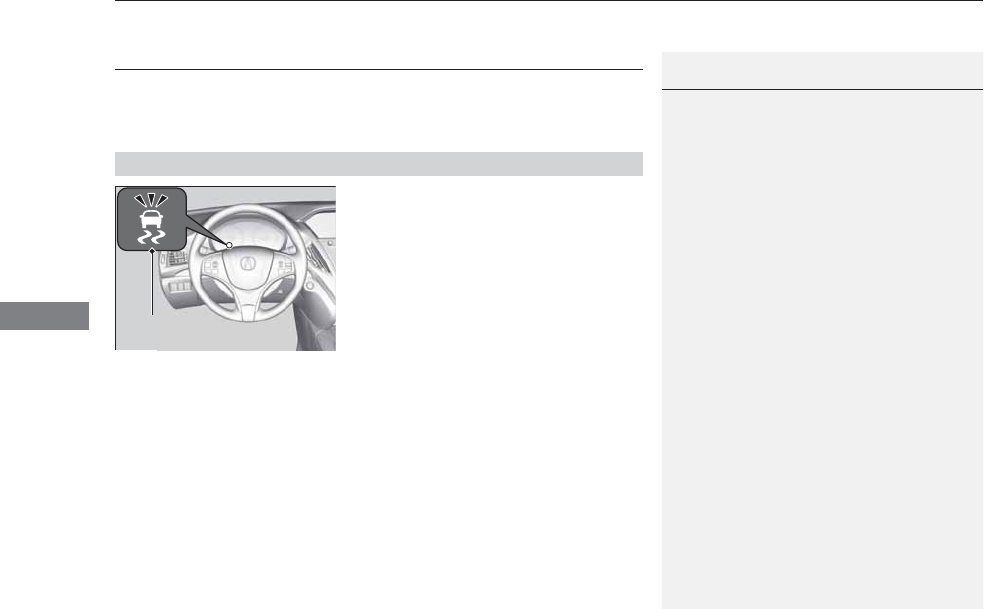
358
uuWhen DrivinguVSA® (Vehicle Stability Assist), aka ESC (Electronic Stability Control), System
Driving
VSA® (Vehicle Stability Assist), aka ESC (Electronic
Stability Control), System
VSA® helps to stabilize the vehicle during cornering if the vehicle turns more or less
than what was intended. It also assists in maintaining traction on slippery surfaces.
It does so by regulating engine output and selectively applying the brakes.
When VSA® activates, you may notice that the
engine does not respond to the accelerator.
You may also notice some noise from the
hydraulic system. You will also see the
indicator blink.
■VSA® Operation
1VSA® (Vehicle Stability Assist), aka ESC (Electronic Stability
Control), System
The VSA® may not function properly if tire type and
size are mixed. Make sure to use the same size and
type of tire, and the air pressures as specified.
When the VSA® indicator comes on and stays on
while driving, there may be a problem with the
system. While this may not interfere with normal
driving, have your vehicle checked by a dealer
immediately.
VSA® cannot enhance stability in all driving situations
and does not control the entire braking system. You
still need to drive and corner at speeds appropriate
for the conditions and always leave a sufficient
margin of safety.
The main function of the VSA® system is generally
known as Electronic Stability Control (ESC). The
system also includes a traction control function.
VSA® System
Indicator
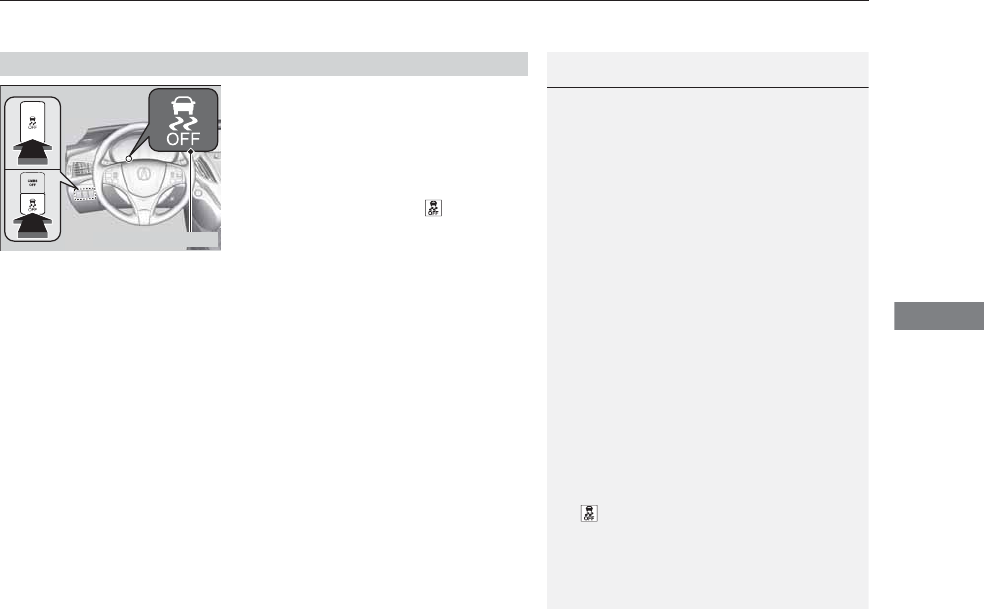
359
uuWhen DrivinguVSA® (Vehicle Stability Assist), aka ESC (Electronic Stability Control), System
Driving
This button is on the driver side control panel.
To turn the VSA® system on and off, press and
hold it until you hear a beep.
VSA® will stop and the indicator will come on.
To turn it on again, press the (VSA® OFF)
button until you hear a beep.
VSA® is turned on every time you start the
engine, even if you turned it off the last time
you drove the vehicle.
■VSA® On and Off
1VSA® (Vehicle Stability Assist), aka ESC (Electronic Stability
Control), System
Without VSA®, your vehicle will have normal braking
and cornering ability, but it will not have VSA®
traction and stability enhancement.
In certain unusual conditions when your vehicle gets
stuck in shallow mud or fresh snow, it may be easier
to free it with the VSA® temporarily switched off.
When the VSA® system is off, trailer stability assist is
also off.
2Trailer Stability Assist* P. 317
When the VSA® system is off, the traction control
system is also off. You should only attempt to free
your vehicle with the VSA® off if you are not able to
free it when the VSA® is on.
Immediately after freeing your vehicle, be sure to
switch VSA® on again. We do not recommend driving
your vehicle with the VSA® and traction control
systems switched off.
If the low tire pressure/TPMS indicator comes on or
blinks, the VSA® system turns on automatically. In
this case, you cannot turn the system off by pressing
the button.
You may hear a motor sound coming from the
engine compartment while system checks are being
performed immediately after starting the engine or
while driving. This is normal.
VSA® OFF Indicator
* Not available on all models
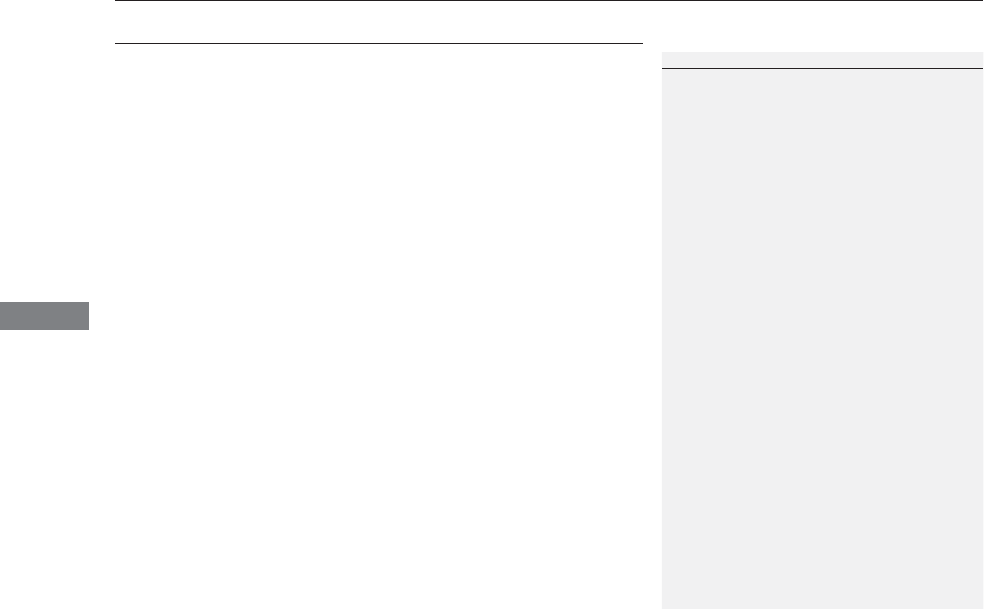
360
uuWhen DrivinguAgile Handling Assist System
Driving
Agile Handling Assist System
Lightly brakes each of the front and rear wheels, as needed, when you turn the
steering wheel, and helps support the vehicle’s stability and performance during
cornering.
1Agile Handling Assist System
The agile handling assist system cannot enhance
stability in all driving situations. You still need to drive
and corner at speeds appropriate for the conditions
and always leave a sufficient margin of safety.
When the VSA® indicator comes on and stays on
while driving, the agile handling assist system does
not activate.
You may hear a sound coming from the engine
compartment while the system is activated. This is
normal.
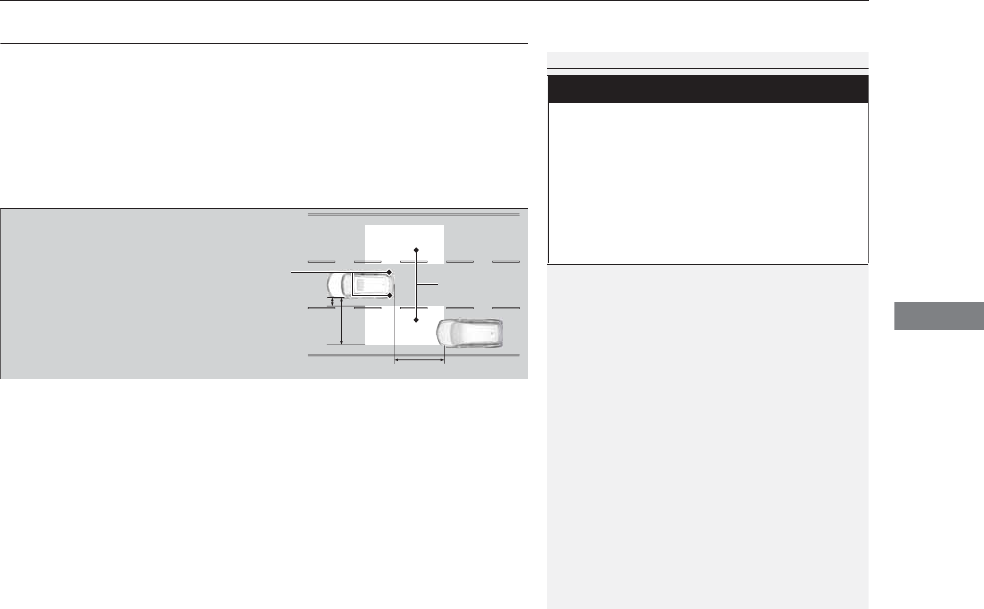
361
uuWhen DrivinguBlind Spot Information (BSI) System*
Continued
Driving
Blind Spot Information (BSI) System*
Is designed to detect vehicles in specified alert zones adjacent to your vehicle,
particularly in harder to see areas commonly known as “blind spots.”
When the system detects vehicles approaching from behind in adjacent lanes, the
appropriate indicator comes on for a few seconds, providing assistance when you
change lanes.
■How the system works
1Blind Spot Information (BSI) System*
Important Safety Reminder
Like all assistance systems, BSI has limitations. Over
reliance on BSI may result in a collision.
The system is for your convenience only. Even if an
object is within the alert zone, the following
situations may occur.
•The BSI alert indicator may not come on due to
obstruction (splashes, etc.) even without the Blind
Spot Not Available MID appearing.
•The BSI alert indicator may come on even with the
message appearing.
The BSI alert indicator may not come on under the
following conditions:
•A vehicle does not stay in the alert zone for more
than two seconds.
•A vehicle is parked in a side lane.
•The speed difference between your vehicle and the
vehicle you are passing is greater than 6 mph (10
km/h).
•An object not detected by the radar sensors
approaches or passes your vehicle.
3
WARNING
Failure to visually confirm that it is safe to
change lanes before doing so may result in
a crash and serious injury or death.
Do not rely only on the blind spot
information system when changing lanes.
Always look in your mirrors, to either side
of your vehicle, and behind you for other
vehicles before changing lanes.
●The shift lever is in (D.
●Your vehicle speed is
between 20 mph (32 km/h)
and 100 mph (160 km/h)
Alert zone range
A: Approx. 1.6 ft. (0.5 m)
B: Approx. 10 ft. (3 m)
C: Approx. 10 ft. (3 m)
Radar Sensors:
underneath the
rear bumper
corners
Alert Zone
A
B
C
* Not available on all models
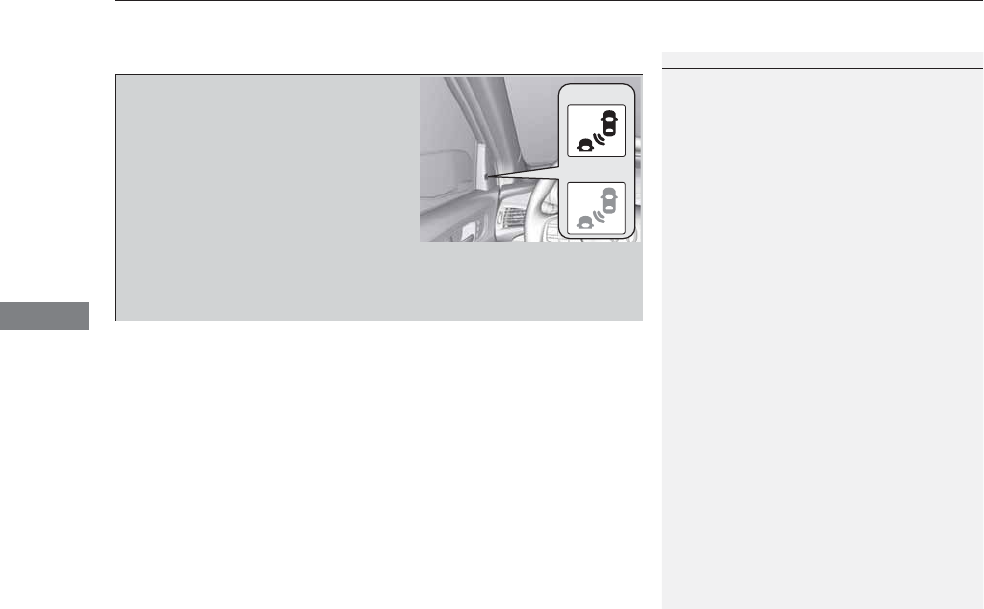
uuWhen DrivinguBlind Spot Information (BSI) System*
362
Driving
■When the system detects a vehicle
1Blind Spot Information (BSI) System*
You can change the setting for BSI.
2Customizable Features P. 107
Turn the system off when towing a trailer.
The system may not work properly for the following
reasons:
•The added mass tilts the vehicle and changes the
radar coverage.
•The trailer itself can be detected by the radar
sensors, causing the BSI alert indicators to come on.
BSI may be adversely affected when:
•Objects (guard rails, poles, trees, etc,.) are
detected.
•An object that does not reflect radio waves well,
such as a motorcycle, is in the alert zone.
•Driving on a curved road.
•A vehicle is moving from a far lane to the adjacent
lane.
•The system picks up external electrical interference.
•The rear bumper or the sensors have been improperly
repaired or the rear bumper has been deformed.
•The orientation of the sensors has been changed.
•In bad weather (Heavy rain, snow, and fog).
For proper BSI use:
•Always keep the rear bumper corner area clean.
•Do not cover the rear bumper corner area with
labels or stickers of any kind.
•Take your vehicle to a dealer if you need the rear
bumper corner area or the radar sensors to be repaired,
or the rear bumper corner area is strongly impacted.
■Comes on when
●A vehicle enters the alert zone from behind
to overtake you with a speed difference of
no more than 31 mph (50 km/h) from your
vehicle.
●You pass a vehicle with a speed difference
of no more than 12 mph (20 km/h).
BSI Alert Indicator: Located near the outside
rearview mirror on both sides.
■Blinks and the beeper sounds when
You move the turn signal lever in the direction
of the detected vehicle. The beeper sounds
three times.
Comes On
Blinks
* Not available on all models
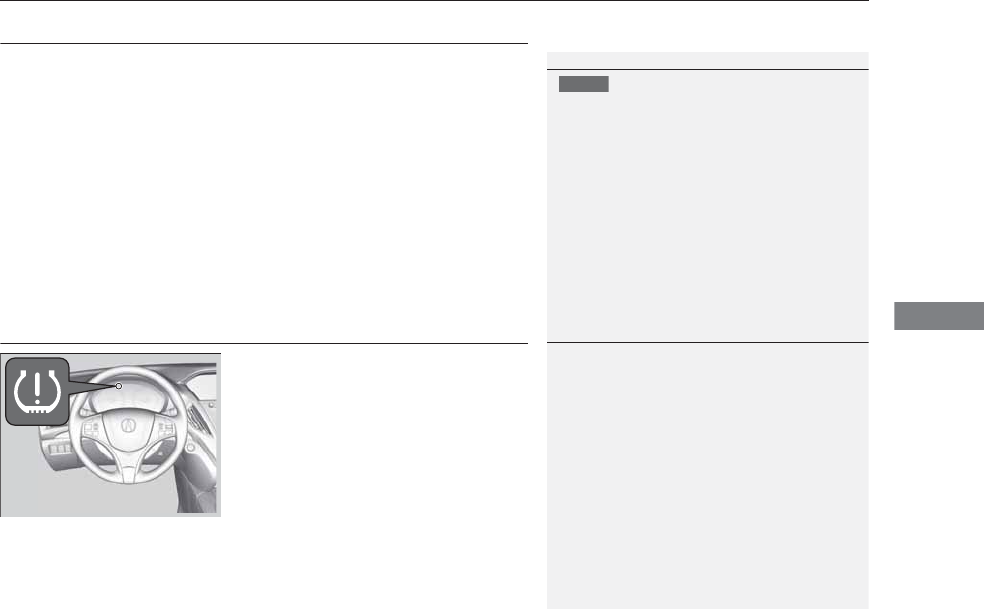
363
uuWhen DrivinguSuper Handling-All Wheel DriveTM (SH-AWD®)*
Continued
Driving
Super Handling-All Wheel DriveTM (SH-AWD®)*
The system controls and transfers varying amounts of engine torque to each wheel
in accordance with the driving conditions.
SH-AWD® helps to enhance driving stability, and lets you handle situations like
slippery surfaces, such as snow, sand, mud, and steep hills, better than when driving
with two wheel drive. However, the system does not help to enhance braking. Be
precautious about the following:
•It is still your responsibility to drive safely when you steer, accelerate, and apply
brakes.
•Leave a sufficient margin when braking on slippery surfaces.
Tire Pressure Monitoring System (TPMS)
Monitors the tire pressure while you are
driving. If your vehicle’s tire pressure becomes
significantly low, the low tire pressure/TPMS
indicator comes on and a message appears on
the MID.
1Super Handling-All Wheel DriveTM (SH-AWD®)*
NOTICE
Avoid continuously driving in sand or mud where a
wheel is likely to spin out, and do not drive once the
SH-AWD® indicator starts blinking. Driving
continuously under such conditions can damage the
system’s torque distribution unit.
Do not drive through deep water.
The SH-AWD® system may not function properly if
tire type and size are mixed.
Make sure to use the same size and type of tire, and
the air pressures as specified.
2Tire and Wheel Replacement P. 423
1Tire Pressure Monitoring System (TPMS)
Conditions such as low ambient temperature and
altitude change directly affect tire pressure and can
trigger the low tire pressure/TPMS indicator to come
on.
2If the Low Tire Pressure/TPMS Indicator
Comes On or Blinks P. 468
Tire pressure checked and inflated in:
•Warm weather can become under-inflated in
colder weather.
•Cold weather can become over-inflated in warmer
weather.
The low tire pressure/TPMS indicator will not come
on as a result of over inflation.
* Not available on all models
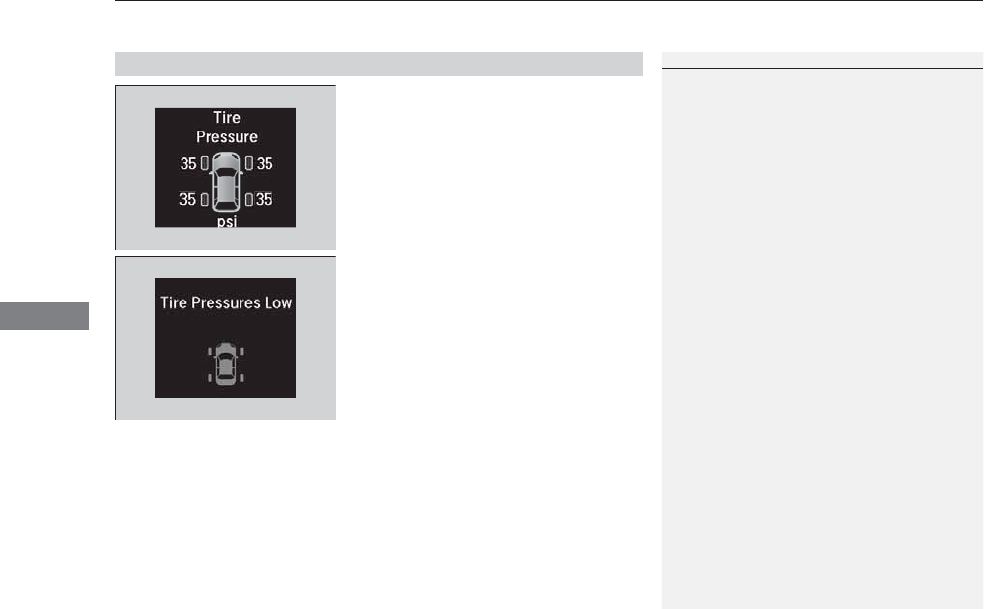
uuWhen DrivinguTire Pressure Monitoring System (TPMS)
364
Driving
To select the tire pressure monitor, set the power
mode to ON, and roll the multi-function
steering-wheel controls until you see the tire
pressure screen.
The pressure for each tire is displayed in psi
(U.S.) or kPa (Canada).
Tire Pressures Low is displayed when a tire
has significantly low pressure. The specific tire
is displayed on the screen.
■Tire Pressure Monitor
1Tire Pressure Monitor
The pressure displayed on the MID can be slightly
different from the actual pressure as measured by a
gauge. If there is a significant difference between the
two values, or if the low tire pressure/TPMS indicator
and the message on the MID do not go off after you
have inflated the tire to the specified pressure, have
the system checked by a dealer.
Tire Pressure Monitor Problem may appear if you
drive with the compact spare tire, or there is a
problem with the TPMS.
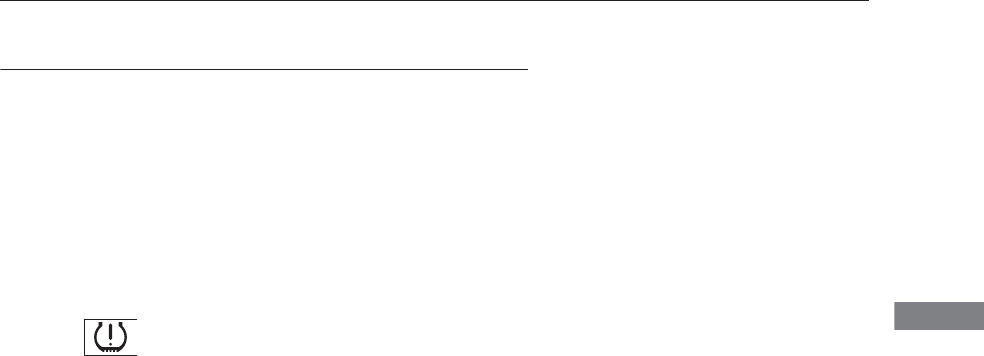
365
uuWhen DrivinguTire Pressure Monitoring System (TPMS) - Required Federal Explanation
Continued
Driving
Tire Pressure Monitoring System (TPMS) - Required
Federal Explanation
Each tire, including the spare (if provided), should be checked
monthly when cold and inflated to the inflation pressure
recommended by the vehicle manufacturer on the vehicle placard
or tire inflation pressure label.
(If your vehicle has tires of a different size than the size indicated
on the vehicle placard or tire inflation pressure label, you should
determine the proper tire inflation pressure for those tires.)
As an added safety feature, your vehicle has been equipped with
a tire pressure monitoring system (TPMS) that illuminates a low
tire pressure telltale
when one or more of your tires is significantly under-inflated.
Accordingly, when the low tire pressure telltale illuminates, you
should stop and check your tires as soon as possible, and inflate
them to the proper pressure.
Driving on a significantly under-inflated tire causes the tire to
overheat and can lead to tire failure. Under-inflation also reduces
fuel efficiency and tire tread life, and may affect the vehicle’s
handling and stopping ability.

366
uuWhen DrivinguTire Pressure Monitoring System (TPMS) - Required Federal Explanation
Driving
Please note that the TPMS is not a substitute for proper tire
maintenance, and it is the driver’s responsibility to maintain
correct tire pressure, even if under-inflation has not reached the
level to trigger illumination of the TPMS low tire pressure telltale.
Your vehicle has also been equipped with a TPMS malfunction
indicator to indicate when the system is not operating properly.
The TPMS malfunction indicator is combined with the low tire
pressure telltale. When the system detects a malfunction, the
telltale will flash for approximately one minute and then remain
continuously illuminated. This sequence will continue upon
subsequent vehicle start-ups as long as the malfunction exists.
When the malfunction indicator is illuminated, the system may
not be able to detect or signal low tire pressure as intended.
TPMS malfunctions may occur for a variety of reasons, including
the installation of replacement or alternate tires or wheels on the
vehicle that prevent the TPMS from functioning properly.
Always check the TPMS malfunction telltale after replacing one or
more tires or wheels on your vehicle to ensure that the
replacement or alternate tires and wheels allow the TPMS to
continue to function properly.
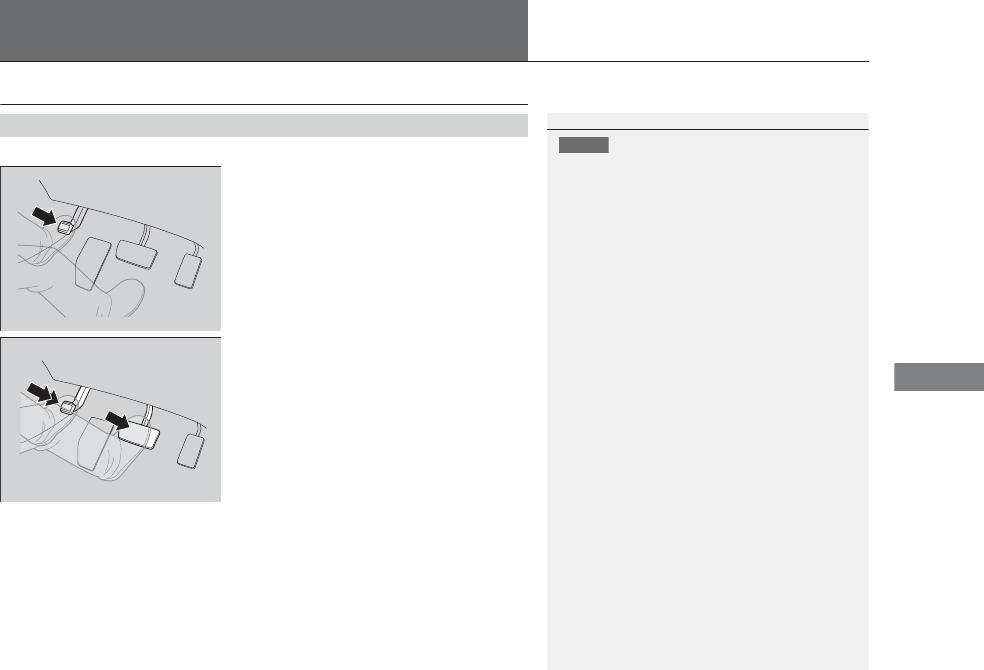
367
Continued
Driving
Braking
Brake System
Use the parking brake to keep the vehicle stationary when parking.
To apply:
Depress the parking brake pedal down with
your foot.
To release:
1. Depress the brake pedal.
2. Depress the parking brake.
■Parking Brake
1Parking Brake
NOTICE
Release the parking brake fully before driving. The
rear brakes and axle can be damaged if you drive
with the parking brake applied.
If you start driving without fully releasing the parking
brake, a buzzer sounds as a warning, and Release
Parking Brake appears on the MID.
Always apply the parking brake when parking.
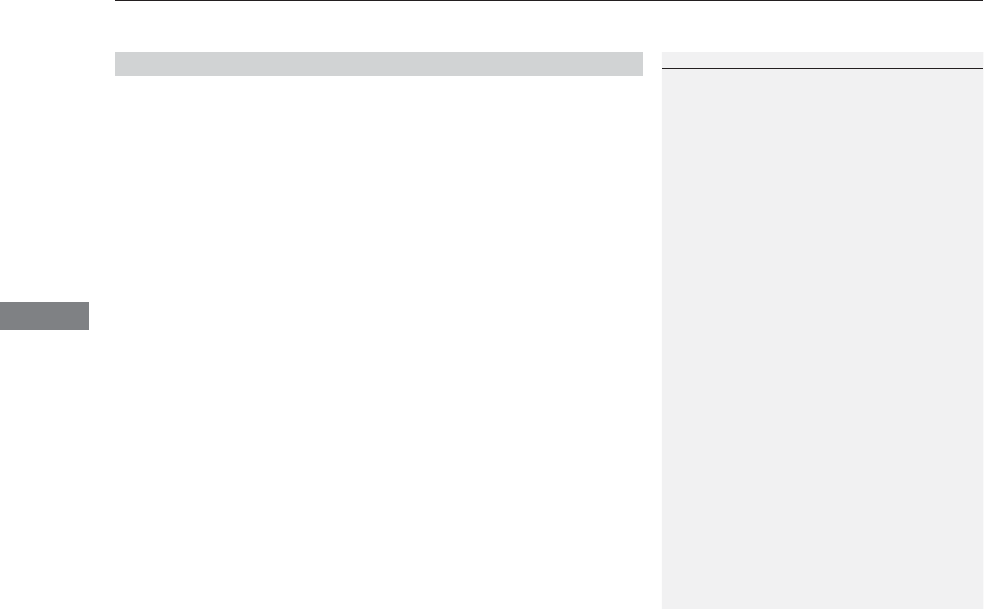
uuBrakinguBrake System
368
Driving
Your vehicle is equipped with disc brakes at all four wheels. A vacuum power assist
helps reduce the effort needed on the brake pedal. The brake assist system increases
the stopping force when you depress the brake pedal hard in an emergency
situation. The anti-lock brake system (ABS) helps you retain steering control when
braking very hard.
2Brake Assist System P. 370
2Anti-lock Brake System (ABS) P. 369
■Foot Brake
1Foot Brake
Check the brakes after driving through deep water,
or if there is a buildup of road surface water. If
necessary, dry the brakes by lightly depressing the
pedal several times.
If you hear a continuous metallic friction sound when
applying the brakes, the brake pads need to be
replaced. Have the vehicle checked by a dealer.
Constantly using the brake pedal while going down a
long hill builds up heat, which reduces the brake
effectiveness. Apply engine braking by taking your
foot off the accelerator pedal and downshifting to a
lower gear.
Do not rest your foot on the brake pedal while
driving, as it will lightly apply the brakes and cause
them to lose effectiveness over time and reduce pad
life. It will also confuse drivers behind you.
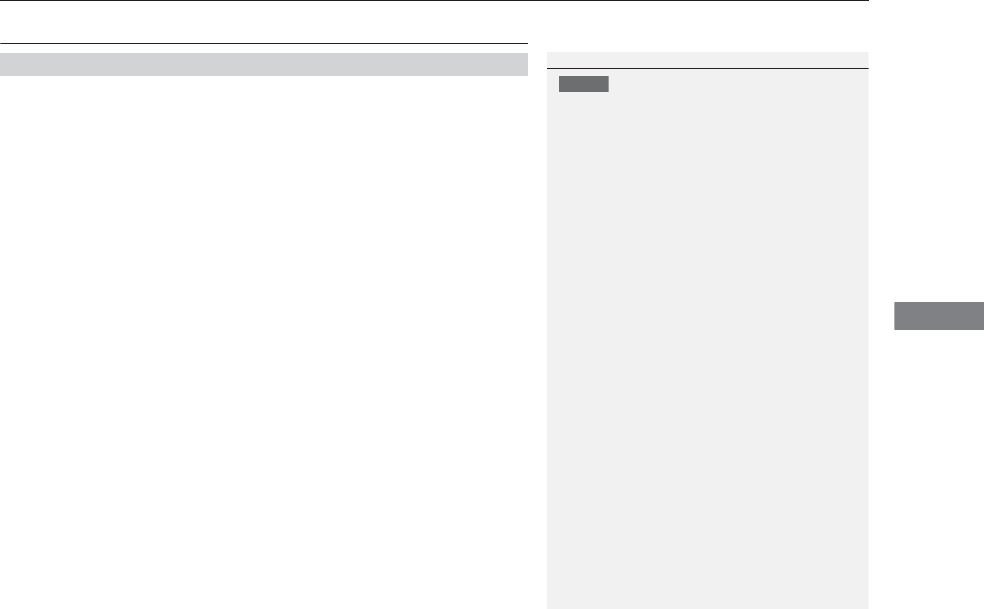
369
uuBrakinguAnti-lock Brake System (ABS)
Driving
Anti-lock Brake System (ABS)
Helps prevent the wheels from locking up, and helps you retain steering control by
pumping the brakes rapidly, much faster than you.
The electronic brake distribution (EBD) system, which is part of the ABS, also
balances the front-to-rear braking distribution according to vehicle loading.
You should never pump the brake pedal. Let the ABS work for you by always
keeping firm, steady pressure on the brake pedal. This is sometimes referred to as
“stomp and steer.”
■ABS operation
The brake pedal may pulsate slightly when the ABS is working. Keep holding the
pedal firmly down. On dry pavement, you will need to press on the brake pedal very
hard before the ABS activates. However, you may feel the ABS activate immediately
if you are trying to stop on snow or ice.
When the vehicle speed goes under 6 mph (10 km/h), the ABS stops.
■ABS
1Anti-lock Brake System (ABS)
NOTICE
The ABS may not function correctly if you use an
incorrect tire type and size.
When the ABS indicator comes on while driving,
there may be a problem with the system.
While normal braking is not affected, there is a
possibility of the ABS not operating. Have the vehicle
checked by a dealer immediately.
The ABS does not reduce the time or distance it takes
to stop the vehicle. It only helps with steering control
during hard braking.
In the following cases, your vehicle may need more
stopping distance than a vehicle without the ABS:
•When driving on rough road surfaces, including
when driving on uneven surfaces, such as gravel or
snow.
•When tire chains are installed.
You may hear a motor sound coming from the
engine compartment while system checks are being
performed immediately after starting the engine or
while driving. This is normal.

370
uuBrakinguBrake Assist System
Driving
Brake Assist System
Designed to assist the driver by generating greater braking force when you depress
the brake pedal hard during emergency braking.
■Brake assist system operation
Press the brake pedal firmly for more powerful braking.
When brake assist operates, the pedal may wiggle slightly and an operating noise
may be heard. This is normal. Keep holding the brake pedal firmly down.
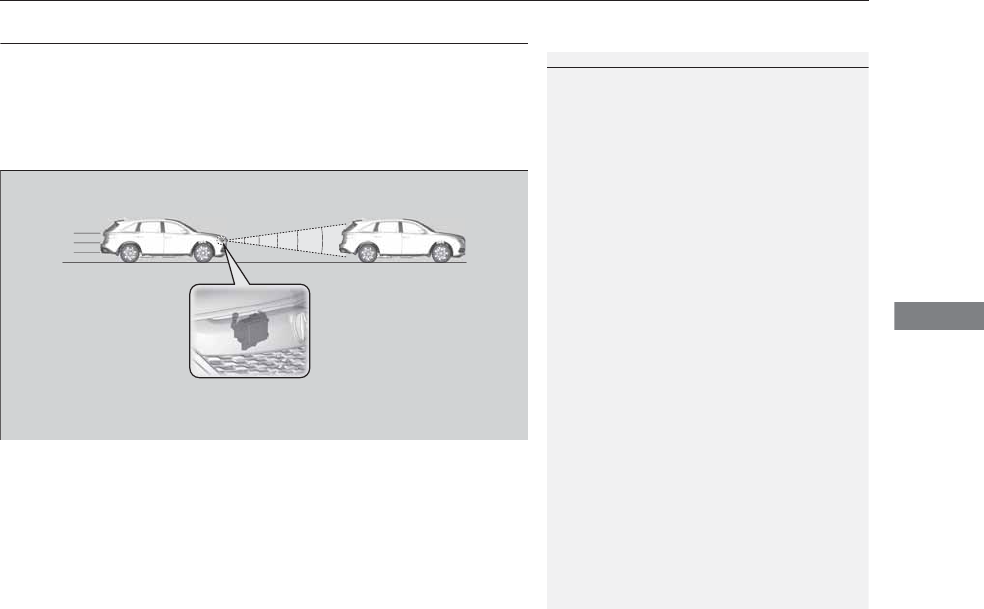
371
uuBrakinguCollision Mitigation Braking SystemTM (CMBSTM)*
Continued
Driving
Collision Mitigation Braking SystemTM (CMBSTM)*
Can assist you when there is a possibility of your vehicle colliding with a vehicle
detected in front of yours. The CMBSTM is designed to alert you when a potential
collision is determined, as well as to reduce your vehicle speed when a collision is
deemed unavoidable to help minimize collision severity.
■How the system works
1Collision Mitigation Braking SystemTM (CMBSTM)*
Important Safety Reminder
The CMBSTM is designed to reduce the severity of an
unavoidable collision. It does not prevent a collision
nor stop the vehicle automatically. It is still your
responsibility to operate the brake pedal and steering
wheel appropriately according to the driving
conditions.
The CMBSTM may not activate or may not detect a
vehicle in front of your vehicle under the following
conditions:
•The distance between your vehicle and the vehicle
ahead of you is too short.
•A vehicle cuts in front of you at a slow speed, and
it brakes suddenly.
•When you accelerate rapidly and approach the
vehicle ahead of you at high speed.
•The vehicle ahead of you is a motorcycle or other
small vehicle.
•A vehicle suddenly crosses in front of you.
•When you drive on a curved or winding road that
makes it difficult for the sensor to properly detect a
vehicle in front of you.
•When there are pedestrians or animals in front of
your vehicle.
A radar sensor starts to monitor if there is a vehicle in front of you when your
vehicle speed is above 10 mph (15 km/h).
The radar sensor is
in the front grille.
The CMBSTM activates when the speed difference between your vehicle and a
vehicle detected in front of you becomes more than 10 mph (15 km/h) with a
chance of a collision.
* Not available on all models
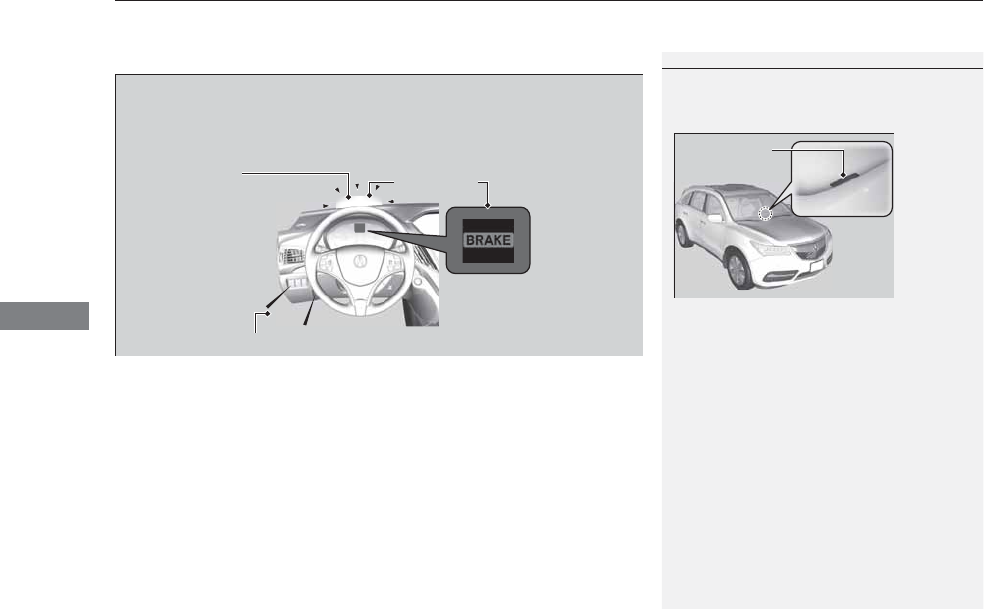
uuBrakinguCollision Mitigation Braking SystemTM (CMBSTM)*
372
Driving
■When the system activates
1When the system activates
The heads-up warning uses a lens located at the front
end of the dashboard.
Do not cover the lens or spill any liquid on it.
Lens
The system provides visual and audible alerts of a possible collision, and stops
the alerts if the collision is avoided.
uTake appropriate action to prevent a collision (apply the brakes, change
lanes, etc.)
Beep
Heads-up
Warning
Lights
Visual Alerts
Audible Alert
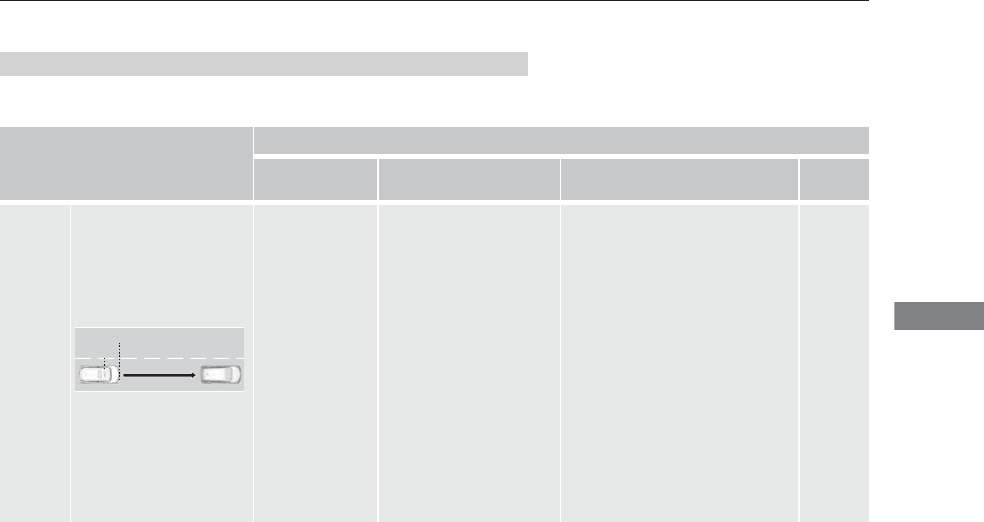
373
uuBrakinguCollision Mitigation Braking SystemTM (CMBSTM)*
Continued
Driving
The system has three alert stages for a possible collision. However, depending on the circumstances, the CMBSTM may not go through all
of the stages before initiating the last stage.
■Collision Alert Stages
Distance between vehicles
CMBSTM
The radar sensor
detects a vehicle E-pretensioner Audible & Visual WARNINGS Braking
Stage
one
There is a risk of a
collision with the
vehicle ahead of
you.
—
You can change the distance
between vehicles at which visual
alerts will display (Long/Normal/
Short).
2Customizable Features P. 107
When your setting is:
●Long: Visual alerts flash twice at
Long distance. When the Short
distance is reached, visual and
audible alerts are provided.
●Normal: Visual alerts flash twice
at the Normal distance. When
the Short distance is reached,
visual and audible alerts are
provided.
●Short: Visual and audible alerts
are provided immediately.
—
Your Vehicle
Vehicle
Ahead
Normal
ShortLong
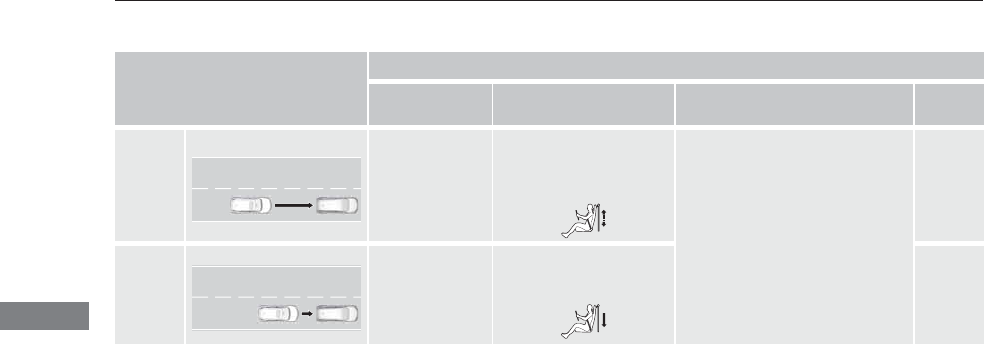
374
uuBrakinguCollision Mitigation Braking SystemTM (CMBSTM)*
Driving
Stage
two
The risk of a
collision has
increased, time to
respond is
reduced.
Retracts the driver’s seat
belt gently a few times,
providing a physical
warning.
Visual and audible alerts.
Lightly
applied
Stage
three
The CMBSTM
determines that a
collision is
unavoidable.
Forcefully tightens driver
and front passenger seat
belts. Forcefully
applied
Distance between vehicles
CMBSTM
The radar sensor
detects a vehicle E-pretensioner Audible & Visual WARNINGS Braking
Your
Vehicle
Vehicle
Ahead
Your
Vehicle
Vehicle
Ahead
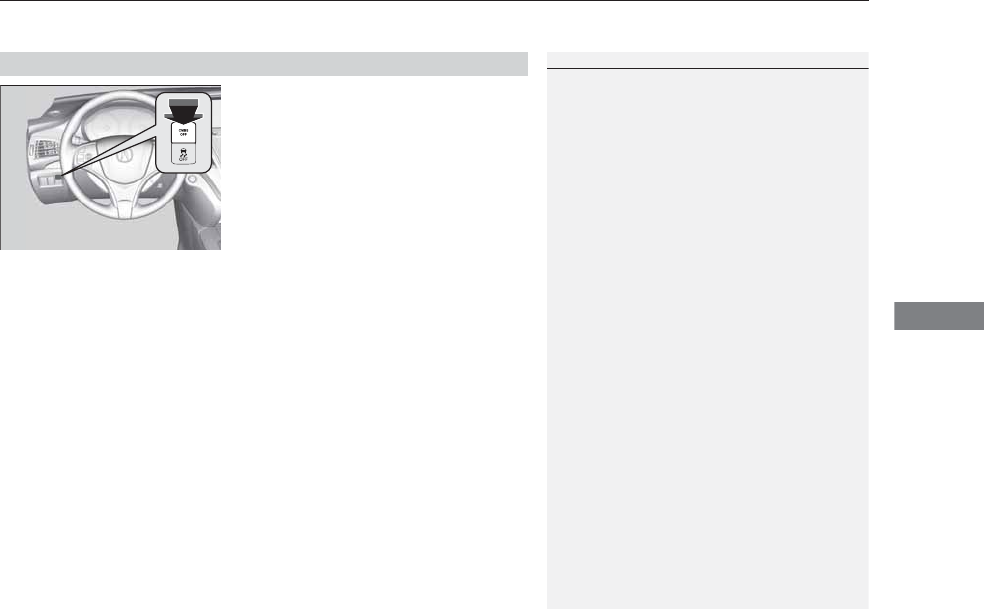
Continued 375
uuBrakinguCollision Mitigation Braking SystemTM (CMBSTM)*
Driving
Press this button for about one second to turn
on and off the system.
When the CMBSTM is off:
•The beeper sounds.
•The CMBSTM indicator in the instrument
panel comes on.
•A message on the MID reminds you that the
system is off.
The CMBSTM is in the previously selected ON or
OFF setting each time you start the engine.
■CMBSTM On and Off
1Collision Mitigation Braking SystemTM (CMBSTM)*
The CMBSTM may automatically shut off, and the
CMBSTM indicator will come and stay on when:
•You drive off-road or on a mountain road for an
extended period.
•You drive with the parking brake applied.
•You drive in bad weather (rain, fog, snow, etc.)
•The radar sensor cover is blocked by dirt, mud, dry
leaves, wet snow, etc.
•An abnormal tire condition is detected (wrong tire
size, flat tire, etc.)
Once the conditions that caused the CMBSTM to shut
off improve, the system comes back on.
* Not available on all models
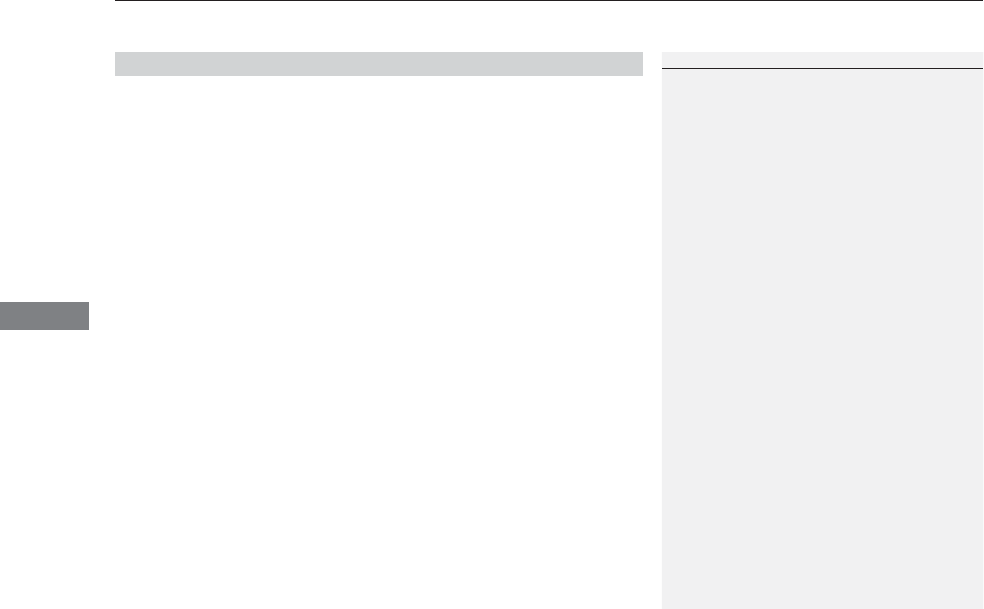
uuBrakinguCollision Mitigation Braking SystemTM (CMBSTM)*
376
Driving
The CMBSTM may activate even when you are aware of a vehicle ahead of you, or
when there is no vehicle ahead. Some examples of this are:
■When Passing
Your vehicle approaches another vehicle ahead of you and you change lanes to pass.
■At an intersection
Your vehicle approaches or passes another vehicle that is making a left or right turn.
■Through a low bridge at high speed
You drive under a low or narrow bridge at high speed.
■Speed bumps, road work sites, train tracks, roadside objects, etc.
You drive over speed bumps, steel road plates, etc., or your vehicle approaches train
tracks or roadside objects [such as a traffic sign and guard rail] on a curve.
■With Little Chance of a Collision
1Collision Mitigation Braking SystemTM (CMBSTM)*
Avoid the following conditions that may cause the
radar aim to be temporarily out of range and prevent
the CMBSTM from working properly.
•A heavy load in the rear or modifications to the
suspension tilts your vehicle.
•The tire pressures are not correct, the tire sizes are
incorrect, the tire types are different, and/or the
tires are not in good condition.
For the CMBSTM to work properly:
•Always keep the radar sensor cover clean.
•Never use chemical solvents or polishing powder
for cleaning the sensor cover. Clean it with water
or a mild detergent.
Do not put a sticker on the emblem or replace the
emblem.
Take your vehicle to a dealer if you need the radar
sensor to be repaired, or removed, or the radar
sensor cover is strongly impacted.
* Not available on all models
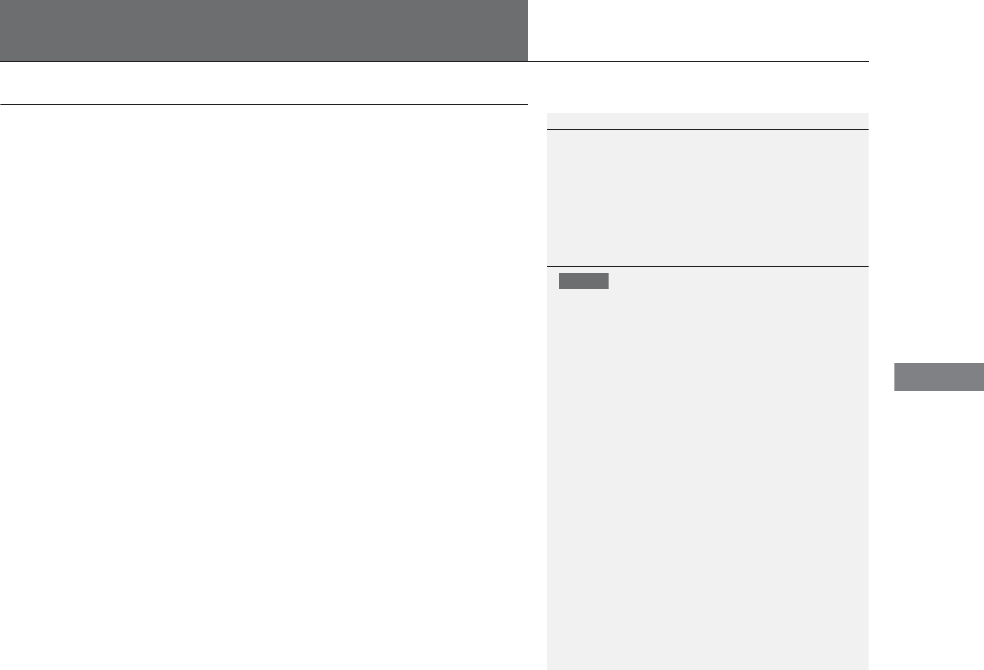
377
Driving
Parking Your Vehicle
When Stopped
1. Depress the brake pedal firmly with the shift lever in (D.
2. Firmly apply the parking brake.
3. Move the shift lever from (D to (P.
4. Turn off the engine.
Always set the parking brake firmly, in particular if you are parked on an incline.
1Parking Your Vehicle
Do not park your vehicle near flammable objects,
such as dry grass, oil, or timber.
Heat from the exhaust can cause a fire.
Raise the wiper arms when snow is expected.
1When Stopped
NOTICE
The following can damage the transmission:
•Depressing the accelerator and brake pedals
simultaneously.
•Holding the vehicle in place when facing uphill by
depressing the accelerator pedal.
•Moving the shift lever into (P before the vehicle
stops completely.
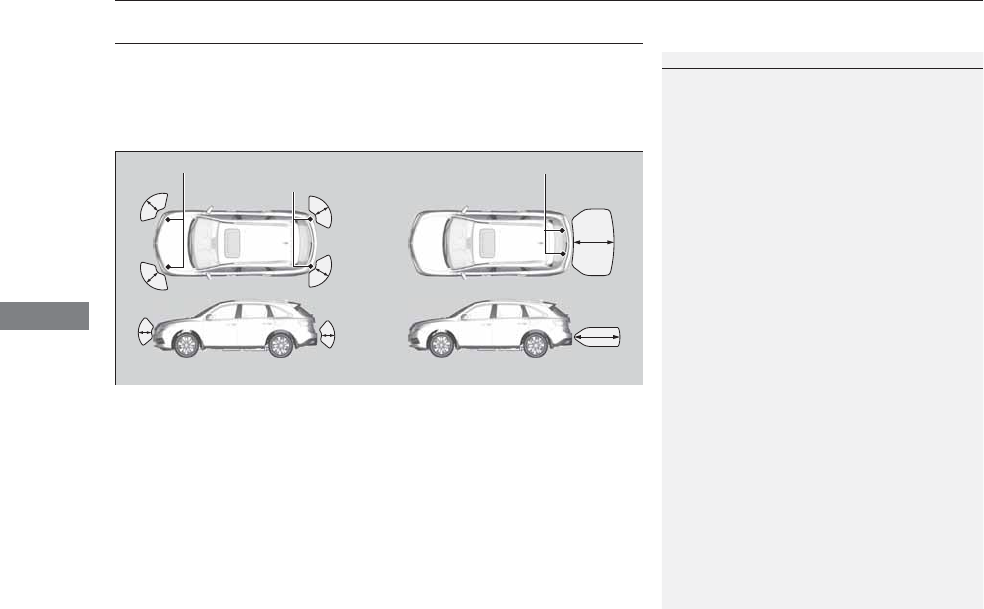
378
uuParking Your VehicleuParking Sensor System*
Driving
Parking Sensor System*
The corner and center sensors monitor obstacles near your vehicle. The beeper and
audio/information screen let you know the approximate distance between your
vehicle and the obstacle.
■The sensor location and range
1Parking Sensor System*
Even when the system is on, always confirm if there is
no obstacle near your vehicle before parking.
The system may not work properly when:
•The sensors are covered with snow, ice, mud or
dirt, etc.
•The vehicle is on uneven surface, such as grass,
bumpy road, or a hill.
•The vehicle has been out in hot or cold weather.
•The system is affected by some electronic devices
that generate ultrasonic waves.
•Driving in bad weather.
The system may not sense:
•Thin or low objects.
•Sonic-absorptive materials, such as snow, cotton,
or sponge.
•Objects directly under the bumper.
Do not put any accessories on or around the sensors.
Within about 24 in (60 cm) or less
Front Corner Sensors
Rear Corner Sensors
Rear Center Sensors
Within about 43 in (110 cm) or less
* Not available on all models
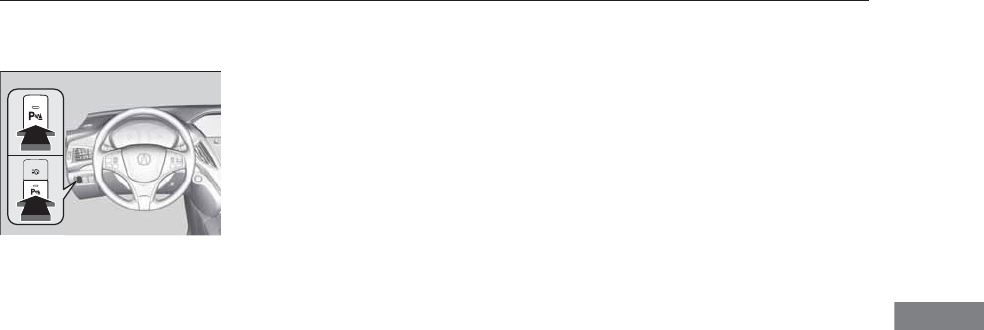
379
uuParking Your VehicleuParking Sensor System*
Continued
Driving
■Parking sensor system on and off
With the power mode in ON, press the
parking sensor system button to turn on or off
the system. The indicator in the button comes
on and the beeper sounds when the system is
on.
The rear center and corner sensors start to
detect an obstacle when the shift lever is in
(R, and the vehicle speed is less than 5 mph
(8 km/h).
The front corner sensors start to detect an
obstacle when the shift lever is in any position
other than (P, and the vehicle speed is less
than 5 mph (8 km/h).
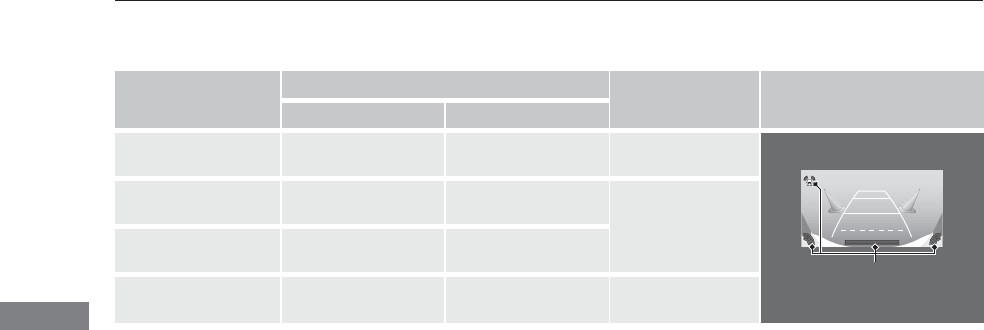
380
uuParking Your VehicleuParking Sensor System*
Driving
■When the distance between your vehicle and obstacles behind becomes shorter
*1: At this stage, only the center sensors detect obstacles.
Length of the
intermittent beep
Distance between the Bumper and Obstacle
Indicator Audio/information screen
Corner Sensors Center Sensors
Moderate —Rear: About 43-24 in
(110-60 cm) Blinks in Yellow*1
Short About 24-18 in
(60-45 cm)
About 24-18 in
(60-45 cm)
Blinks in Amber
Very short About 18-14 in
(45-35 cm)
About 18-14 in
(45-35 cm)
Continuous About 14 in
(35 cm) or less
About 14 in
(35 cm) or less Blinks in Red
Indicators light where the
sensor detects an obstacle
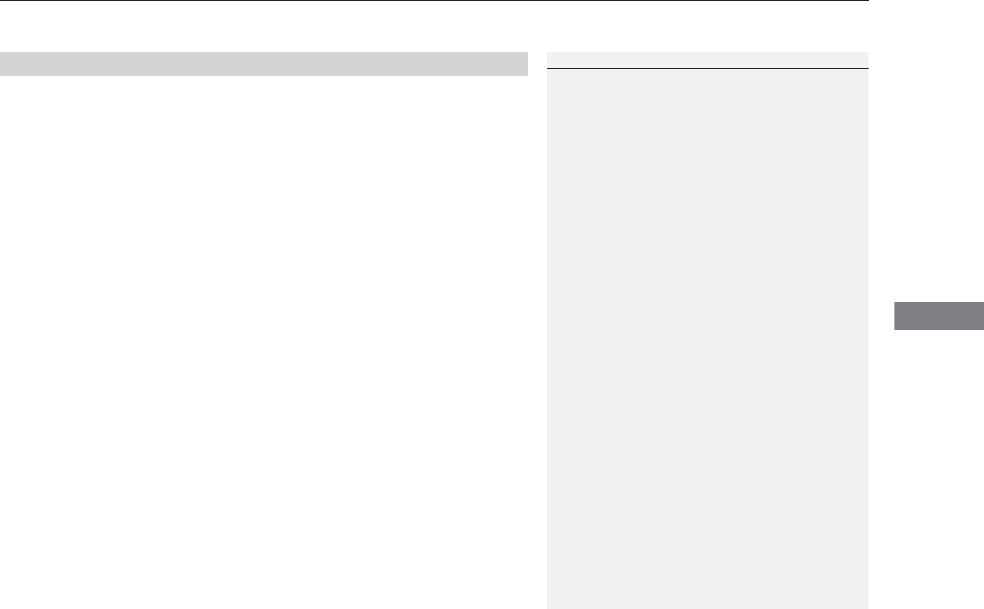
381
uuParking Your VehicleuParking Sensor System*
Driving
1. Make sure that the parking sensor system is not activated. Set the power mode to
VEHICLE OFF (LOCK).
2. Press and hold the parking sensor system button, and set the power mode to ON.
3. Keep pressing the button for 10 seconds. Release the button when the indicator
in the button flashes.
4. Press the button again. The indicator in the button goes off.
uThe beeper sounds twice. The rear sensors are now turned off.
To turn the rear sensors on again, follow the above procedure. The beeper sounds
three times when the rear sensors come back on.
■Turning off All Rear Sensors
1Turning off All Rear Sensors
When you shift to (R, the indicator in the parking
sensor system button blinks as a reminder that the
rear sensors have been turned off.
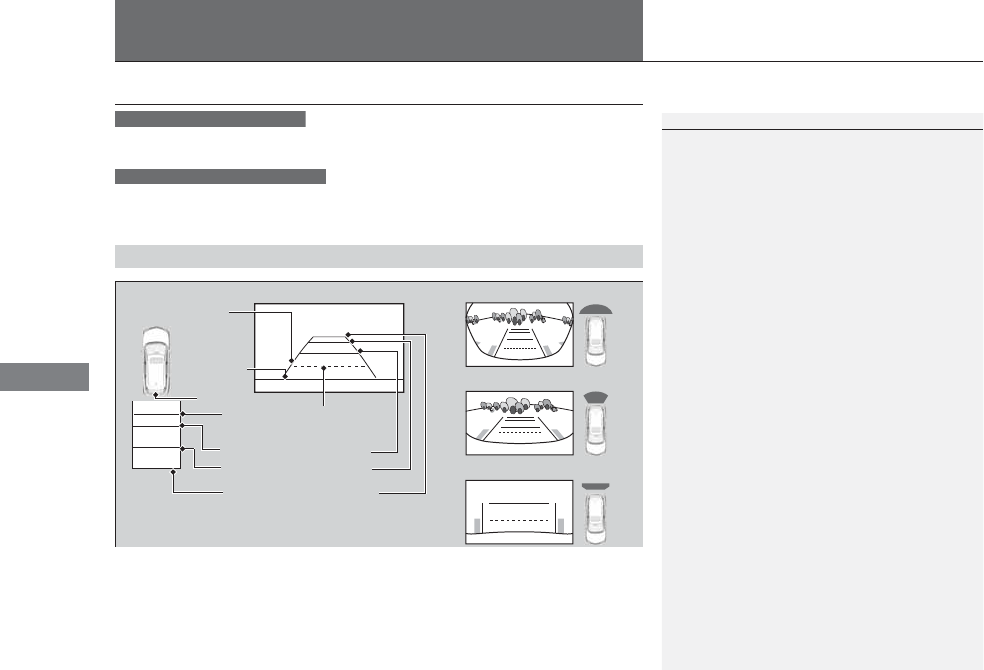
382
Driving
Multi-View Rear Camera*
About Your Multi-View Rear Camera
For models with navigation system, see Navigation System Manual.
The audio/information screen can display your vehicle’s rear view. The display
automatically changes to a rear view when the shift lever is moved to (R.
You can view three different camera angles on the rearview display. Press the
selector knob to switch the angle.
If the last used viewing mode is Wide or Normal, the same mode is selected the next
time you shift into (R. If Top view was last used, Wide mode is selected.
■Multi-View Rear Camera Display Area
1About Your Multi-View Rear Camera
The rear camera view is restricted. You cannot see
the corner ends of the bumper or what is underneath
the bumper. Its unique lens also makes objects
appear closer or farther than they actually are.
Visually confirm that it is safe to drive before backing
up. Certain conditions (such as weather, lighting, and
high temperatures) may also restrict the rear view. Do
not rely on the rearview display which does not give
you all information about conditions at the back of
your vehicle.
If the camera lens is covered with dirt or moisture,
use a soft, moist cloth to keep the lens clean and free
of debris.
Models with navigation system
Models without navigation system
Guidelines
Bumper
Camera
Approx. 20 inches (50 cm)
Tailgate Open Range
Approx. 39 inches (1 m)
Approx. 79 inches (2 m)
Approx. 118 inches (3 m)
Wide View Mode
Normal View Mode
Top Down View Mode
* Not available on all models
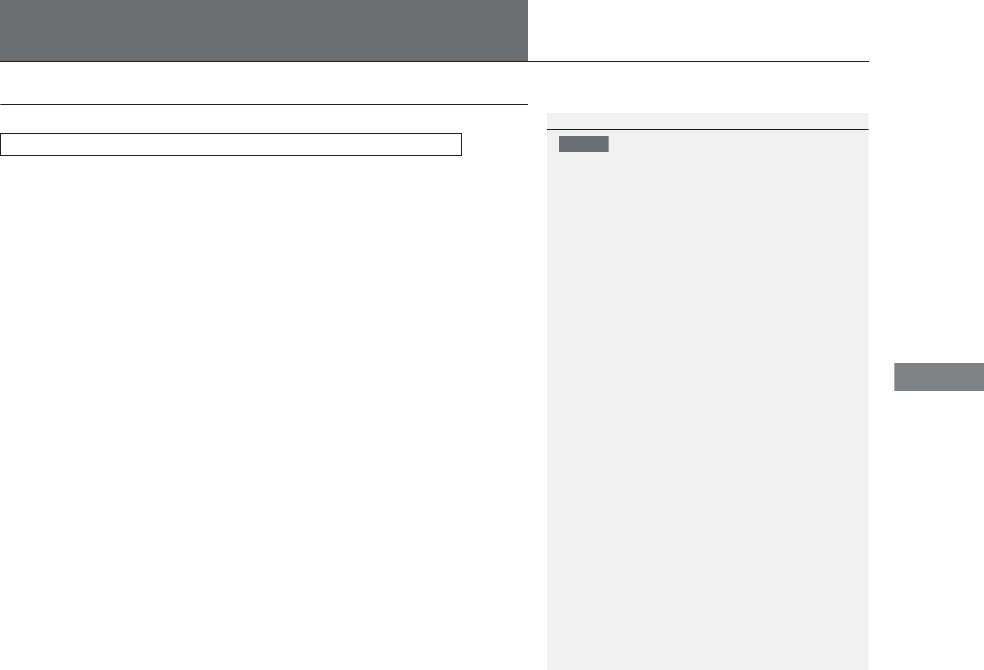
383
Driving
Refueling
Fuel Information
■Fuel recommendation
Use of lower octane gasoline can cause occasional metallic knocking noise in the
engine and will result in decreased engine performance.
Use of gasoline with a pump octane less than 87 can lead to engine damage.
■Top tier detergent gasoline
Because the level of detergency and additives in gasoline vary in the market, Acura
endorses the use of “TOP TIER Detergent Gasoline” where available to help
maintain the performance and reliability of your vehicle. TOP TIER Detergent
Gasoline meets a new gasoline standard jointly established by leading automotive
manufacturers to meet the needs of today’s advanced engines.
Qualifying gasoline retailers will, in most cases, identify their gasoline as having met
“TOP TIER Detergent Gasoline” standards at the retail location. This fuel is
guaranteed to contain the proper level of detergent additives and be free of metallic
additives. The proper level of detergent additives, and absence of harmful metallic
additives in gasoline, help avoid build-up of deposits in your engine and emission
control system.
For further important fuel-related information for your vehicle, or on information on
gasoline that does not contain MMT, visit Acura Owners at owners.acura.com In
Canada, visit www.acura.ca for additional information on gasoline. For more
information on top tier gasoline, visit www.toptiergas.com.
■Fuel tank capacity: 19.5 US gal (74 liters)
Unleaded premium gasoline, pump octane number 91 or higher
1Fuel Information
NOTICE
We recommend quality gasoline containing
detergent additives that help prevent fuel system and
engine deposits. In addition, in order to maintain
good performance, fuel economy, and emissions
control, we strongly recommend the use of gasoline
that does NOT contain harmful manganese-based
fuel additives such as MMT, if such gasoline is
available.
Use of gasoline with these additives may adversely
affect performance, and cause the malfunction
indicator lamp on your instrument panel to come on.
If this happens, contact a dealer for service. Some
gasoline today is blended with oxygenates such as
ethanol. Your vehicle is designed to operate on
oxygenated gasoline containing up to 15% ethanol
by volume. Do not use gasoline containing methanol.
If you notice any undesirable operating symptoms, try
another service station or switch to another brand of
gasoline.
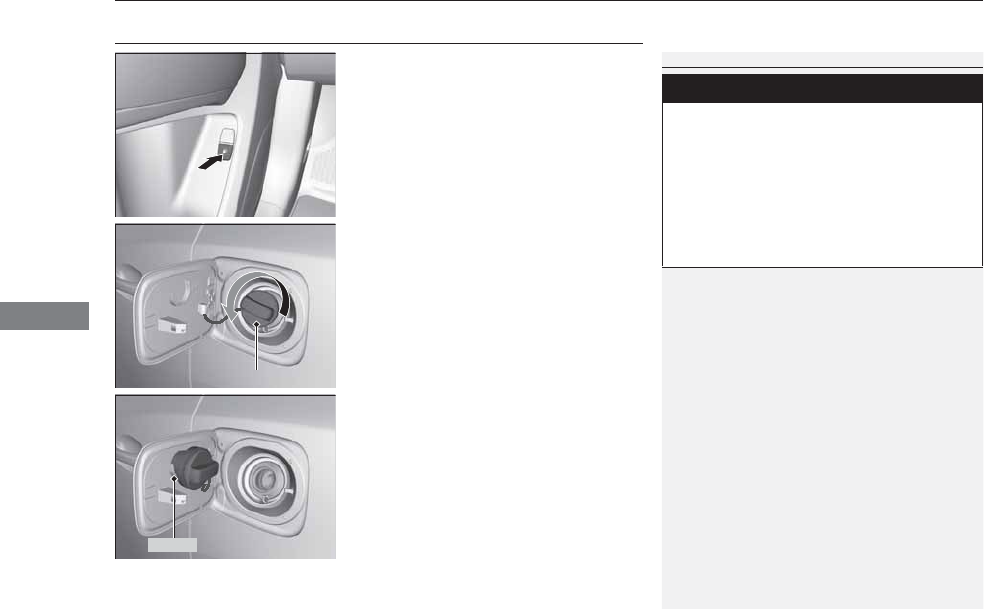
384
uuRefuelinguHow to Refuel
Driving
How to Refuel
1. Stop your vehicle with the service station
pump on the left side of the vehicle in the
rear.
2. Turn off the engine.
3. Press the fuel fill door release button.
uThe fuel fill door opens.
4. Remove the fuel fill cap slowly. If you hear a
release of air, wait until this stops, then turn
the knob slowly to open the fuel fill cap.
5. Place the fuel fill cap in the holder.
6. Insert the filler nozzle fully.
uWhen the tank is full, the filler nozzle will
click off automatically. This leaves space
in the fuel tank in case the fuel expands
with a change in the temperature.
7. After filling, replace the fuel fill cap,
tightening it until you hear it click at least
once.
uShut the fuel fill door by hand.
1How to Refuel
The filler nozzle automatically stops to leave space in
the fuel tank so that fuel does not overflow as a result
of changes in air temperature.
If the fuel filler nozzle keeps turning off when the
tank is not full, there may be a problem with the
pump’s fuel vapor recovery system. Try filling at
another pump. If this does not fix the problem,
consult a dealer.
Do not continue to add fuel after the nozzle has
automatically stopped. Additional fuel can exceed
the full tank capacity.
3
WARNING
Gasoline is highly flammable and explosive.
You can be burned or seriously injured
when handling fuel.
•Stop the engine, and keep heat, sparks,
and flame away.
•Handle fuel only outdoors.
•Wipe up spills immediately.
Press
Cap
Holder
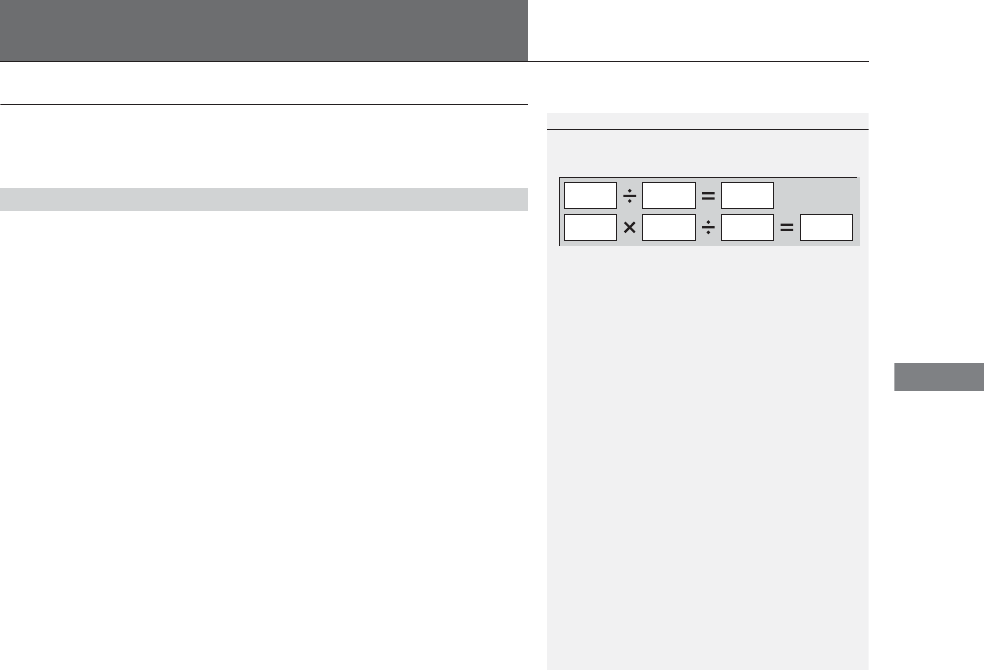
385
Driving
Fuel Economy
Improving Fuel Economy
Fuel economy depends on several conditions, including driving conditions, your
driving habits, the condition of your vehicle, and loading. Depending on these and
other conditions, you may or may not achieve the rated fuel economy of this vehicle.
You can optimize your fuel economy with proper maintenance of your vehicle.
Always maintain your vehicle in accordance with the messages displayed on the
MID.
•Use the recommended viscosity engine oil, displaying the API Certification Seal.
•Maintain the specified tire pressure.
•Do not load the vehicle with excess cargo.
•Keep your vehicle clean. A buildup of snow or mud on your vehicle’s underside
adds weight and increases wind resistance.
■Maintenance and Fuel Economy
1Improving Fuel Economy
Direct calculation is the recommended method to
determine actual fuel consumed while driving.
In Canada, posted fuel economy numbers are
established following a simulated test. For more
information on how this test is performed, please visit
http://oee.nrcan.gc.ca/
Miles driven Gallons of
fuel
Miles per
Gallon
100 Liter Kilometers L per 100 km
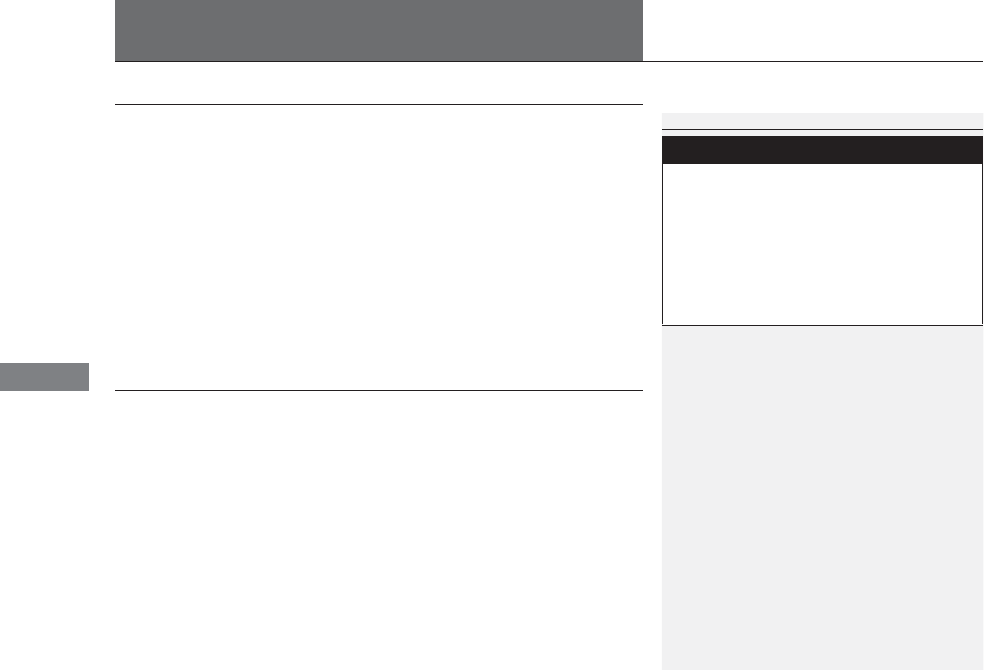
386
Driving
Accessories and Modifications
Accessories
When installing accessories, check the following:
•Do not install accessories on the windshield. They can obstruct your view and
delay your reaction to driving conditions.
•Do not install any accessories over areas marked SRS Airbag, on the sides or backs
of the front seats, on front or side pillars, or near the side windows. Accessories
installed in these areas may interfere with proper operation of the vehicle’s
airbags or may be propelled into you or another occupant if the airbags deploy.
•Be sure electronic accessories do not overload electrical circuits or interfere with
proper operation of your vehicle.
2Fuses P. 469
•Before installing any electronic accessory, have the installer contact a dealer for
assistance. If possible, have a dealer inspect the final installation.
Modifications
Do not modify your vehicle or use non-Acura components that can affect its
handling, stability, and reliability.
Overall vehicle performance can be affected. Always make sure all equipment is
properly installed and maintained, and that it meets federal, state, province,
territory, and local regulations.
1Accessories and Modifications
Acura Genuine accessories are recommended to
ensure proper operation on your vehicle.
3
WARNING
Improper accessories or modifications can
affect your vehicle’s handling, stability, and
performance, and cause a crash in which
you can be seriously hurt or killed.
Follow all instructions in this owner’s
manual regarding accessories and
modifications.
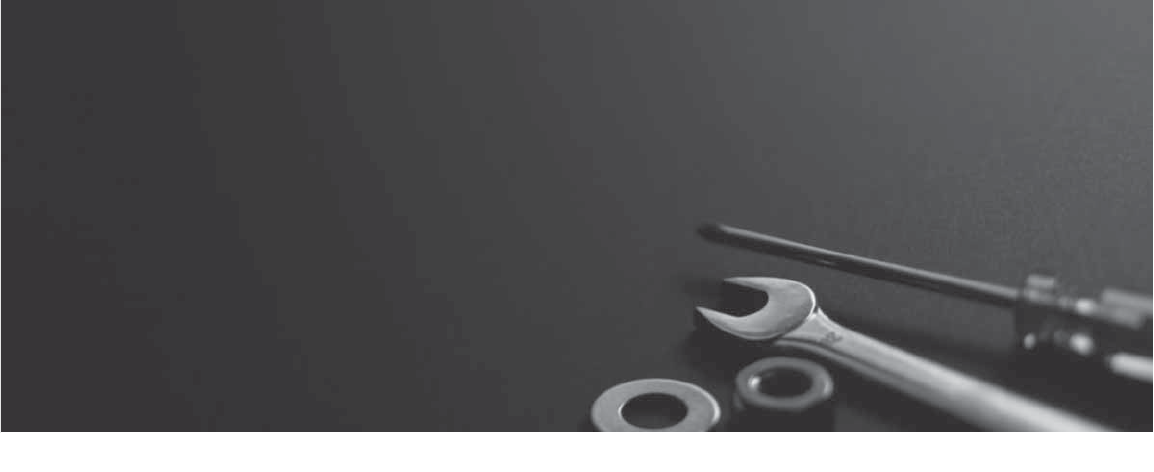
387
Maintenance
This chapter discusses basic maintenance.
Before Performing Maintenance
Inspection and Maintenance ............ 388
Safety When Performing Maintenance..389
Parts and Fluids Used in Maintenance
Service ........................................... 390
Maintenance MinderTM ..................... 391
Maintenance Under the Hood
Maintenance Items Under the Hood.. 395
Opening the Hood ........................... 396
Engine Compartment Cover............. 397
Recommended Engine Oil ................ 398
Oil Check.........................................399
Adding Engine Oil............................400
Changing the Engine Oil and Oil Filter... 401
Engine Coolant................................ 403
Transmission Fluid............................ 405
Brake Fluid....................................... 406
Refilling Window Washer Fluid......... 406
Replacing Light Bulbs....................... 407
Checking and Maintaining Wiper Blades
... 413
Checking and Maintaining Tires
Checking Tires ................................. 417
Tire and Loading Information Label .. 418
Tire Labeling .................................... 418
DOT Tire Quality Grading (U.S. Vehicles).. 420
Wear Indicators................................ 422
Tire Service Life................................ 422
Tire and Wheel Replacement ........... 423
Tire Rotation.................................... 424
Winter Tires ..................................... 425
Battery............................................... 426
Remote Transmitter Care
Replacing the Button Battery ........... 427
Remote Control and Wireless
Headphone Care*........................... 429
Climate Control System Maintenance
..431
Cleaning
Interior Care .................................... 432
Exterior Care.................................... 434
* Not available on all models
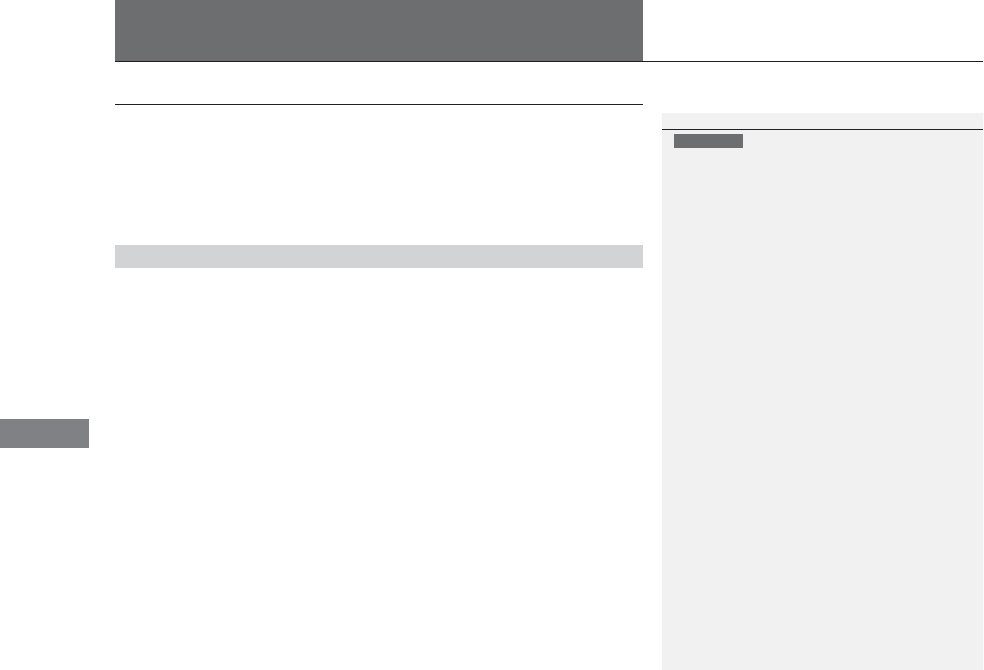
388
Maintenance
Before Performing Maintenance
Inspection and Maintenance
For your safety, perform all listed inspections and maintenance to keep your vehicle
in good condition. If you become aware of any abnormality (noise, smell, insufficient
brake fluid, oil residue on the ground, etc.), have your vehicle inspected by a dealer.
(Note, however, that service at a dealer is not mandatory to keep your warranties in
effect.) Refer to the separate maintenance booklet for detailed maintenance and
inspection information.
■Daily inspections
Perform inspections before long distance trips, when washing the vehicle, or when
refueling.
■Periodic inspections
•Check the brake fluid level monthly.
2Checking the Brake Fluid P. 406
•Check the tire pressure monthly. Examine the tread for wear and foreign objects.
2Checking and Maintaining Tires P. 417
•Check the operation of the exterior lights monthly.
2Replacing Light Bulbs P. 407
•Check the condition of the wiper blades at least every six months.
2Checking and Maintaining Wiper Blades P. 413
■Types of Inspection and Maintenance
1Inspection and Maintenance
Maintenance, replacement, or repair of
emissions control devices and systems may be
done by any automotive repair establishment or
individuals using parts that are “certified” to
EPA standards.
According to state and federal regulations, failure to
perform maintenance on the maintenance main
items marked with # will not void your emissions
warranties. However, all maintenance services should
be performed in accordance with the intervals
indicated by the multi-information display (MID).
2Maintenance Service Items P. 393
If you want to perform complex maintenance tasks
that require more skills and tools, you can purchase a
subscription to the Service Express website at
www.techinfo.honda.com.
2Authorized Manuals P. 489
If you want to perform maintenance yourself, make
sure that you have the necessary tools and skills first.
After performing maintenance, update the records in
the separate maintenance booklet.
U.S. models
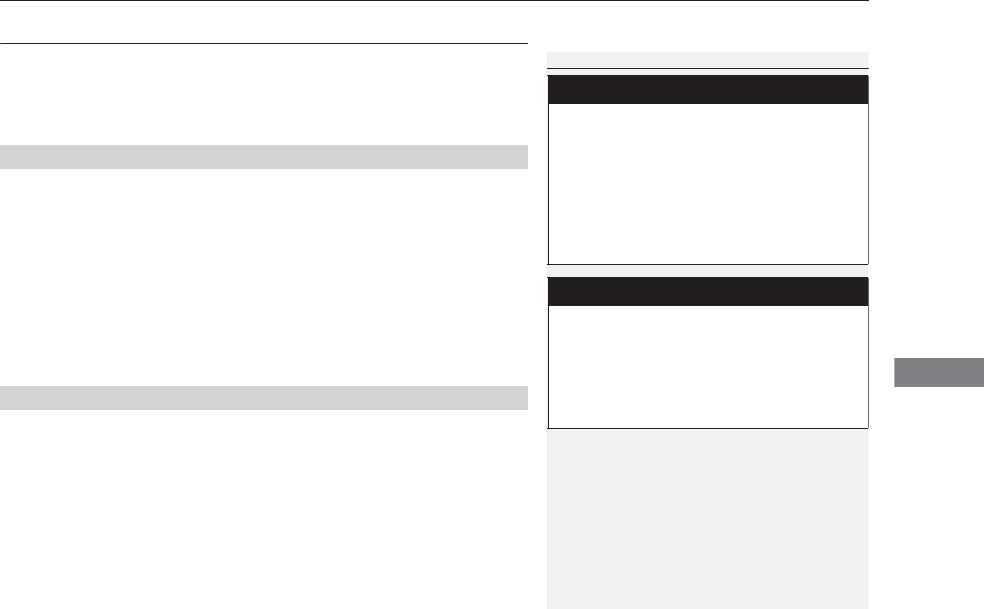
389
uuBefore Performing MaintenanceuSafety When Performing Maintenance
Maintenance
Safety When Performing Maintenance
Some of the most important safety precautions are given here.
However, we cannot warn you of every conceivable hazard that can arise in
performing maintenance. Only you can decide whether or not you should perform
a given task.
•To reduce the possibility of fire or explosion, keep cigarettes, sparks, and flames
away from the battery and all fuel related parts.
•Never leave rags, towels, or other flammable objects under the hood.
uHeat from the engine and exhaust can ignite them causing a fire.
•To clean parts, use a commercially available degreaser or parts cleaner, not
gasoline.
•Wear eye protection and protective clothing when working with the battery or
compressed air.
•Engine exhaust contains carbon monoxide, which is poisonous and can kill you.
uOnly operate the engine if there is sufficient ventilation.
•The vehicle must be in a stationary condition.
uMake sure your vehicle is parked on level ground, the parking brake is set, and
the engine is off.
•Be aware that hot parts can burn you.
uMake sure to let the engine and exhaust system cool thoroughly before
touching vehicle parts.
•Be aware that moving parts can injure you.
uDo not start the engine unless instructed, and keep your hands and limbs away
from moving parts.
■Maintenance Safety
■Vehicle Safety
1Safety When Performing Maintenance
3
WARNING
Improperly maintaining this vehicle or
failing to correct a problem before driving
can cause a crash in which you can be
seriously hurt or killed.
Always follow the inspection and
maintenance recommendations according
to the schedules in this owner’s manual.
3
WARNING
Failure to properly follow maintenance
instructions and precautions can cause you
to be seriously hurt or killed.
Always follow the procedures and
precautions in this owner’s manual.
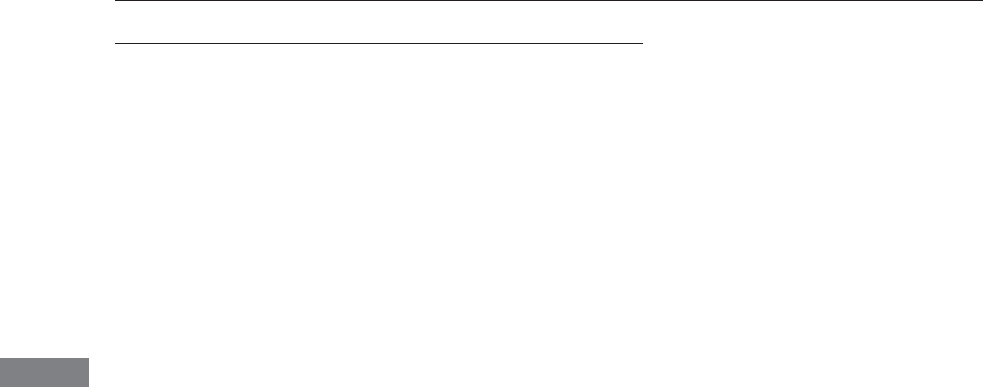
390
uuBefore Performing MaintenanceuParts and Fluids Used in Maintenance Service
Maintenance
Parts and Fluids Used in Maintenance Service
The use of Acura genuine parts and fluids is recommended when maintaining and
servicing your vehicle. Acura genuine parts are manufactured according to the same
high quality standards used in Acura vehicles.
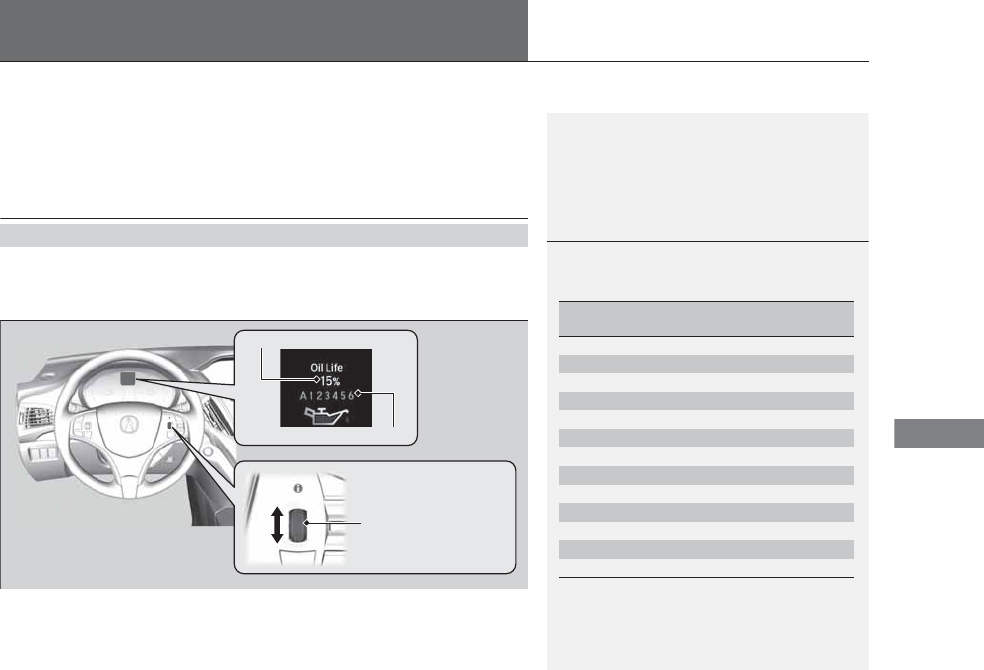
391
Continued
Maintenance
Maintenance MinderTM
Maintenance items, which should be serviced at the same time that you replace the
engine oil, appear on the MID.
You can view them on the engine oil life screen at any time.
To Use Maintenance MinderTM
1. Set the power mode to ON.
2. Roll the multi-function steering-wheel controls until the engine oil life appears on
the MID.
■Displaying the Engine Oil Life and Maintenance Items
1Displaying the Engine Oil Life and Maintenance Items
Based on the engine operating conditions, the
remaining engine oil life is calculated and displayed
as a percentage.
There is a list of maintenance main and sub items you
can view on the MID.
2Maintenance Service Items P. 393
Displayed Engine Oil
Life (%)
Calculated Engine Oil
Life (%)
100 100 to 91
90 90 to 81
80 80 to 71
70 70 to 61
60 60 to 51
50 50 to 41
40 40 to 31
30 30 to 21
20 20 to 16
15 15 to 11
10 10 to 6
55 to 1
00
Remaining Engine Oil Life
Maintenance Service Items
Multi-function
Steering-wheel
Controls
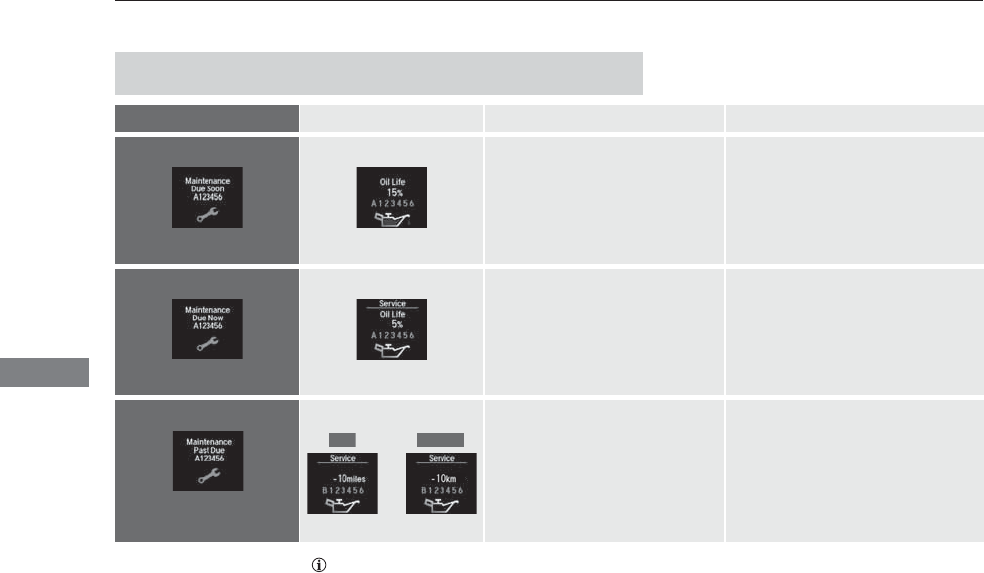
392
uuMaintenance MinderTMuTo Use Maintenance MinderTM
Maintenance
The system message indicator ( ) comes on along with the Maintenance Minder message.
■Maintenance Minder Messages on the Multi-Information
Display (MID)
Maintenance Message Oil Life Display Explanation Information
Maintenance Due Soon 15% The remaining engine oil life is 15 to
6 percent. Once you switch the
display by rolling the multi-function
steering-wheel controls, this
message will go off.
The engine oil is approaching the end
of its service life, and the maintenance
items should be inspected and serviced
soon.
Maintenance Due Now 5% The remaining engine oil life is 5 to 1
percent. Roll the multi-function
steering-wheel controls to switch to
another display.
The engine oil has almost reached the
end of its service life, and the
maintenance items should be inspected
and serviced as soon as possible.
Maintenance Past Due Negative Distance The remaining engine oil life has
passed its service life, and a negative
distance appears after driving over
10 miles (U.S. models) or 10 km
(Canadian models). Roll the multi-
function steering wheel control to
switch to another display.
The engine oil life has passed.
The maintenance items must be
inspected and serviced immediately.
U.S.
Canada
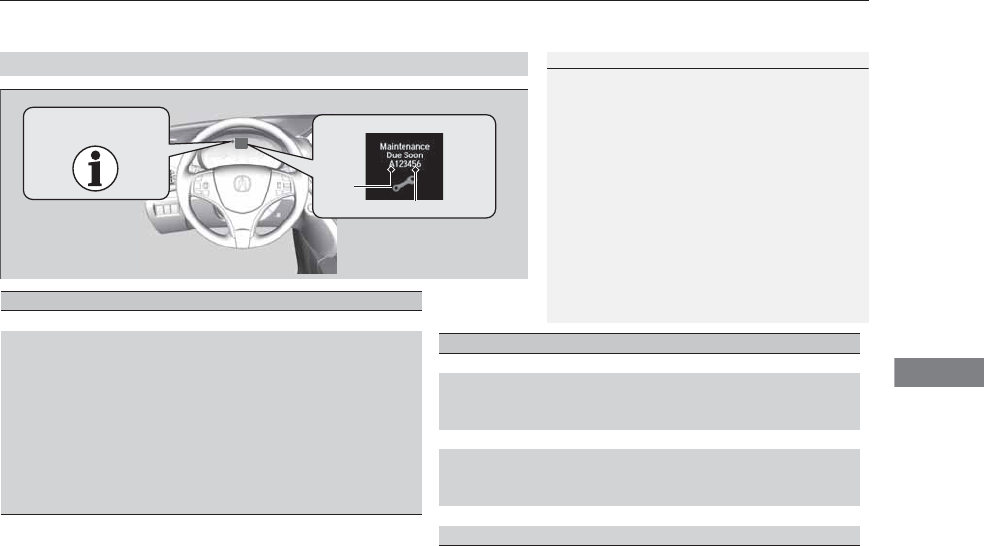
393
uuMaintenance MinderTMuTo Use Maintenance MinderTM
Continued
Maintenance
■Maintenance Service Items
1Maintenance Service Items
•Independent of the Maintenance Minder
information, replace the brake fluid every 3 years.
•Inspect idle speed every 160,000 miles (256,000
km).
•Adjust the valves during services A, B, 1, 2, or 3 if
they are noisy.
Driving in mountainous areas at very low vehicle
speeds or trailer towing results in higher level of
mechanical (Shear) stress to fluid. This requires
differential fluid changes more frequently than
recommended by the Maintenance Minder. If you
regularly drive your vehicle under these conditions,
have the differential fluid changed at 7,500 miles
(12,000km), then every 15,000 miles (24,000 km).
Maintenance Minder Message
System Message
Indicator
Sub Items
Main
Item
*1: If the message SERVICE does not appear more than 12 months after the display is reset, change the
engine oil every year.
# : See information on maintenance and emissions warranty.
*2: If you drive in dusty conditions, replace the air cleaner element every 15,000 miles (24,000 km).
*3: If you drive primarily in urban areas that have high concentrations of soot in the air from industry and
from diesel-powered vehicles, replace the dust and pollen filter every 15,000 miles (24,000 km).
CODE Maintenance Main Items
A●Replace engine oil*1
B●Replace engine oil*1 and oil filter
●Inspect front and rear brakes, service as necessary
●Check parking brake adjustment
●Inspect tie rod ends, steering gearbox, and boots
●Inspect suspension components
●Inspect driveshaft boots
●Inspect brake hoses and lines (Including ABS/VSA)
●Inspect all fluid levels and condition of fluids
●Inspect exhaust system#
●Inspect fuel lines and connections#
*4: If you drive regularly in very high temperatures (over 110°F, 43°C), in very low temperatures (under
-20°F, -29°C), or tow a trailer, replace every 60,000 miles/100,000 km.
CODE Maintenance Sub Items
1●Rotate tires
2●Replace air cleaner element*2
●Replace dust and pollen filter*3
●Inspect drive belt
3●Replace transmission and transfer fluid*
4●Replace spark plugs
●Replace timing belt and inspect water pump*4
●Inspect valve clearance
5●Replace engine coolant
6●Replace rear differential fluid*
* Not available on all models
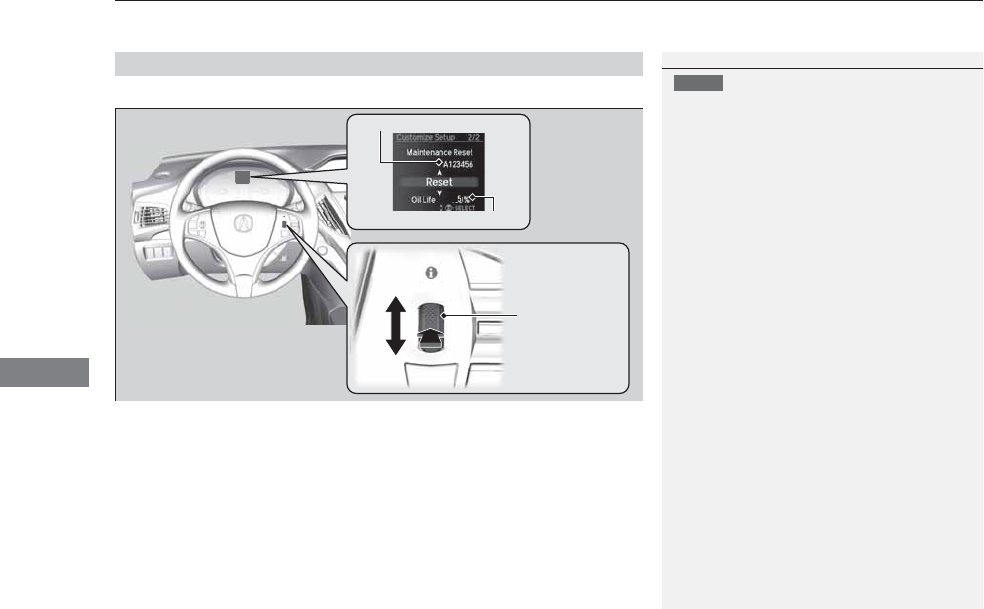
uuMaintenance MinderTMuTo Use Maintenance MinderTM
394
Maintenance
Reset the engine oil life display if you have performed the maintenance service.
1. Set the power mode to ON.
2. Go to the Maintenance Info. group.
2Customized Features P. 104
3. Push the multi-function steering-wheel controls.
uThe oil life reset mode is displayed on the MID.
4. Select Reset with the multi-function steering-wheel controls, then push the
multi-function steering wheel control.
uThe displayed maintenance items disappear, and the engine oil life display
returns to 100%.
uTo cancel the oil life reset mode, select Cancel, then push the multi-function
steering-wheel controls.
■Resetting the Display
1Resetting the Display
NOTICE
Failure to reset the engine oil life after a maintenance
service results in the system showing incorrect
maintenance intervals, which can lead to serious
mechanical problems.
The dealer will reset the engine oil life display after
completing the required maintenance service. If
someone other than a dealer performs maintenance
service, reset the engine oil life display yourself.
Remaining Engine Oil Life
Maintenance Service Items
Multi-function
Steering-wheel
Controls
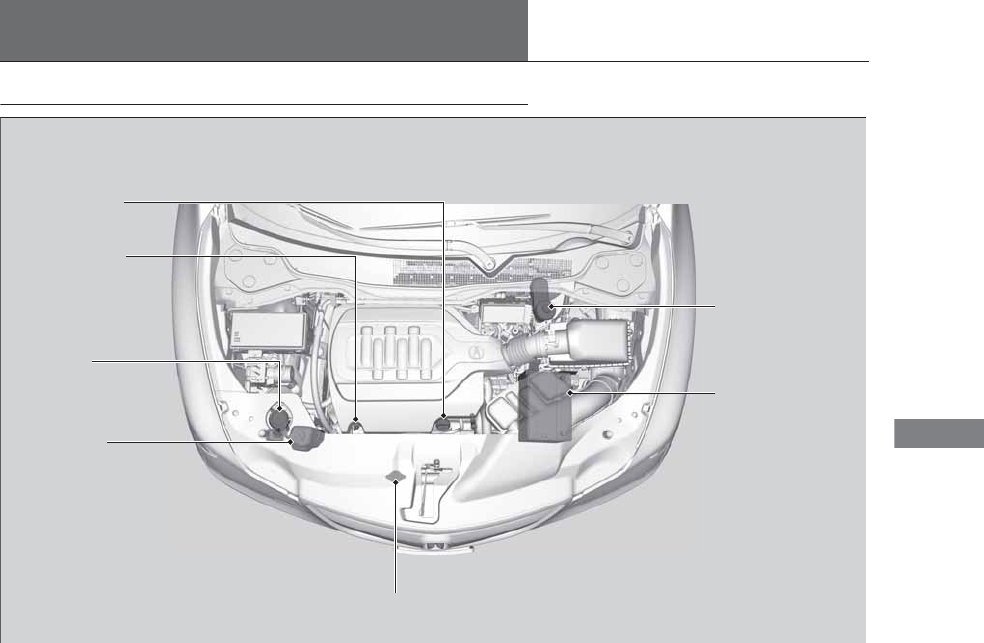
395
Maintenance
Maintenance Under the Hood
Maintenance Items Under the Hood
Brake Fluid
(Black Cap)
Washer Fluid
(Blue Cap)
Radiator Cap
Engine Coolant
Reservoir
Engine Oil Dipstick
(Orange Loop)
Engine Oil Fill Cap
Battery
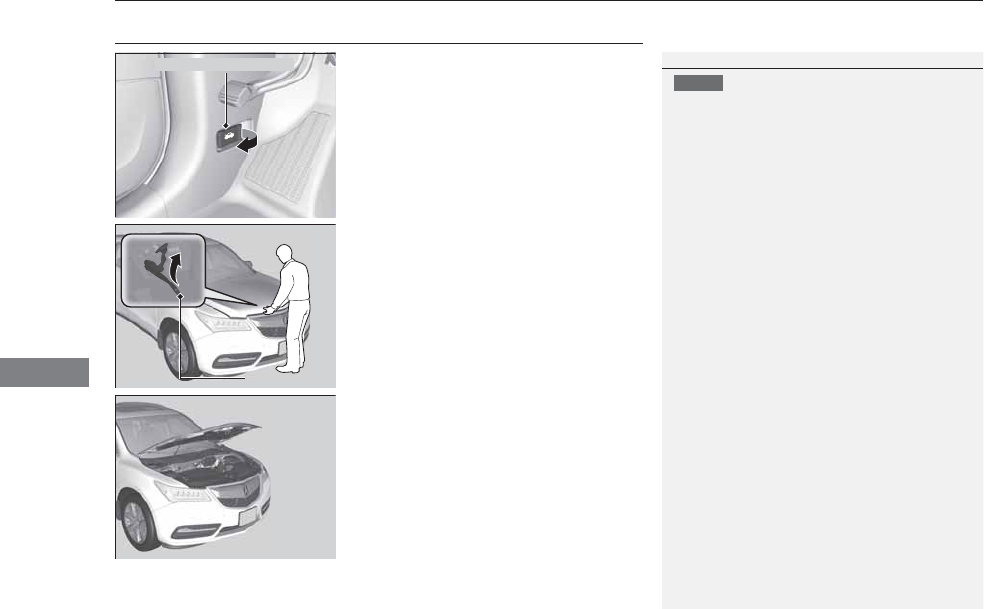
396
uuMaintenance Under the HooduOpening the Hood
Maintenance
Opening the Hood
1. Park the vehicle on a level surface, and set
the parking brake.
2. Pull the hood release handle under the
lower left corner of the dashboard.
uThe hood will pop up slightly.
3. Push up the hood latch lever in the center
of the hood to release the lock mechanism,
and open the hood.
4. Lift the hood up most of the way.
uThe hydraulic supports will lift it up the
rest of the way and hold it up.
When closing, lower it to approximately 12
inches (30 cm), then press down firmly with
your hands.
1Opening the Hood
NOTICE
Do not open the hood when the wiper arms are
raised.
The hood will strike the wipers, and may damage
either the hood or the wipers.
When closing the hood, check that the hood is
securely latched.
If the hood latch lever moves stiffly, or if you can
open the hood without lifting the lever, the latch
mechanism should be cleaned and lubricated.
Hood Release Handle
Pull
Lever
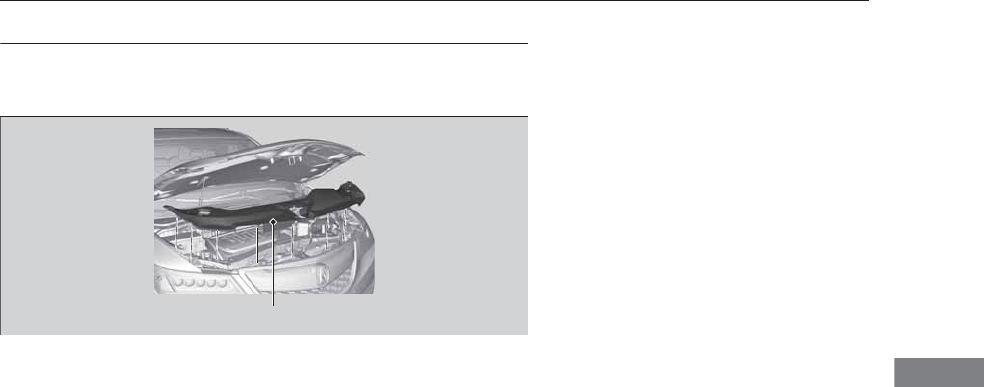
397
uuMaintenance Under the HooduEngine Compartment Cover
Maintenance
Engine Compartment Cover
The component parts in the engine compartment are protected by a cover.
You may need to remove the cover when you perform certain maintenance work.
To remove the cover:
Remove the Engine Compartment Cover
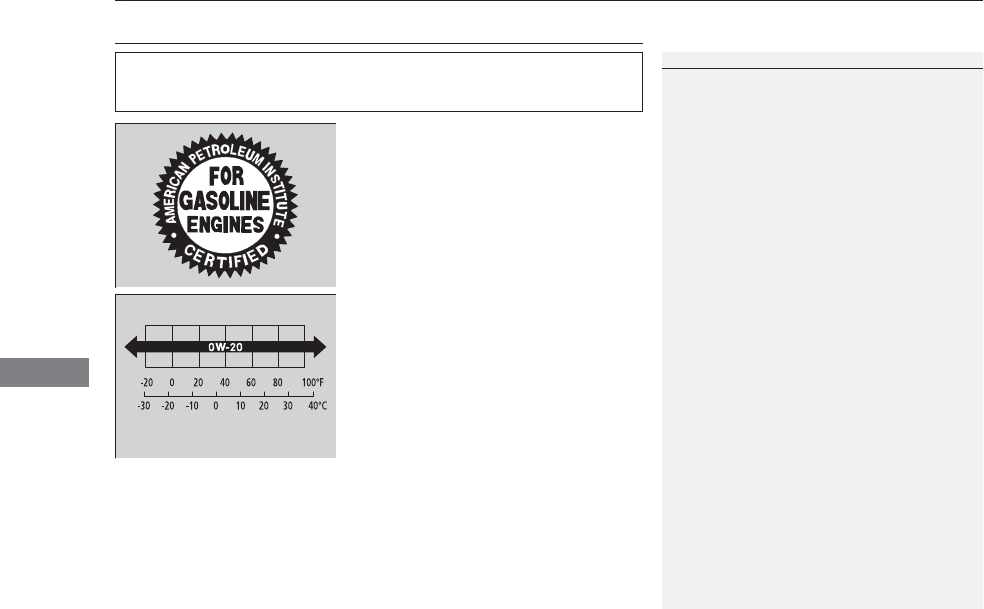
398
uuMaintenance Under the HooduRecommended Engine Oil
Maintenance
Recommended Engine Oil
Oil is a major contributor to your engine’s
performance and longevity. If you drive the
vehicle with insufficient or deteriorated oil,
the engine may fail or be damaged.
This seal indicates the oil is energy conserving
and that it meets the American Petroleum
Institute’s latest requirements.
Use a Genuine Acura Motor Oil or another
commercial engine oil of suitable viscosity for
the ambient temperature as shown.
■Synthetic oil
You may also use synthetic motor oil if it is labeled with the API Certification Seal
and is the specified viscosity grade.
•Genuine Acura Motor Oil
•Premium-grade 0W-20 detergent oil with an API Certification Seal on the
container.
1Recommended Engine Oil
Engine Oil Additives
Your vehicle does not require oil additives. In fact,
they may adversely affect the engine performance
and durability.
Ambient Temperature
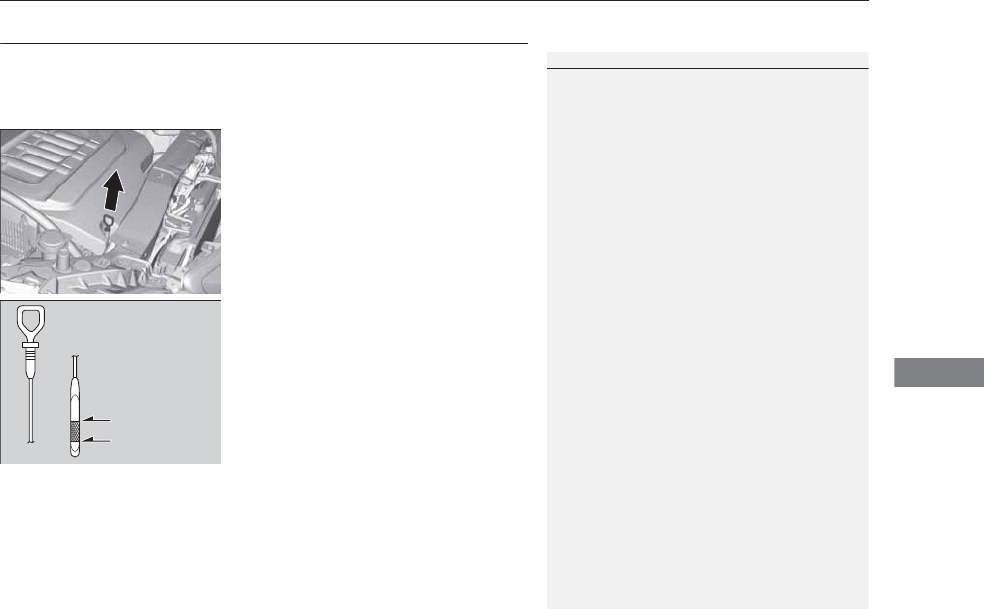
399
uuMaintenance Under the HooduOil Check
Maintenance
Oil Check
We recommend that you check the engine oil level every time you refuel.
Park the vehicle on level ground.
Wait approximately three minutes after turning the engine off before you check the
oil.
1. Remove the dipstick (orange loop).
2. Wipe the dipstick with a clean cloth or
paper towel.
3. Insert the dipstick back all the way into its
hole.
4. Remove the dipstick again, and check the
level. It should be between the upper and
lower marks. Add oil if necessary.
1Oil Check
If the oil level is near or below the lower mark, slowly
add oil being careful not to overfill.
Lower Mark
Upper Mark
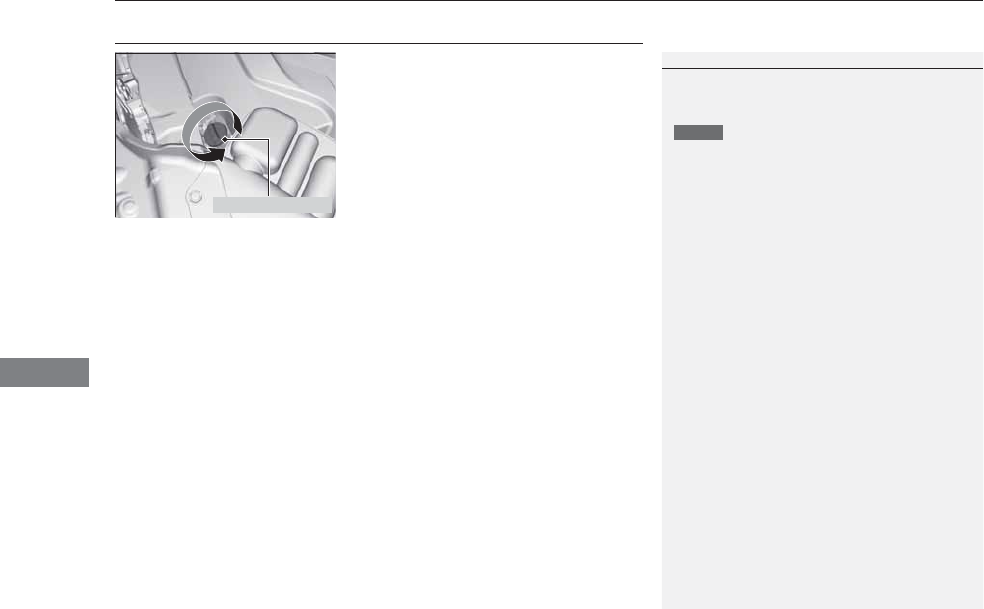
400
uuMaintenance Under the HooduAdding Engine Oil
Maintenance
Adding Engine Oil
1. Unscrew and remove the engine oil fill cap.
2. Add oil slowly.
3. Reinstall the engine oil fill cap, and tighten
it securely.
4. Wait for three minutes and recheck the
engine oil dipstick.
1Adding Engine Oil
If any oil spills, wipe it up immediately. Spilled oil may
damage the engine compartment components.
NOTICE
Do not fill the engine oil above the upper mark.
Overfilling the engine oil can result in leaks and
engine damage.
Engine Oil Fill Cap
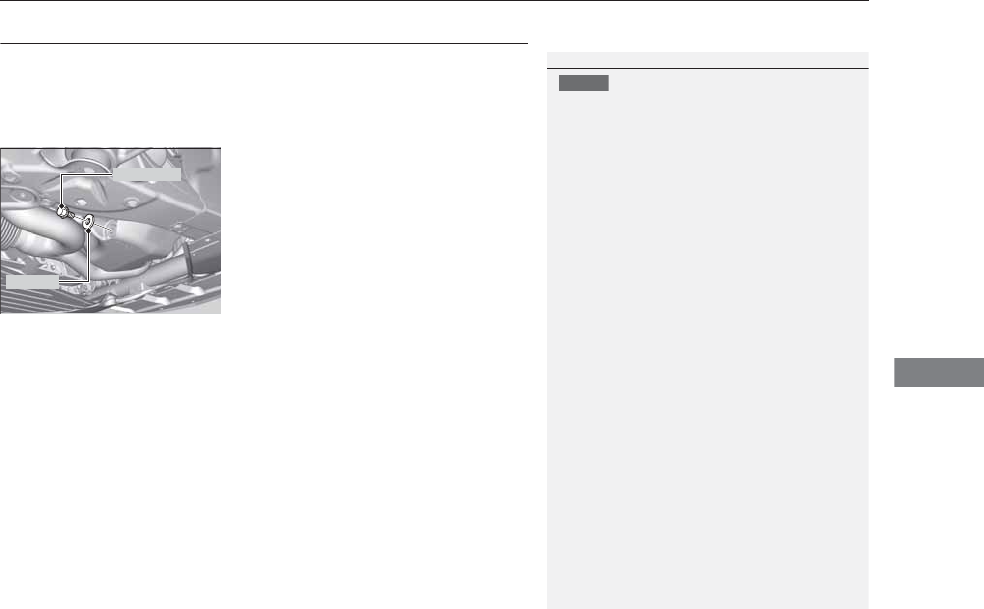
401
uuMaintenance Under the HooduChanging the Engine Oil and Oil Filter
Continued
Maintenance
Changing the Engine Oil and Oil Filter
You must change the engine oil and oil filter regularly in order to maintain the
engine’s lubrication. The engine may be damaged if they are not changed regularly.
Change the oil and filter in accordance with the maintenance message on the multi-
information display.
1. Run the engine until it reaches normal
operating temperature, and then turn the
engine off.
2. Open the hood and remove the engine oil
fill cap.
3. Remove the drain bolt and washer from
the bottom of the engine, and drain the
oil into a suitable container.
1Changing the Engine Oil and Oil Filter
NOTICE
You may damage the environment if you do not
dispose of the oil in a suitable way. If you are
changing the oil by yourself, appropriately dispose of
the used oil. Put the oil in a sealed container and take
it to a recycling center. Do not throw the oil away
into a garbage can or onto the ground.
Drain Bolt
Washer
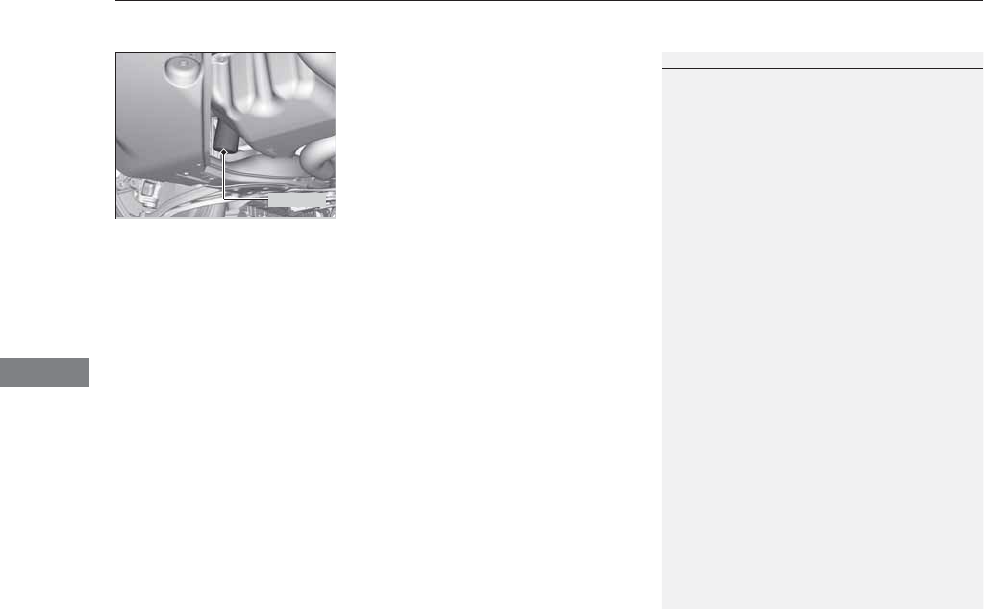
uuMaintenance Under the HooduChanging the Engine Oil and Oil Filter
402
Maintenance
4. Remove the oil filter and dispose of the
remaining oil.
5. Check that the filter gasket is not stuck to
the engine contact surface.
uIf it is stuck, you must detach it.
6. Wipe away dirt and dust adhering to the
contact surface of the oil filter base, and
install a new oil filter.
uApply a light coat of new engine oil to
the oil filter rubber seal.
7. Put a new washer on the drain bolt, then
reinstall the drain bolt.
uTightening torque:
29 lbf∙ft (39 N∙m, 4.0 kgf∙m)
8. Pour the recommended engine oil into the
engine.
uEngine oil change capacity (including
filter):
5.7 US qt (5.4 ℓ)
9. Reinstall the engine oil fill cap securely and
start the engine.
10. Run the engine for a few minutes, and
then check that there is no leak from the
drain bolt or oil filter.
11. Stop the engine, wait for three minutes,
and then check the oil level on the
dipstick.
uIf necessary, add more engine oil.
1Changing the Engine Oil and Oil Filter
You will need a special wrench to replace the oil
filter. You can buy this wrench from a dealer.
When installing the new oil filter, follow the
instructions supplied with the oil filter.
Reinstall the engine oil fill cap. Start the engine. The
low oil pressure indicator should go off within five
seconds. If it does not, turn off the engine, and check
your work.
Oil Filter
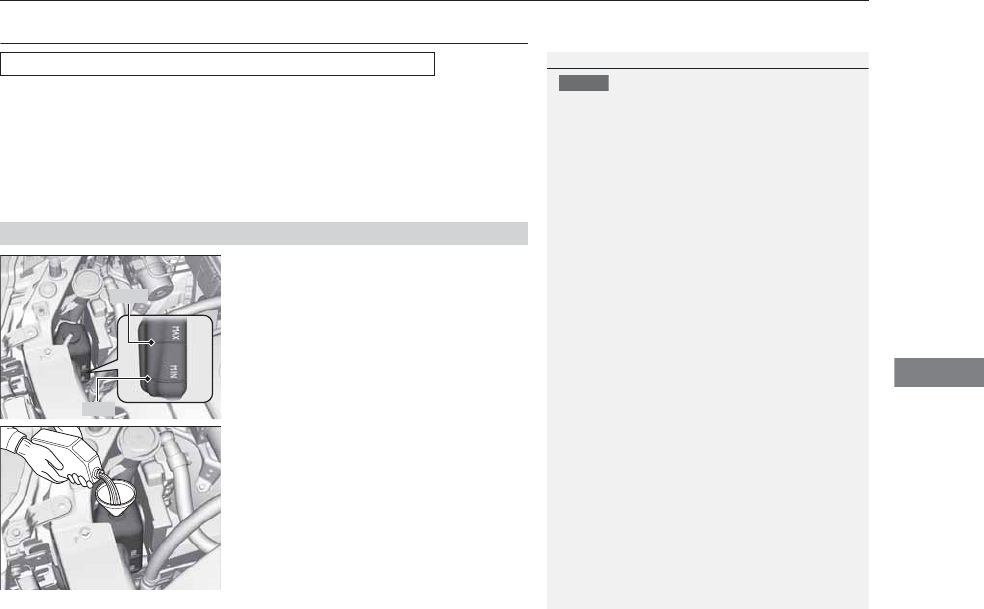
403
uuMaintenance Under the HooduEngine Coolant
Continued
Maintenance
Engine Coolant
This coolant is premixed with 50% antifreeze and 50% water. Do not add any
straight antifreeze or water.
We recommend you check the engine coolant level every time you refuel. Check the
reserve tank first. If it is completely empty, also check the coolant level in the
radiator. Add the engine coolant accordingly.
1. Check the amount of coolant in the reserve
tank.
2. If the coolant level is below the MIN mark,
add the specified coolant until it reaches
the MAX mark.
3. Inspect the cooling system for leaks.
Specified coolant: Acura Long Life Antifreeze/Coolant Type 2
■Reserve Tank
1Engine Coolant
NOTICE
If temperatures consistently below -22°F (-30°C) are
expected, the coolant mixture should be changed to
a higher concentration. Consult a dealer for more
information.
If Honda antifreeze/coolant is not available, you may
use another major brand non-silicate coolant as a
temporary replacement. Check that it is a high quality
coolant recommended for aluminum engines.
Continued use of any non-Honda coolant can result
in corrosion, causing the cooling system to
malfunction or fail. Have the cooling system flushed
and refilled with Honda antifreeze/coolant as soon as
possible.
Do not add rust inhibitors or other additives to your
vehicle’s cooling system. They may not be compatible
with the coolant or with the engine components.
MAX
MIN
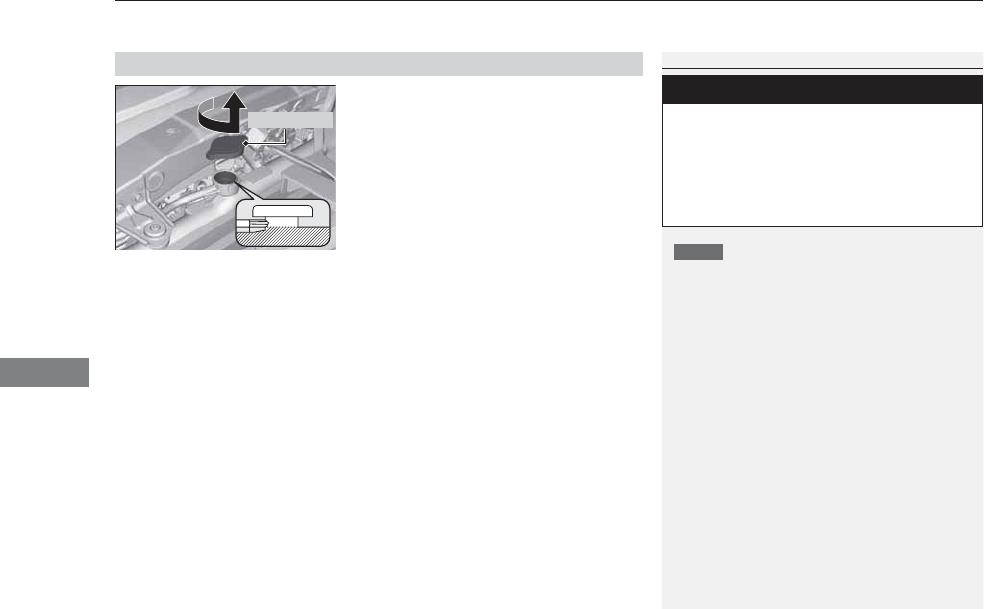
uuMaintenance Under the HooduEngine Coolant
404
Maintenance
1. Make sure the engine and radiator are
cool.
2. Remove the engine compartment cover.
2Engine Compartment Cover P. 397
3. Turn the radiator cap counterclockwise and
relieve any pressure in the coolant system.
Do not push the cap down when turning.
4. Push down and turn the radiator cap
counterclockwise to remove it.
5. The coolant level should be up to the base
of the filler neck. Add coolant if it is low.
6. Put the radiator cap back on, and tighten it
fully.
7. Pour coolant into the reserve tank until it
reaches the MAX mark. Put the cap back
on the reserve tank.
■Radiator
1Radiator
NOTICE
Pour the fluid slowly and carefully so you do not spill
any. Clean up any spills immediately; they can
damage components in the engine compartment.
3
WARNING
Removing the radiator cap while the
engine is hot can cause the coolant to spray
out, seriously scalding you.
Always let the engine and radiator cool
down before removing the radiator cap.
Radiator Cap
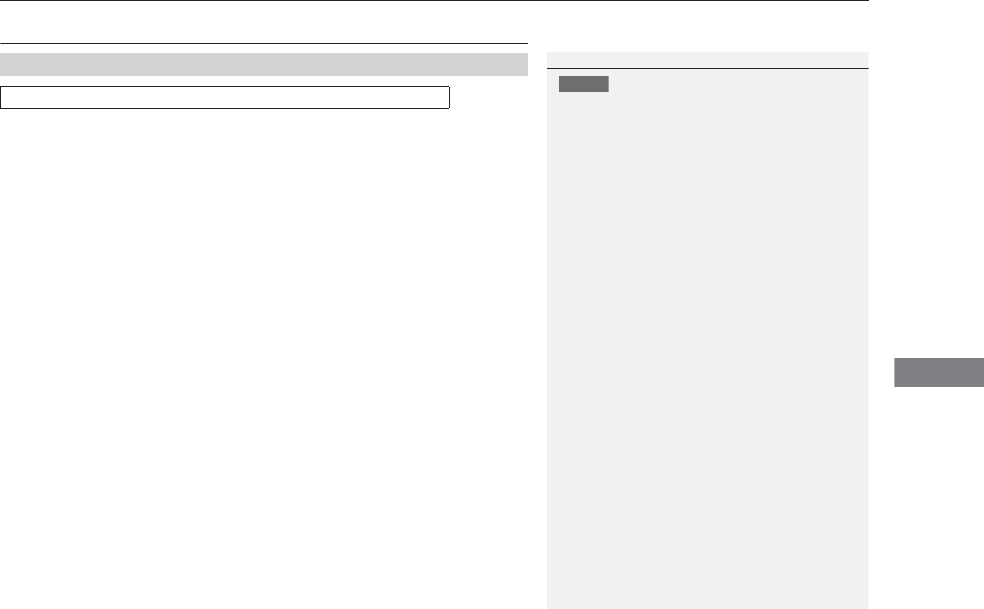
405
uuMaintenance Under the HooduTransmission Fluid
Maintenance
Transmission Fluid
Have a dealer check the fluid level and replace if necessary.
■Automatic Transmission Fluid
Specified fluid: Acura ATF DW-1 (automatic transmission fluid)
1Automatic Transmission Fluid
NOTICE
Do not mix Acura ATF DW-1 with other
transmission fluids.
Using a transmission fluid other than Acura ATF DW-
1 may adversely affect the operation and durability of
your vehicle’s transmission, and damage the
transmission.
Any damage caused by using a transmission fluid that
is not equivalent to Acura ATF DW-1 is not covered
by Acura’s new vehicle warranty.
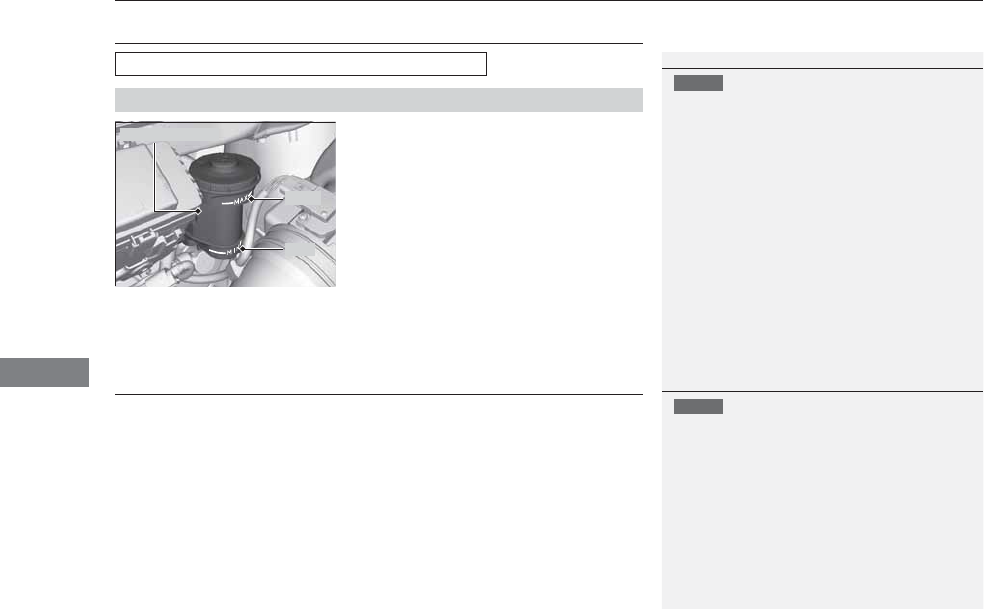
406
uuMaintenance Under the HooduBrake Fluid
Maintenance
Brake Fluid
The fluid level should be between the MIN
and MAX marks on the side of the reservoir.
Refilling Window Washer Fluid
If the washer fluid is low, a message appears on the MID.
Pour the washer fluid carefully. Do not overflow the reservoir.
Specified fluid: Acura Heavy Duty Brake Fluid DOT 3
■Checking the Brake Fluid
1Brake Fluid
NOTICE
Brake fluid marked DOT 5 is not compatible with your
vehicle’s braking system and can cause extensive
damage.
If the specified brake fluid is not available, you should
use only DOT 3 or DOT 4 fluid from a sealed
container as a temporary replacement.
Using any non-Acura brake fluid can cause corrosion
and decrease the longevity of the system. Have the
brake system flushed and refilled with Acura Heavy
Duty Brake Fluid DOT 3 as soon as possible.
If the brake fluid level is at or below the MIN mark,
have a dealer inspect for leaks or worn brake pads as
soon as possible.
Brake Reservoir
MIN
MAX
1Refilling Window Washer Fluid
NOTICE
Do not use engine antifreeze or a vinegar/water
solution in the windshield washer reservoir.
Antifreeze can damage your vehicle’s paint. A
vinegar/water solution can damage the windshield
washer pump.
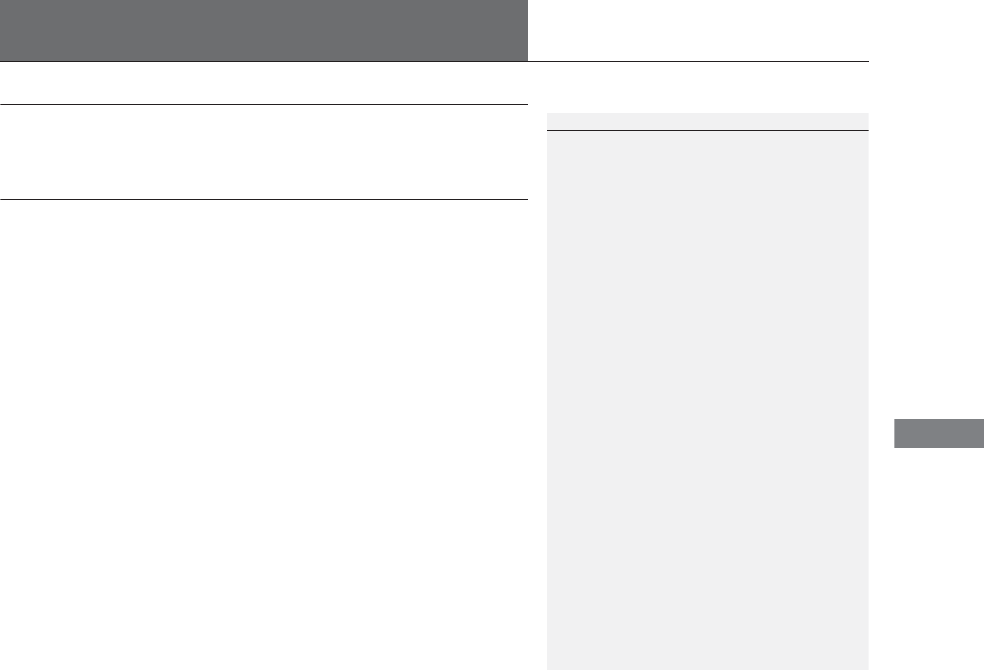
407
Maintenance
Replacing Light Bulbs
Headlight Bulbs
Headlight bulbs are LED type. Have an authorized Acura dealer inspect and replace
the light assembly.
Daytime Running Light Bulbs
Daytime running light bulbs are LED type. Have an authorized Acura dealer inspect
and replace the light assembly.
1Headlight Bulbs
The headlight aim is set by the factory, and does not
need to be adjusted. However, if you regularly carry
heavy items in the cargo area or tow a trailer, have
the aiming readjusted at a dealer or by a qualified
technician.
The exterior lights’ inside lenses (headlights, brake
lamps, etc.) may fog temporarily after a car wash or
while driving in the rain. This does not impact the
exterior light function.
However, if you see a large amount of water or ice
accumulated inside the lenses, have your vehicle
inspected by a dealer.
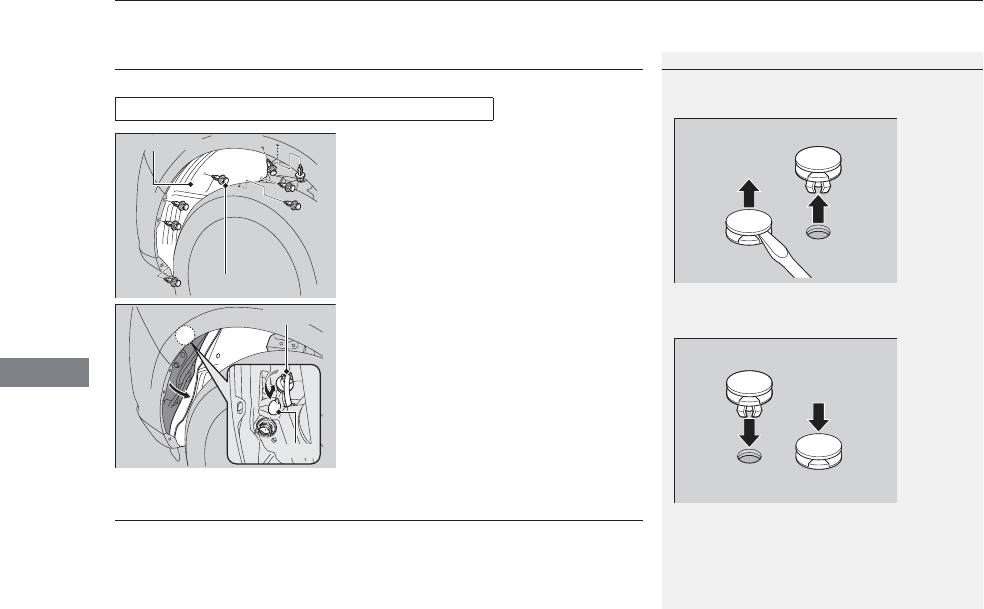
408
uuReplacing Light BulbsuFront Turn Signal/Front Side Marker/Parking Light Bulbs
Maintenance
Front Turn Signal/Front Side Marker/Parking Light
Bulbs
When replacing, use the following bulbs.
1. Remove the holding clips, and pull the inner
fender back.
2. Turn the socket to the left and remove it.
3. Remove the old bulb and insert a new bulb.
Side Turn Signal/Emergency Indicator Light Bulbs
Door mirrors have the side turn lights. Have an authorized Acura dealer inspect and
replace the light assembly.
Front Turn Signal/Side Marker/Parking Light: 28/8 W
1Front Turn Signal/Front Side Marker/Parking Light Bulbs
Insert a flat-tip screwdriver, lift and remove the center
pin to remove the clip.
Insert the clip with the center pin raised, and push
until it is flat.
Push until the
pin is flat.
Clip
Inner Fender
Bulb
Socket
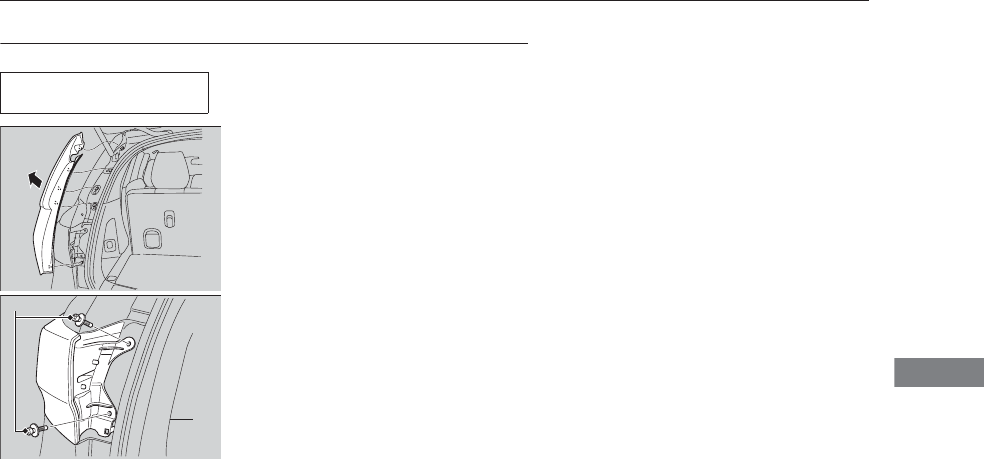
409
uuReplacing Light BulbsuBrake Light and Turn Signal Light Bulbs
Continued
Maintenance
Brake Light and Turn Signal Light Bulbs
When replacing, use the following bulbs.
1. Remove the cover.
uStarting at the bottom, carefully pull the
cover straight out, working upward until
all pins are removed from their the
grommets.
uThe grommets should remain in the
body.
2. Use a Phillip-head screwdriver to remove
the bolts.
3. Pull the light assembly out of the rear pillar.
Brake Light: 21 W
Rear Turn Signal Light: 21 W
Bolts
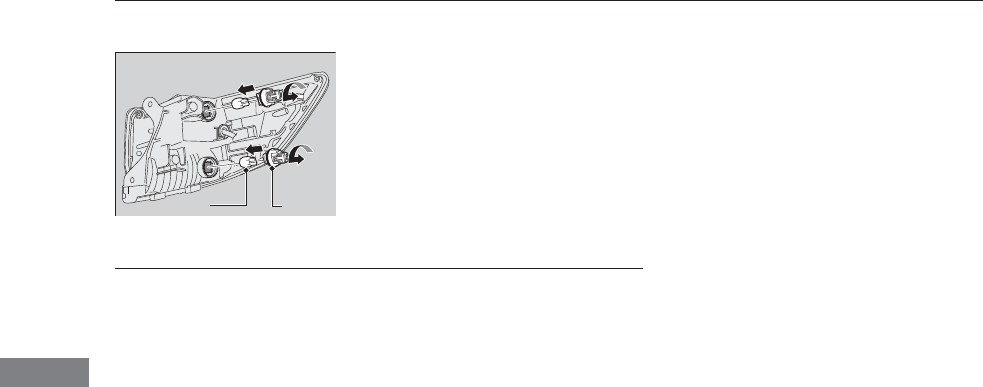
410
uuReplacing Light BulbsuTaillight and Rear Side Marker Light Bulbs
Maintenance
4. Turn the socket to the left and remove it.
Remove the old bulb.
5. Insert a new bulb.
6. Slide the light assembly onto the guide on
the body.
7. Align the pins with the body grommets,
then push in until they fully seat.
Taillight and Rear Side Marker Light Bulbs
Taillight and rear side marker light bulbs are the LED type. Have an authorized Acura
dealer inspect and replace the light assembly.
Bulb Socket
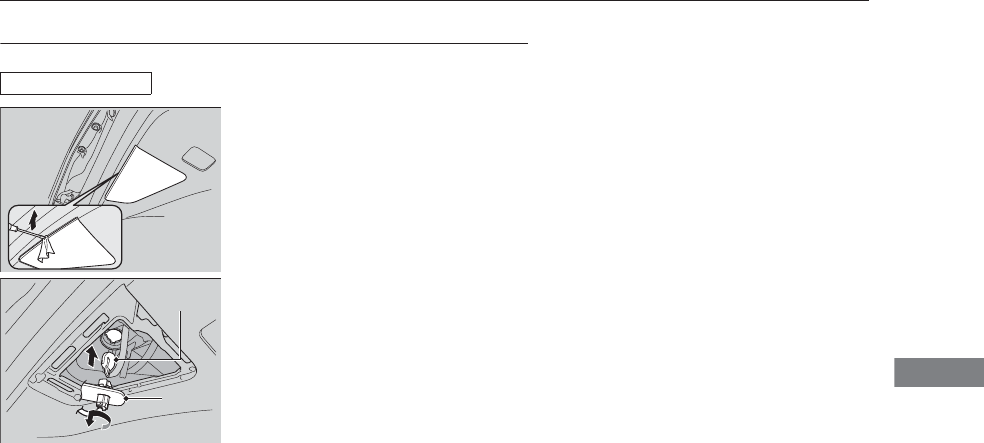
411
uuReplacing Light BulbsuBack-Up Light
Maintenance
Back-Up Light
When replacing, use the following bulbs.
1. Remove the cover by prying on the edge
using a flat-tip screwdriver.
uWrap the flat-tip screwdriver with a cloth
to prevent scratches.
2. Turn the socket to the left and remove it.
Remove the old bulb.
3. Insert a new bulb.
Back-Up Light: 21 W
Bulb
Socket
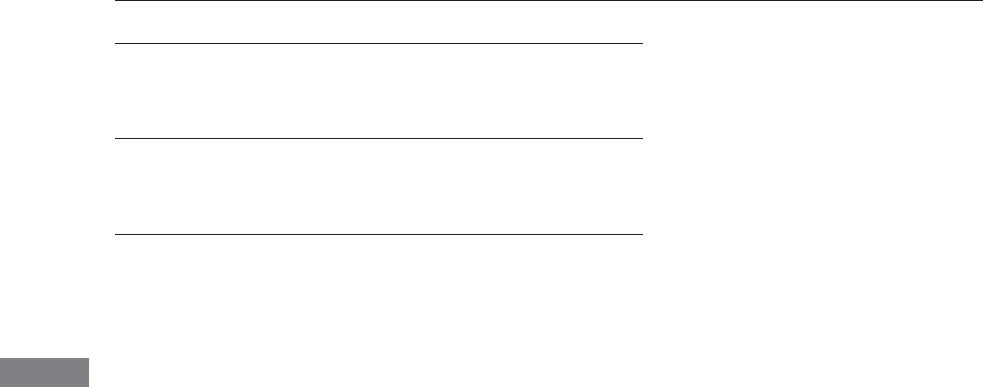
412
uuReplacing Light BulbsuRear License Plate Light Bulbs
Maintenance
Rear License Plate Light Bulbs
Rear license plate light bulbs are the LED type. Have an authorized Acura dealer
inspect and replace the light assembly.
High-Mount Brake Light Bulbs
High-mount brake light bulbs are the LED type. Have an authorized Acura dealer
inspect and replace the light assembly.
LED Puddle Light Bulbs
LED puddle light bulbs are LED type. Have an authorized Acura dealer inspect and
replace the light assembly.
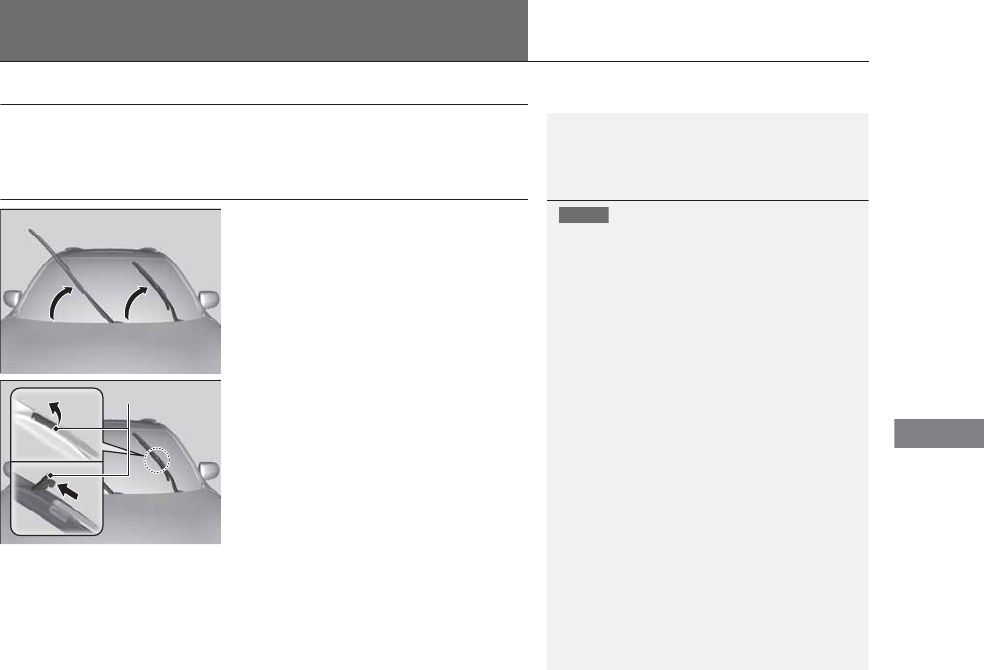
413
Continued
Maintenance
Checking and Maintaining Wiper Blades
Checking Wiper Blades
If the wiper blade rubber has deteriorated, it will leave streaks and the metal wiper
arm may scratch the window glass.
Changing the Front Wiper Blade Rubber
1. Lift the driver side wiper arm first, then the
passenger side.
2. Place a cloth on the edge of the lock tab.
Push the lock tab up with a flat-tip screw
driver.
3. Slide the blade from the wiper arm.
1Changing the Front Wiper Blade Rubber
NOTICE
Avoid dropping the wiper arm; it may damage the
windshield.
Lock Tab
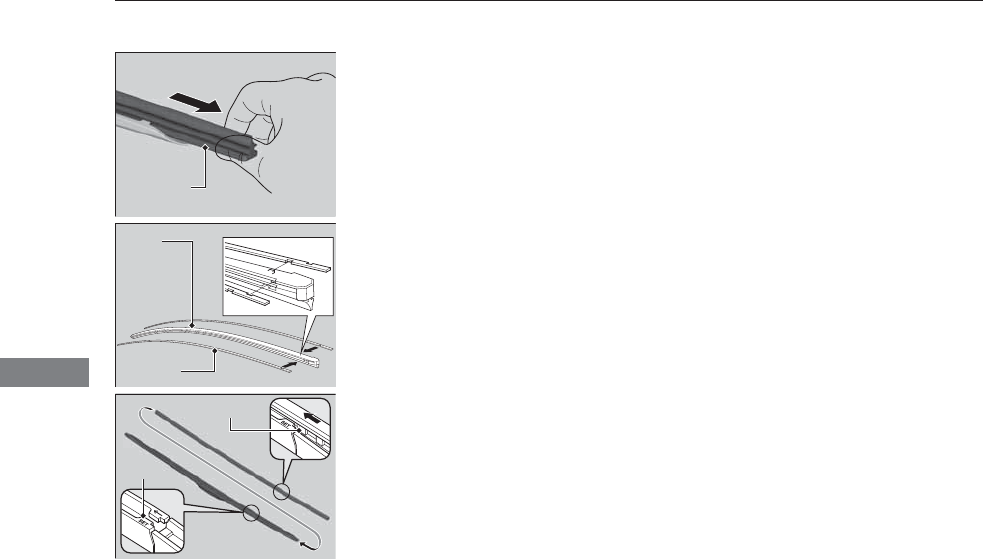
414
uuChecking and Maintaining Wiper BladesuChanging the Front Wiper Blade Rubber
Maintenance
4. Slide the wiper blade out from its holder by
pulling the tabbed end out.
5. Remove the retainers from the rubber blade
that has been removed, and mount to a
new rubber blade.
uCorrectly align the rubber protrusion and
the retainer grooves.
6. Slide the new wiper blade onto the holder
from the bottom end.
uThe tab on the holder should fit in the
indent of the wiper blade.
7. Slide the wiper blade onto the wiper arm,
then push down the lock tab.
8. Lower the passenger side wiper arm first,
then the driver side.
Blade
Retainer
Blade
Tab
Indent
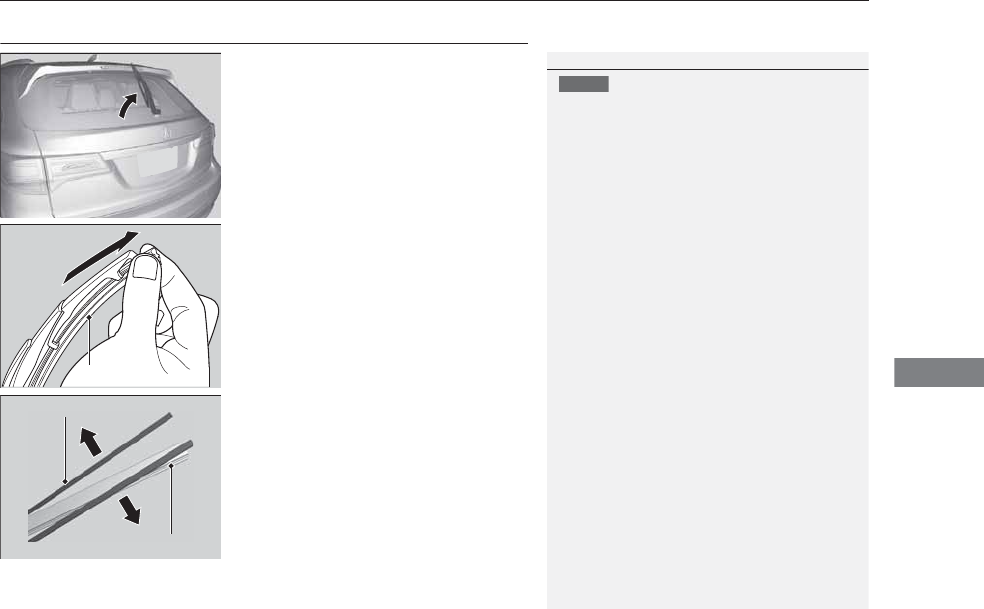
415
uuChecking and Maintaining Wiper BladesuChanging the Rear Wiper Blade Rubber
Continued
Maintenance
Changing the Rear Wiper Blade Rubber
1. Raise the wiper arm off.
2. Slide the wiper blade out from the end with
the indent.
3. Remove the retainers from wiper blade and
mount to a new rubber blade.
1Changing the Rear Wiper Blade Rubber
NOTICE
Avoid dropping the wiper arm; it may damage the
windshield.
Blade
Retainer
Rubber
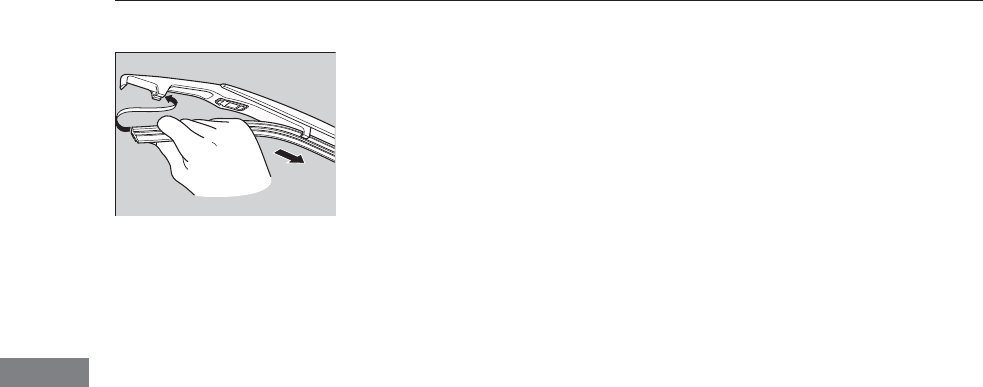
416
uuChecking and Maintaining Wiper BladesuChanging the Rear Wiper Blade Rubber
Maintenance
4. Slide the wiper blade onto the holder.
uMake sure it is engaged correctly, then
install the wiper blade assembly onto the
wiper arm.
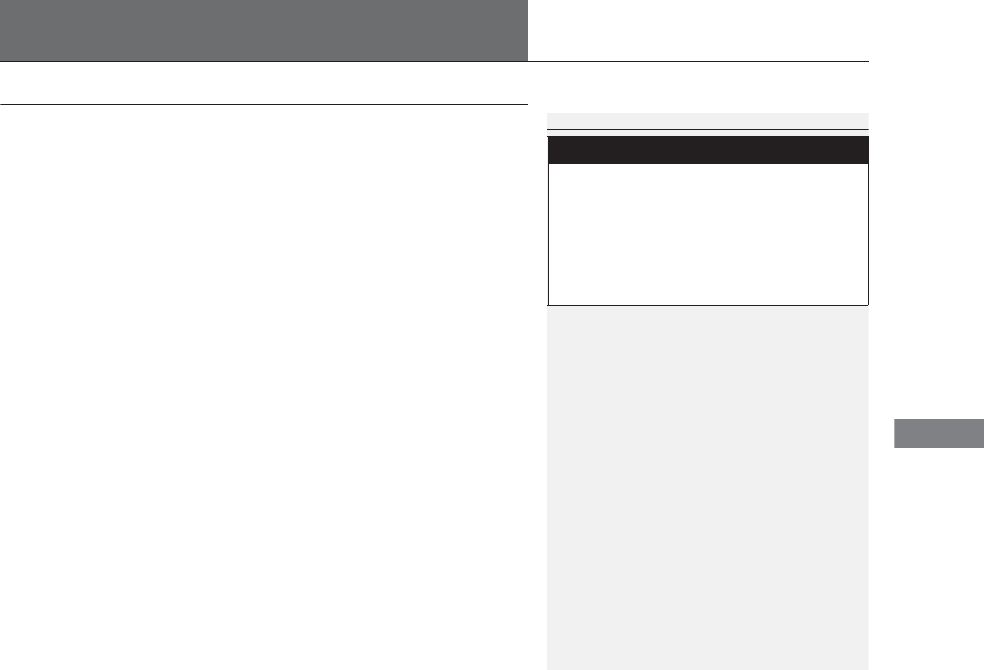
417
Maintenance
Checking and Maintaining Tires
Checking Tires
To safely operate your vehicle, your tires must be of the proper type and size, in
good condition with adequate tread, and properly inflated.
■Inflation guidelines
Properly inflated tires provide the best combination of handling, tread life, and comfort.
Refer to the driver’s doorjamb label or specification’s page for the specified pressure.
Underinflated tires wear unevenly, adversely affect handling and fuel economy, and
are more likely to fail from overheating.
Overinflated tires make your vehicle ride harshly, are more prone to road hazards,
and wear unevenly.
Every day before you drive, look at each of the tires. If one looks lower than the
others, check the pressure with a tire gauge.
At least once a month and before long trips, use a gauge to measure the pressure in
all tires, including the spare. Even tires in good condition can lose 1 to 2 psi (10 to
20 kPa, 0.1 to 0.2 kgf/cm2) per month.
■Inspection guidelines
Every time you check inflation, also examine the tires and valve stems.
Look for:
•Bumps or bulges on the side or in the tread. Replace the tire if you find any cuts,
splits, or cracks in the side of the tire. Replace it if you see fabric or cord.
•Remove any foreign objects and inspect for air leaks.
•Uneven tread wear. Have a dealer check the wheel alignment.
•Excessive tread wear.
2Wear Indicators P. 422
•Cracks or other damage around valve stem.
1Checking Tires
Measure the air pressure when tires are cold. This
means the vehicle has been parked for at least three
hours, or driven less than 1 mile (1.6 km). If
necessary, add or release air until the specified
pressure is reached.
If checked when hot, tire pressure can be as much as
4–6 psi (30–40 kPa, 0.3–0.4 kgf/cm2) higher than if
checked when cold.
Have a dealer check the tires if you feel a consistent
vibration while driving. New tires and any that have
been removed and reinstalled should be properly
balanced.
3
WARNING
Using tires that are excessively worn or
improperly inflated can cause a crash in
which you can be seriously hurt or killed.
Follow all instructions in this owner’s
manual regarding tire inflation and
maintenance.
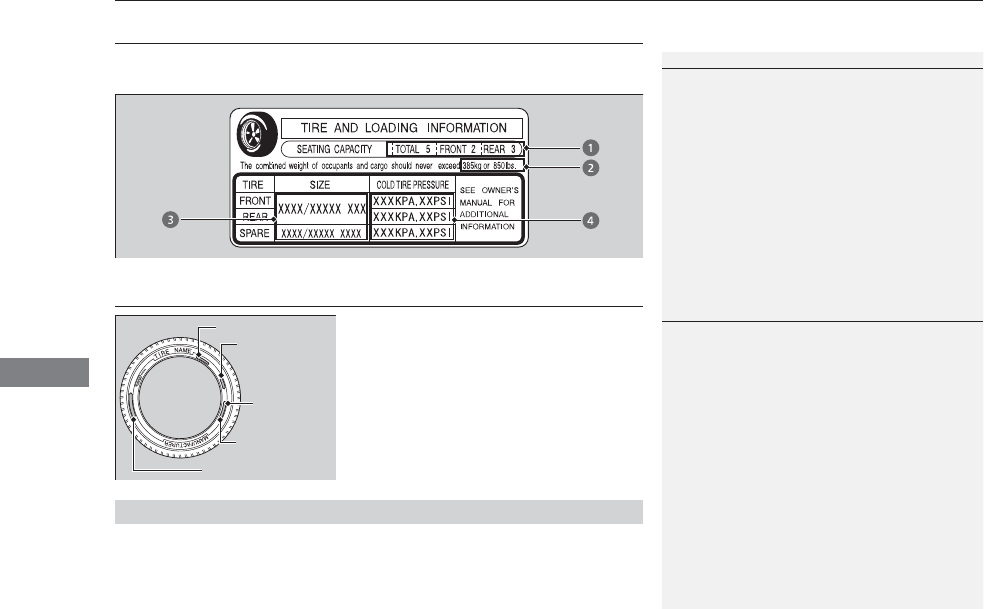
418
uuChecking and Maintaining TiresuTire and Loading Information Label
Maintenance
Tire and Loading Information Label
The label attached to the driver’s doorjamb provides necessary tire and loading
information.
Tire Labeling
The tires that came on your vehicle have a
number of markings. Those you should be
aware of are described below.
Whenever tires are replaced, they should be replaced with tires of the same size.
1Tire and Loading Information Label
The tire and loading information label attached to the
driver’s doorjamb contains:
aThe number of people your vehicle can carry.
bThe total weight your vehicle can carry. Do not
exceed this weight.
cThe original tire sizes for front, rear, and spare.
dThe proper cold tire pressure for front, rear, and
spare.
Label
Example
Example Tire Size
Tire
Identification
Number (TIN)
Maximum
Tire Load
Maximum
Tire Pressure
Tire Size
■Tire Sizes
1Tire Sizes
Following is an example of tire size with an
explanation of what each component means.
P235/60R18 102V
P: Vehicle type (P indicates passenger vehicle).
235: Tire width in millimeters.
60: Aspect ratio (the tire’s section height as a
percentage of its width).
R: Tire construction code (R indicates radial).
18: Rim diameter in inches.
102: Load index (a numerical code associated with
the maximum load the tire can carry).
V: Speed symbol (an alphabetical code indicating the
maximum speed rating).
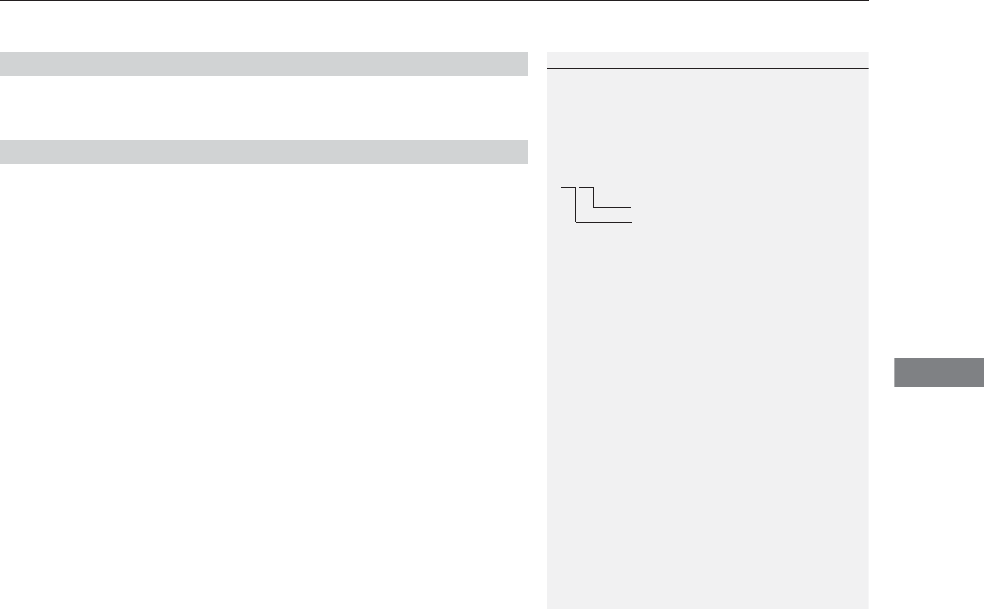
419
uuChecking and Maintaining TiresuTire Labeling
Maintenance
The tire identification number (TIN) is a group of numbers and letters that look like
the example in the side column. TIN is located on the sidewall of the tire.
Cold Tire Pressure – The tire air pressure when the vehicle has been parked for at
least three hours or driven less than 1 mile (1.6 km).
Load Rating – Means the maximum load that a tire is rated to carry for a given
inflation pressure.
Maximum Inflation Pressure – The maximum tire air pressure that the tire can
hold.
Maximum Load Rating – Means the load rating for a tire at the maximum
permissible inflation pressure for that tire.
Recommended Inflation Pressure – The cold tire inflation pressure recommended
by the manufacturer.
Treadwear Indicators (TWI) – Means the projections within the principal grooves
designed to give a visual indication of the degrees of wear of the tread.
■Tire Identification Number (TIN)
■Glossary of Tire Terminology
1Tire Identification Number (TIN)
DOT B97R FW6X 2209
DOT: This indicates that the tire meets all
requirements of the U.S. Department of
Transportation.
B97R: Manufacturer’s identification mark.
FW6X: Tire type code.
22 09: Date of manufacture.
Year
Week
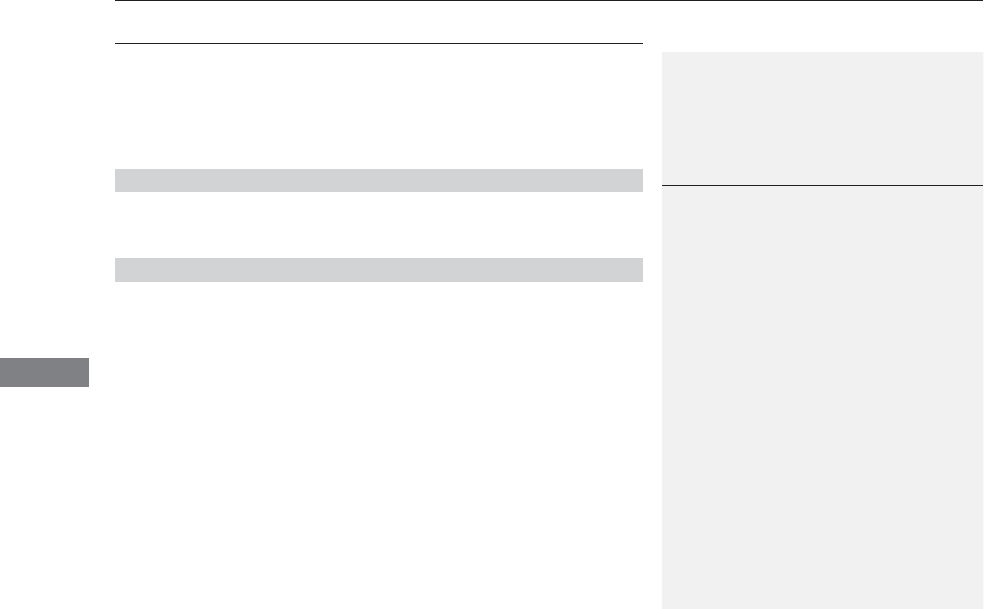
420
uuChecking and Maintaining TiresuDOT Tire Quality Grading (U.S. Vehicles)
Maintenance
DOT Tire Quality Grading (U.S. Vehicles)
The tires on your vehicle meet all U.S. Federal Safety
Requirements. All tires are also graded for treadwear, traction,
and temperature performance according to Department of
Transportation (DOT) standards. The following explains these
gradings.
Quality grades can be found where applicable on the tire sidewall
between tread shoulder and maximum section width.
The treadwear grade is a comparative rating based on the wear
rate of the tire when tested under controlled conditions on a
specified government test course. For example, a tire graded 150
would wear one and one-half (1 1/2) times as well on the
government course as a tire graded 100. The relative performance
of tires depends upon the actual conditions of their use, however,
and may depart significantly from the norm due to variations in
driving habits, service practices and differences in road
characteristics and climate.
■Uniform Tire Quality Grading
■Treadwear
1Uniform Tire Quality Grading
For example:
Treadwear 200
Traction AA
Temperature A
All passenger car tires must conform
to Federal Safety Requirements in
addition to these grades.
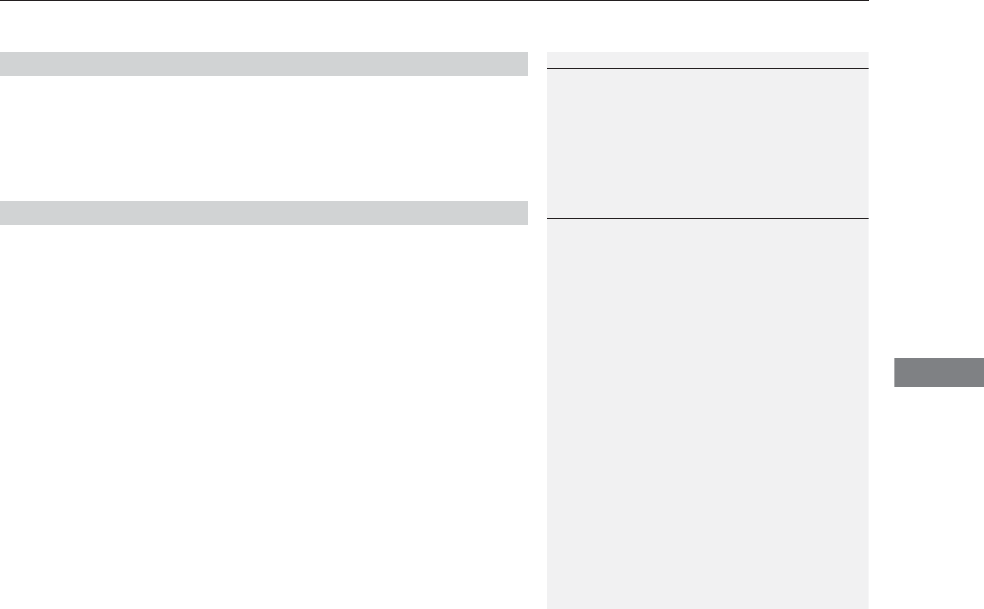
421
uuChecking and Maintaining TiresuDOT Tire Quality Grading (U.S. Vehicles)
Maintenance
The traction grades, from highest to lowest, are AA, A, B, and C.
Those grades represent the tire’s ability to stop on wet pavement
as measured under controlled conditions on specified
government test surfaces of asphalt and concrete. A tire marked
C may have poor traction performance.
The temperature grades are A (the highest), B, and C,
representing the tire’s resistance to the generation of heat and its
ability to dissipate heat when tested under controlled conditions
on a specified indoor laboratory test wheel. Sustained high
temperature can cause the material of the tire to degenerate and
reduce tire life, and excessive temperature can lead to sudden tire
failure. The grade C corresponds to a level of performance which
all passenger car tires must meet under the Federal Motor Vehicle
Safety Standard No. 109. Grades B and A represent higher levels
of performance on the laboratory test wheel than the minimum
required by law.
■Traction
■Temperature
1Traction
Warning: The traction grade
assigned to this tire is based on
straight-ahead braking traction tests,
and does not include acceleration,
cornering, hydroplaning, or peak
traction characteristics.
1Temperature
Warning: The temperature grade for
this tire is established for a tire that is
properly inflated and not
overloaded. Excessive speed,
underinflation, or excessive loading,
either separately or in combination,
can cause heat buildup and possible
tire failure.
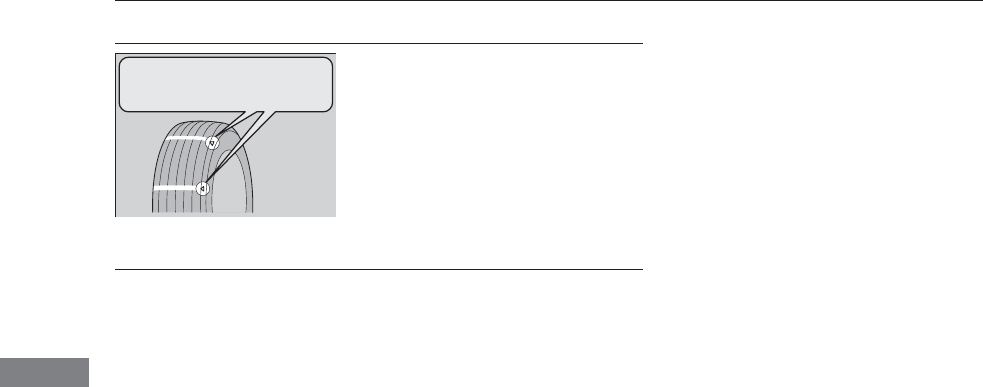
422
uuChecking and Maintaining TiresuWear Indicators
Maintenance
Wear Indicators
The groove where the wear indicator is
located is 1/16 inch (1.6 mm) shallower than
elsewhere on the tire. If the tread has worn so
that the indicator is exposed, replace the tire.
Worn out tires have poor traction on wet
roads.
Tire Service Life
The life of your tires is dependent on many factors, including driving habits, road
conditions, vehicle loading, inflation pressure, maintenance history, speed, and
environmental conditions (even when the tires are not in use).
In addition to regular inspections and inflation pressure maintenance, it is
recommended that you have annual inspections performed once the tires reach five
years old. All tires, including the spare, should be removed from service after 10
years from the date of manufacture, regardless of their condition or state of wear.
Example of a Wear
Indicator mark
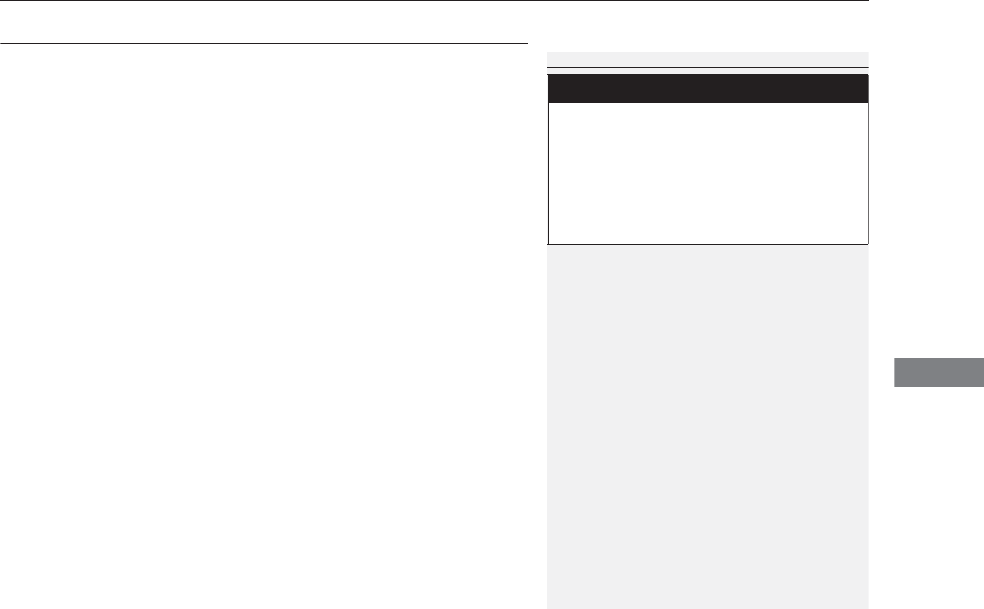
423
uuChecking and Maintaining TiresuTire and Wheel Replacement
Maintenance
Tire and Wheel Replacement
Replace your tires with radials of the same size, load range, speed rating, and
maximum cold tire pressure rating (as shown on the tire’s sidewall). Using tires of a
different size or construction can cause the ABS and VSA® (vehicle stability assist)
system to work incorrectly.
It is best to replace all four tires at the same time. If that isn’t possible, replace the
front or rear tires in pairs.
If you replace a wheel, only use TPMS specified wheels approved for your vehicle.
Make sure that the wheel’s specifications match those of the original wheels.
1Tire and Wheel Replacement
3
WARNING
Installing improper tires on your vehicle can
affect handling and stability. This can cause
a crash in which you can be seriously hurt or
killed.
Always use the size and type of tires
recommended in this owner’s manual.
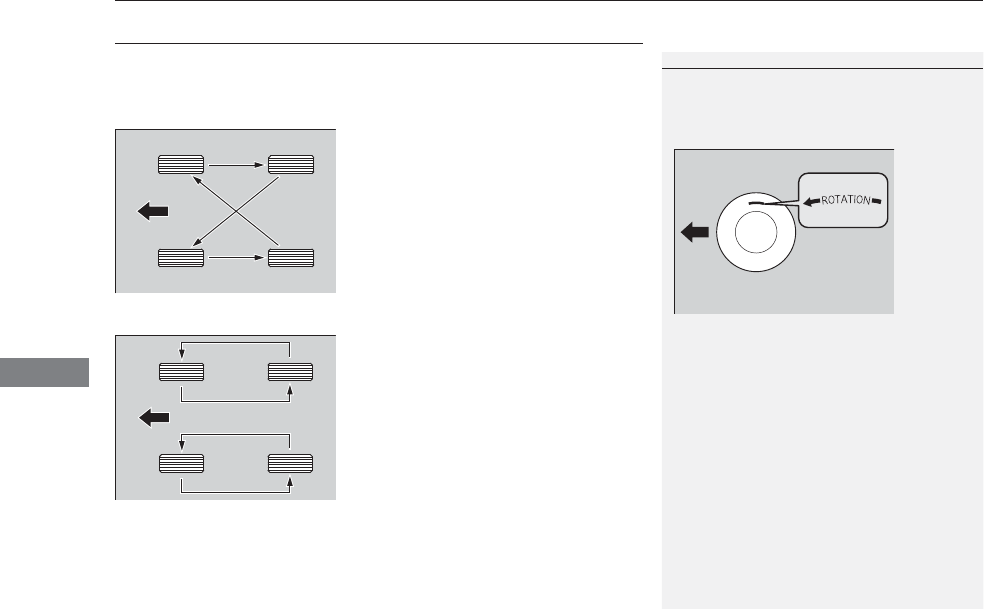
424
uuChecking and Maintaining TiresuTire Rotation
Maintenance
Tire Rotation
Rotating tires according to the maintenance messages on the MID helps to distribute
wear more evenly and increase tire life.
■Tires without rotation marks
Rotate the tires as shown here.
■Tires with rotation marks
Rotate the tires as shown here.
1Tire Rotation
Tires with directional tread patterns should only be
rotated front to back (not from one side to the other).
Directional tires should be mounted with the rotation
indication mark facing forward, as shown below.
Front
Rotation Mark
Front
Front
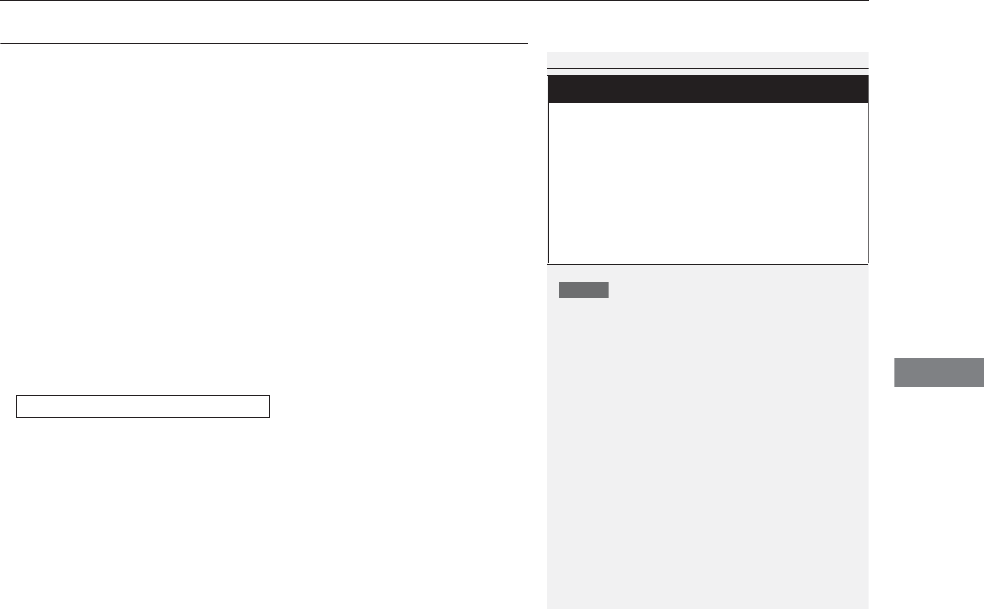
425
uuChecking and Maintaining TiresuWinter Tires
Maintenance
Winter Tires
If driving on snowy or frozen roads, mount all season marked “M+S” tires, snow
tires, or tire chains; reduce speed; and maintain sufficient distance between vehicles
when driving.
Be particularly careful when operating the steering wheel or brakes to prevent
skidding.
Use tire chains, snow tires, or all season tires when necessary or according to the law.
When mounting, refer to the following points.
For winter tires:
•Select the size and load ranges that are the same as the original tires.
•Mount the tires to all four wheels.
For tire chains:
•Install them on the front tires only.
•Because your vehicle has limited tire clearance, we strongly recommend using the
chains listed below:
•Follow the chain manufacturer’s instruction when installing. Mount them as
tightly as you can.
•Check that the chains do not touch the brake lines or suspension.
•Drive slowly.
Cable-type: SCC Cable Chain ZT735
1Winter Tires
NOTICE
Traction devices that are the wrong size or improperly
installed can damage your vehicle’s brake lines,
suspension, body, and wheels. Stop driving if they are
hitting any part of the vehicle.
When tire chains are mounted, follow the chain
manufacturer’s instructions regarding vehicle
operational limits.
If your vehicle is equipped with summer tires, be
aware that these tires are not designed for winter
driving conditions. For more information, contact a
dealer.
3
WARNING
Using the wrong chains, or not properly
installing chains, can damage the brake
lines and cause a crash in which you can be
seriously injured or killed.
Follow all instructions in this owner’s
manual regarding the selection and use of
tire chains.
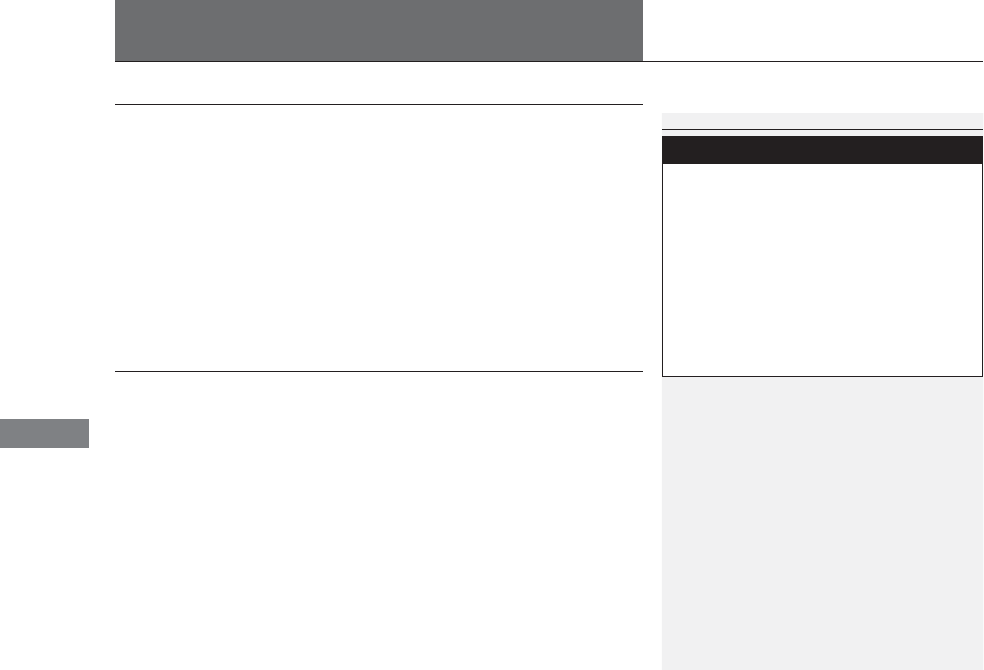
426
Maintenance
Battery
Checking the Battery
The battery condition is being monitored by the sensor on the negative terminal.
If there is a problem with the sensor, the warning message on MID will let you know.
Have your vehicle checked by a dealer.
If your vehicle’s battery is disconnected or goes dead:
•The audio system is disabled.
2Audio System Theft Protection P. 201
•The clock resets.
2Clock P. 114
•The navigation system* is disabled.
2Refer to navigation system manual
Charging the Battery
Disconnect both battery cables to prevent damaging your vehicle’s electrical system.
Always disconnect the negative (–) cable first, and reconnect it last.
1Battery
WARNING: Battery post, terminals,
and related accessories contain lead
and lead compounds.
Wash your hands after handling.
When you find corrosion, clean the battery terminals
by applying a baking powder and water solution.
Clean the terminals with a damp towel. Cloth/towel
dry the battery. Coat the terminals with grease to
help prevent future corrosion.
When replacing the battery, the replacement must be
of the same specifications.
Please consult a dealer for more information.
3
WARNING
The battery gives off explosive hydrogen
gas during normal operation.
A spark or flame can cause the battery to
explode with enough force to kill or
seriously hurt you.
When conducting any battery
maintenance, wear protective clothing and
a face shield, or have a skilled technician do
it.
* Not available on all models
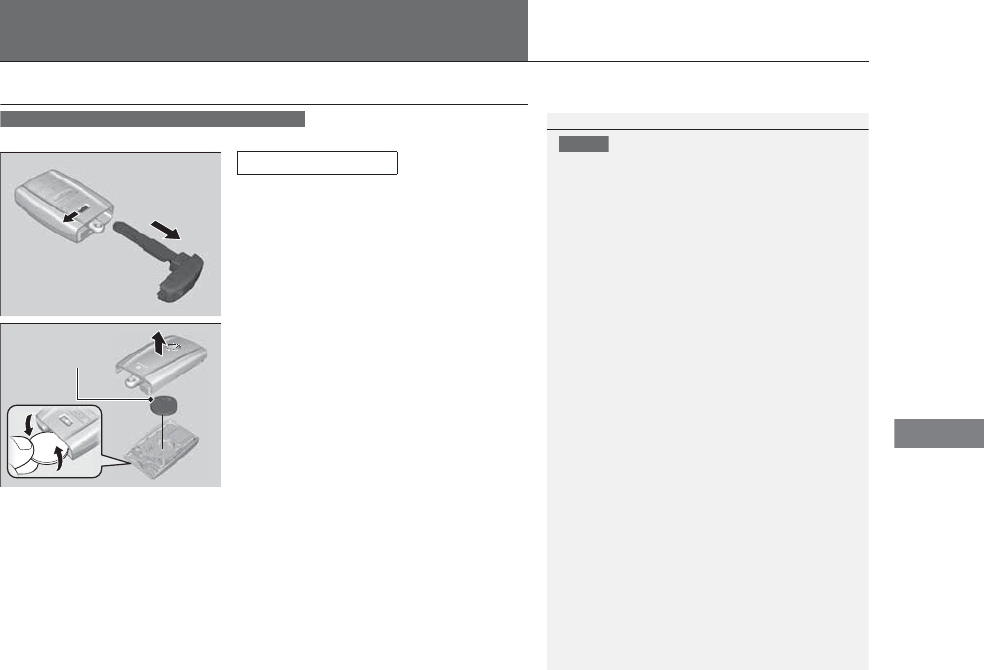
427
Continued
Maintenance
Remote Transmitter Care
Replacing the Button Battery
If the indicator does not come on when the button is pressed, replace the battery.
1. Remove the built-in key.
2. Remove the upper half by carefully prying
on the edge with a coin.
uWrap a coin with a cloth to prevent
scratching the transmitter.
3. Make sure to replace the battery with the
correct polarity.
1Replacing the Button Battery
NOTICE
An improperly disposed of battery can damage the
environment. Always confirm local regulations for
battery disposal.
Replacement batteries are commercially available or
at a dealer.
Models without remote control engine start system
Battery type: CR2032
Battery
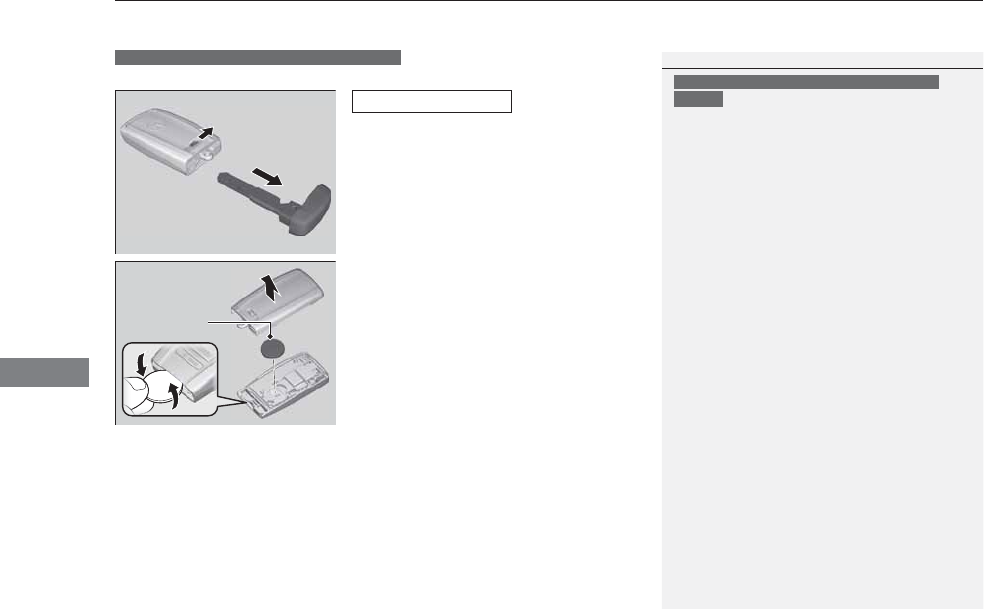
uuRemote Transmitter CareuReplacing the Button Battery
428
Maintenance
If the indicator does not come on when the button is pressed, replace the battery.
1. Remove the built-in key.
uAs a convenience, lightly place masking
tape over the remote buttons to hold
them in place.
2. Remove the upper half by carefully prying
on the edge with a coin.
uWrap a coin with a cloth to prevent
scratching the transmitter.
3. Press down on the center of the assembly
and remove the battery.
uWhen removing the button battery, be
careful not to touch parts around it.
4. Make sure to replace the battery with the
correct polarity.
Models with remote control engine start system
1Replacing the Button Battery
NOTICE
The Remote transmitter is equipped with two
batteries: A standard replaceable CR2032 coin
button battery and an integral non-replaceable
rechargeable battery. To prevent permanent damage
to the rechargeable battery, replace the CR2032
battery every three to four years.
Models with remote control engine start system
Battery type: CR2032
Battery
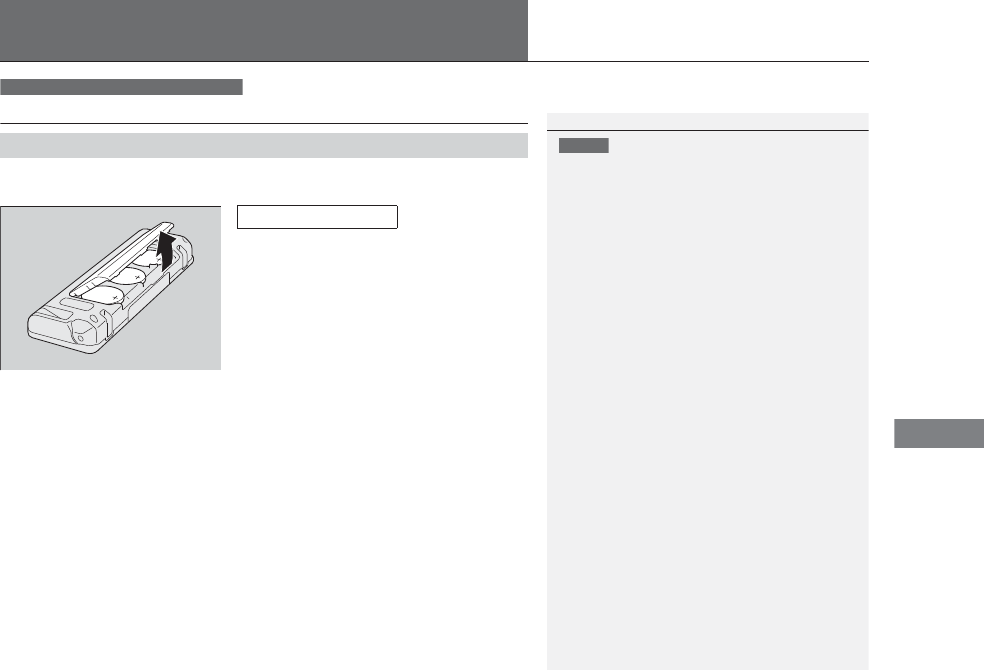
429
Continued
Maintenance
Remote Control and Wireless Headphone Care*
Replacing the Battery
If it takes several pushes on the remote control buttons to operate the rear
entertainment system, replace the battery.
1. Remove the cover.
2. Make sure to replace the battery with the
correct polarity.
■Remote Control
Models with Rear Entertainment System
1Replacing the Battery
NOTICE
An improperly disposed of battery can damage the
environment. Always confirm local regulations for
battery disposal.
Replacement batteries are commercially available or
at a dealer.
Battery type: BR3032
* Not available on all models
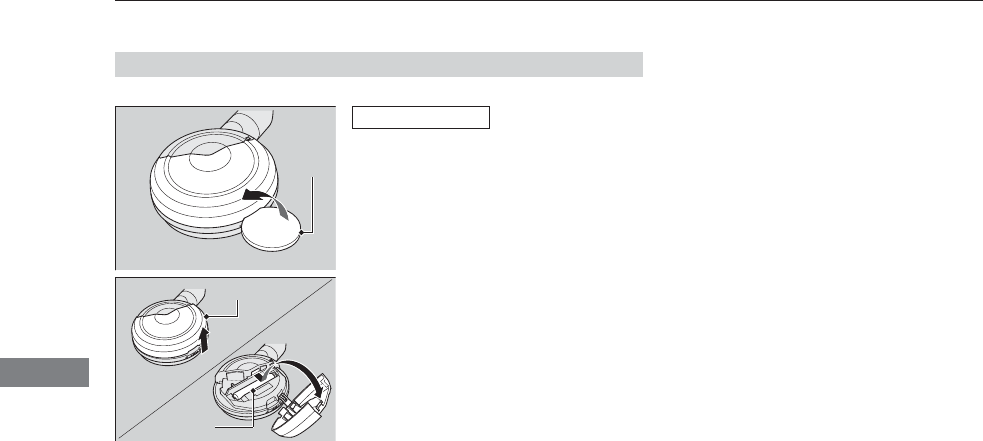
430
uuRemote Control and Wireless Headphone Care*uReplacing the Battery
Maintenance
If there is no sound coming from the wireless headphone, replace the battery.
1. To open the cover, insert a coin in the slot
and twist it slightly to pry the cover away
from the earpiece.
2. Make sure to replace the battery with the
correct polarity.
■Wireless Headphone
Coin
Battery type: AAA
Cover
Battery
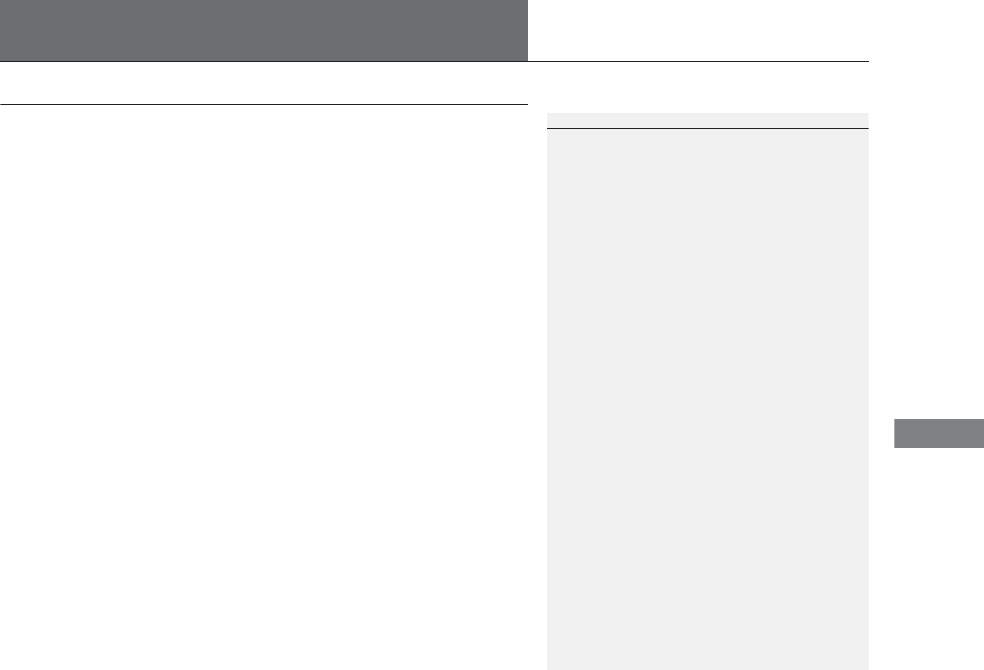
431
Maintenance
Climate Control System Maintenance
Dust and Pollen Filter
The climate control system is equipped with a dust and pollen filter that collects
pollen, dust, and other debris in the air. The Maintenance MinderTM messages will let
you know when to replace the filter.
We recommend that you replace the dust and pollen filter sooner when using your
vehicle in areas with high concentrations of dust.
1Dust and Pollen Filter
If the airflow from the climate control system
deteriorates noticeably, and the windows fog up
easily, the filter may need to be replaced. Please
contact a dealer for replacement.
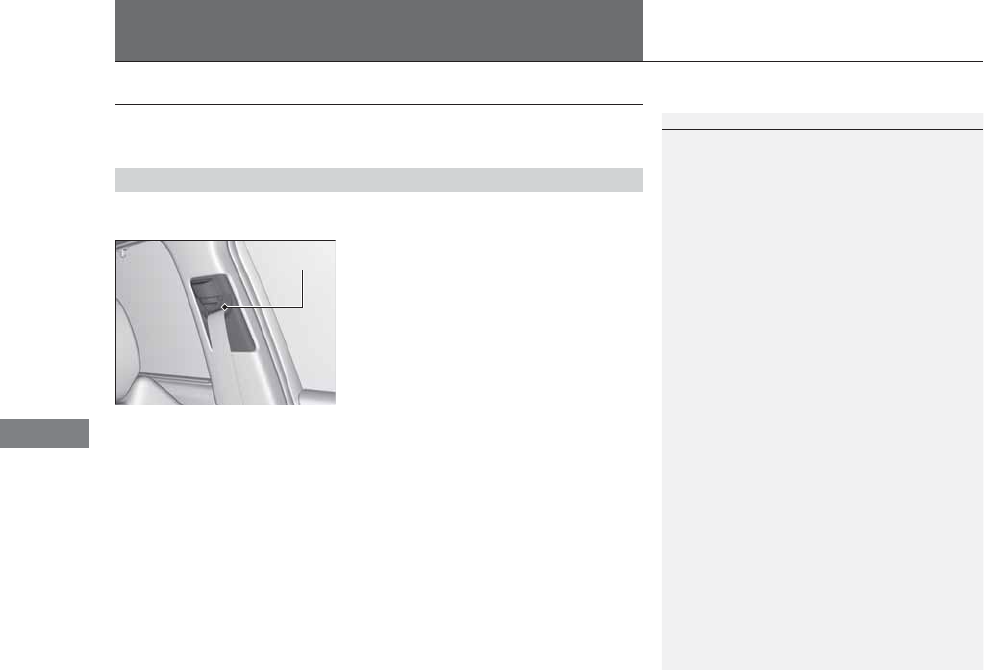
432
Maintenance
Cleaning
Interior Care
Use a damp cloth with a mixture of mild detergent and warm water to remove dirt.
Use a clean cloth to remove detergent residue.
Use a soft brush with a mixture of mild soap and warm water to clean the seat belts.
Let the belts air dry. Wipe the openings of the seat belt anchors using a clean cloth.
■Cleaning Seat Belts
1Interior Care
Do not spill liquids inside the vehicle.
Electrical devices and systems may malfunction if
liquids are splashed on them.
Do not use silicone based sprays on electrical devices
such as audio devices and switches.
Doing so may cause the items to malfunction or a fire
inside the vehicle.
If a silicone based spray is inadvertently used on
electrical devices, consult a dealer.
Depending on their composition, chemicals and
liquid aromatics may cause discoloration, wrinkles,
and cracking to resin-based parts and textiles.
Do not use alkali solvents or organic solvents such as
benzene or gasoline.
After using chemicals, make sure to gently wipe them
off using a dry cloth.
Do not place used cloths on top of resin based parts
or textiles for long periods of time without washing.
Opening
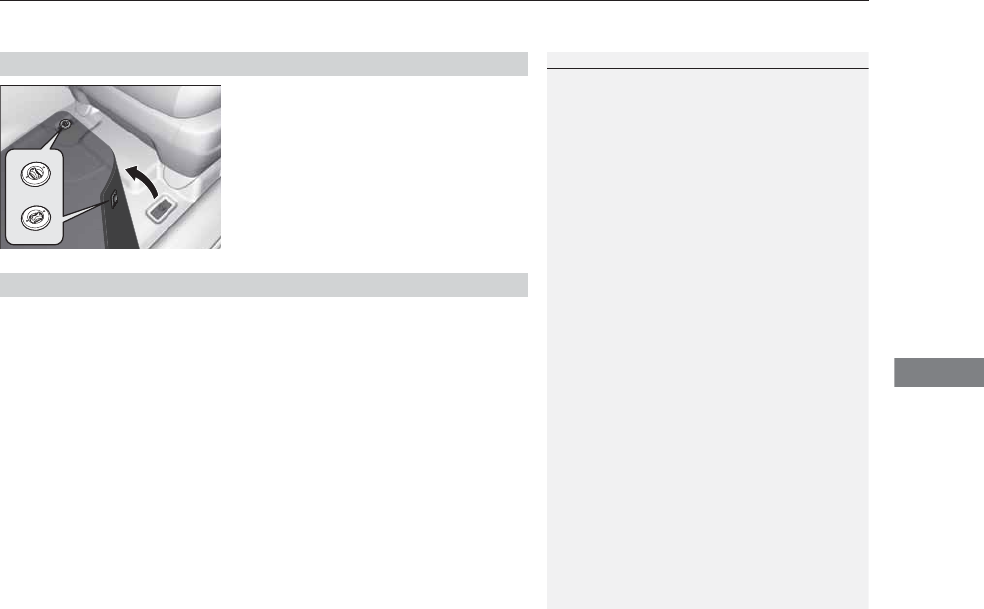
433
uuCleaninguInterior Care
Maintenance
The front floor mats hook over the floor
anchors, which keep the mats from sliding
forward. To remove a mat for cleaning, turn
the anchor knobs to the unlock position.
When reinstalling the mat after cleaning, turn
the knobs to the lock position.
Do not put additional floor mats on top of
the anchored mat.
Vacuum dirt and dust from the leather frequently. Pay close attention to the pleats
and seams. Clean the leather with a soft cloth dampened with a 90% water and
10% neutral soap solution. Then buff it with a clean, dry cloth. Remove any dust or
dirt on leather surfaces immediately.
■Floor Mats
1Floor Mats
If you use any floor mats that were not originally
provided with your vehicle, make sure they are
designed for your specific vehicle, fit correctly, and
are securely anchored by the floor anchors.
Position the rear seat floor mats properly. If they are
not properly positioned, the floor mats can interfere
with the front seat functions.
Lock
Unlock
■Maintaining Genuine Leather
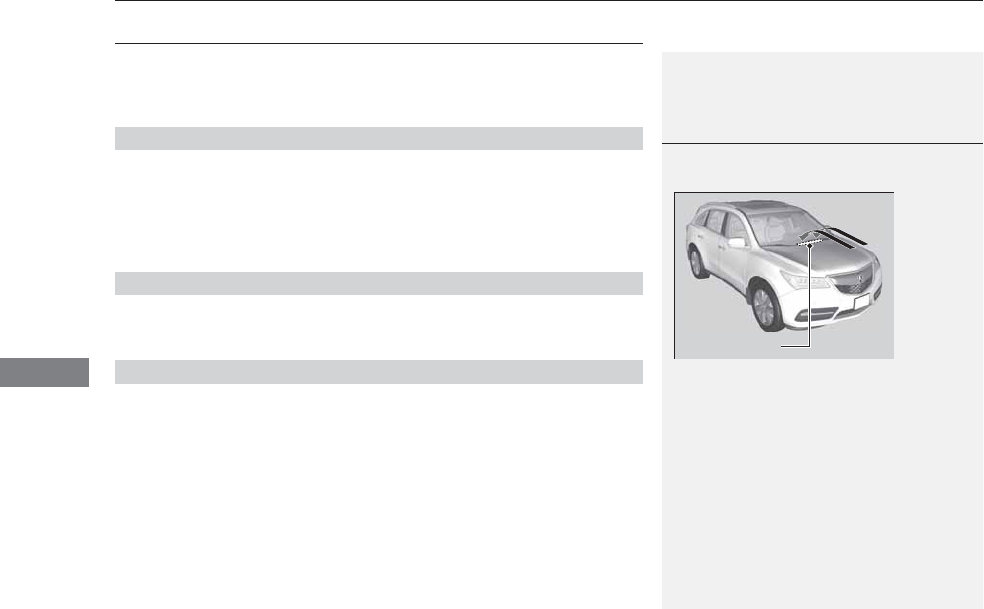
434
uuCleaninguExterior Care
Maintenance
Exterior Care
Dust off the vehicle body after you drive.
Regularly inspect your vehicle for scratches on painted surfaces. A scratch on a
painted surface can result in body rust. If you find a scratch, promptly repair it.
Wash the vehicle regularly. Wash more frequently when driving in the following
conditions:
•If driving on roads with road salt.
•If driving in coastal areas.
•If tar, soot, bird droppings, insects, or tree sap are stuck to painted surfaces.
Fold in the door mirrors.
Make sure to follow the instructions indicated on the automated car wash.
•Keep sufficient distance between the cleaning nozzle and the vehicle body.
•Take particular care around the windows. Standing too close may cause water to
enter the vehicle interior. Do not spray water into the engine compartment.
■Washing the Vehicle
■Using an Automated Car Wash
■Using High Pressure Cleaners
1Washing the Vehicle
Do not spray water into the air intake vents or engine
compartment. It can cause a malfunction.
Air Intake Vents
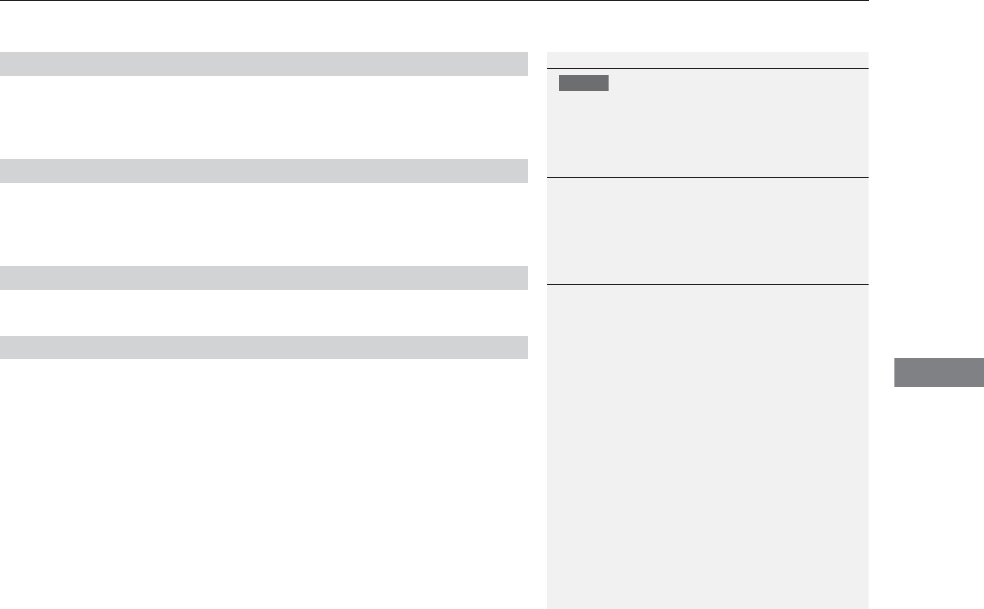
435
uuCleaninguExterior Care
Maintenance
A good coat of automotive body wax helps protect your vehicle’s paint from the
elements. Wax will wear off over time and expose your vehicle’s paint to the
elements, so reapply as necessary.
If you get gasoline, oil, engine coolant, or battery fluid on resin coated parts, they
may be stained or the coating may peel. Promptly wipe it away using a soft cloth and
clean water.
Wipe using a glass cleaner.
Aluminum is susceptible to deterioration caused by salt and other road
contaminants. Use a sponge and mild detergent to wipe away promptly.
Be careful not to use harsh chemicals (including some commercial wheel cleaners) or
a stiff brush. They can damage the clear coat of the aluminum alloy wheels that
helps keep the aluminum from corroding and tarnishing.
■Applying Wax
■Maintaining the Bumpers and Other Resin Coated Parts
■Cleaning the Window
■Maintaining Aluminum Wheels
1Applying Wax
NOTICE
Chemical solvents and strong cleaners can damage
the paint, metal, and plastic on your vehicle. Wipe up
spills immediately.
1Maintaining the Bumpers and Other Resin Coated Parts
Ask a dealer about the correct coating material when
you want to repair the painted surface of the parts
made of resin.
1Cleaning the Window
Wires are mounted to the inside of the rear window.
Wipe along the same direction as the wires with a
soft cloth so as not to damage them.
436
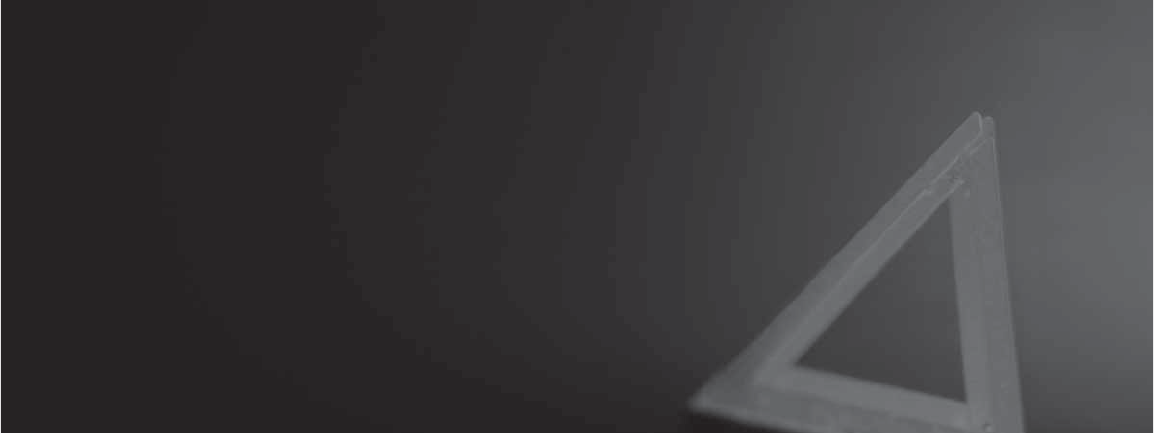
437
Handling the Unexpected
This chapter explains how to handle unexpected troubles.
Tools
Types of Tools.................................. 438
If a Tire Goes Flat
Changing a Flat Tire*....................... 439
Temporarily Repairing a Flat Tire*..... 446
Engine Does Not Start
Checking the Engine........................ 457
If the Keyless Access Remote Battery is
Weak ............................................. 458
Emergency Engine Stop ................... 459
Jump Starting.................................... 460
Shift Lever Does Not Move.............. 462
Overheating
How to Handle Overheating............. 463
Indicator, Coming On/Blinking
If the Low Oil Pressure Indicator Comes
On ............................................. 465
If the Charging System Indicator Comes
On ................................................. 465
If the Malfunction Indicator Lamp Comes
On or Blinks ................................... 466
If the Brake System Indicator (Red) Comes
On ....................................................467
If the Speed-Sensitive Electric Power Steering
(EPS) System Indicator Comes On........... 467
If the Low Tire Pressure/TPMS Indicator
Comes On or Blinks ....................... 468
Fuses
Fuse Locations ................................. 469
Inspecting and Changing Fuses........ 474
Emergency Towing........................... 475
When You Cannot Unlock the Fuel Fill
Door................................................. 476
When You Cannot Open the Tailgate
..477
* Not available on all models
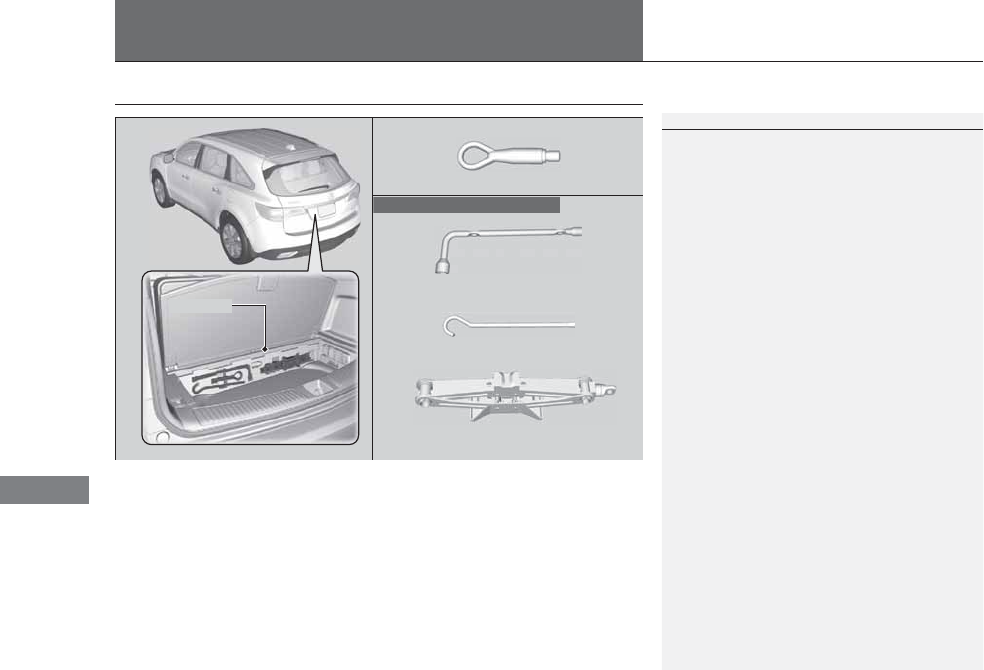
438
Handling the Unexpected
Tools
Types of Tools
1Types of Tools
The tools are stored in the cargo area.
Wheel Nut Wrench/
Jack Handle
Jack
Jack Handle Bar
Towing Hook
Tool Case
Models with a compact spare tire
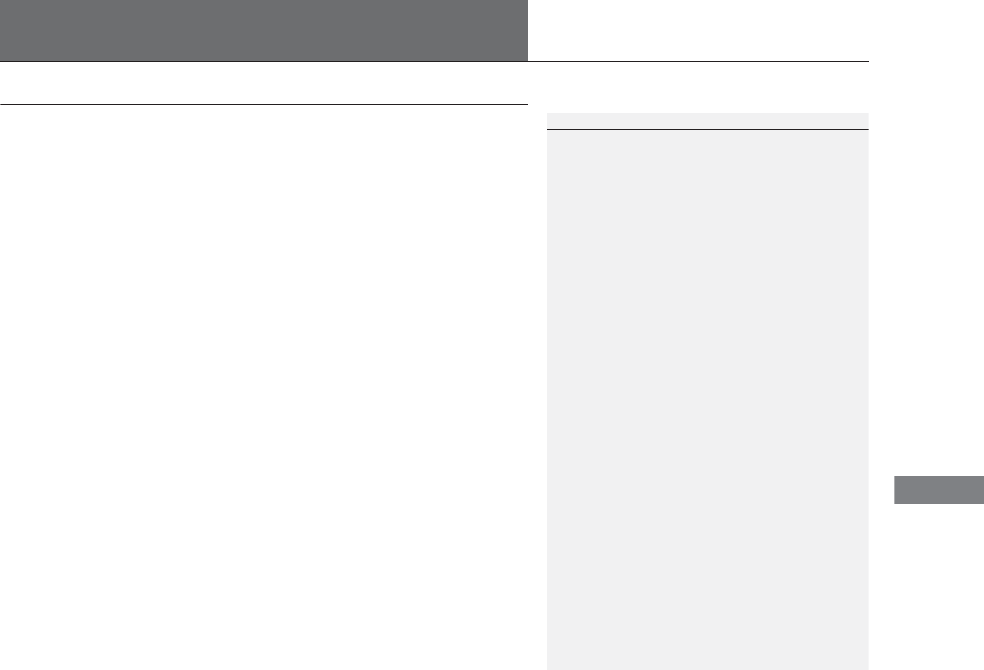
439
Continued
Handling the Unexpected
If a Tire Goes Flat
Changing a Flat Tire*
If a tire goes flat while driving, grasp the steering wheel firmly, and brake gradually
to reduce speed. Then, stop in a safe place. Replace the flat tire with a compact
spare tire. Go to a dealer as soon as possible to have the full-size tire repaired or
replaced.
1. Park the vehicle on firm, level, non-slippery surface and apply the parking brake.
2. Move the shift lever to (P.
3. Turn on the hazard warning lights and set the power mode to VEHICLE OFF
(LOCK).
1Changing a Flat Tire*
Periodically check the tire pressure of the compact
spare. It should be set to the specified pressure.
Specified Pressure: 60 psi (420 kPa, 4.2 kgf/cm2)
When driving with the compact spare tire, keep the
vehicle speed under 50 mph (80 km/h). Replace with
a full-size tire as soon as possible.
The compact spare tire and wheel in your vehicle are
specifically for this model.
Do not use them with another vehicle.
Do not use another type of compact spare tire or
wheel with your vehicle.
Do not mount tire chains on a compact spare tire.
If a chain-mounted front tire goes flat, remove one of
the full-size rear tires and replace it with the compact
spare tire. Remove the flat front tire and replace it
with the full-size tire that was removed from the rear.
Mount the tire chains on the front tire.
Do not use a puncture-repairing agent on a flat tire,
as it can damage the tire pressure sensor.
* Not available on all models
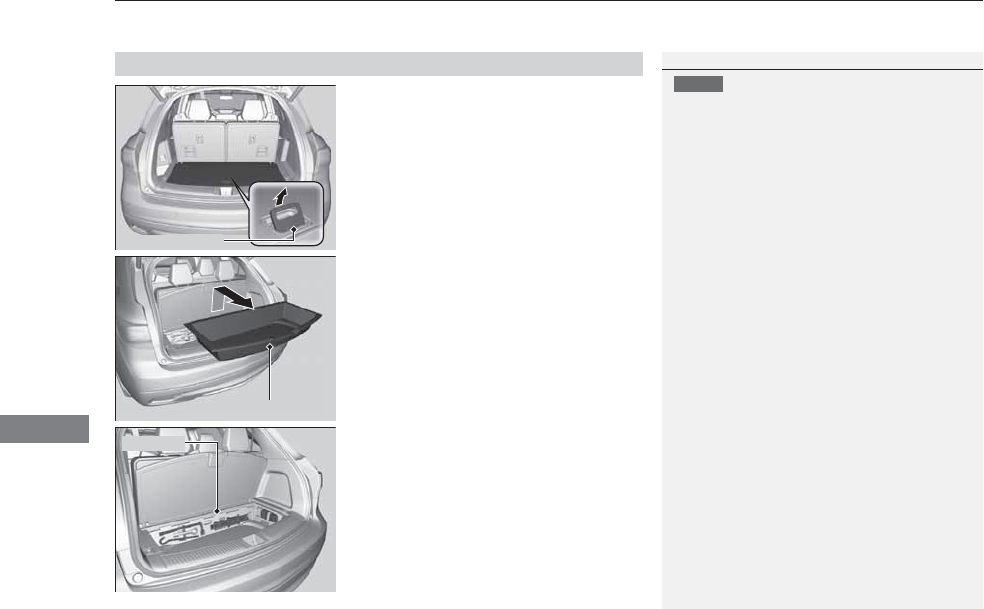
uuIf a Tire Goes FlatuChanging a Flat Tire*
440
Handling the Unexpected
1. Push the rear edge of the handle on the
floor lid and open the lid.
2. Take out the cargo floor box.
3. Take the jack, wheel nut wrench, and jack
handle bar out of the tool case.
■Getting Ready to Replace the Flat Tire
1Changing a Flat Tire*
NOTICE
Do not use the jack if it doesn’t work properly. Call
your dealer or a professional towing service.
Handle
Cargo Floor Box
Tool Case
* Not available on all models
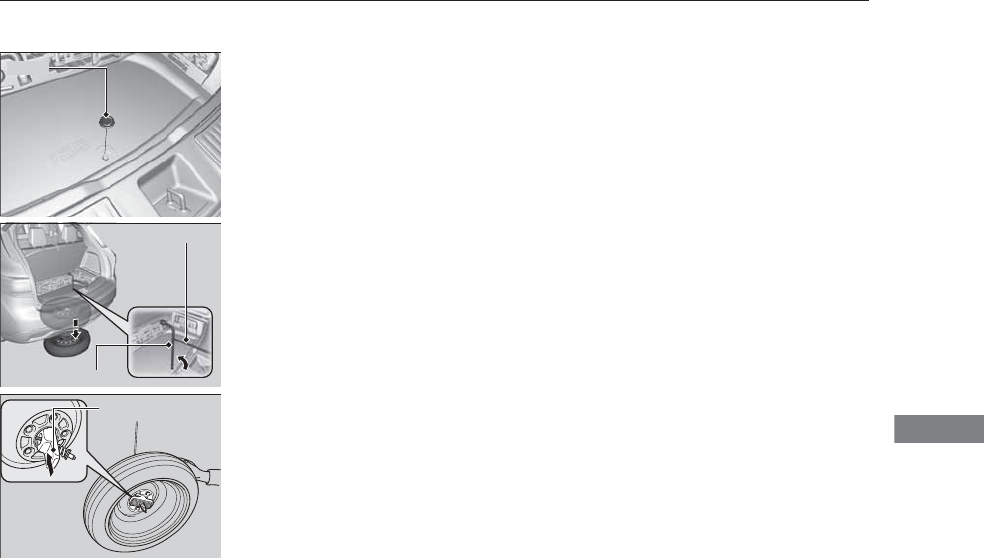
441
uuIf a Tire Goes FlatuChanging a Flat Tire*
Continued
Handling the Unexpected
4. Remove the cover on the cargo area lining
to access the shaft for the spare tire hoist.
5. Put the wheel nut wrench with the jack
handle bar on the hoist shaft.
Turn the wrench to the left to lower the
spare tire to the ground.
6. Keep turning the wheel nut wrench to
create slack in the cable.
7. Remove the bracket from the spare tire.
Cover
Jack Handle Bar
Wheel Nut Wrench
Bracket
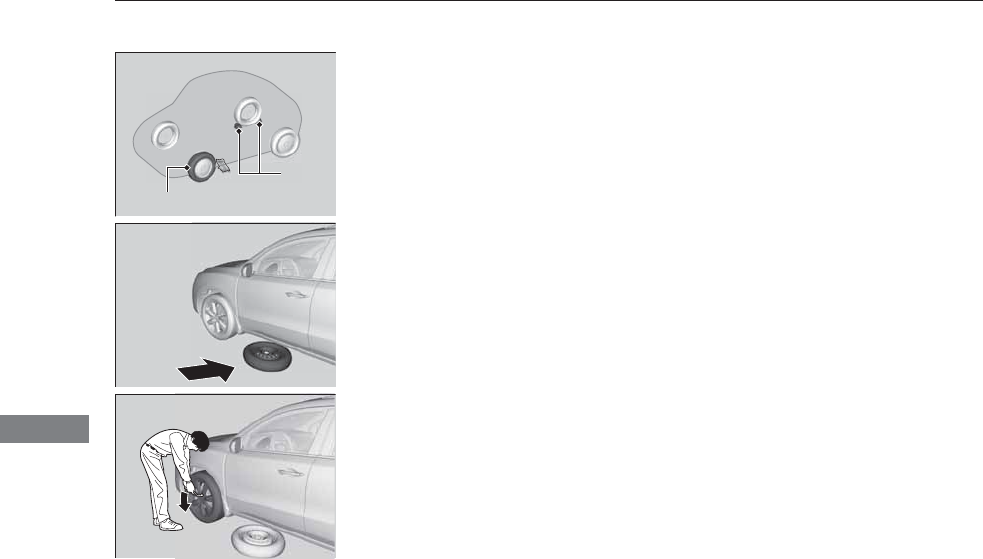
442
uuIf a Tire Goes FlatuChanging a Flat Tire*
Handling the Unexpected
8. Place a wheel block or rock in front and
rear of the wheel diagonal to the flat tire.
9. Place the compact spare tire wheel side up
under the vehicle body, near the tire that
needs to be replaced.
10. Loosen each wheel nut about one turn
using the wheel nut wrench.
Wheel
Blocks
The tire to be replaced.
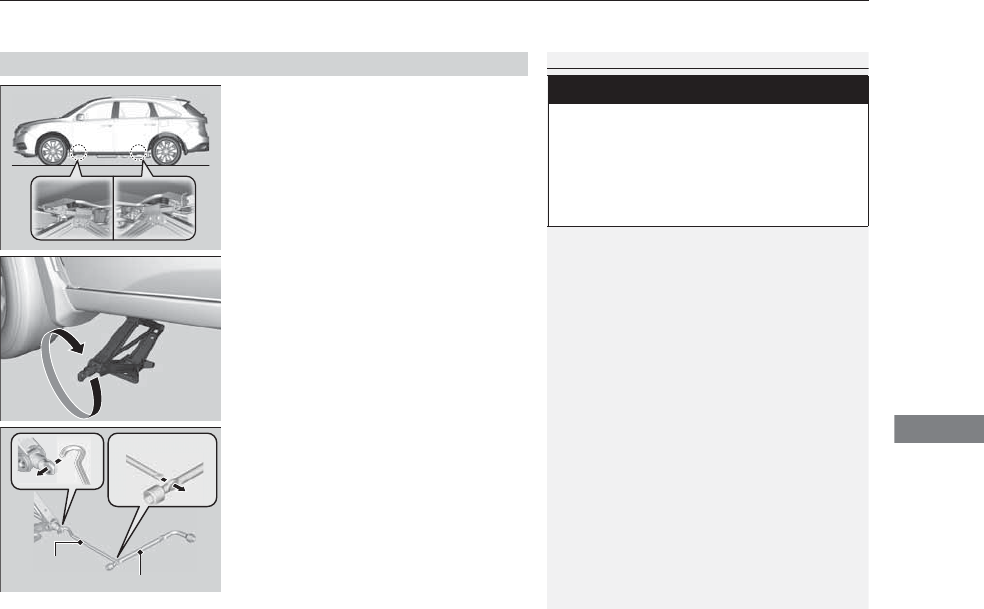
Continued 443
uuIf a Tire Goes FlatuChanging a Flat Tire*
Handling the Unexpected
1. Place the jack under the jacking point
closest to the tire to be changed.
2. Turn the end bracket clockwise as shown in
the image until the top of the jack contacts
the jacking point.
uMake sure that the jacking point tab is
resting in the jack notch.
3. Raise the vehicle, using the jack handle bar
and the jack handle, until the tire is off the
ground.
■How to Set Up the Jack
1How to Set Up the Jack
Do not use the jack with people or luggage in the
vehicle.
Use the jack provided in your vehicle.
Other jacks may not support the weight (“load”) or
may not fit in the jacking point.
The following instructions must be followed to use
the jack safely.
•Do not use while the engine is running.
•Use only where the ground is firm and level.
•Use only at the jacking points.
•Do not get in the vehicle while using the jack.
•Do not put anything on top of or underneath the
jack.
3
WARNING
The vehicle can easily roll off the jack,
seriously injuring anyone underneath.
Follow the directions for changing a tire
exactly, and never get under the vehicle
when it is supported only by the jack.
Jack Handle Bar
Wheel Nut Wrench as Jack Handle
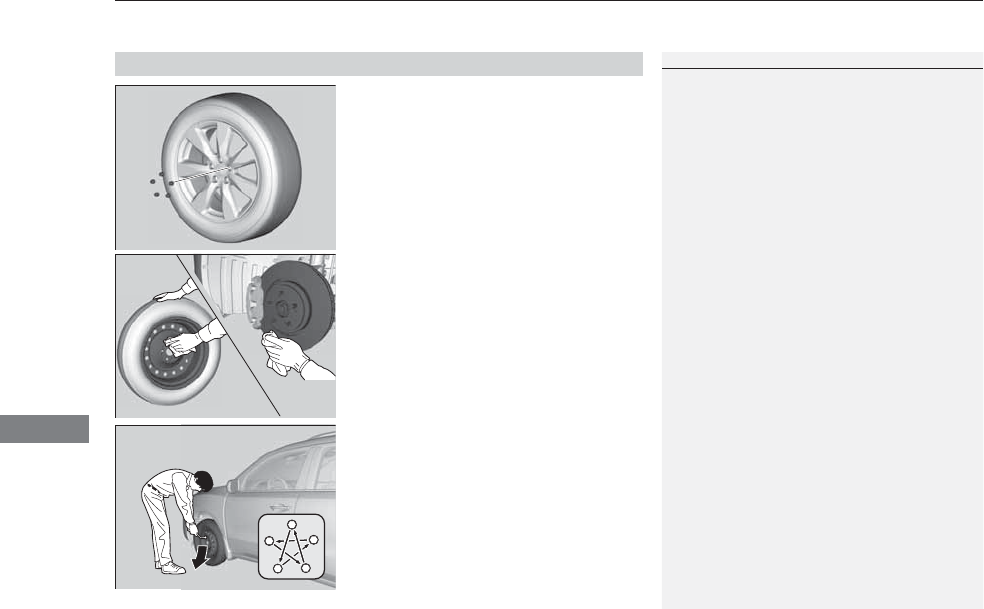
uuIf a Tire Goes FlatuChanging a Flat Tire*
444
Handling the Unexpected
1. Remove the wheel nuts and flat tire.
2. Wipe the mounting surfaces of the wheel
with a clean cloth.
3. Mount the compact spare tire.
4. Screw the wheel nuts until they touch the
lips around the mounting holes, then stop
rotating.
5. Lower the vehicle and remove the jack.
Tighten the wheel nuts in the order
indicated in the image. Go around,
tightening the nuts, two to three times in
this order.
Wheel nut torque:
80 lbf∙ft (108 N∙m, 11 kgf∙m)
■Replacing the Flat Tire
1Replacing the Flat Tire
Do not over tighten the wheel nuts by applying extra
torque using your foot or a pipe.
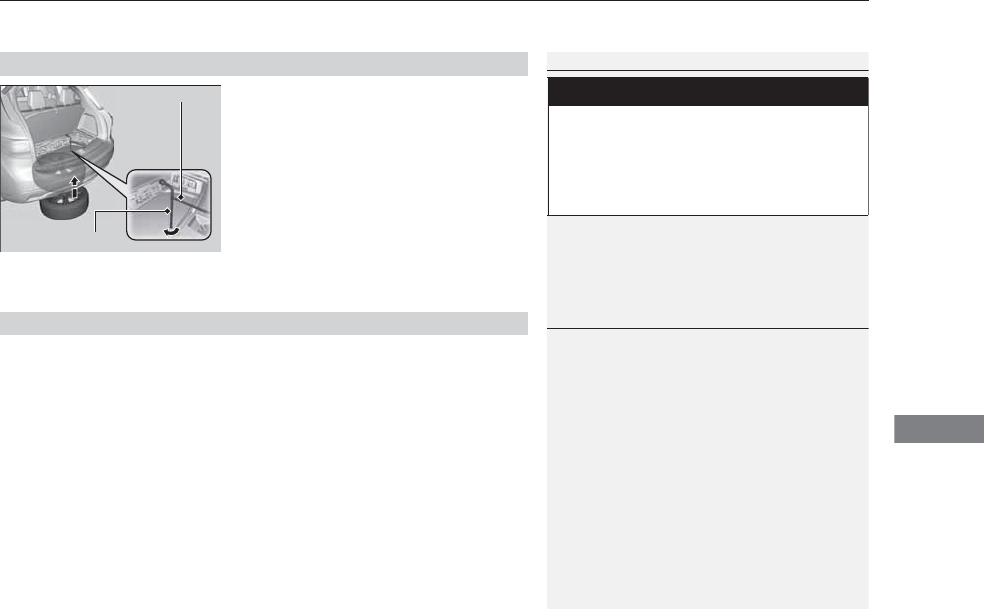
445
uuIf a Tire Goes FlatuChanging a Flat Tire*
Handling the Unexpected
1. Remove the center cap and place the flat
tire face up under the hoist.
2. Insert the hoist bracket into the center hole
of the flat tire.
3. Turn the wheel nut wrench with the jack
handle bar clockwise until the flat tire rests
against the underbody of the vehicle and
you hear the hoist click.
4. Securely put the jack and wheel nut wrench
back in the tool case. Store the case in the
cargo area.
If you replace a flat tire with the spare tire, the low tire pressure/TPMS indicator
comes on while you are driving. After driving for a few miles (kilometers), the
indicator will start blinking for a short time and then stay on. Tire Pressure
Monitor Problem appears on the multi-information display (MID), but this is
normal.
If you replace the tire with a specified regular tire, the warning message on the MID
and the low tire pressure/TPMS indicator will go off after a few miles (kilometers).
■Storing the Flat Tire
1Storing the Flat Tire
3
WARNING
Loose items can fly around the interior in a
crash and can seriously injure the
occupants.
Store the jack and tools securely before
driving.
Wheel Nut Wrench
Jack Handle Bar
■TPMS and the Spare Tire
1TPMS and the Spare Tire
The system cannot monitor the pressure of the spare
tire. Manually check the spare tire pressure to be sure
that it is correct.
Use the TPMS specific wheels. Each is equipped with
a tire pressure sensor mounted inside the tire behind
the valve stem.
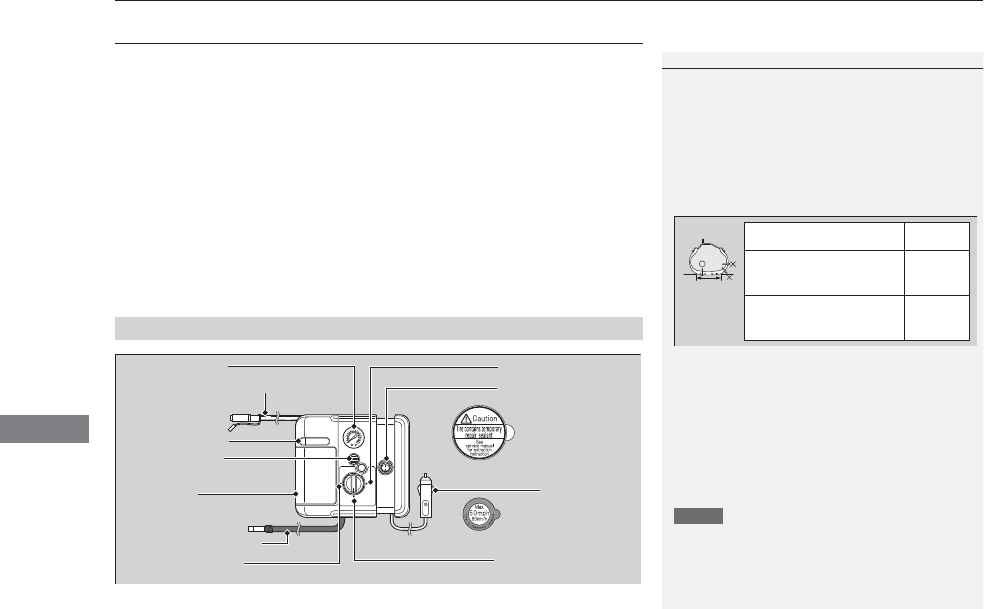
446
uuIf a Tire Goes FlatuTemporarily Repairing a Flat Tire *
Handling the Unexpected
Temporarily Repairing a Flat Tire*
If the tire has a large cut or is otherwise severely damaged, you will need to have the
vehicle towed. If the tire only has a small puncture, from a nail for instance, you can
use the temporary tire repair kit so that you can drive to the nearest service station
for a more permanent repair.
If a tire goes flat while driving, grasp the steering wheel firmly, and brake gradually
to reduce speed. Then stop in a safe place.
1. Park the vehicle on a firm, level, and non-slippery surface and apply the parking
brake.
2. Move the shift lever to (P.
3. Turn on the hazard warning lights and set the power mode to VEHICLE OFF
(LOCK).
■Getting Ready to Temporarily Repair the Flat Tire
1Temporarily Repairing a Flat Tire*
The kit should not be used in the following situations.
Instead, contact a dealer or a roadside assistant to
have the vehicle towed.
•The tire sealant has expired.
•More than two tires are punctured.
•The puncture or cut is larger than 3/16 inch (4mm).
•The tire side wall is damaged or the puncture is
outside the contact area.
•Damage has been caused by driving with the tire
extremely under inflated.
•The tire bead is no longer seated.
•The rim is damaged.
Do not remove a nail or screw that punctured the
tire. If you remove it from the tire, you may not be
able to repair the puncture using the kit.
NOTICE
Do not use a puncture-repairing agent other than the
one provided in the kit that came with your vehicle. If
a different agent is used, you may permanently
damage the tire pressure sensor.
When the puncture is: Kit Use
Smaller than 3/16 inch
(4 mm) Yes
Larger than 3/16 inch
(4 mm) No
Contact
Area
Instruction
Manual
Air Only Hose (Black) Speed Restriction Label
Repair Notification Label
Pressure Relief
Button
Inflator Switch
Selector Switch
SEALANT/AIR side
Sealant/Air Hose (Clear)
AIR ONLY side
Power Plug
Pressure Gauge
Tire Sealant
Expiration Date
* Not available on all models
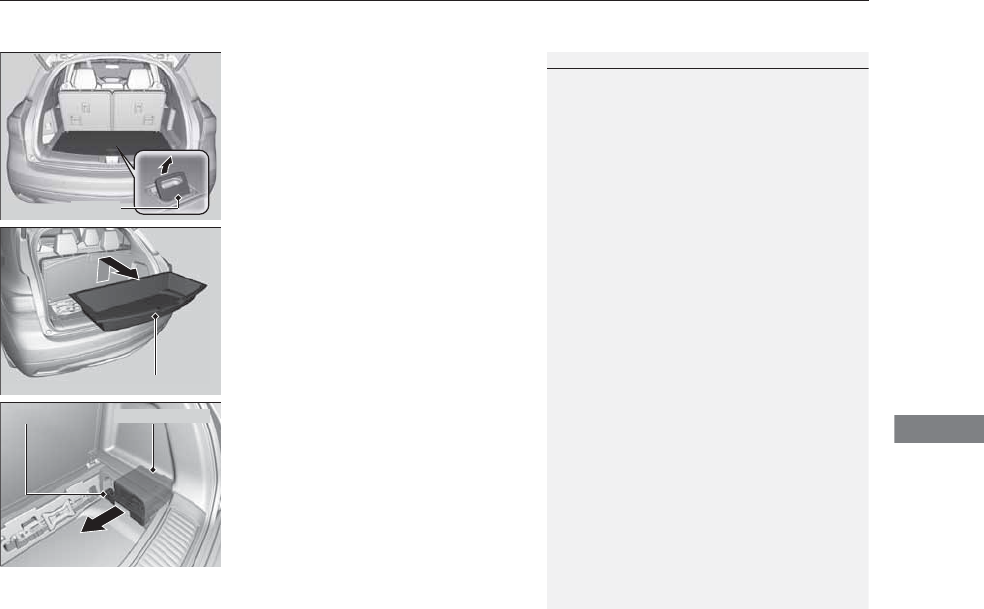
Continued 447
uuIf a Tire Goes FlatuTemporarily Repairing a Flat Tire*
Handling the Unexpected
1. Pull the handle on the cargo area floor lid
and open the lid.
2. Take out the cargo floor box.
3. Take the kit out of the case.
4. Place the kit face up, on flat ground near
the flat tire, and away from traffic. Do not
place the kit on its side.
1Getting Ready to Temporarily Repair the Flat Tire
When making a temporary repair, carefully read the
instruction manual provided with the kit.
Handle
Cargo Floor Box
Case Tire Repair Kit
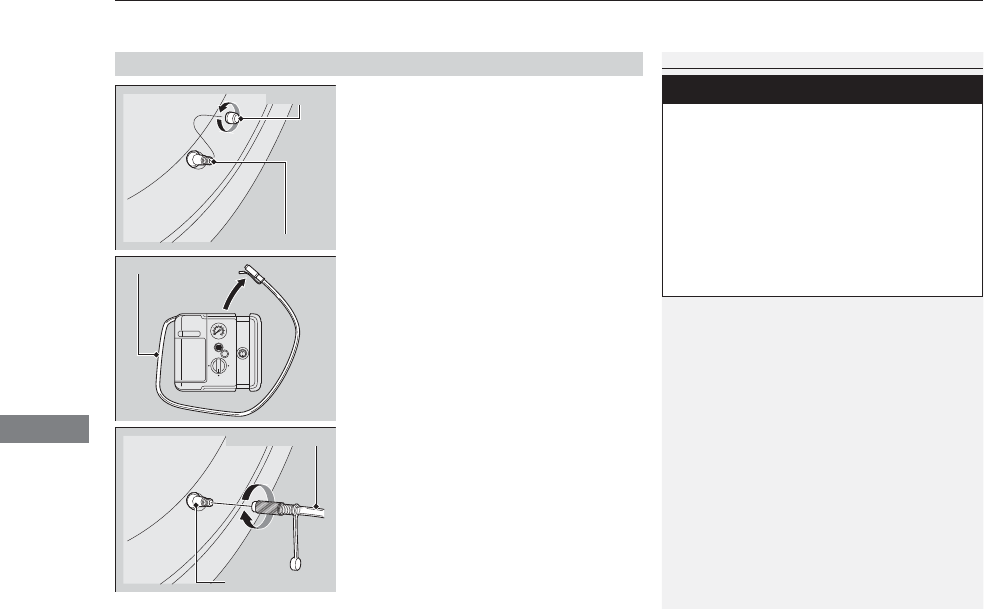
uuIf a Tire Goes FlatuTemporarily Repairing a Flat Tire *
448
Handling the Unexpected
1. Remove the valve cap from the tire valve
stem.
2. Remove the sealant/air hose from the
packaging.
3. Attach the sealant/air hose onto the tire
valve stem. Screw it until it is tight.
■Injecting Sealant and Air
1Injecting Sealant and Air
In cold temperatures, the sealant may not flow easily.
In this situation, warm it up for five minutes before
using.
The sealant can permanently stain clothing and other
materials. Be careful during handling and wipe away
any spills immediately.
3
WARNING
Tire sealant contains substances that are
harmful and can be fatal if swallowed.
If accidentally swallowed, do not induce
vomiting. Drink plenty of water and get
medical attention immediately.
For skin or eye contact, flush with cool
water and get medical attention if
necessary.
Valve Stem
Valve Cap
Sealant/Air Hose
Valve Stem
Sealant/Air Hose
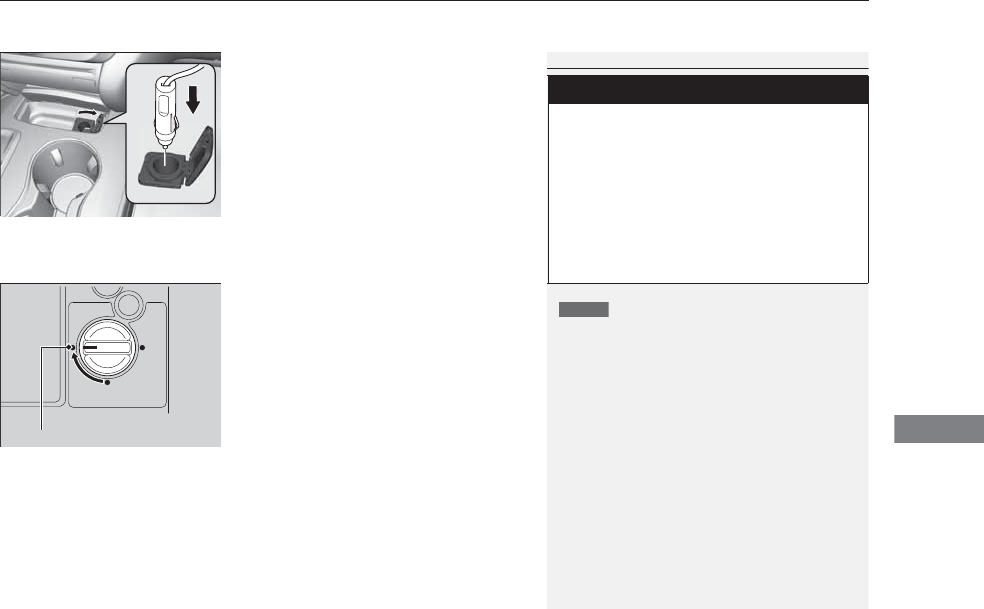
Continued 449
uuIf a Tire Goes FlatuTemporarily Repairing a Flat Tire*
Handling the Unexpected
4. Plug in the compressor to the accessory
power socket.
uBe careful not to pinch the cord in a
door or window.
uDo not plug any other electronic
devices into other accessory power
sockets.
2Accessory Power Sockets P. 178
5. Start the engine.
uKeep the engine running while injecting
sealant and air.
2Carbon Monoxide Gas P. 66
6. Turn the selector switch to SEALANT/
AIR.
1Injecting Sealant and Air
NOTICE
Do not operate the temporary tire repair kit
compressor for more than 15 minutes. The
compressor can overheat and become permanently
damaged.
Until the sealant injection is complete, the pressure
shown on the pressure gauge will appear higher than
actual. After the sealant injection is complete the
pressure will drop and then begin to rise again as the
tire is inflated with air. This is normal. To accurately
measure the air pressure using the gauge, turn the air
compressor off only after the sealant injection is
complete.
3
WARNING
Running the engine with the vehicle in an
enclosed or even partly enclosed area can
cause a rapid build-up of toxic carbon
monoxide.
Breathing this colorless, odorless gas can
cause unconsciousness and even death.
Only run the engine to power the air
compressor with the vehicle outdoors.
SEALANT/AIR side
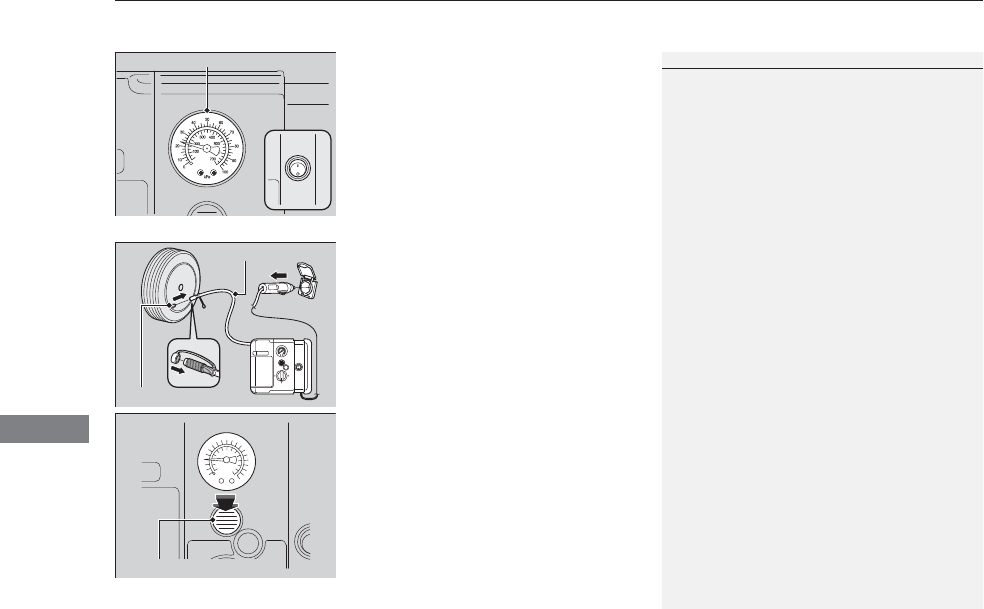
uuIf a Tire Goes FlatuTemporarily Repairing a Flat Tire *
450
Handling the Unexpected
7. Press the inflator switch to turn on the
compressor.
uThe compressor starts injecting sealant
and air into the tire.
8. When the sealant injection is complete,
continue to add air.
9. After the air pressure reaches 35 psi (240
kPa), turn off the kit.
uTo check the pressure, occasionally turn
off the compressor and read the gauge.
10. Unplug the power plug from the accessory
power socket.
11. Unscrew the sealant/air hose from the tire
valve stem. Reinstall the valve cap.
12. Press the pressure relief button until the
gauge returns to 0 psi (0 kPa).
Pressure Gauge
ON
OFF
1Injecting Sealant and Air
If the required air pressure is not reached within 15
minutes, the tire may be too severely damaged for
the kit to provide the necessary seal and your vehicle
will need to be towed.
See an Acura dealer for a replacement sealant bottle
and proper disposal of an empty bottle.
Sealant/Air Hose
Valve Stem
Pressure Relief Button
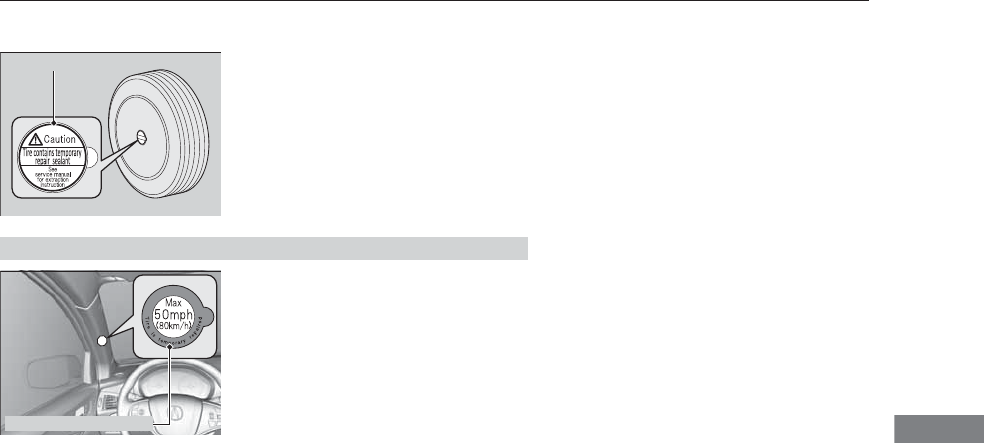
451
uuIf a Tire Goes FlatuTemporarily Repairing a Flat Tire*
Continued
Handling the Unexpected
13. Apply the repair notification label to the
flat surface of the wheel.
uThe wheel surface must be clean to
ensure the label adheres properly.
1. Apply the speed restriction label to the
location as shown.
2. Drive the vehicle for about 10 minutes.
uDo not exceed 50 mph (80 km/h).
3. Stop the vehicle in a safe place.
Repair Notification Label
■Distributing the Sealant in the Tire
Speed Restriction Label
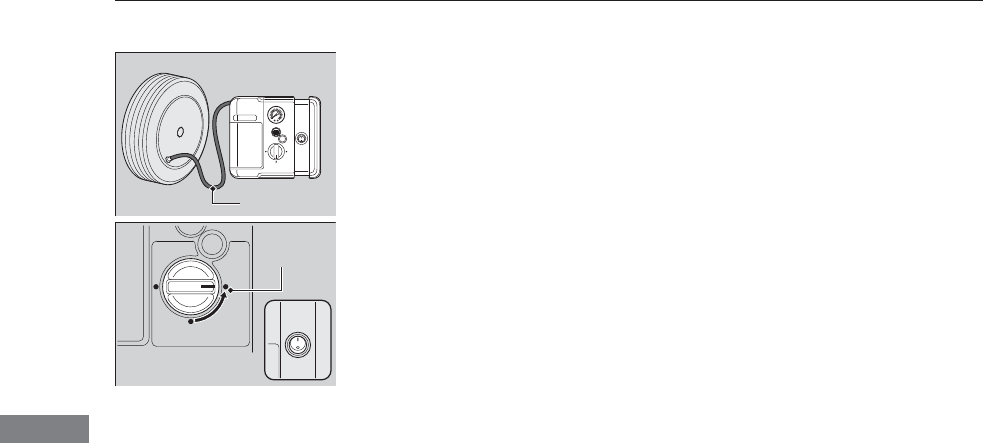
452
uuIf a Tire Goes FlatuTemporarily Repairing a Flat Tire *
Handling the Unexpected
4. Recheck the air pressure using the air only
hose on the compressor.
5. Turn the selector switch to AIR ONLY.
uDo not turn the air compressor on to
check the pressure.
2Inflating an Under-inflated Tire P. 454
6. If the air pressure is
•Less than 19 psi (130 kPa):
Do not add air or continue driving. The leak
is too severe. Call for help and have your
vehicle towed.
2Emergency Towing P. 475
•35 psi (240 kPa) or more:
Continue driving for another 10 minutes or
until you reach the nearest service station.
Do not exceed 50 mph (80 km/h).
uIf the air pressure does not go down after
the 10 minute driving, you do not need
to check the pressure any more.
Air Only Hose
AIR ONLY
side
ON
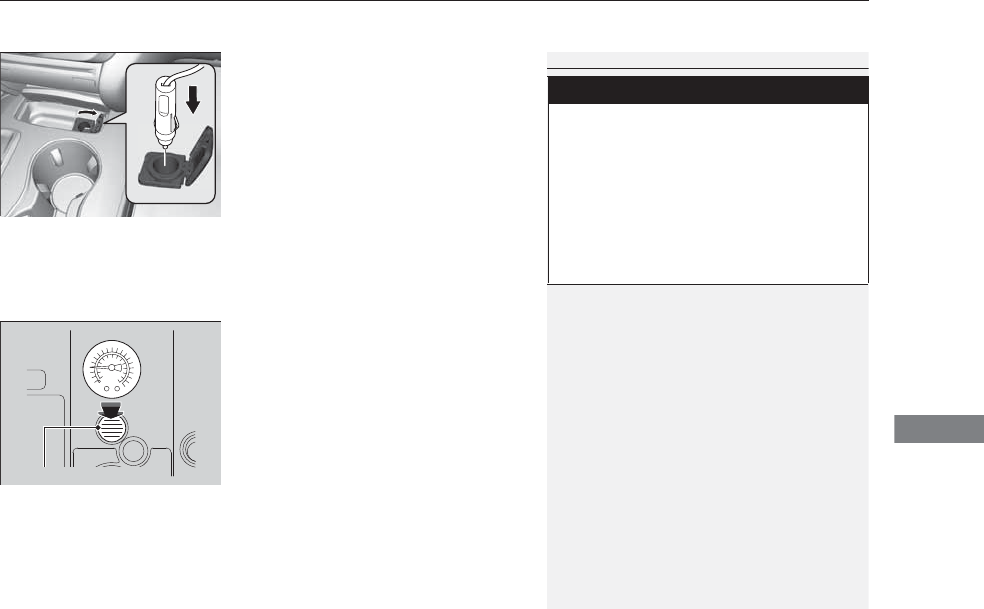
Continued 453
uuIf a Tire Goes FlatuTemporarily Repairing a Flat Tire*
Handling the Unexpected
•Greater than 19 psi (130 kPa), but less
than 35 psi (240 kPa):
Turn the air compressor on to inflate the
tire until the tire pressure reaches 35 psi
(240 kPa).
Turn the air compressor on to inflate the
tire until the tire pressure reaches front: 35
psi (240 kPa)/rear: 33 psi (230 kPa).
2Inflating an Under-inflated Tire P. 454
Then drive carefully for 10 more minutes or
until you reach the nearest service station.
Do not exceed 50 mph (80 km/h).
uYou should repeat this procedure as long
as the air pressure is within this range.
7. Press the pressure relief button until the
gauge returns to 0 psi (0 kPa).
8. Repackage and properly stow the kit.
Pressure Relief Button
1Distributing the Sealant in the Tire
33
WARNING
Running the engine with the vehicle in an
enclosed or even partly enclosed area can
cause a rapid build-up of toxic carbon
monoxide.
Breathing this colorless, odorless gas can
cause unconsciousness and even death.
Only run the engine to power the air
compressor with the vehicle outdoors.
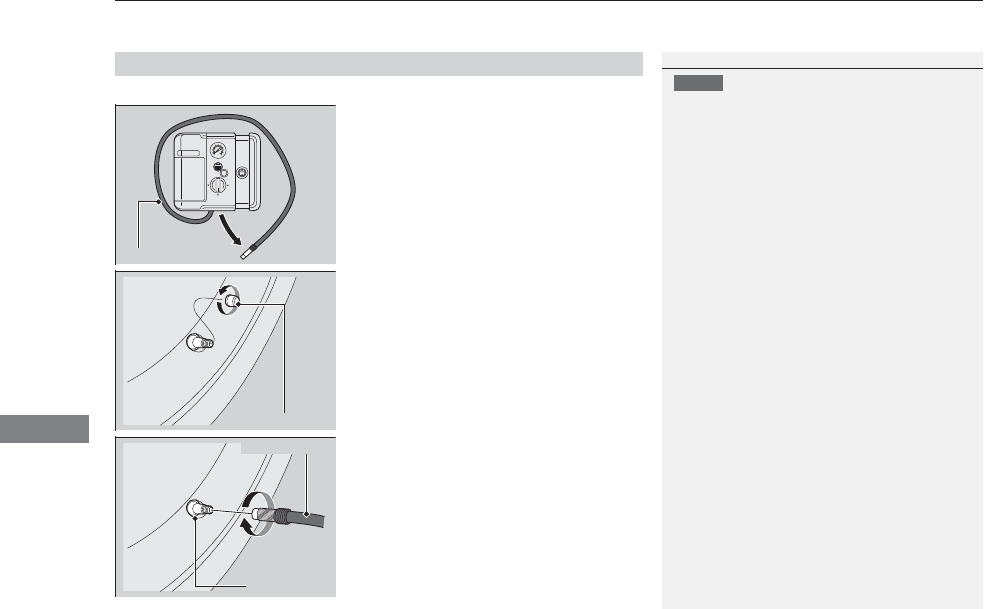
uuIf a Tire Goes FlatuTemporarily Repairing a Flat Tire *
454
Handling the Unexpected
You can use the kit to inflate a non-punctured under-inflated tire.
1. Open the cargo area floor lid.
2Getting Ready to Temporarily Repair
the Flat Tire P. 446
2. Remove the kit from the case.
3. Place the kit, face up, on flat ground near
the flat tire, away from traffic. Do not
place the kit on its side.
4. Remove the air only hose from the kit.
5. Remove the valve cap.
6. Attach the air only hose onto the tire valve
stem. Screw it until it is tight.
■Inflating an Under-inflated Tire
1Inflating an Under-inflated Tire
NOTICE
Do not operate the temporary tire repair kit
compressor for more than 15 minutes. The
compressor can overheat and become permanently
damaged.
Air Only Hose
Valve Cap
Valve Stem
Air Only Hose
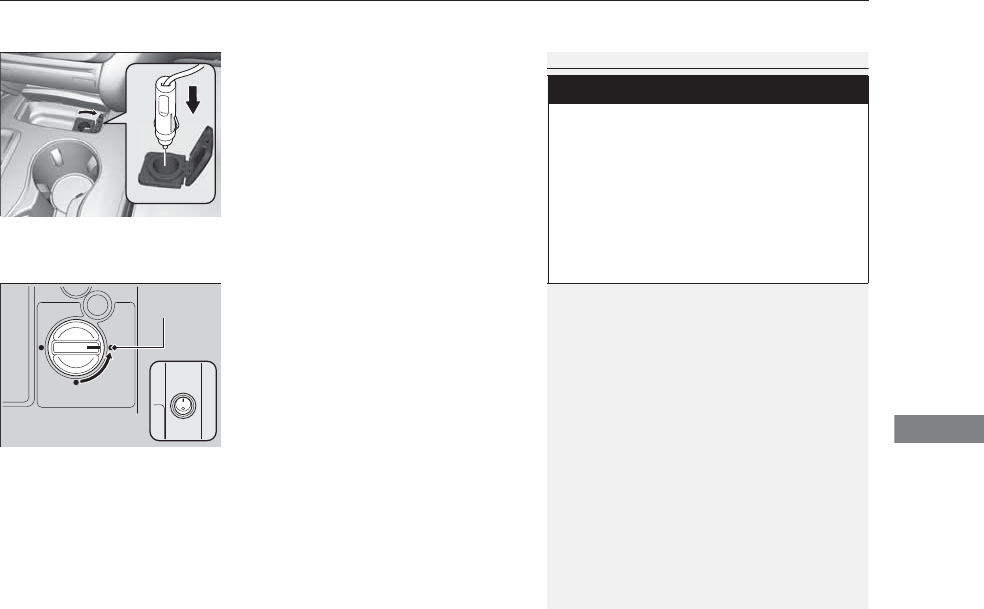
Continued 455
uuIf a Tire Goes FlatuTemporarily Repairing a Flat Tire*
Handling the Unexpected
7. Plug in the kit to the accessory power
socket.
uBe careful not to pinch the cord in a
door or window.
uDo not plug any other electronic
devices into other accessory power
sockets.
2Accessory Power Sockets P. 178
8. Start the engine.
uKeep the engine running while injecting
air.
2Carbon Monoxide Gas P. 66
9. Turn the selector switch to AIR ONLY.
10. Press the inflator switch to turn on the kit.
uThe compressor starts to inject air into
the tire.
11. Inflate the tire to the specified air pressure.
1Inflating an Under-inflated Tire
3
WARNING
Running the engine with the vehicle in an
enclosed or even partly enclosed area can
cause a rapid build-up of toxic carbon
monoxide.
Breathing this colorless, odorless gas can
cause unconsciousness and even death.
Only run the engine to power the air
compressor with the vehicle outdoors.
AIR ONLY
side
ON
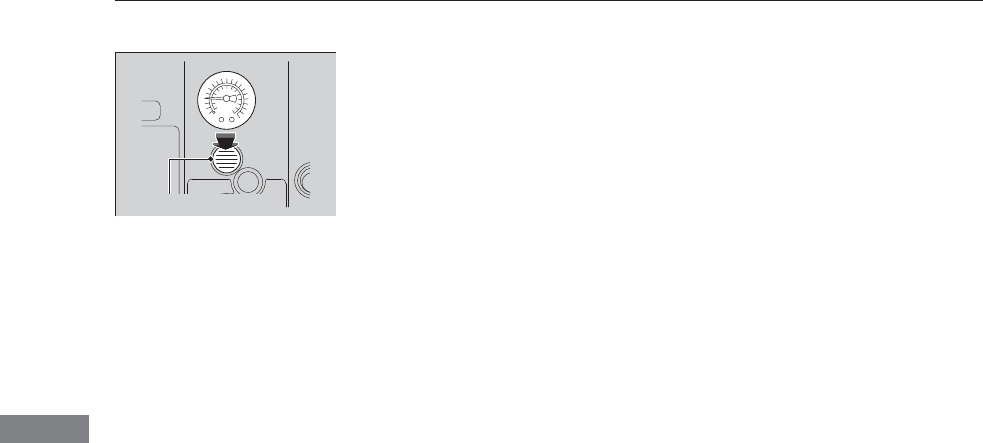
456
uuIf a Tire Goes FlatuTemporarily Repairing a Flat Tire *
Handling the Unexpected
12. Turn off the kit.
uCheck the pressure gauge on the air
compressor.
uIf overinflated, press the pressure relief
button.
13. Unplug the kit from the accessory power
socket.
14. Unscrew the air only hose from the tire
valve stem. Reinstall the valve cap.
15. Press the pressure relief button until the
gauge returns to 0 psi (0 kPa).
16. Repackage and properly stow the kit.
Pressure Relief Button
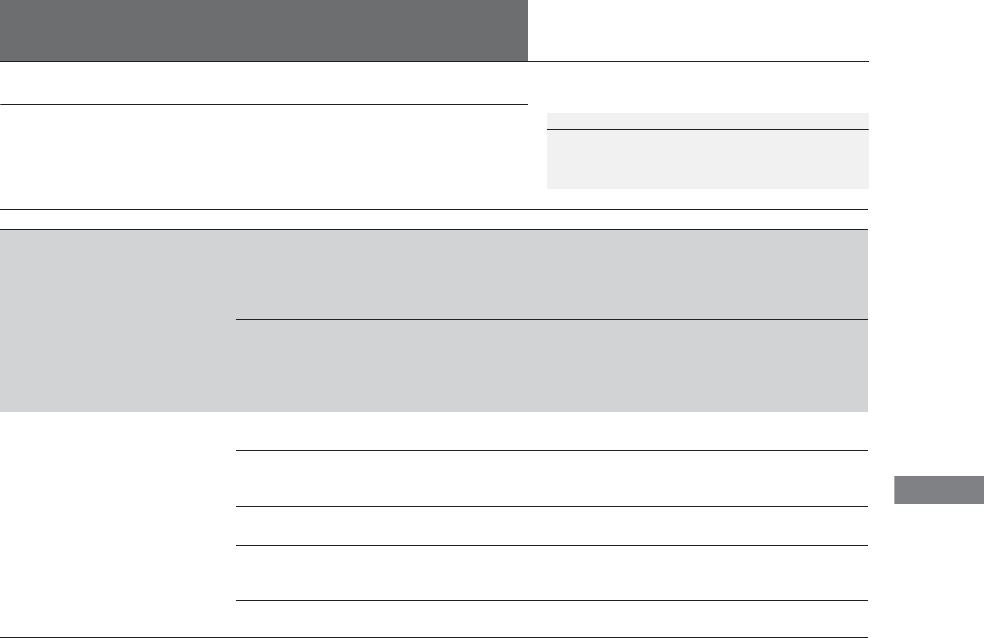
457
Handling the Unexpected
Engine Does Not Start
Checking the Engine
If the engine does not start, check the starter.
Starter condition Checklist
Starter doesn’t turn or turns
over slowly.
The battery may be dead. Check
each of the items on the right and
respond accordingly.
Check for a message on the MID.
●If the To Start, Hold Remote Near Start Button message appears
2If the Keyless Access Remote Battery is Weak P. 458
uMake sure the keyless access remote is in its operating range.
2ENGINE START/STOP Button Operating Range P. 141
Check the brightness of the interior lights.
Turn on the interior lights and check the brightness.
●If the interior lights are dim or do not come on at all
2Battery P. 426
●If the interior lights come on normally 2 Fuses P. 469
The starter turns over normally
but the engine doesn’t start.
There may be a problem with the
fuse. Check each of the items on
the right and respond accordingly.
Review the engine start procedure.
Follow its instructions, and try to start the engine again. 2 Starting the Engine P. 322
Check the immobilizer system indicator.
When the immobilizer system indicator is blinking, the engine cannot be started.
2Immobilizer System P. 135
Check the fuel level.
There should be enough fuel in the tank. 2 Fuel Gauge P. 97
Check the fuse.
Check all fuses, or have the vehicle checked by a dealer.
2Inspecting and Changing Fuses P. 474
If the problem continues:
2Emergency Towing P. 475
1Checking the Engine
If you must start the vehicle immediately, use an
assisting vehicle to jump start it.
2Jump Starting P. 460
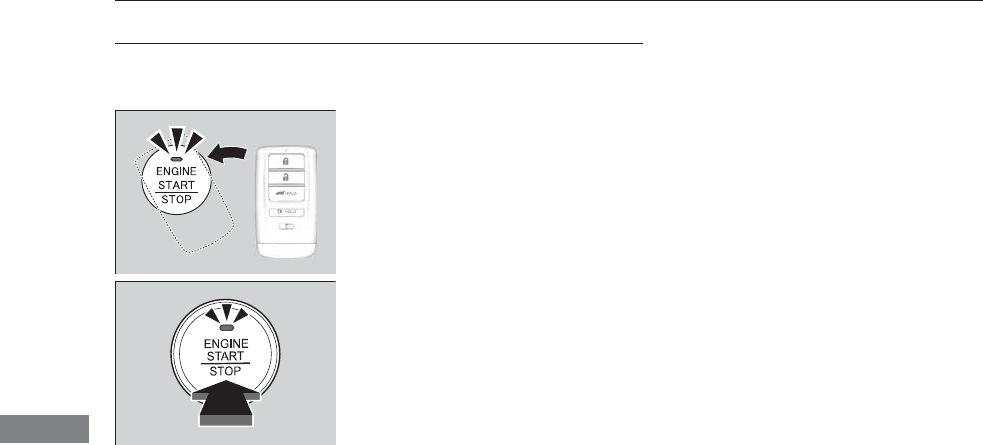
458
uuEngine Does Not StartuIf the Keyless Access Remote Battery is Weak
Handling the Unexpected
If the Keyless Access Remote Battery is Weak
If the beeper sounds, the To Start, Hold Remote Near Start Button message
appears on the MID, the indicator on the ENGINE START/STOP button flashes, and
the engine won’t start, start the engine as follows.
1. Touch the center of the ENGINE START/
STOP button with the A logo on the keyless
access remote while the indicator on the
ENGINE START/STOP button is flashing.
The buttons on the keyless access remote
should be facing you.
uThe indicator flashes for about 30
seconds.
2. Depress the brake pedal and press the
ENGINE START/STOP button within 10
seconds after the beeper sounds and the
indicator changes from flashing to on.
uIf you don’t depress the pedal, the mode
will change to ACCESSORY.
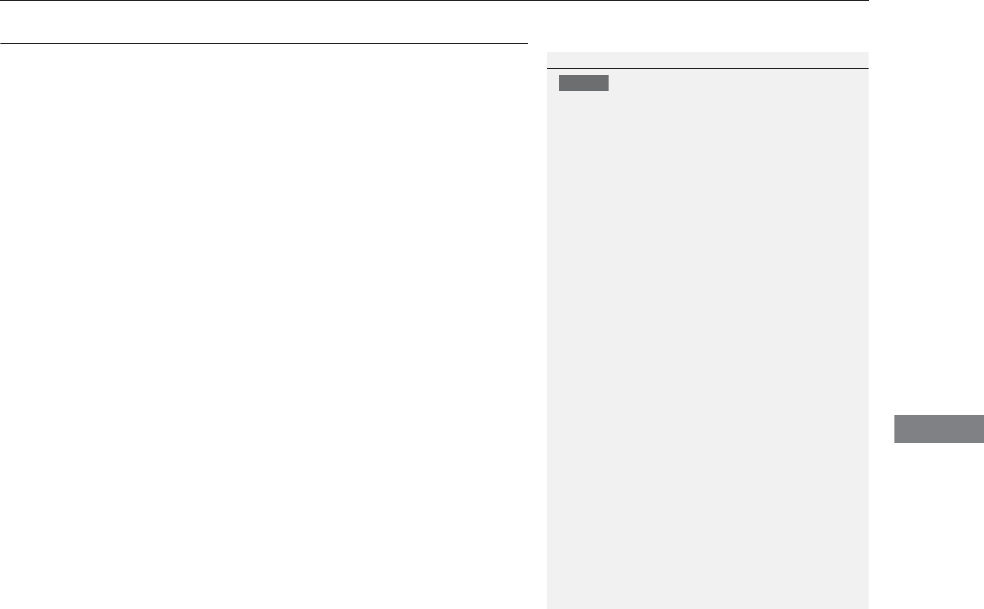
459
uuEngine Does Not StartuEmergency Engine Stop
Handling the Unexpected
Emergency Engine Stop
The ENGINE START/STOP button may be used to stop the engine due to an
emergency situation even while driving. If you must stop the engine, do either of the
following operations:
•Press and hold the ENGINE START/STOP button for about two seconds.
•Firmly press the ENGINE START/STOP button two times.
•The steering wheel will not lock. The power mode changes to VEHICLE OFF with
the shift lever in (P, and to ACCESSORY with the shift lever in any position other
than (P.
•Because turning off the engine also disables the power assist the engine provides
to the steering and braking systems, it will require significantly more physical
effort and time to steer and slow the vehicle. Downshift gears and use both feet
on the brake pedal, if necessary, to slow the vehicle and stop immediately in a
safe place.
1Emergency Engine Stop
NOTICE
Do not press the button while driving unless it is
absolutely necessary for the engine to be switched
off.
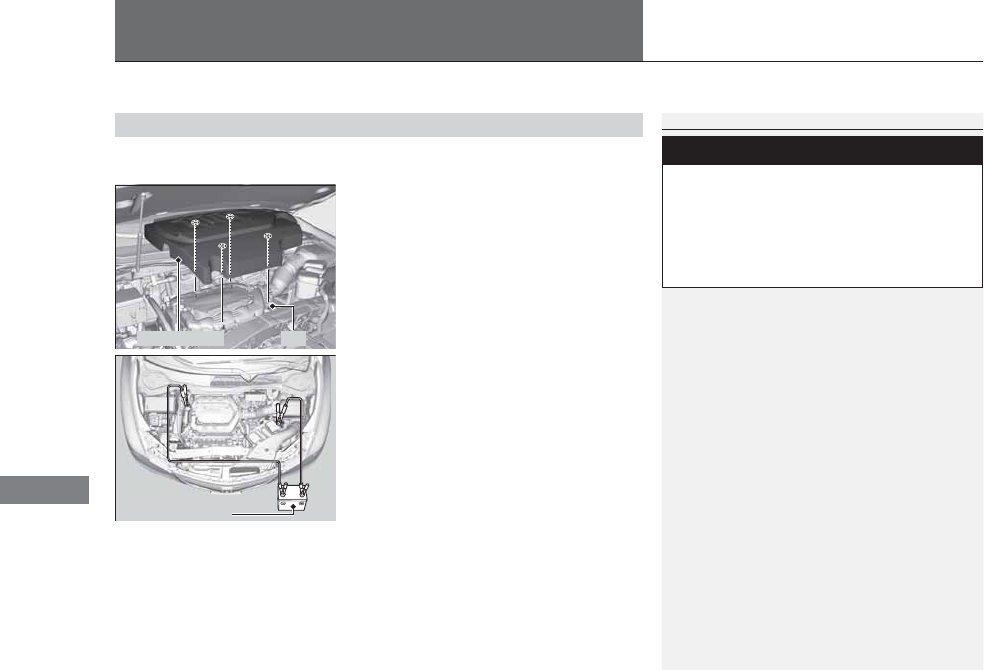
460
Handling the Unexpected
Jump Starting
Turn off the power to electric devices, such as audio and lights. Turn off the engine,
then open the hood.
1. Pull up on the engine cover, remove it from
the pins.
2. Connect the first jumper cable to your
vehicle’s battery + terminal.
3. Connect the other end of the first jumper
cable to the booster battery + terminal.
uUse a 12-volt booster battery only.
4. Connect the second jumper cable to the
booster battery - terminal.
■Jump Starting Procedure
1Jump Starting
Securely attach the jumper cables clips so that they
do not come off when the engine vibrates. Also be
careful not to tangle the jumper cables or allow the
cable ends to touch each other while attaching or
detaching the jumper cables.
Battery performance degrades in cold conditions and
may prevent the engine from starting.
3
WARNING
A battery can explode if you do not follow
the correct procedure, seriously injuring
anyone nearby.
Keep all sparks, open flames, and smoking
materials away from the battery.
Engine Cover Pin
Booster Battery
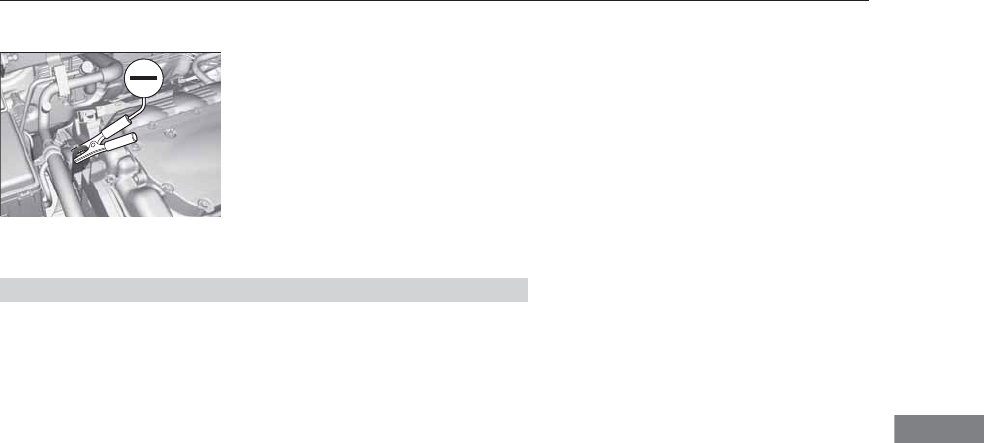
461
uuJump Startingu
Handling the Unexpected
5. Connect the other end of the second
jumper cable to the engine hanger as
shown.
Do not connect this jumper cable to any
other part.
6. If your vehicle is connected to another
vehicle, start the assisting vehicle’s engine
and increase its rpm slightly.
7. Attempt to start your vehicle’s engine. If it
turns over slowly, check that the jumper
cables have good metal-to-metal contact.
Once your vehicle’s engine has started, remove the jumper cables in the following
order.
1. Disconnect the jumper cable from your vehicle’s ground.
2. Disconnect the other end of the jumper cable from the booster battery -
terminal.
3. Disconnect the jumper cable from your vehicle’s battery + terminal.
4. Disconnect the other end of the jumper cable from the booster battery +
terminal.
Have your vehicle inspected by a nearby service station or a dealer.
■What to Do After the Engine Starts
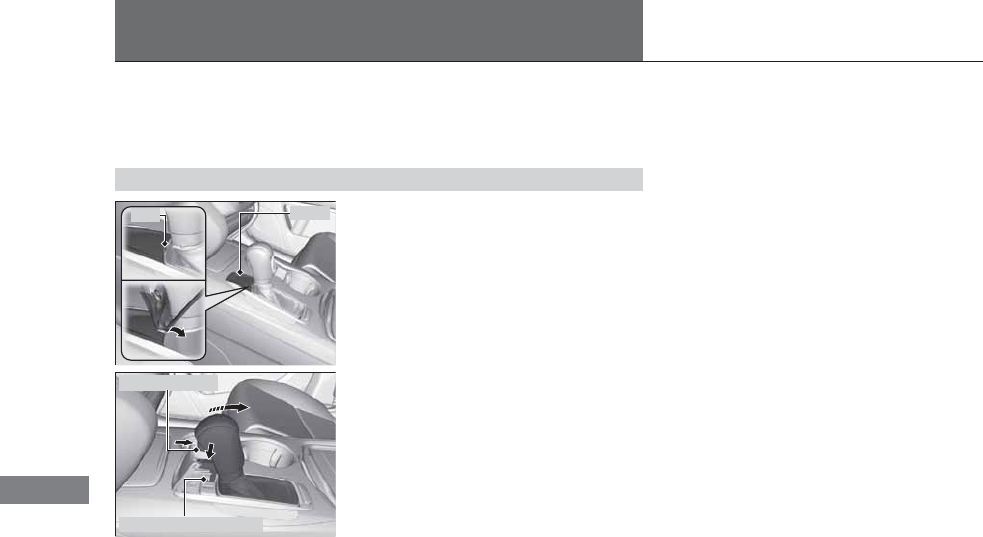
462
Handling the Unexpected
Shift Lever Does Not Move
Follow the procedure below if you cannot move the shift lever out of the (P
position.
1. Set the parking brake.
2. Remove the built-in key from the keyless
access remote.
3. Wrap a cloth around the tip of a small flat-
tip screwdriver. Place it at the back of the
release lock cover, and remove the cover.
4. Insert the key into the shift lock release slot.
5. While pushing the key down, press the shift
lever release button and place the shift lever
into (N.
uThe lock is now released. Have the shift
lever checked by a dealer as soon as
possible.
■Releasing the Lock
Cover
Slot
Release Button
Shift Lock Release Slot
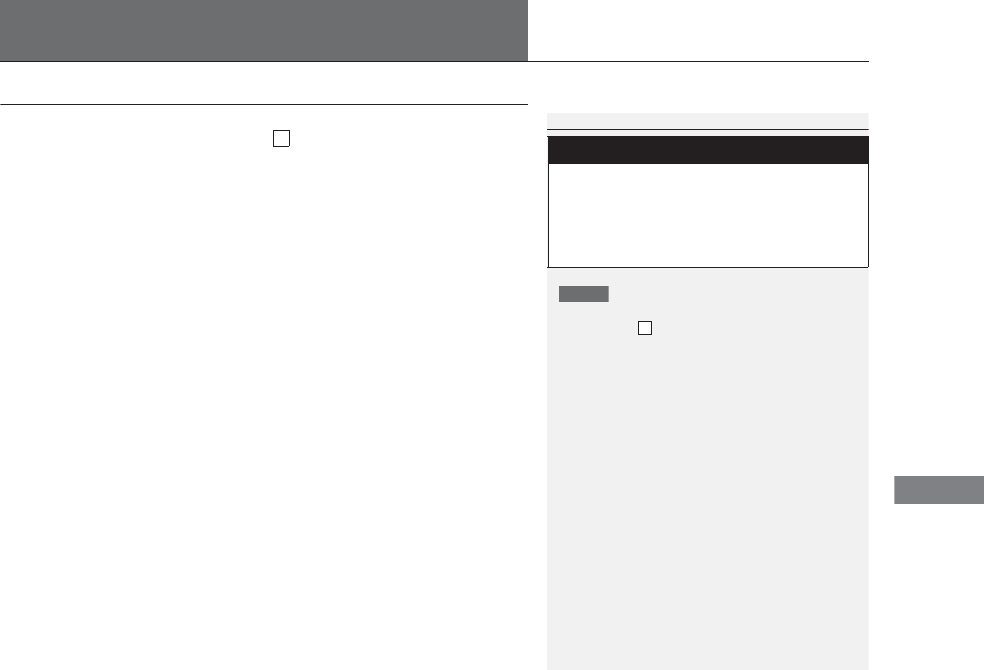
463
Continued
Handling the Unexpected
Overheating
How to Handle Overheating
Overheating symptoms are as follows:
•The temperature gauge needle is at the mark or the engine suddenly loses
power.
•Steam or spray comes out of the engine compartment.
■First thing to do
1. Immediately park the vehicle in a safe place.
2. Turn off all accessories and turn on the hazard warning lights.
uNo steam or spray present: Keep the engine running and open the hood.
uSteam or spray is present: Turn off the engine and wait until it subsides.
Then, open the hood.
1How to Handle Overheating
NOTICE
Continuing to drive with the temperature gauge
needle at the mark may damage the engine.
3
WARNING
Steam and spray from an overheated
engine can seriously scald you.
Do not open the hood if steam is coming
out.
H
H
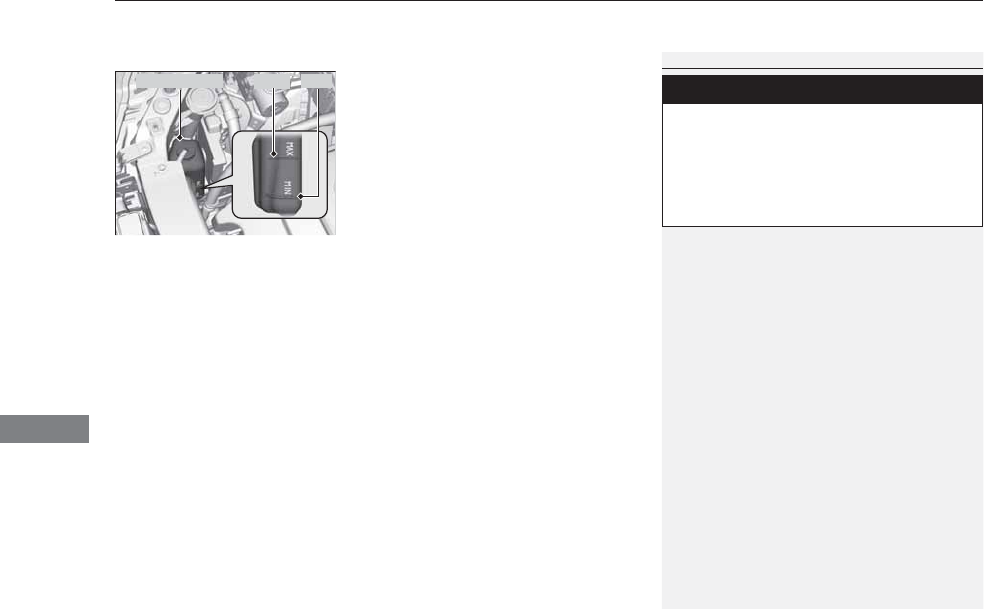
uuOverheatinguHow to Handle Overheating
464
Handling the Unexpected
■Next thing to do
1. Check that the cooling fan is operating and
stop the engine once the temperature
gauge needle goes down.
uIf the cooling fan is not operating,
immediately stop the engine.
2. Once the engine has cooled down, inspect
the coolant level and check the cooling
system components for leaks.
uIf the coolant level in the reserve tank is
low, add coolant until it reaches the
MAX mark.
uIf there is no coolant in the reserve tank,
check that the radiator is cool. Cover the
radiator cap with a heavy cloth and open
the cap. If necessary, add coolant up to
the base of the filler neck, and put the
cap back on.
■Last thing to do
Once the engine has cooled sufficiently, restart it and check the temperature gauge.
If the temperature gauge needle has gone down, resume driving. If it has not gone
down, contact a dealer for repairs.
1How to Handle Overheating
If the coolant is leaking, contact a dealer for repairs.
Use water as an emergency/temporary measure only.
Have a dealer flush the system with proper antifreeze
as soon as possible.
3
WARNING
Removing the radiator cap while the
engine is hot can cause the coolant to spray
out, seriously scalding you.
Always let the engine and radiator cool
down before removing the radiator cap.
Reserve Tank MAX MIN
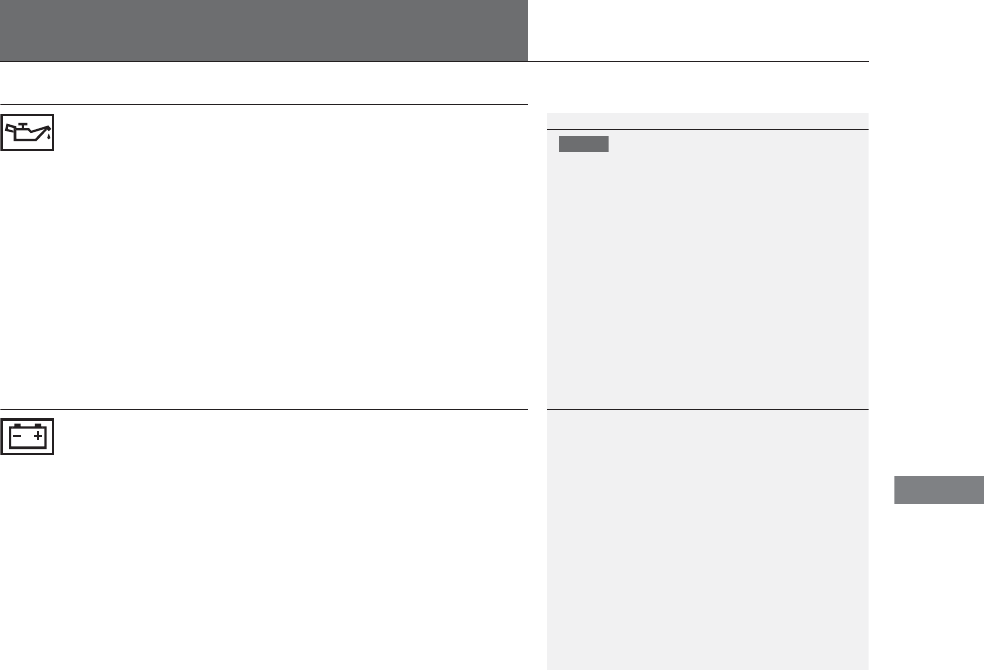
465
Handling the Unexpected
Indicator, Coming On/Blinking
If the Low Oil Pressure Indicator Comes On
■Reasons for the indicator to come on
Comes on when the engine oil pressure is low.
■What to do as soon as the indicator comes on
1. Immediately park the vehicle on level ground in a safe place.
2. If necessary, turn the hazard warning lights on.
■What to do after parking the vehicle
1. Stop the engine and let it sit for about three minutes.
2. Open the hood and check the oil level.
2Oil Check P. 399
3. Start the engine and check the low oil pressure indicator.
uThe indicator goes off: Start driving again.
uThe indicator does not go off within 10 seconds: Stop the engine
and contact a dealer for repairs immediately.
If the Charging System Indicator Comes On
■Reasons for the indicator to come on
Comes on when the battery is not being charged.
■What to do when the indicator comes on
Turn off the climate control system, rear defogger, and other electrical
systems, and immediately contact a dealer for repairs.
1If the Low Oil Pressure Indicator Comes On
NOTICE
Running the engine with low oil pressure can cause
serious mechanical damage almost immediately.
1If the Charging System Indicator Comes On
If you need to stop temporarily, do not turn off the
engine. Restarting the engine may rapidly discharge
the battery.
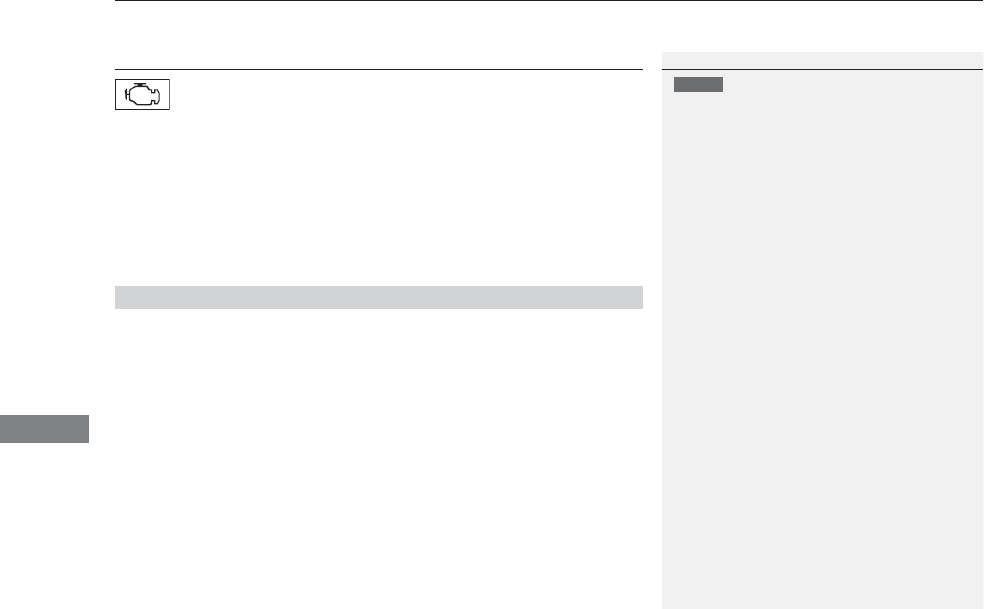
466
uuIndicator, Coming On/Blinking uIf the Malfunction Indicator Lamp Comes On or Blinks
Handling the Unexpected
If the Malfunction Indicator Lamp Comes On or
Blinks
■Reasons for the indicator lamp to come on or blink
•Comes on when there is a problem with the engine emissions control
system, or the fuel fill cap is missing, or loose.
•Blinks when engine misfiring is detected.
■What to do when the indicator lamp comes on
Avoid high speeds and immediately get your vehicle inspected at a
dealer.
■What to do when the indicator lamp blinks
Park the vehicle in a safe place with no flammable items and wait at least
10 minutes or more with the engine stopped until it cools.
■The message appears on when:
An evaporative system leak is detected. This may be caused by the fuel fill cap being
loose or not being installed.
■What to do when the message appears:
1. Stop the engine.
2. Check if the fuel fill cap is fully installed.
uIf not, loosen the cap, and then retighten it until it clicks at least once.
3. Drive for several days of normal driving.
uThe message should go off.
■When the malfunction indicator lamp comes on
Malfunction indicator lamp comes on if the system continues to detect a leak of the
gasoline vapor. If this happens, follow the procedures described earlier to check the
fuel fill cap.
■Tighten Fuel Cap Message
1If the Malfunction Indicator Lamp Comes On or Blinks
NOTICE
If you drive with the malfunction indicator lamp on,
the emissions control system and the engine could be
damaged.
If the malfunction indicator lamp blinks again when
restarting the engine, drive to the nearest dealer at
31 mph (50 km/h) or less. Have your vehicle
inspected.
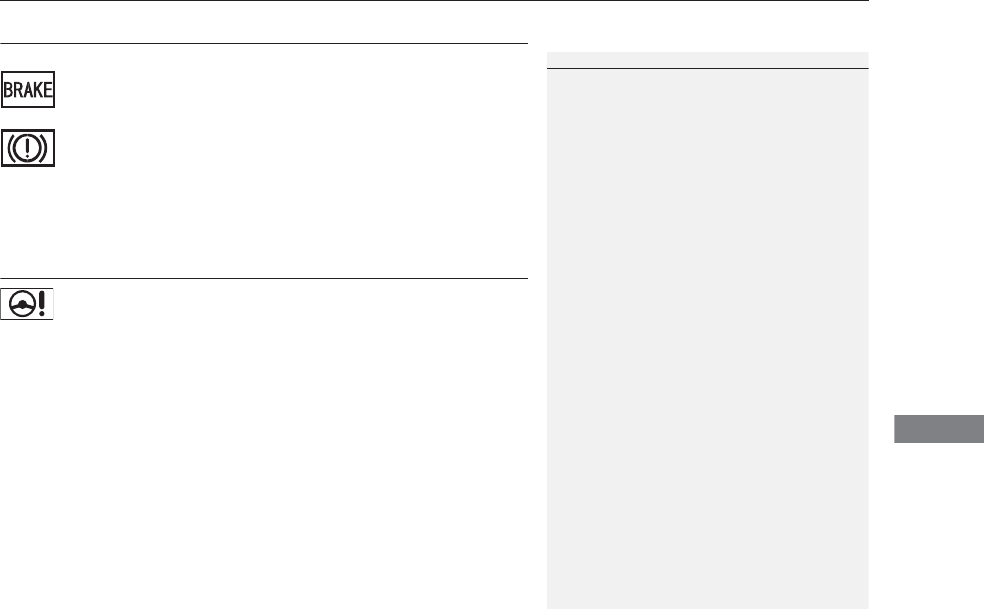
467
uuIndicator, Coming On/BlinkinguIf the Brake System Indicator (Red) Comes On
Handling the Unexpected
If the Brake System Indicator (Red) Comes On
■Reasons for the indicator to come on
•The brake fluid is low.
•There is a malfunction in the brake system.
■What to do when the indicator comes on while driving
Press the brake pedal lightly to check pedal pressure.
•If normal, check the brake fluid level the next time you stop.
•If abnormal, take immediate action. If necessary, downshift the
transmission to slow the vehicle using engine braking.
If the Speed-Sensitive Electric Power Steering (EPS)
System Indicator Comes On
■Reasons for the indicator to come on
•Comes on when there is a problem with the EPS system.
•If you depress the accelerator pedal repeatedly to increase the engine
speed while the engine is idling, the indicator comes on, and
sometimes the steering wheel becomes harder to operate.
■What to do when the indicator comes on
Stop the vehicle in a safe place and restart the engine.
If the indicator comes on and stays on, immediately have your vehicle
inspected by a dealer.
1If the Brake System Indicator (Red) Comes On
Have your vehicle repaired immediately.
It is dangerous to drive with low brake fluid. If there
is no resistance from the brake pedal, stop
immediately in a safe place. If necessary downshift
the gears.
If the brake system indicator and ABS indicator come
on simultaneously, the electronic brake distribution
system is not working. This can result in vehicle
instability under sudden braking.
Have your vehicle inspected by a dealer immediately.
U.S.
Canada
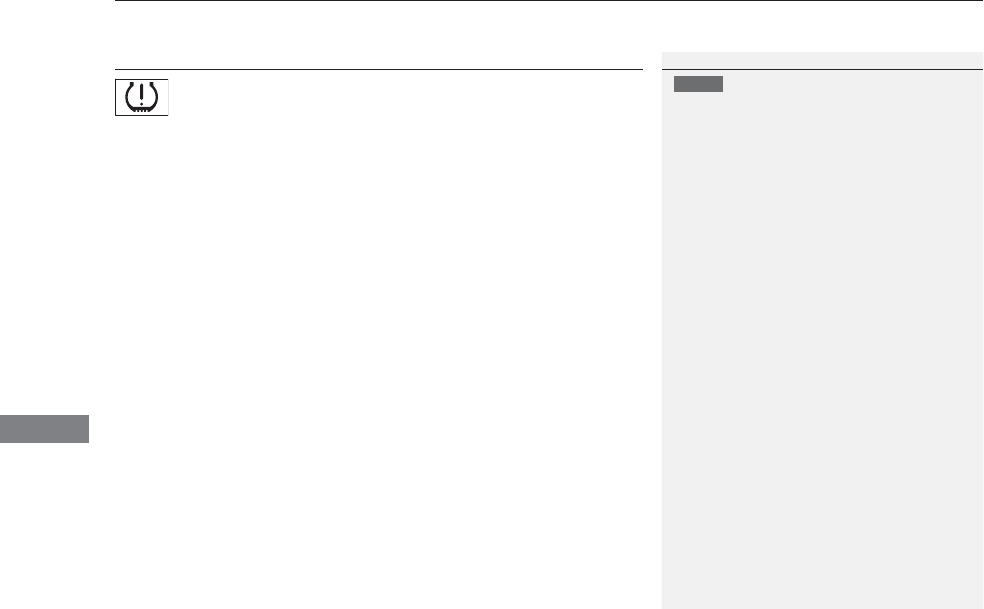
468
uuIndicator, Coming On/Blinking uIf the Low Tire Pressure/TPMS Indicator Comes On or Blinks
Handling the Unexpected
If the Low Tire Pressure/TPMS Indicator Comes On or
Blinks
■Reasons for the indicator to come on or blink
A tire pressure is significantly low. If there is a problem with the TPMS or
the compact spare tire* is installed, the indicator blinks for about one
minute, and then stays on.
■What to do when the indicator comes on
Stop your vehicle in a safe place. Check the tire pressure and adjust the
pressure to the specified level. The specified tire pressure is on a label on
the driver side doorjamb.
■What to do when the indicator blinks
Have the tire inspected by a dealer as soon as possible. If the compact
spare tire* causes the indicator to blink, change the tire to a full-size tire.
The indicator goes off after driving for a few miles (kilometers).
1If the Low Tire Pressure/TPMS Indicator Comes On or Blinks
NOTICE
Driving on an extremely underinflated tire can cause
it to overheat. An overheated tire can fail. Always
inflate your tires to the prescribed level.
* Not available on all models
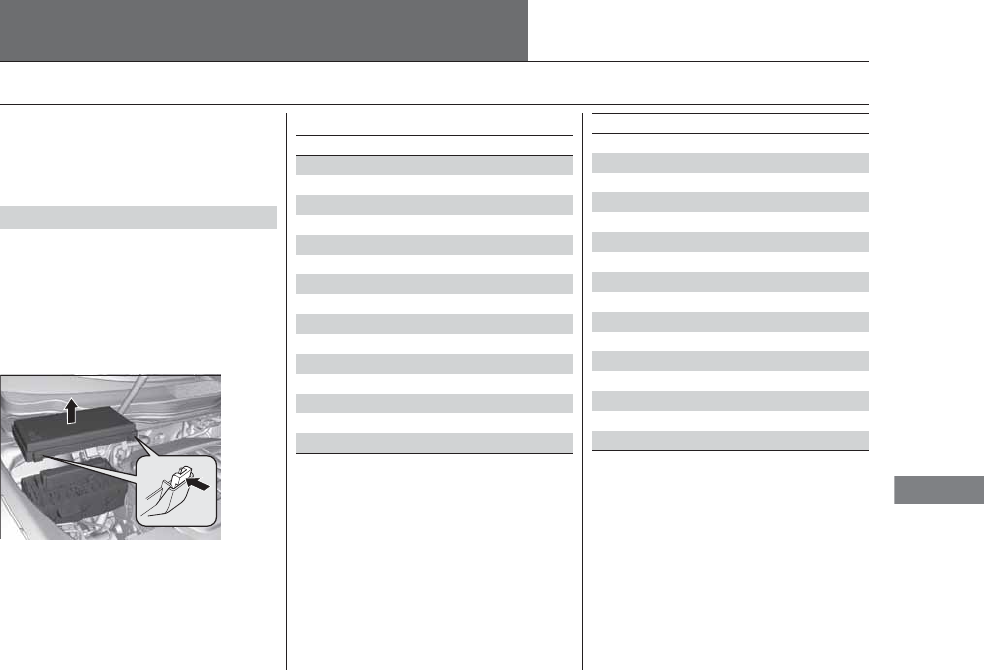
469
Continued
Handling the Unexpected
Fuses
Fuse Locations
If any electrical devices are not working, set
the power mode to VEHICLE OFF (LOCK)
and check to see if any applicable fuse is
blown.
There are two fuse boxes in the engine
compartment.
Fuse locations are shown on the fuse box
cover. Locate the fuse in question by the
fuse number and box cover number.
Located near the brake fluid reservoir. Push
the tabs to open the box.
■Engine Compartment Fuse Box
■Circuit protected and fuse rating
Circuit Protected Amps
1 − −
2 − −
3ACG FR 15 A
4 IG1 Washer 15 A
5IG1 VBSOL 7.5 A
6 IG1 ECU FR 7.5 A
7 − −
8FI SUB 15A
9DBW 15 A
10 FI Main 15 A
11 IG Coil 15 A
12 DRL R 10 A
13 DRL L 10 A
14 INJ 20 A
15 Radio 20 A
16 Back Up 10 A
17 MG Clutch 7.5 A
18 Front Fog*(20 A)
19 − −
20 Right Headlight High Beam 7.5 A
21 − −
22 Small 10 A
23 − −
24 Left Headlight High Beam 7.5 A
25 − −
26 Right Headlight Low Beam 10 A
27 Left Headlight Low Beam 10 A
28 IGPS Oil LVL 7.5 A
29 Cooling Fan 30 A
30 Sub Fan 30 A
31 WIP Main 30 A
Circuit Protected Amps
* Not available on all models
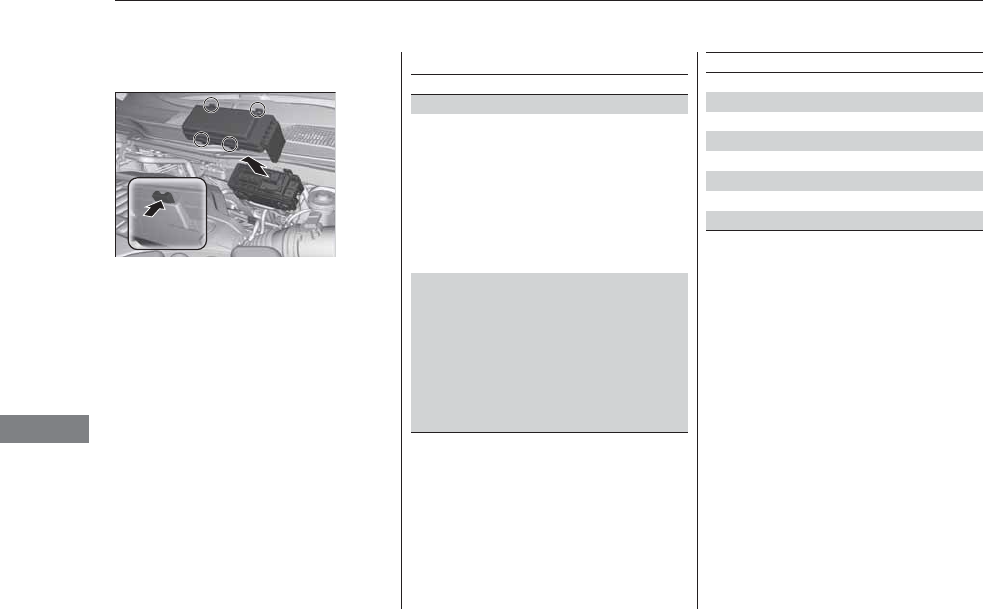
470
uuFusesuFuse Locations
Handling the Unexpected
Located near the battery. Push the tabs to
open the box.
■Circuit protected and fuse rating
Circuit Protected Amps
1Main Fuse 150 A
2
VSA MTR 40 A
VSA FSR 20 A
Stop/Horn/Hazard 30 A
Rear Blower/BMS 30 A
FI Main 40 A
Rear F/B 2 60 A
AS F/B 2 60 A
EPS 60 A
3
H/L Washer 30 A
IG1B Main 30 A
R/B Main 60 A
DR F/B 1 50 A
AS F/B 1 50 A
Rear F/B 1 60 A
IG1A Main 30 A
DR F/B 2 50 A
4STM 4 30A
5Front Blower 40 A
6 Rear Def 40 A
7IG Main 1 40 A
8 Stop & Horn 20 A
9Hazard 15 A
10 BMS 7.5 A
11 − −
Circuit Protected Amps
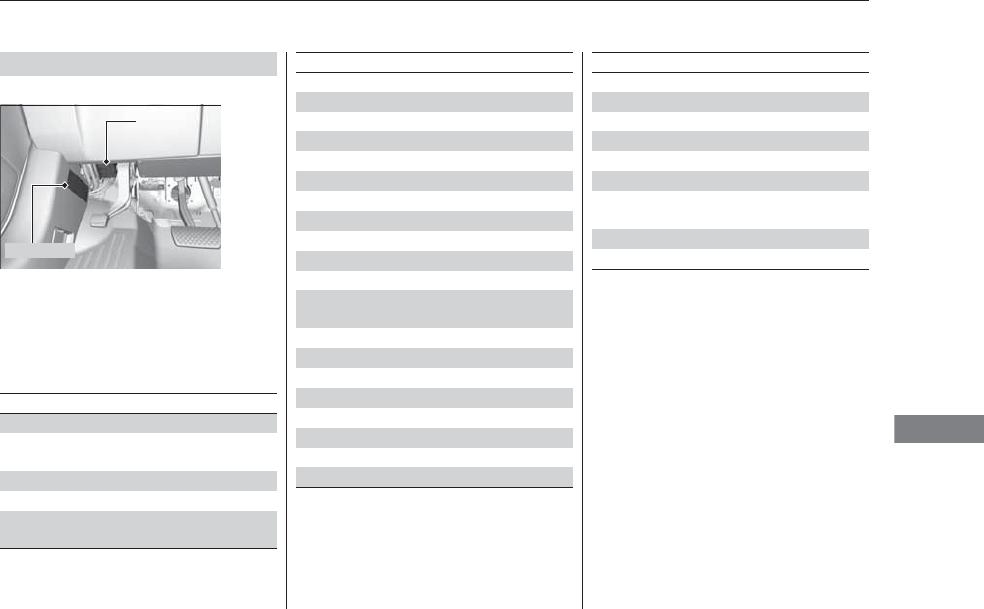
471
uuFusesuFuse Locations
Continued
Handling the Unexpected
Located under the dashboard.
Fuse locations are shown on the label on
the side panel.
Locate the fuse in question by the fuse
number and label number.
■Circuit protected and fuse rating
■Driver’s Side Interior Fuse Box
Fuse Box
Fuse Label
Circuit Protected Amps
1Passenger’s Side Door Lock 10 A
2Rear Passenger’s Side Door
Lock 7.5 A
3Driver’s Side Door Lock 7.5 A
4Passenger’s Door Unlock 10 A
5Rear Passenger’s Side Door
Unlock 7.5 A
6Driver’s Side Door Unlock 7.5 A
7Door Lock Main 20 A
8HAC OP 10 A
9ETS TELE 20 A
10 IG1 RR Box 15 A
11 IG1 Meter 7.5 A
12 IG1 FR Box 20 A
13 ACC 7.5 A
14 − −
15 Driver’s Power Seat Sliding 20 A
16 Moonroof 20 A
17 Rear Driver’s Side Power
Window 20 A
18 SMART 10 A
19 Driver’s Power Window 20 A
20 − −
21 Fuel Pump 20 A
22 AS Box 15 A
23 VSA 7.5 A
24 ACG AS 7.5 A
25 STRLD 7.5 A
Circuit Protected Amps
26 IG2 HAC 7.5 A
27 IG2 DRL 7.5 A
28 ACC Key Lock 7.5 A
29 Driver Power Lumber 7.5 A
30 Interior Lights Cut 7.5 A
31 ETS TILT 20 A
32 Driver’s Power Seat
Reclining 20 A
33 − −
34 − −
Circuit Protected Amps
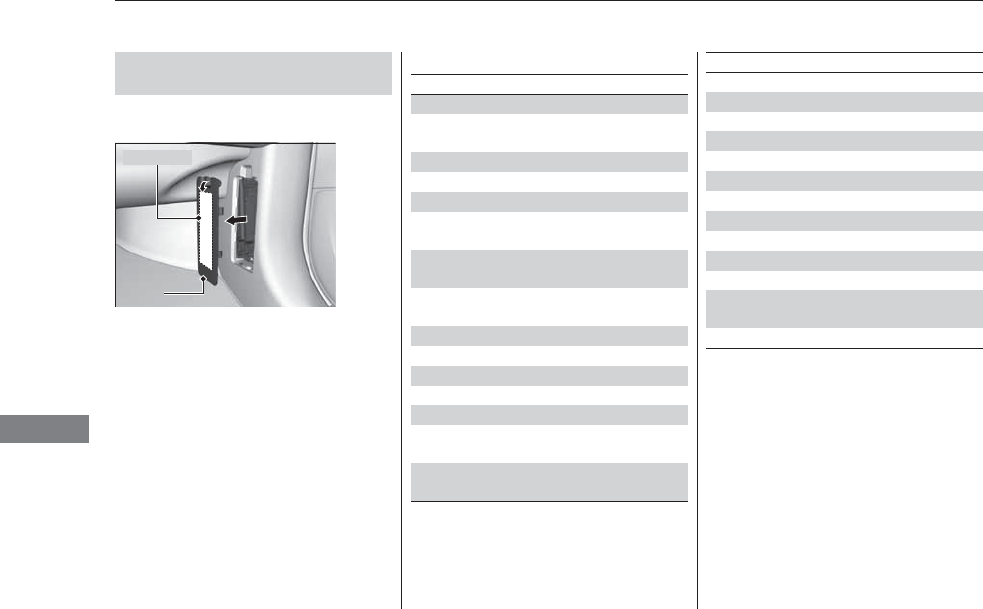
472
uuFusesuFuse Locations
Handling the Unexpected
Located on the lower side panel. Take off
the cover to open.
Fuse locations are shown on the cover.
■Passenger’s Side Interior Fuse
Box
Cover
Fuse Label
■Circuit protected and fuse rating
Circuit Protected Amps
1Right e-pretensioner*(30 A)
2Rear Passenger’s Side
Power Window 20 A
3ACM 20 A
4Front DEF*(15 A)
5AVS/Seat Heaters 20 A
6Front Passenger’s Power
Window 20 A
7Passenger’s Power Seat
Sliding 20 A
8Passenger’s Power Seat
Reclining 20 A
9Passenger’s Lumber*(7.5 A)
10 − −
11 HSW*(10 A)
12 − −
13 − −
14 Rear Accessory Power
Socket 20 A
15 Console Accessory Power
Socket 20 A
16 − −
17 − −
18 Premium AMP 30 A
19 SRS1 10 A
20 Passenger’s ECU 7.5 A
21 SVTM4 7.5 A
22 − −
23 − −
24 IG1 OPDS 7.5 A
25 Illumination 7.5 A
26 Left e-pretensioner*(30 A)
27 Front Accessory Power
Socket 20 A
28 AC Inverter (30 A)
Circuit Protected Amps
* Not available on all models
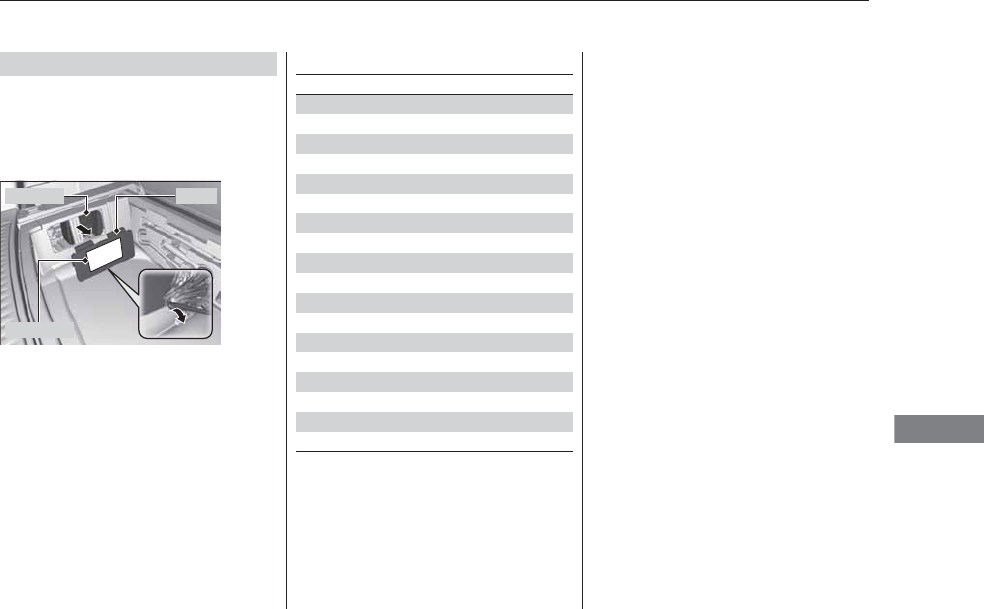
473
uuFusesuFuse Locations
Handling the Unexpected
Located on the left side of cargo area.
Remove the cover by prying on the edge of
the cover using a flat-tip screwdriver.
uWrap the flat-tip screwdriver with a
cloth to prevent scratches.
Fuse locations are shown on the cover.
Locate the fuse in question by the fuse
number and box cover number.
■Rear Fuse Box
Fuse Label
Fuse Box Cover
■Circuit protected and fuse rating
Circuit Protected Amps
1Power Tailgate Closer 20 A
2Trailer Small Light*(20 A)
3 − −
4Fuel Lid 7.5 A
5Seat Slide 20 A
6 − −
7Rear H/Seat*(20 A)
8 − −
9Trailer Charge*(20 A)
10 Trailer Back Light*(7.5 A)
11 Trailer Hazard*(7.5 A)
12 Rear Wiper 10 A
13 ECU RR 7.5 A
14 − −
15 − −
16 − −
17 Trailer E-Brake*(20 A)
18 Power Tailgate Motor 40 A
* Not available on all models
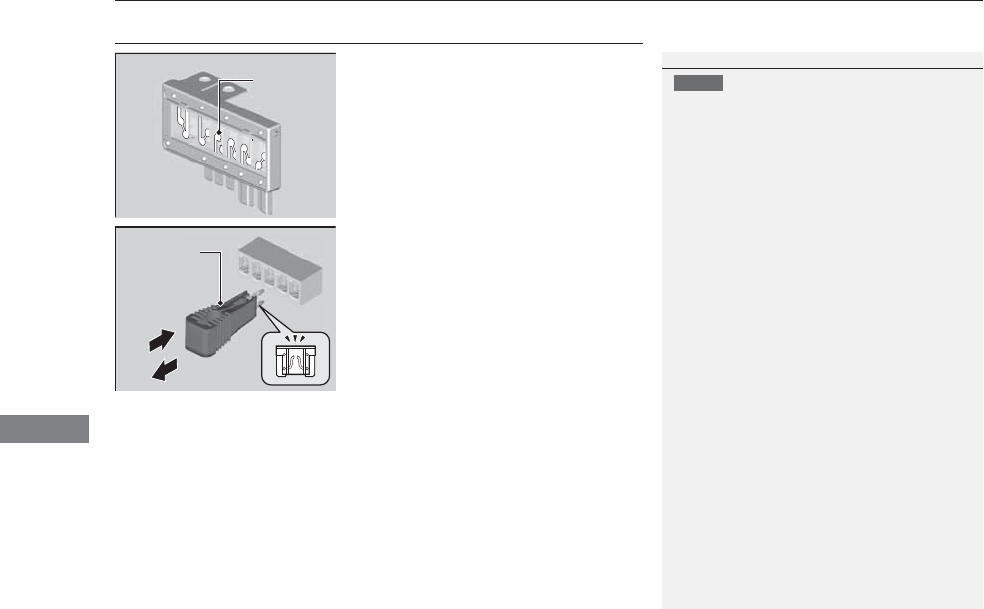
474
uuFusesuInspecting and Changing Fuses
Handling the Unexpected
Inspecting and Changing Fuses
1. Set the power mode to VEHICLE OFF
(LOCK). Turn headlights and all accessories
off.
2. Remove the fuse box cover.
3. Check the large fuse in the engine
compartment.
uIf the fuse is blown, use a Phillips-head
screwdriver to remove the screw and
replace it with a new one.
4. Inspect the small fuses in the engine
compartment and the vehicle interior.
uIf there is a burned out fuse, remove it
with the fuse puller and replace it with a
new one.
1Inspecting and Changing Fuses
NOTICE
Replacing a fuse with one that has a higher rating
greatly increases the chances of damaging the
electrical system.
Replace fuse with a spare fuse of the same specified
amperage
Confirm the specified amperage using the charts on
P. 469 to P. 473.
There is a fuse puller on the back of the engine
compartment fuse box cover.
Combined
Fuse
Blown Fuse
Fuse Puller
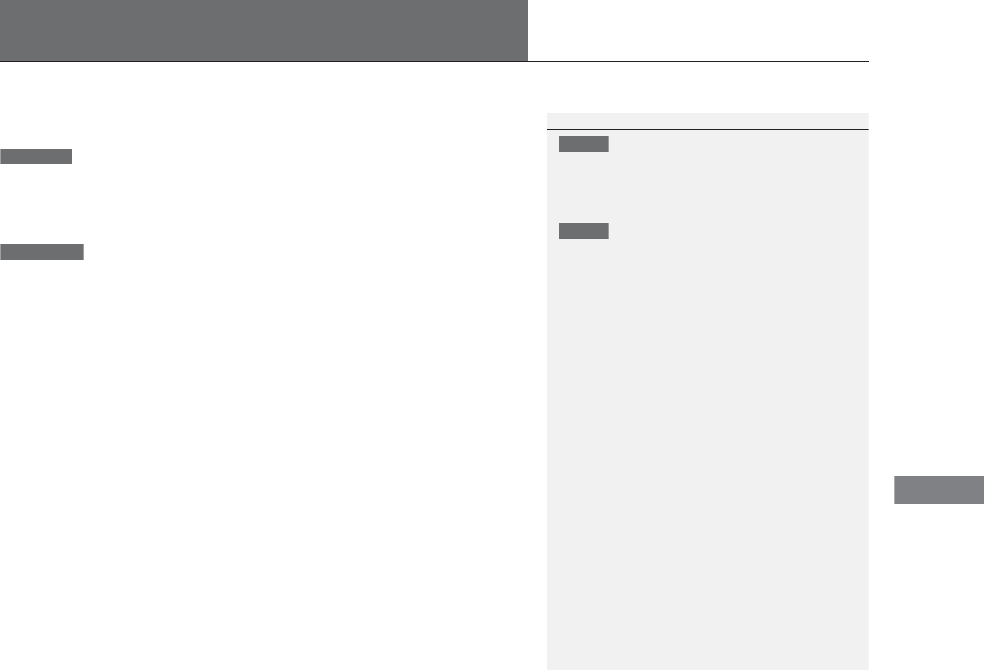
475
Handling the Unexpected
Emergency Towing
Call a professional towing service if you need to tow your vehicle.
■Flat bed equipment
The operator loads your vehicle on the back of a truck.
This is the best way to transport your vehicle.
■Wheel lift equipment
The tow truck uses two pivoting arms that go under the front tires and lift them off
the ground. The rear tires remain on the ground. This is an acceptable way to
tow your vehicle.
1Emergency Towing
NOTICE
Trying to lift or tow your vehicle by the bumpers will
cause serious damage. The bumpers are not designed
to support the vehicle’s weight.
NOTICE
Improper towing such as towing behind a
motorhome or other motor vehicle can damage the
transmission.
Never tow your vehicle with just a rope or chain.
It is very dangerous since ropes or chains may shift
from side to side or break.
All models
2WD models
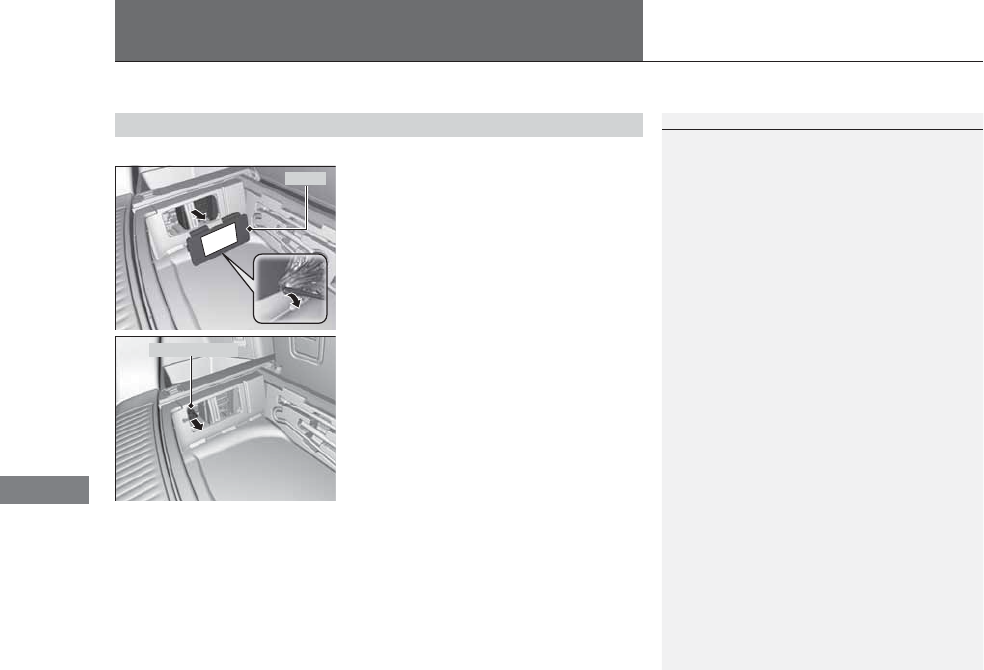
476
Handling the Unexpected
When You Cannot Unlock the Fuel Fill Door
If you cannot unlock the fuel fill door, use the following procedure.
1. Open the tailgate.
2. Lift the cargo floor lid by the handle in the
center.
3. Remove the cargo floor box and set it aside.
4. Wrap a cloth around the flat-tip
screwdriver. Put it into the cover slot as
shown in the image, and remove the cover.
5. Pull the release lever toward you.
uThe release lever unlocks the fuel fill door
when it is pulled.
■What to Do When Unable to Unlock the Fuel Fill Door
1What to Do When Unable to Unlock the Fuel Fill Door
After taking these steps, contact a dealer to have the
vehicle checked.
Cover
Release Lever
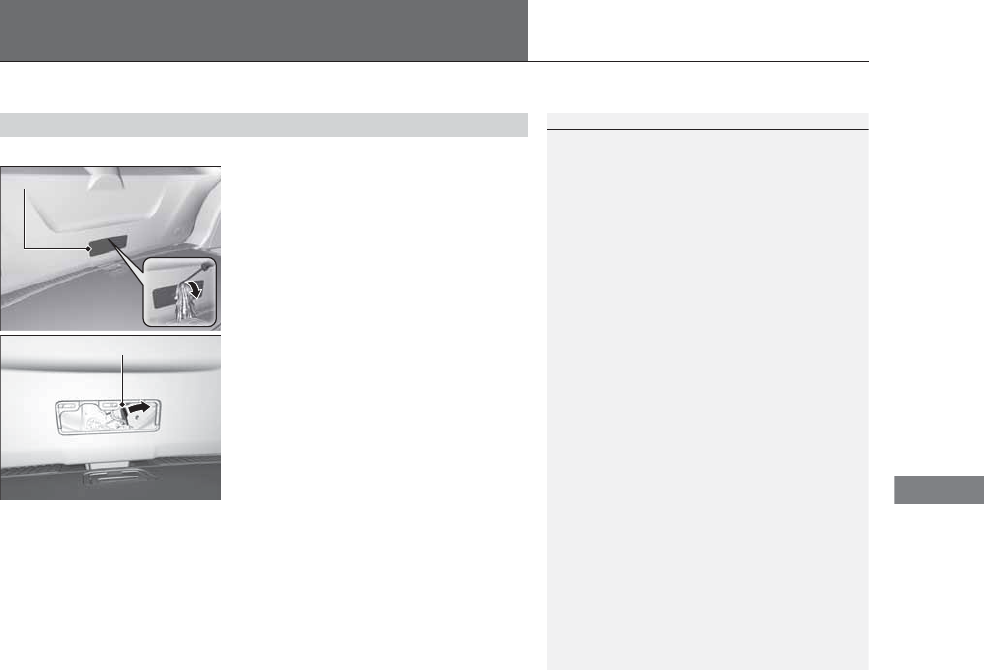
477
Handling the Unexpected
When You Cannot Open the Tailgate
If you cannot open the tailgate, use the following procedure.
1. Wrap a cloth around the flat-tip
screwdriver. Put it into the cover as shown
in the image, and remove the cover.
2. To open the tailgate, push the tailgate
while sliding the lever to the right.
■What to Do When Unable to Open the Tailgate
1What to Do When Unable to Open the Tailgate
After taking these steps, contact a dealer to have the
vehicle checked.
When you open the tailgate from inside, make sure
there is enough space around the tailgate, and it
does not hit anyone or any object.
Cover
Lever
478
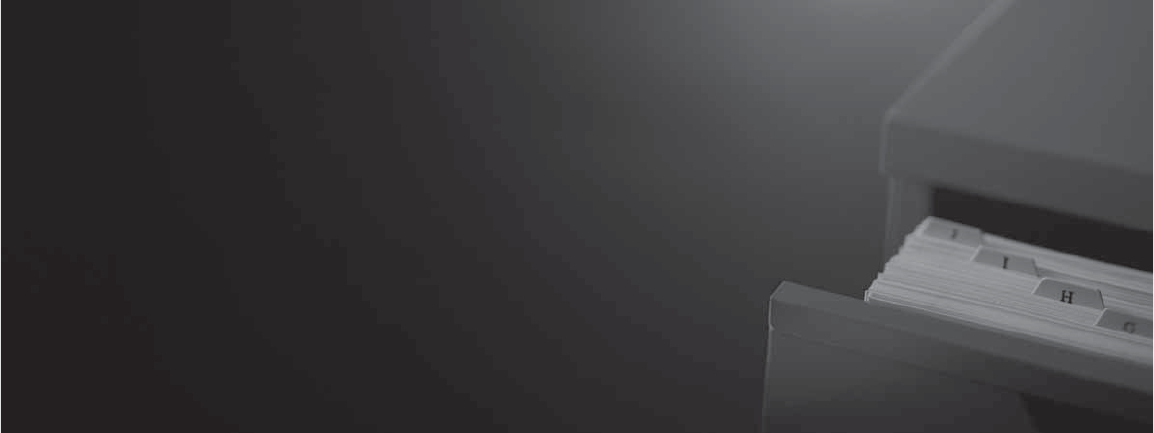
479
Information
This chapter includes your vehicle’s specifications, locations of identification numbers, and other
information required by regulation.
Specifications.................................... 480
Identification Numbers
Vehicle Identification Number (VIN).. 482
Engine Number and Transmission
Number...................................... 482
Devices that Emit Radio Waves....... 483
Reporting Safety Defects................. 484
Emissions Testing
Testing of Readiness Codes.............. 485
Warranty Coverages ........................ 487
Authorized Manuals......................... 489
Client Service Information ............... 490
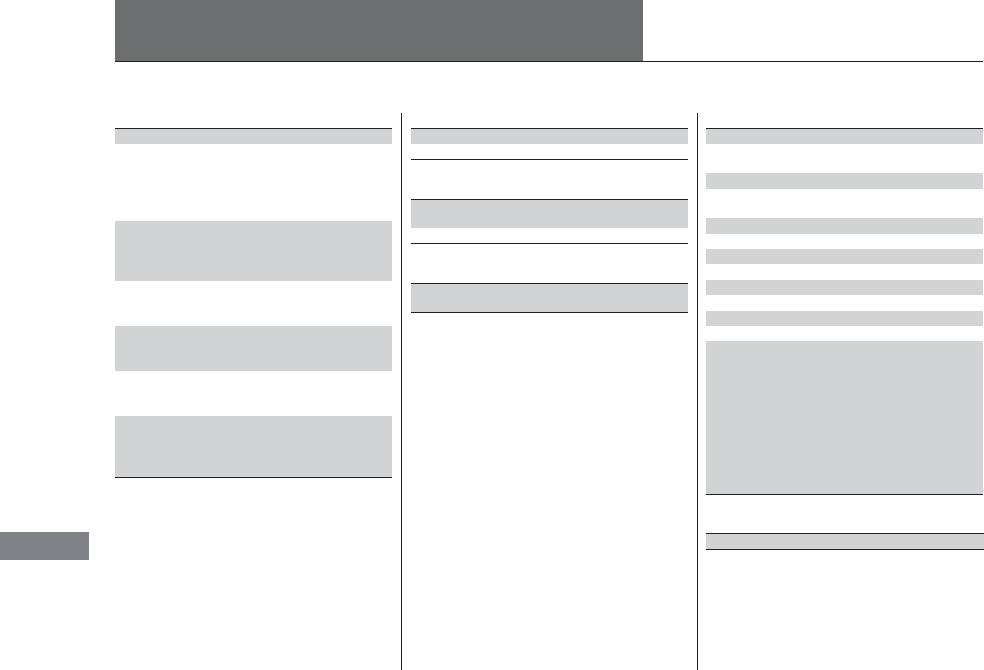
480
Information
Specifications
■Vehicle Specifications
*1: 2WD models
*2: AWD models
Model Acura MDX
No. of Passengers:
Front 2
Rear 2nd Row 3
3rd Row 2
Total 7
Weights:
Gross Vehicle
Weight Rating
U.S.: 5,368 lbs (2,435 kg)*1
5,677 lbs (2,575 kg)*2
Canada:
2,575 kg
Gross Axle Weight
Rating (Front)
U.S.: 2,811 lbs (1,275 kg)*1
2,910 lbs (1,320 kg)*2
Canada:
1,320 kg
Gross Axle Weight
Rating (Rear)
U.S.: 2,734 lbs (1,240 kg)*1
2,965 lbs (1,345 kg)*2
Canada:
1,345 kg
Gross Combined Weight
Rating
U.S.: 8,036 lbs (3,645 kg)*1
9,833 lbs (4,460 kg)*2
Canada:
4,460 kg
Air Conditioning:
Refrigerant Type HFC-134a (R-134a)
Charge Quantity 23.8 – 25.6 oz (675 – 725 g)
Lubricant Type RL897PAG
■Engine Specifications
■Fuel
■Washer Fluid
Displacement 211.8 cu-in (3,471 cm3)
Spark Plugs NGK DILZKR7B11G
Type Unleaded premium gasoline, Pump octane
number of 91 or higher
Fuel Tank Capacity 19.5 US gal (74 ℓ)
Tank Capacity U.S.: 4 US qt (3.8 ℓ)
Canada: 6.3 US qt (6.0 ℓ)
■Light Bulbs
■Brake Fluid
Headlights (High/Low Beam) LED
Front Turn Signal/Side Marker/
Parking Lights 28/8W (Amber)
Daytime Running Lights LED
Side Turn Signal Lights (on Door
Mirrors) LED
Brake Lights 21W
Rear Side Marker Lights LED
Taillights LED
Back-Up Lights 21W
Rear Turn Signal Lights 21W
High-Mount Brake Light LED
Rear License Plate Light LED
LED Puddle Lights LED
Interior Lights
Front, Second Row and Third
Row Lights LED
Front and Rear Ambient Lights LED
Vanity Mirror Lights 1.4W
Door Courtesy Lights 3.4W
Console Compartment Light 1.4W
Glove Box Light 1.4W
Foot Lights 5W
Cargo Area Lights 5W
Specified Acura Heavy Duty Brake Fluid DOT 3
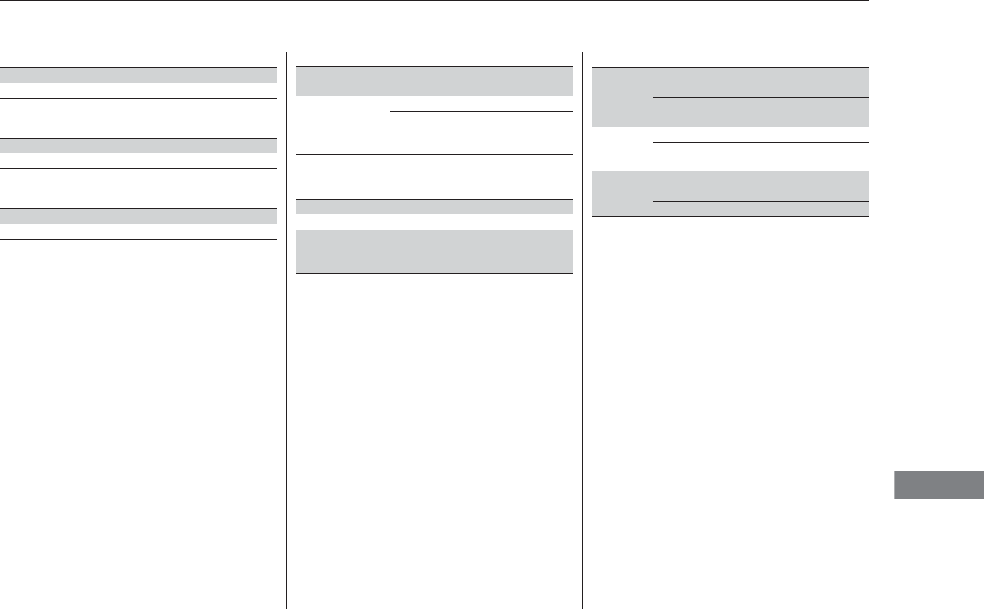
481
uuSpecificationsu
Information
■Automatic Transmission Fluid
■Rear Differential Fluid*
■Transfer Assembly Fluid*
Specified Acura ATF DW-1(automatic transmission fluid)
Capacity Change 3.3 US qt (3.1 ℓ)
Specified Acura All Wheel Drive Fluid (DPSF)
Capacity Change 2.7 US qt (2.5 ℓ)
Specified Acura HGO-Type1 to be applied.
Capacity Change 0.45 US qt (0.43 ℓ)
■Engine Oil
■Engine Coolant
Recommended ·Genuine Acura Motor Oil 0W-20
·API Premium-grade 0W-20 detergent oil
Capacity
Change 5.4 US qt (5.1 ℓ)
Change
including
filter
5.7 US qt (5.4 ℓ)
Specified Acura Long Life Antifreeze/Coolant Type 2
Ratio 50/50 with distilled water
Capacity
1.93 US gal (7.3 ℓ)
(change including the remaining 0.19 US gal
(0.72 ℓ) in the reserve tank)
■Tire
*1: BASE models
*2: Except BASE models
Regular
Size 245/60R18 105H*1
245/55R19 103H*2
Pressure
psi (kPa [kgf/cm2]) 35 (240 [2.4])
Compact
Spare*
Size T165/80D17 104M
Pressure
psi (kPa [kgf/cm2]) 60 (420 [4.2])
Wheel Size Regular 18 x 8J*1
19 x 8J*2
Compact Spare*17 x 4T
* Not available on all models

482
Information
Identification Numbers
Vehicle Identification Number (VIN)
Your vehicle has a 17-digit vehicle identification number (VIN) used to register your
vehicle for warranty purposes, and for licensing and insuring your vehicle. See the
image below for the VIN locations.
Engine Number and Transmission Number
See the image below for the locations of your vehicle’s engine number and
transmission number.
1Vehicle Identification Number (VIN)
The interior vehicle identification number (VIN) is
located under the cover.
Cover
Vehicle Identification Number
Engine Number
Certification Label/Vehicle Identification Number
Automatic Transmission
Number
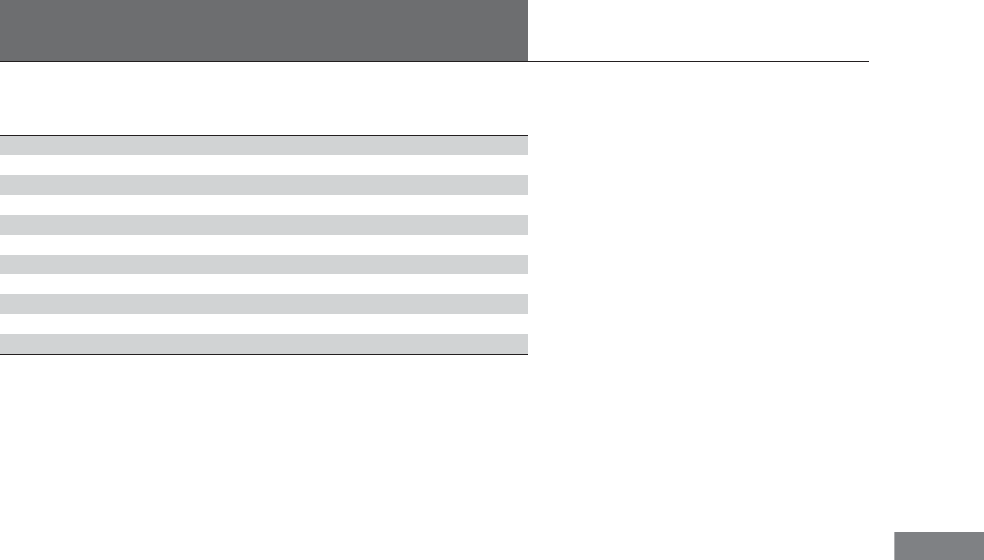
483
Information
Devices that Emit Radio Waves
The following products and systems on your vehicle emit radio waves when in operation.
Each of the above complies with the appropriate requirements or the required standards of
FCC (Federal Communications Commission) and Industry Canada Standard, described below:
As required by the FCC:
This device complies with Part 15 of the FCC rules. Operation is
subject to the following two conditions: (1) This device may not cause
harmful interference, and (2) this device must accept any interference
received, including interference that may cause undesired operation.
Changes or modifications not expressly approved by the party responsible
for compliance could void the user’s authority to operate the equipment.
This device complies with Industry Canada Standard RSS-Gen/247. Operation is
subject to the following two conditions: (1) this device may not cause interference,
and (2) this device must accept any interference, including interference that may
cause undesired operation of the device.
AcuraLink
Audio System
Blind Spot Information System
Bluetooth® Audio
Bluetooth® HandsFreeLink®
HomeLink® Universal Transceiver
Collision Mitigation Braking SystemTM
Immobilizer System
Remote Transmitter
Keyless Access System
Tire Pressure Monitoring System (TPMS)

484
Information
Reporting Safety Defects
In the U.S.
If you believe that your vehicle has a defect which could cause a crash or could cause injury or death, you
should immediately inform the National Highway Traffic Safety Administration (NHTSA) in addition to
notifying American Honda Motor Co., Inc.
If NHTSA receives similar complaints, it may open an investigation, and if it finds that a safety defect exists
in a group of vehicles, it may order a recall and remedy campaign. However, NHTSA cannot become involved
in individual problems between you, your dealer, or American Honda Motor Co., Inc.
To contact NHTSA, you may call the Vehicle Safety Hotline toll-free at 1-888-327-4236 (TTY: 1-800-424-
9153); go to http://www.safercar.gov; or write to: Administrator, NHTSA, 1200 New Jersey Avenue, SE.,
Washington, DC 20590. You can also obtain other information about motor vehicle safety from http://
www.safercar.gov.
In Canada
If you believe that your vehicle has a defect which could cause a crash or could cause injury or death, you
should immediately inform Honda Canada Inc. and you may also inform Transport Canada.
If Transport Canada receives similar complaints, it may open an investigation, and if it finds that a safety
defect exists in a group of vehicles, it may lead to a recall and remedy campaign. However, Transport Canada
cannot become involved in individual problems between you, your dealer, or Honda Canada Inc.
To contact Transport Canada’s Defect Investigations and Recalls Division, you may call 1-800-333-0510. For
more information on reporting safety defects or about motor vehicle safety, go to http://www.tc.gc.ca/
roadsafety.
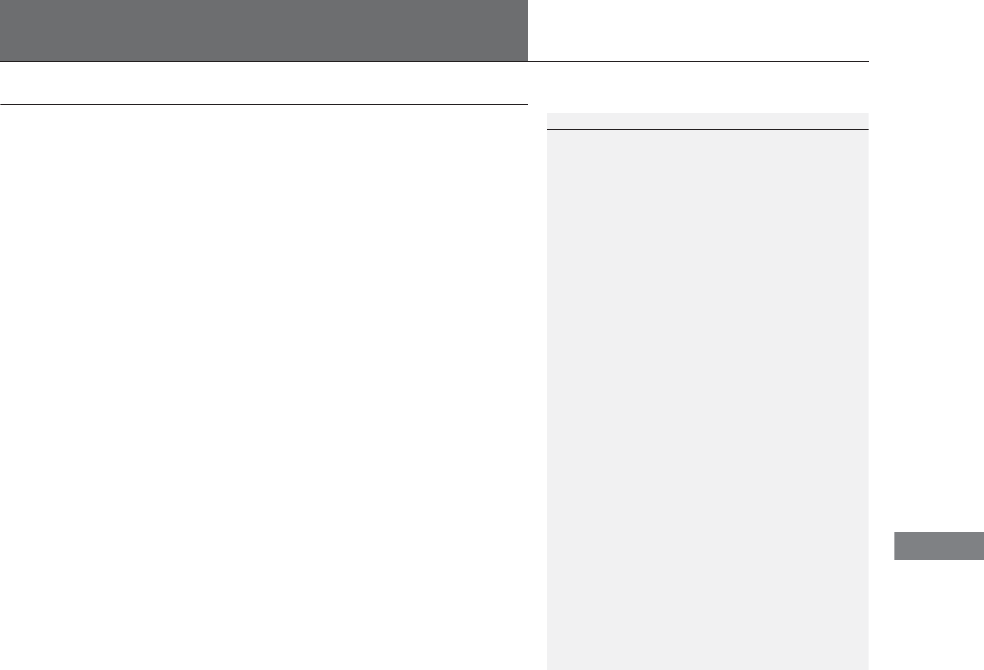
485
Continued
Information
Emissions Testing
Testing of Readiness Codes
Your vehicle uses “readiness codes,” as part of its onboard self diagnostic system.
Some states refer to these codes during testing to see if your vehicle’s emissions
components are working properly.
The codes may not be read if you go through the testing just after the battery has
gone dead or been disconnected.
To check if they are set, set the power mode to ON, without starting the engine. The
malfunction indicator lamp will come on for several seconds. If it then goes off, the
readiness codes are set. If it blinks five times, the readiness codes are not set.
If you are required to have your vehicle tested before the readiness codes are ready,
prepare the vehicle for retesting by doing the following:
1. Fill the gas tank to approximately 3/4 full.
2. Park the vehicle and leave the engine off for 6 hours or more.
3. Make sure the ambient temperature is between 40°F and 95°F (4°C and 35°C).
4. Start the engine without touching the accelerator pedal, and let it idle for 20
seconds.
5. Keep the vehicle in (P. Increase the engine speed to 2,000 rpm, and hold it there
for about 3 minutes.
6. Let the engine idle with your foot off the accelerator for 20 seconds.
1Testing of Readiness Codes
The readiness codes are erased when the battery is
disconnected, and set again only after several days of
driving under a variety of conditions.
If a testing facility determines that the readiness
codes are not set, you may be requested to return at
a later date to complete the test.
If the testing facility determines the readiness codes
are still not set, see a dealer.

486
uuEmissions TestinguTesting of Readiness Codes
Information
7. Select a nearby, lightly traveled major highway where you can maintain a speed
of 50 to 60 mph (80 to 97 km/h) for at least 20 minutes. Drive on the highway in
(D. Do not use cruise control. When traffic allows, drive for 90 seconds without
moving the accelerator pedal. (Vehicle speed may vary slightly; this is okay.) If you
cannot do this for a continuous 90 seconds because of traffic conditions, drive for
at least 30 seconds, then repeat it two more times (for a total of 90 seconds).
8. Drive in city/suburban traffic for at least 10 minutes. When traffic conditions
allow, let the vehicle coast for several seconds without using the accelerator pedal
or the brake pedal.
9. Park the vehicle and leave the engine off for 30 minutes.

487
Continued
Information
Warranty Coverages
■U.S. Owners
Your new vehicle is covered by these warranties:
New Vehicle Limited Warranty – covers your new vehicle, except for the
emissions control systems and accessories, against defects in materials and
workmanship.
Emissions Control Systems Defects Warranty and Emissions Performance
Warranty – these two warranties cover your vehicle’s emissions control systems.
Time, mileage, and coverage are conditional. Please read your warranty booklet for
exact information.
Seat Belt Limited Warranty – a seat belt that fails to function properly is covered
by a limited warranty. Please read your warranty booklet for details.
Rust Perforation Limited Warranty – all exterior body panels are covered for
rust-through from the inside for the specified time period with no mileage limit.
Accessory Limited Warranty – Acura accessories are covered under this warranty.
Time and mileage limits depend on the type of accessory and other factors. Please
read your warranty booklet for details.
Replacement Parts Limited Warranty – covers all Acura replacement parts
against defects in materials and workmanship.

488
uuWarranty Coveragesu
Information
Replacement Battery Limited Warranty – provides prorated coverage for a
replacement battery purchased from a dealer.
Replacement Muffler Lifetime Limited Warranty – provides coverage for as
long as the purchaser of the muffler owns the vehicle.
Restrictions and exclusions apply to all these warranties. Please read the Acura
warranty information booklet that came with your vehicle for precise information on
warranty coverages. Your vehicle’s original tires are covered by their manufacturer.
Tire warranty information is in a separate booklet.
■Canadian Owners
Please refer to the warranty manual that came with your vehicle.

489
Information
Authorized Manuals
■Service Express
For electronic copies of service publications, you can purchase a subscription to
Service Express. Visit www.techinfo.honda.com for pricing and options.
■For U.S. Owners:
Manuals be purchased from Helm Incorporated. You can order a manual by phone
at (800) 782-4356 (credit card orders only), or online at www.helminc.com.
1Authorized Manuals
For Canadian Owners:
Please contact a dealer to order any manuals that you
may require.

490
Information
Client Service Information
Acura dealer personnel are trained professionals.
They should be able to answer all your questions. If you encounter a problem that
your dealership does not solve to your satisfaction, please discuss it with the
dealership’s service manager or general manager. If you are dissatisfied with the
decision made by the dealership’s management, contact Acura Client Relations/
Services.
U.S. Owners:
American Honda Motor Co., Inc.
Acura Client Relations
Mail Stop 500-2N-7E
1919 Torrance Blvd.
Torrance, CA 90501-2746
Tel: (800) 382-2238
Canadian Owners:
Honda Canada Inc.
Acura Client Services
180 Honda Boulevard
Markham, ON
L6C 0H9
Tel: 1-888-9-ACURA-9
Fax: 1-877-939-0909
E-Mail: acura_cr@ch.honda.com
In Puerto Rico and the U.S. Virgin
Islands:
Bella International
P.O. Box 190816
San Juan, PR 00919-0816
Tel: (787) 620-7546
1Client Service Information
When you call or write, please give us the following
information:
•Vehicle Identification Number
2Vehicle Identification Number (VIN)
P. 482
•Date of purchase
•Odometer reading of your vehicle
•Your name, address, and telephone number
•A detailed description of the problem
•Name of the dealer who sold the vehicle to you

Index
491
Index
Index
A
AAC................................................... 224, 234
ABS (Anti-lock Brake System).................. 369
AC Power Outlet ...................................... 179
Accessories and Modifications ................ 386
Accessory Power Sockets ......................... 178
Adaptive Cruise Control (ACC) with Low
Speed Follow (LSF) ................................. 337
Indicator ................................................... 82
Additives
Coolant .................................................. 403
Engine Oil ............................................... 398
Washer ................................................... 406
Additives, Engine Oil ............................... 398
Adjusting
Armrest .................................................. 171
Front Seats.............................................. 161
Head Restraints....................... 164, 165, 166
Headlights .............................................. 407
Mirrors.................................................... 158
Rear Seats............................................... 168
Second Row Seat .................................... 162
Steering Wheel ....................................... 157
Temperature ........................................... 100
Agile Handling Assist System .................. 360
AhaTM Menu ............................................. 233
AhaTM Radio.............................................. 243
Air Conditioning System (Climate Control
System).................................................... 185
Changing the Mode................................ 188
Defrosting the Windshield and
Windows ............................................... 191
Dust and Pollen Filter............................... 431
Rear Climate Control System ................... 192
Recirculation/Fresh Air Mode ................... 190
Sensors.................................................... 196
Synchronized Mode................................. 189
Using Automatic Climate Control ............ 185
Air Pressure ....................................... 418, 481
Airbags ........................................................ 39
Advanced Airbags ..................................... 45
After a Collision......................................... 43
Airbag Care............................................... 53
Driver’s Knee Airbag.................................. 46
Event Data Recorder .................................. 22
Front Airbags (SRS) .................................... 42
Indicator.............................................. 51, 74
Passenger Airbag Off Indicator .................. 52
Sensors...................................................... 39
Side Airbags .............................................. 48
Side Curtain Airbags.................................. 50
AM/FM Radio ............................................ 217
Anti-lock Brake System (ABS) .................. 369
Indicator.................................................... 74
Armrest ..................................................... 171
Audio Remote Controls............................ 202
Audio System............................................ 198
Adjusting the Sound................................ 215
Auxiliary Input Jack .................................. 200
Error Messages ........................................ 239
General Information ................................ 244
Internet Radio ......................................... 231
iPod®....................................................... 227
MP3/WMA/AAC.............................. 224, 234
Reactivating ............................................ 201
Recommended CDs................................. 245
Recommended Devices............................ 247
Remote Controls ..................................... 202
Security Code.......................................... 201
Shortcuts................................................. 205
Theft Protection ...................................... 201
USB Flash Drives.............................. 234, 247
USB Port.................................................. 199
Authorized Manuals ................................ 489
Auto Door Locking/Unlocking................. 127
Customize....................................... 109, 259
Automatic Intermittent Wipers............... 150
Automatic Lighting .................................. 146
Automatic Transmission........................... 328
Creeping................................................. 328
Fluid........................................................ 405
Kickdown................................................ 328
Operating the Shift Lever................... 15, 330
Sequential Shift Mode............................. 331
Shift Lever Does Not Move ...................... 462
Shifting ................................................... 329
Auxiliary Input Jack.................................. 200
Average Fuel Economy ............................ 100
Average Speed ......................................... 101
AWD.......................................................... 363

492
Index
B
Back-Up Light............................................ 411
Battery....................................................... 426
Charging System Indicator ................. 71, 465
Jump Starting .......................................... 460
Maintenance (Checking the Battery) ........ 426
Belts (Seat) .................................................. 31
Beverage Holders...................................... 177
Blind Spot Information (BSI) System........ 361
Indicator.................................................... 83
Bluetooth® Audio ..................................... 237
Bluetooth® HandsFreeLink®..................... 268
Booster Seats (For Children)....................... 65
Brake System............................................. 367
Anti-lock Brake System (ABS)................... 369
Brake Assist System ................................. 370
Brake System Indicator............................... 70
Fluid ........................................................ 406
Foot Brake............................................... 368
Indicator............................................ 70, 467
Parking Brake .......................................... 367
Brightness Control (Instrument Panel).... 153
BSI (Blind Spot Information) System........ 361
Bulb Replacement..................................... 407
Back-Up Light.......................................... 411
Brake Light and Turn Signal Light............. 409
Daytime Running Light ............................ 148
Front Turn Signal/Front Side Marker/
Parking Light.......................................... 408
Headlights ............................................... 407
High-Mount Brake Light .......................... 412
LED Puddle Light ..................................... 412
Rear License Plate Light ........................... 412
Side Turn Signal/Emergency Indicator
Light...................................................... 408
Taillight and Rear Side Marker Light ........ 410
Bulb Specifications ................................... 480
C
Carbon Monoxide Gas ............................... 66
Carrying Cargo ................................. 305, 307
CD Player................................................... 224
Center Pocket ........................................... 176
Certification Label.................................... 482
Changing Bulbs ........................................ 407
Charging System Indicator................. 71, 465
Child Safety................................................. 54
Childproof Door Locks............................. 126
Child Seat.................................................... 54
Booster Seats ............................................ 65
Child Seat for Infants................................. 56
Child Seat for Small Children..................... 57
Installing a Child Seat with a Lap/Shoulder
Seat Belt.................................................. 61
Larger Children ......................................... 64
Rear-facing Child Seat ............................... 56
Selecting a Child Seat................................ 58
Childproof Door Locks ............................. 126
Cleaning the Exterior ............................... 434
Cleaning the Interior................................ 432
Client Service Information ....................... 490
Climate Control System ........................... 185
Changing the Mode................................ 188
Defrosting the Windshield and
Windows .............................................. 191
Dust and Pollen Filter .............................. 431
Rear Climate Control System................... 192
Recirculation/Fresh Air Mode................... 190
Sensors ................................................... 196
Synchronized Mode ................................ 189
Using Automatic Climate Control............ 185
Clock ......................................................... 114
CMBSTM (Collision Mitigation Braking
SystemTM)................................................ 371
Coat Hook ................................................ 180
Collision Mitigation Braking SystemTM
(CMBSTM)................................................. 371
Indicator ................................................... 83
Compact Spare Tire.......................... 439, 481
Compass.................................................... 301
Console Compartment............................. 175
Controls .................................................... 113
Coolant (Engine) ...................................... 403
Adding to the Radiator ........................... 404
Adding to the Reserve Tank .................... 403
Overheating............................................ 463
Creeping (Automatic Transmission)........ 328
Cruise Control .......................................... 334
Indicator ................................................... 78
Cup Holders.............................................. 177
Customized Features ....................... 104, 248

493
Index
D
Daytime Running Lights .......................... 148
Dead Battery ............................................ 460
Defrosting the Windshield and
Windows................................................. 191
Detachable Anchor .................................... 36
Devices that Emit Radio Waves............... 483
Dimming
Headlights .............................................. 145
Rearview Mirror ...................................... 158
Dipstick (Engine Oil) ................................ 399
Directional Signals (Turn Signal)............. 144
Door Mirrors............................................. 159
Doors ........................................................ 115
Auto Door Locking.................................. 127
Auto Door Unlocking .............................. 127
Door Open Message ................................. 30
Keys........................................................ 115
Locking/Unlocking the Doors from the
Inside .............................................. 10, 124
Locking/Unlocking the Doors from the
Outside ................................................. 117
Lockout Prevention System ..................... 121
DOT Tire Quality Grading........................ 420
Driver’s Knee Airbag.................................. 46
Driving ...................................................... 303
Automatic Transmission .......................... 328
Braking ................................................... 367
Cruise Control ........................................ 334
Off-Highway Driving Guidelines .............. 320
Shifting Gear .......................................... 329
Starting the Engine.................................. 322
Driving Position Memory System............. 155
Dust and Pollen Filter............................... 431
E
Elapsed Time............................................. 101
Electronic Stability Control (ESC)............. 358
Emergency ................................................ 475
Emissions Testing (Readiness Codes)....... 485
Engine ....................................................... 482
Coolant ................................................... 403
Jump Starting .......................................... 460
Oil ........................................................... 398
Remote Engine Start................................ 324
Starting ................................................... 322
Engine Compartment Cover .................... 397
Engine Coolant ......................................... 403
Adding to the Radiator ............................ 404
Adding to the Reserve Tank..................... 403
Overheating ............................................ 463
Temperature Gauge .................................. 97
Engine Oil ................................................. 398
Adding .................................................... 400
Checking................................................. 399
Displaying Oil Life .................................... 391
Low Oil Pressure Indicator.................. 71, 465
Recommended Engine Oil........................ 398
ENGINE START/STOP Button .................... 141
e-pretensioners........................................... 33
EPS (Electric Power Steering)
System ............................................... 76, 467
Exhaust Gas Hazard (Carbon Monoxide).. 66
Exterior Care (Cleaning)........................... 434
Exterior Mirrors ........................................ 159
F
FCW (Forward Collision Warning)........... 346
Features .................................................... 197
Filters
Dust and Pollen....................................... 431
Oil........................................................... 401
Flat Tire............................................. 439, 446
Floor Mats................................................. 433
Fluids
Automatic Transmission .......................... 405
Brake ...................................................... 406
Engine Coolant ....................................... 403
Windshield Washer ................................. 406
Folding Down the Second Row Seat....... 169
Folding Down the Third Row Seat.......... 170
Foot Brake ................................................ 368
Forward Collision Warning (FCW)........... 346
Indicator.................................................... 80
Front Airbags (SRS)..................................... 42
Front Seats................................................ 161
Adjusting ................................................ 161

494
Index
Fuel...................................................... 16, 383
Economy ................................................. 385
Gauge ....................................................... 97
Instant Fuel Economy............................... 101
Low Fuel Indicator ..................................... 73
Range...................................................... 101
Recommendation .................................... 383
Refueling................................................. 383
Fuel Economy............................................ 385
Fuel Fill Cap......................................... 16, 384
Message.................................................. 466
Fuel Fill Door....................................... 16, 384
Unable to Unlock..................................... 476
Fuses .......................................................... 469
Inspecting and Changing......................... 474
Locations......................... 469, 471, 472, 473
G
Gasoline (Fuel)
Economy ................................................. 385
Gauge ....................................................... 97
Information ............................................. 383
Low Fuel Indicator ..................................... 73
Refueling................................................. 383
Gauges......................................................... 97
Gear Shift Lever Positions
Automatic Transmission........................... 329
Glass (care) ................................................ 435
Glove Box .................................................. 174
H
Handling the Unexpected........................ 437
HandsFreeLink® (HFL)............................... 268
Auto Answer........................................... 282
Automatic Import of Cellular Phonebook
and Call History ..................................... 284
Automatic Transferring............................ 282
Displaying Messages................................ 297
Editing User Name................................... 281
HFL Buttons............................................. 268
HFL Menus .............................................. 270
HFL Status Display ................................... 269
Limitations for Manual Operation ............ 269
Making a Call.......................................... 288
Options During a Call .............................. 294
Phone Setup............................................ 274
Receiving a Call ....................................... 293
Receiving a Text Message/E-mail.............. 295
Ring Tone................................................ 283
Selecting a Mail Account ......................... 296
Speed Dial............................................... 285
To Create a Security PIN .......................... 280
To Set Up a Text Message/E-mail
Options ................................................. 279
Use Contact Photo .................................. 283
Hazard Warning Button .............................. 2
HDMI Jack ..................................................... 5
Head Restraints ........................ 164, 165, 166
Headlight Washers ................................... 152
Headlights................................................. 145
Aiming .................................................... 407
Automatic Operation .............................. 146
Dimming......................................... 145, 148
Operating ............................................... 145
Heated Door Mirrors ............................... 154
Heated Steering Wheel ........................... 181
Heated Windshield Button...................... 154
Heater (Steering Wheel).......................... 181
Heaters (Seat)................................... 182, 183
HFL (HandsFreeLink®).............................. 268
High Beam Indicator.................................. 76
Hill Start Assist System............................. 326
HomeLink® Universal Transceiver ........... 266
I
Identification Numbers............................ 482
Engine and Transmission......................... 482
Vehicle Identification............................... 482
IDS (Integrated Dynamics System) .......... 333
IDS Button ................................................ 333
Illumination Control ................................ 153
Button .................................................... 153
Immobilizer System.................................. 135
Indicator ................................................... 77
Indicators.................................................... 70
Adaptive Cruise Control (ACC) with
Low Speed Follow (LSF) ................... 82, 337
Anti-lock Brake System (ABS) .................... 74
Blind Spot Information (BSI) .............. 83, 362
Brake System ............................................ 70
Charging System............................... 71, 465

495
Index
Collision Mitigation Brake SystemTM
(CMBSTM) ................................................ 83
CRUISE CONTROL............................. 78, 335
CRUISE MAIN.................................... 78, 334
Forward Collision Warning (FCW) ............. 80
High Beam................................................ 76
Immobilizer System ................................... 77
Keyless Access System............................... 79
Lane Departure Warning (LDW) ................ 81
Lane Keeping Assist System (LKAS) ... 82, 354
Lights On .................................................. 77
Low Fuel ................................................... 73
Low Oil Pressure ............................... 71, 465
Low Tire Pressure/TPMS ............................ 76
Malfunction Indicator Lamp .............. 71, 466
Parking Brake and Brake System ....... 70, 467
Seat Belt Reminder.............................. 32, 73
Security System Alarm............................... 78
Shift Lever Position.................................... 72
Speed-sensitive Electric Power
Steering (EPS) System...................... 76, 467
Super Handling-All Wheel DriveTM
(SH-AWD®) ............................................. 79
Supplemental Restraint System ........... 51, 74
System Message ....................................... 78
Transmission............................................. 72
Turn Signal ............................................... 76
Vehicle Stability Assist (VSA®)
System ............................................ 75, 358
VSA® OFF.......................................... 75, 359
Information .............................................. 479
Instrument Panel ........................................ 69
Brightness Control................................... 153
Integrated Dynamics System (IDS)........... 333
IDS Button............................................... 333
Interface Dial ............................................ 203
Interior Lights ........................................... 172
Interior Rearview Mirror.......................... 158
J
Jack (Wheel Nut Wrench) ........................ 443
Jump Starting ........................................... 460
K
Key Number Tag ....................................... 116
Keyless Access System............................... 118
Keyless Lockout Prevention ..................... 121
Keys ........................................................... 115
Lockout Prevention.................................. 121
Number Tag ............................................ 116
Rear Door Won’t Open............................ 126
Remote Transmitter ................................. 117
Two-way Keyless Access Remote ............. 115
Types and Functions ................................ 115
Kickdown (Automatic Transmission)....... 328
L
Lane Departure Warning (LDW).............. 350
Indicator.................................................... 81
Lane Keeping Assist System (LKAS)......... 353
Indicator.................................................... 82
Language (HFL) ........................................ 269
LATCH (Child Seats).............................. 59, 62
LED Puddle Light ...................................... 120
Lights................................................. 145, 407
Automatic............................................... 146
Bulb Replacement ................................... 407
Daytime Running Lights........................... 148
High Beam Indicator.................................. 76
Interior.................................................... 172
Light Switches......................................... 145
Lights On Indicator.................................... 77
Turn Signals ............................................ 144
LKAS (Lane Keeping Assist System)......... 353
Load Limits................................................ 307
Locking/Unlocking.................................... 115
Auto Door Locking/Unlocking.................. 127
Childproof Door Locks............................. 126
From Inside ............................................. 124
From Outside .......................................... 117
Keys........................................................ 115
Using a Key............................................. 121
Lockout Prevention System ..................... 121
Low Battery Charge ................................. 465
Low Fuel Indicator...................................... 73
Low Oil Pressure Indicator................. 71, 465
Lower Anchors...................................... 59, 62
Lubricant Specifications Chart................. 481
Luggage (Maximum Load Limit) ............. 307
Lumbar Support ....................................... 161

496
Index
M
Maintenance............................................. 387
Battery..................................................... 426
Brake Fluid............................................... 406
Cleaning.................................................. 432
Climate Control System ........................... 431
Coolant ................................................... 403
Maintenance MinderTM ............................ 391
Oil ........................................................... 399
Precautions.............................................. 388
Radiator................................................... 404
Remote Control....................................... 429
Remote Transmitter ......................... 427, 428
Replacing Light Bulbs............................... 407
Safety...................................................... 389
Service Items............................................ 393
Tires ........................................................ 417
Transmission Fluid.................................... 405
Under the Hood....................................... 395
Wireless Headphone................................ 430
Malfunction Indicator Lamp .............. 71, 466
Map Lights ................................................ 173
Maximum Load Limit................................ 307
Meters, Gauges........................................... 97
MID (Multi-information Display) ............... 98
Mirrors....................................................... 158
Adjusting................................................. 158
Door........................................................ 159
Exterior.................................................... 159
Interior Rearview...................................... 158
Modifications (and Accessories)............... 386
Moonroof ................................................. 140
MP3 ................................................... 224, 234
Multi-function Steering-wheel Controls... 98
Multi-Information Display (MID)............... 98
Multi-View Rear Camera.......................... 382
N
Numbers (Identification).......................... 482
O
Odometer ................................................... 99
Off-Highway Driving Guidelines ............. 320
Oil (Engine)............................................... 398
Adding.................................................... 400
Checking................................................. 399
Displaying Oil Life.................................... 391
Low Oil Pressure Indicator ................. 71, 465
Recommended Engine Oil ....................... 398
Viscosity .................................................. 398
On Demand Multi-Use DisplayTM ............. 204
Opening/Closing
Hood....................................................... 396
Moonroof ............................................... 140
Power Windows ...................................... 138
Tailgate................................................... 128
Outside Temperature Display.................. 100
Overheating.............................................. 463
P
Paddle Shifters (Sequential Shift
Mode) ..................................................... 331
Pandora®.................................................. 232
Panic Mode............................................... 137
Parking ..................................................... 377
Parking Brake........................................... 367
Parking Brake and Brake System
Indicator ........................................... 70, 467
Parking Sensor System............................. 378
Passenger Airbag Off Indicator................. 52
Passing Indicators..................................... 145
Power Tailgate ......................................... 130
Power Windows ....................................... 138
Precautions While Driving....................... 327
Driving Guidelines for Your Utility
Vehicle.................................................. 327
Rain ........................................................ 327
Pregnant Women....................................... 37
Puncture (Tire) ................................. 439, 446
R
Radiator.................................................... 404
Radio (AM/FM)......................................... 217
Radio (XM®).............................................. 221
Radio Data System (RDS) ......................... 219
Range........................................................ 101
RDS (Radio Data System) ......................... 219
Readiness Codes (Emissions Testing) ...... 485

497
Index
Rear Climate Control System................... 192
From the Front Panel............................... 192
From the Rear Panel................................ 195
Rear Defogger/Heated Door Mirror
Button..................................................... 154
Rear Seats ................................................. 168
Second Row Seat ............................ 168, 169
Third Row Seat ....................................... 170
Rearview Mirror ....................................... 158
Refueling .................................................. 383
Fuel Gauge ............................................... 97
Gasoline ......................................... 383, 480
Low Fuel Indicator..................................... 73
Regulations .............................. 365, 420, 483
Remote Engine Start with Vehicle
Feedback................................................. 324
Checking Door Lock Status ..................... 122
Remote Transmitter................................. 117
Replacement
Battery............................ 427, 428, 429, 430
Bulbs ...................................................... 407
Front Wiper Blade Rubber ....................... 413
Fuses .............................. 469, 471, 472, 473
Rear Wiper Blade Rubber ........................ 415
Tires........................................................ 423
Reporting Safety Defects......................... 484
Resetting a Trip Meter............................. 100
S
Safe Driving................................................ 25
Safety Check ............................................... 30
Safety Labels ............................................... 67
Safety Message ........................................... 23
Seat Belts..................................................... 31
Adjusting the Shoulder Anchor.................. 35
Automatic Seat Belt Tensioners.................. 33
Checking................................................... 38
Detachable Anchor.................................... 36
e-pretensioners.......................................... 33
Fastening................................................... 34
Installing a Child Seat with a Lap/Shoulder
Seat Belt .................................................. 61
Pregnant Women ...................................... 37
Reminder................................................... 32
Warning Indicator................................ 32, 73
Seat Heaters...................................... 182, 183
Seat Ventilation........................................ 182
Seats .......................................................... 161
Adjusting................................................. 161
Driver’s Seat Lumbar Support .................. 161
Front Seats .............................................. 161
Rear Seats ............................................... 168
Seat Heaters .................................... 182, 183
Seat Ventilation ....................................... 182
Second Row Seat............................. 168, 169
Third Row Seat ........................................ 170
Second Row Outer Seats Heaters ............ 183
Second Row Seat (Folding Down) ........... 169
Security System ......................................... 135
Immobilizer System Indicator ..................... 77
Security System Alarm Indicator................. 78
Select Lever......................................... 15, 329
Operation.......................................... 15, 330
Releasing................................................. 462
Won’t Move............................................ 462
Selecting a Child Seat................................. 58
Sequential Shift Mode ............................. 331
Setting the Clock...................................... 114
SH-AWD® (Super Handling-All Wheel
DriveTM)................................................... 363
SH-AWD® Torque Distribution Monitor.. 102
Shift Lever........................................... 15, 329
Shift Lever Position Indicator ............ 72, 330
Shifting (Transmission)............................. 329
Shoulder Anchor ........................................ 35
Side Airbags................................................ 48
Side Curtain Airbags .................................. 50
Snow Tires................................................. 425
Spare Tire.......................................... 439, 481
Spark Plugs ............................................... 480
Specifications............................................ 480
Specified Fuel ................................... 383, 480
Speedometer .............................................. 97
Speed-sensitive Electric Power Steering
(EPS) System
Indicator............................................ 76, 467
SRS Airbags (Airbags)................................. 42
Starting the Engine.................................. 322
Does Not Start......................................... 457
Jump Starting.......................................... 460
Remote Engine Start................................ 324

498
Index
Steering Wheel ......................................... 157
Adjusting................................................. 157
Heater ..................................................... 181
Stopping.................................................... 377
Summer Tires ............................................ 425
Sunglasses Holder ..................................... 181
Super Handling-All Wheel DriveTM
(SH-AWD®)............................................... 363
Indicator.................................................... 79
Supplemental Restraint System (SRS)........ 42
Switches (Around the Steering
Wheel) ............................................. 2, 3, 141
Synchronized Mode.................................. 189
System Message Indicator.......................... 78
T
Tachometer ................................................. 97
Tailgate ..................................................... 128
Unable to Open....................................... 477
Temperature
Gauge ....................................................... 97
Outside Temperature Display ................... 100
Temperature Gauge ................................... 97
Temperature Sensor ......................... 100, 196
Temporary Tire Repair Kit........................ 446
Third Row Seat (Folding Down)............... 170
Third Row Seat Access.............................. 168
Tie-down Anchors..................................... 180
Time (Setting) ........................................... 114
Tire Pressure Monitoring System
(TPMS) ..................................................... 363
Indicator............................................ 76, 468
Tire Repair Kit........................................... 446
Tires........................................................... 417
Air Pressure ..................................... 418, 481
Checking and Maintaining ...................... 417
Inspection ............................................... 417
Labeling .................................................. 418
Puncture (Flat Tire) .......................... 439, 446
Regulations ............................................. 420
Rotation .................................................. 424
Spare Tire........................................ 439, 481
Summer .................................................. 425
Temporary Tire Repair Kit ........................ 446
Tire Chains .............................................. 425
Tire Repair Kit.......................................... 446
Wear Indicators ....................................... 422
Winter..................................................... 425
Tools.......................................................... 438
Towing a Trailer ....................................... 309
Equipment and Accessories ..................... 313
Load Limits.............................................. 309
Towing Your Vehicle................................ 319
Emergency .............................................. 475
TPMS (Tire Pressure Monitoring
System) .................................................... 363
Indicator............................................ 76, 468
Trailer Stability Assist............................... 317
Transmission ............................................. 329
Automatic ............................................... 329
Fluid ....................................................... 405
Number .................................................. 482
Sequential Shift Mode............................. 331
Shift Lever Position Indicator ............. 72, 330
TRIP Button ................................................ 98
Trip Meter ................................................ 100
Troubleshooting ...................................... 437
Blown Fuse ..................... 469, 471, 472, 473
Brake Pedal Vibrates ................................. 19
Buzzer Sounds When Opening Door ......... 20
Emergency Towing ................................. 475
Engine Won’t Start ................................. 457
Noise When Braking ................................. 21
Overheating............................................ 463
Puncture/Flat Tire ............................ 439, 446
Rear Door Won’t Open ..................... 20, 126
Select Lever Won’t Move ........................ 462
Warning Indicators.................................... 70
Turn Signals.............................................. 144
Indicators (Instrument Panel) ..................... 76
Turn-by-Turn Directions .......................... 102
Two-way Keyless Access Remote ............ 115
U
Under-floor Storage Area ....................... 176
Unlocking the Doors................................ 117
Unlocking the Front Doors from the
Inside................................................. 10, 124
USB Flash Drives....................................... 247
USB Port.................................................... 199

499
Index
V
Vanity Mirrors .............................................. 5
Vehicle Identification Number................ 482
Vehicle Stability Assist (VSA®)................. 358
Off Button .............................................. 359
Off Indicator ............................................. 75
System Indicator ............................... 75, 358
Viscosity (Oil).................................... 398, 481
VSA® (Vehicle Stability Assist) ................. 358
W
Warning and Information Messages ........ 84
Warning Indicator On/Blinking............... 465
Warning Labels .......................................... 67
Warranties (Warranty Manual provided
separately) .............................................. 487
Watts ........................................................ 480
Wear Indicators (Tire) .............................. 422
Wheel Nut Wrench (Jack Handle)........... 443
Window Washers ..................................... 149
Adding/Refilling Fluid .............................. 406
Switch .................................................... 149
Windows (Opening and Closing) ............ 138
Windshield ............................................... 149
Cleaning ................................................. 435
Defrosting/Defogging ............................. 191
Washer Fluid........................................... 406
Wiper Blades........................................... 413
Wipers and Washers ............................... 149
Winter Tires .............................................. 425
Snow Tires............................................... 425
Tire Chains .............................................. 425
Wipers and Washers................................. 149
Checking and Replacing Wiper Blades ..... 413
Front ....................................................... 149
Rear ........................................................ 151
WMA ................................................. 224, 234
Worn Tires................................................. 417
X
XM® Radio................................................. 221